Pektron Group 006 CCU Chassis Control Unit User Manual OHB VG3 US 01
Pektron Group Ltd CCU Chassis Control Unit OHB VG3 US 01
User Manual
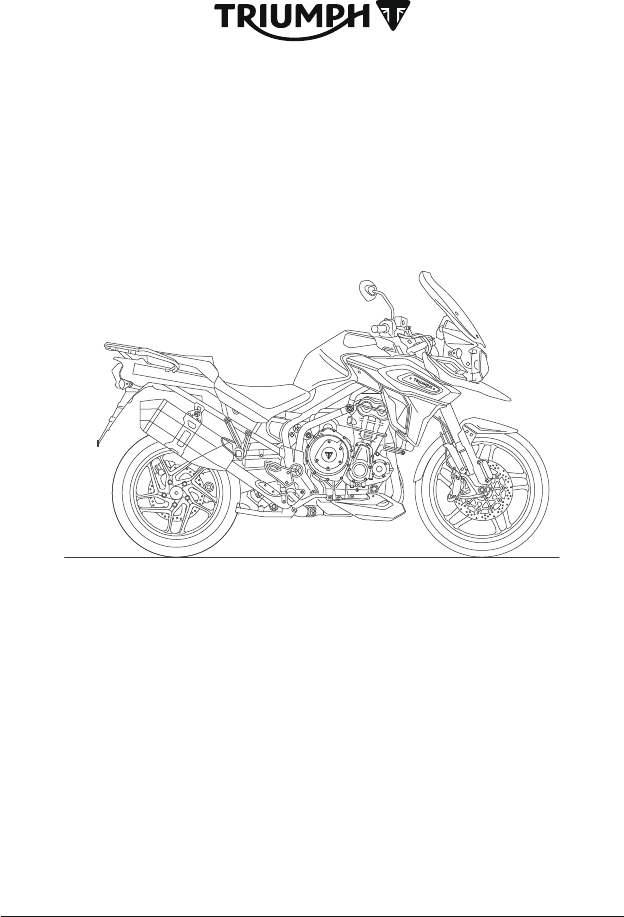
Owner's Handbook
Tiger 1200 XR, Tiger XR, Tiger XR-LRH,
Tiger XC, Tiger XR and Tiger XC
This handbook contains information on the Triumph Tiger 1200 XR, Tiger XR,
Tiger XR-LRH, Tiger XC, Tiger XR and Tiger XC motorcycles. Always store this
Owner's Handbook with the motorcycle and refer to it for information whenever
necessary.
The information contained in this publication is based on the latest information
available at the time of printing. Triumph reserves the right to make changes at any
time without prior notice, or obligation.
Not to be reproduced wholly or in part without the written permission of Triumph
Motorcycles America Limited.
© Copyright 10.2017 Triumph Motorcycles America Limited.
Publication part number 3855518-US issue 1
1

2
TABLE OF CONTENTS
This handbook contains a number of different sections. The table of contents below
will help you find the beginning of each section where, in the case of the major
sections, a further table of contents will help you find the specific subject required.
Foreword 3
Safety First 7
Warning Labels 14
Parts Identification 16
Serial Numbers 20
Instruments 21
General Information 89
How to Ride the Motorcycle 139
Accessories, Loading and Passengers 158
Maintenance 163
Cleaning and Storage 207
Specifications 217
Index 222
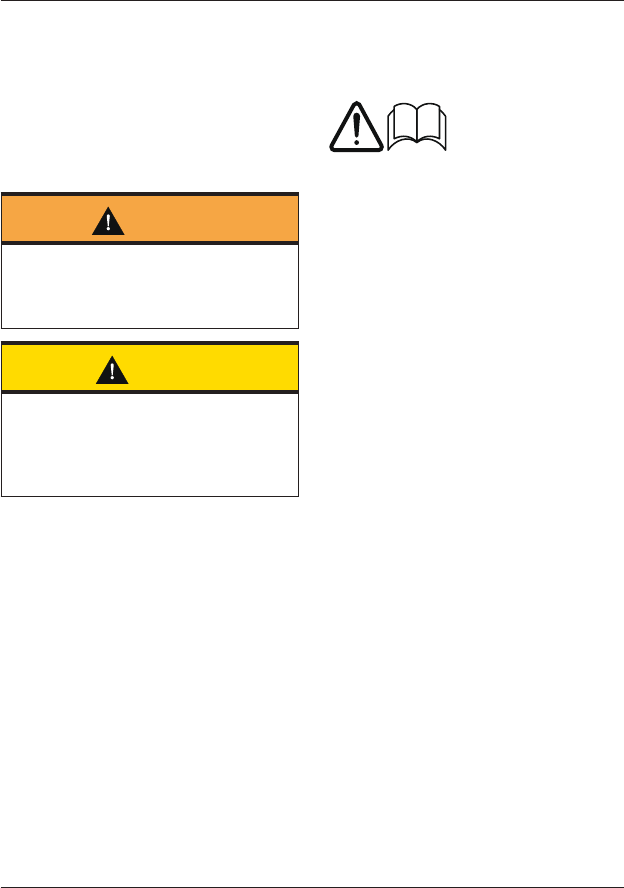
Foreword
3
FOREWORD
Warnings, Cautions and
Notes
Throughout this Owner's Handbook
particularly important information is
presented in the following form:
Warning
This warning symbol identifies special
instructions or procedures, which if not
correctly followed could result in
personal injury, or loss of life.
Caution
This caution symbol identifies special
instructions or procedures, which, if
not strictly observed, could result in
damage to, or destruction of,
equipment.
Note:
• This note symbol indicates points of
particular interest for more
efficient and convenient operation.
Warning Labels
At certain areas of the motorcycle, the
symbol (above) can be seen. The symbol
means CAUTION: REFER TO THE
HANDBOOK and will be followed by a
pictorial representation of the subject
concerned.
Never attempt to ride the motorcycle or
make any adjustments without
reference to the relevant instructions
contained in this handbook.
See page 14 for the location of all labels
bearing this symbol. Where necessary,
this symbol will also appear on the
pages containing the relevant
information.
Maintenance
To ensure a long, safe and trouble free
life for your motorcycle, maintenance
should only be carried out by an
authorized Triumph dealer.
Only an authorized Triumph dealer will
have the necessary knowledge,
equipment and skills to maintain your
Triumph motorcycle correctly.
To locate your nearest Triumph dealer,
visit the Triumph website at
www.triumph.co.uk or telephone
Triumph Motorcycles America Limited
on (678) 854 2010.

Foreword
4
Off-Road Use
All models are designed for on-road and
light off-road use. Light off-road use
includes use on unpaved, dirt or gravel
roads, but does not include riding on
any motocross course, any off-road
competition (such as motocross or
enduro riding), or riding off-road with a
passenger.
Light off-road use does not include
jumping the motorcycle or riding over
obstacles. Do not attempt to jump over
any bumps or obstacles. Do not attempt
to ride over any obstacles.
Noise Control System
Tampering with the noise control
system is prohibited.
Owners are warned that the law may
prohibit:
1. The removal or rendering
inoperative by any person other
than for purposes of maintenance,
repair or replacement, of any device
or element of design incorporated
into any new vehicle for the
purpose of noise control prior to its
sale or delivery to the ultimate
purchaser or while it is in use and,
2. the use of the vehicle after such
device or element of design has
been removed or rendered
inoperative by any person.
Immobilizer and Tire Pressure
Monitoring System
This device complies with part 15 of the
Federal Communications Commission
(FCC) Rules.
Operation is subject to the following two
conditions:
1. This device may not cause harmful
interference.
2. This device must accept any
interference received, including
interference that may cause
undesired operation.
Changes or modifications to the device
could void the user’s authority to
operate the equipment.
Tires
With reference to the Pneumatic Tires
and Tubes for Automotive Vehicles
(Quality Control) Order, 2009, Cl. No. 3 (c),
it is declared by M/s. Triumph
Motorcycles Ltd. that the tires mounted
on this motorcycle meet the
requirements of IS 15627: 2005 and
comply with the requirements under
Central Motor Vehicle Rules (CMVR), 1989.
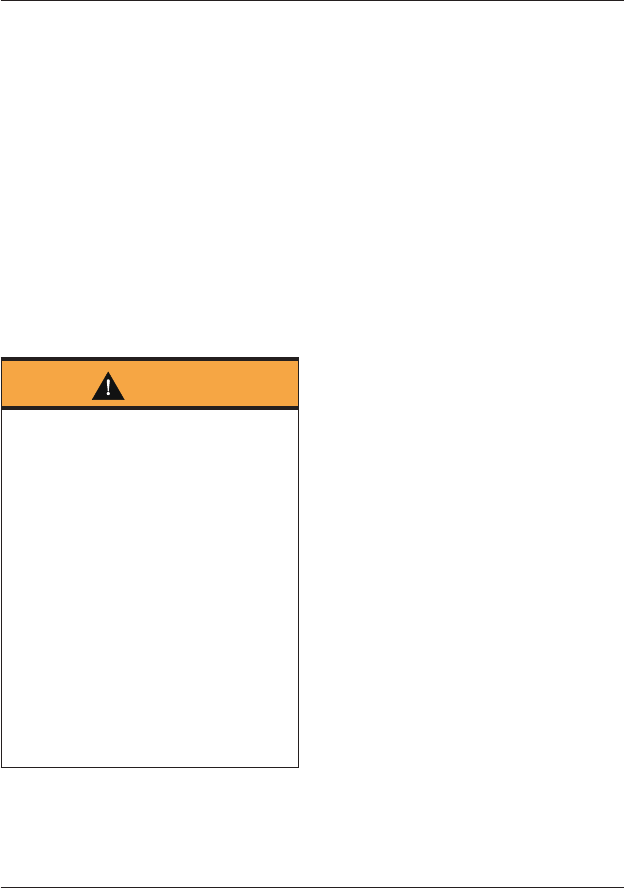
Foreword
5
Tiger 1200 XRx-LRH
(Low Ride Height) Models
Unless stated otherwise, information,
instructions, and specifications for
Tiger 1200 XRx-LRH models are identical
to those detailed in this Owner’s
Handbook for the Tiger 1200 XRx
standard ride height models.
Note:
• The Tiger 1200 XRx-LRH models
cannot be equipped with a center
stand.
Owner's Handbook
Warning
This Owner's Handbook, and all other
instructions that are supplied with
your motorcycle, should be considered
a permanent part of your motorcycle
and should remain with it even if your
motorcycle is subsequently sold.
All riders must read this Owner's
Handbook and all other instructions
which are supplied with your
motorcycle, before riding, in order to
become thoroughly familiar with the
correct operation of your motorcycle's
controls, its features, capabilities and
limitations. Do not lend your
motorcycle to others as riding when
not familiar with your motorcycle's
controls, features, capabilities and
limitations can lead to an accident.
Thank you for choosing a Triumph
motorcycle. This motorcycle is the
product of Triumph's use of proven
engineering, exhaustive testing, and
continuous striving for superior
reliability, safety and performance.
Please read this Owner's Handbook
before riding in order to become
thoroughly familiar with the correct
operation of your motorcycle's controls,
its features, capabilities and limitations.
This handbook includes safe riding tips,
but does not contain all the techniques
and skills necessary to ride a motorcycle
safely.
Triumph strongly recommends that all
riders undertake a safety course
approved by the Motorcycle Safety
Foundation to ensure safe operation of
this motorcycle. Information about the
nearest Motorcycle Safety Foundation
course to you can be obtained by calling
the following nationwide toll free
number: 800-447-4700, or by writing to
the Motorcycle Safety Foundation at:
2, Jenner Street, Irvine, California 92718.
To ensure a long and trouble free life for
your motorcycle, maintenance should be
carried out as described in this manual
by an authorized Triumph dealer.

Foreword
6
This handbook is available from your
local dealer in:
• English
• US English
• French
• German
• Italian
• Dutch
• Spanish
• Portuguese
• Swedish
• Japanese
• Thai.
Talk to Triumph
Our relationship with you does not end
with the purchase of your Triumph. Your
feedback on the buying and ownership
experience is very important in helping
us develop our products and services
for you.
Please help us by ensuring your
authorized Triumph dealership has your
email address and registers this with us.
You will then receive an online customer
satisfaction survey invitation to your
email address where you can give us
this feedback.
Your Triumph Team.
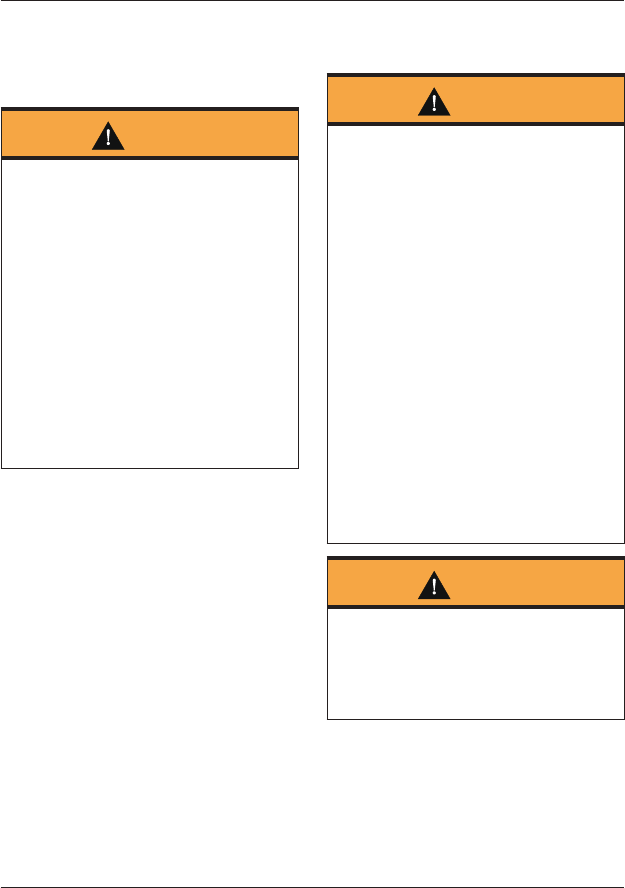
Safety First
7
SAFETY FIRST
The Motorcycle
Warning
All models are designed for on-road
use and light off-road use. Light off-
road use includes use on unpaved, dirt
or gravel roads, but does not include
riding on any motocross course, any
off-road competition (such as
motocross or enduro riding), or riding
off-road with a passenger.
Light off-road use does not include
jumping the motorcycle or riding over
obstacles. Do not attempt to jump over
any bumps or obstacles. Do not
attempt to ride over any obstacles.
Extreme off-road use could lead to loss
of motorcycle control and an accident.
Warning
Tiger 1200 XRx-LRH (Low Ride Height)
Model
The Tiger 1200 XRx-LRH motorcycles
are equipped with lowered suspension
and have reduced ground clearance.
As a result, the cornering bank angles
that can be achieved by the Tiger 1200
XRx-LRH are reduced, when compared
with the standard ride height
Tiger 1200 XRx.
When riding, keep in mind that your
motorcycle’s ground clearance is
limited. Operate your motorcycle in an
area free from traffic to gain familiarity
with the motorcycle’s ground clearance
and bank angle limitations.
Banking to an unsafe angle or
unexpected contact with the ground
may cause instability, loss of
motorcycle control and an accident.
Warning
This motorcycle is not designed to tow
a trailer or be mounted with a sidecar.
Installing a sidecar and/or a trailer may
result in loss of motorcycle control and
an accident.
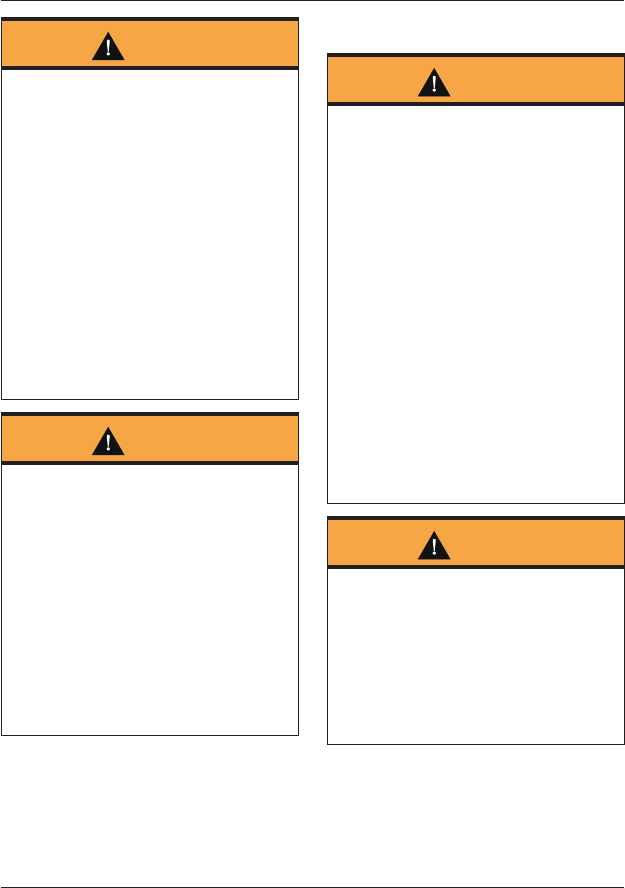
Safety First
8
Warning
This motorcycle is designed for use as
a two-wheeled vehicle capable of
carrying a rider on their own, or a rider
and one passenger.
The total weight of the rider, and any
passenger, accessories and luggage
must not exceed the maximum load
limit of:
Tiger 1200 XR - 507 lb (230 kg)
Tiger 1200 XRx - 502 lb (228 kg)
Tiger 1200 XRx-LRH - 507 lb (230 kg)
Tiger 1200 XRT - 502 lb (228 kg)
Tiger 1200 XCx - 491 lb (223 kg)
Tiger 1200 XCA - 493 lb (224 kg).
Warning
This motorcycle is equipped with a
catalytic converter below the engine,
which along with the exhaust system
reaches very high temperature during
engine operation.
Flammable materials such as grass,
hay/straw, leaves, clothing and luggage
etc. could ignite if allowed to come into
contact with any part of the exhaust
system and catalytic converter.
Always make sure that flammable
materials are not allowed to contact the
exhaust system or catalytic converter.
Fuel and Exhaust Fumes
Warning
GASOLINE IS HIGHLY FLAMMABLE:
Always turn off the engine when
refueling.
Do not refuel or open the fuel filler cap
while smoking or in the vicinity of any
open (naked) flame.
Take care not to spill any gasoline on
the engine, exhaust pipes or mufflers
when refueling.
If gasoline is swallowed, inhaled or
allowed to get into the eyes, seek
immediate medical attention.
Spillage on the skin should be immedi-
ately washed off with soap and water
and clothing contaminated with gaso-
line should immediately be removed.
Burns and other serious skin conditions
may result from contact with gasoline.
Warning
Never start your engine or let it run for
any length of time in a closed area.
The exhaust fumes are poisonous and
may cause loss of consciousness and
death within a short time.
Always operate your motorcycle in the
open-air or in an area with adequate
ventilation.
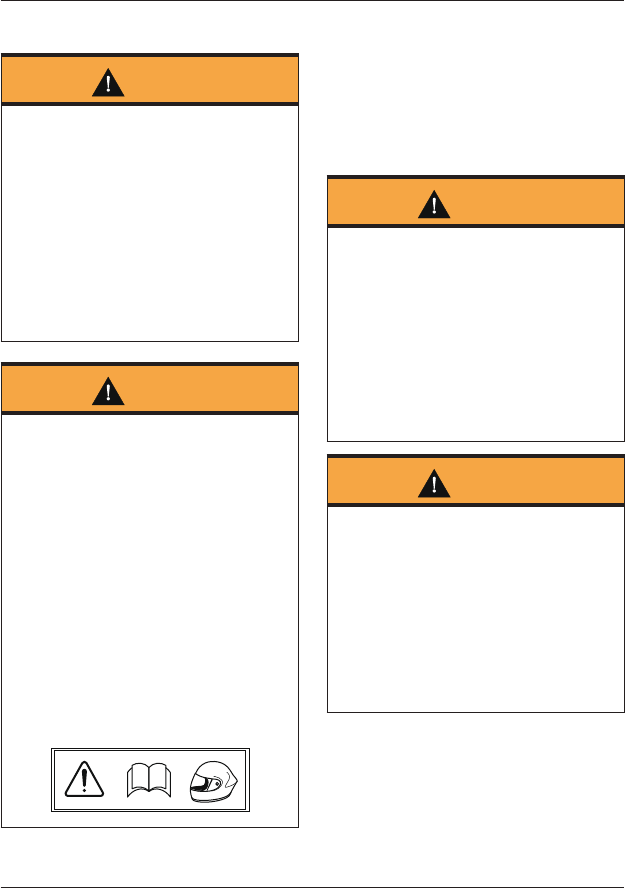
Safety First
9
Helmet and Clothing
Warning
When riding the motorcycle, both rider
and passenger must always wear a
motorcycle helmet, eye protection,
gloves, boots, trousers (close fitting
around the knee and ankle) and a
brightly colored jacket. Brightly colored
clothing will considerably increase a
rider’s (or passenger’s) visibility to
other operators of road vehicles.
Although full protection is not possible,
wearing correct protective clothing can
reduce the risk of injury when riding.
Warning
A helmet is one of the most important
pieces of riding gear as it offers
protection against head injuries. You
and your passenger’s helmet should
be carefully chosen and should fit you
or your passenger’s head comfortably
and securely. A brightly colored helmet
will increase a rider’s (or passenger’s)
visibility to other operators of road
vehicles.
An open face helmet offers some
protection in an accident though a full
face helmet will offer more.
Always wear a visor or approved
goggles to help vision and to protect
your eyes.
cbma
When choosing a helmet, always look for
a DOT (Department of Transport) sticker
indicating that the helmet has DOT
approval. Do not buy a helmet without
DOT approval.
Riding
Warning
Never ride the motorcycle when
fatigued or under the influence of
alcohol or other drugs.
Riding when under the influence of
alcohol or other drugs is illegal.
Riding when fatigued or under the
influence of alcohol or other drugs
reduces the rider's ability to maintain
control of the motorcycle and may lead
to loss of control and an accident.
Warning
All riders must be licensed to operate
the motorcycle. Operation of the
motorcycle without a license is illegal
and could lead to prosecution.
Operation of the motorcycle without
formal training in the correct riding
techniques that are necessary to
become licensed is dangerous and may
lead to loss of motorcycle control and
an accident.
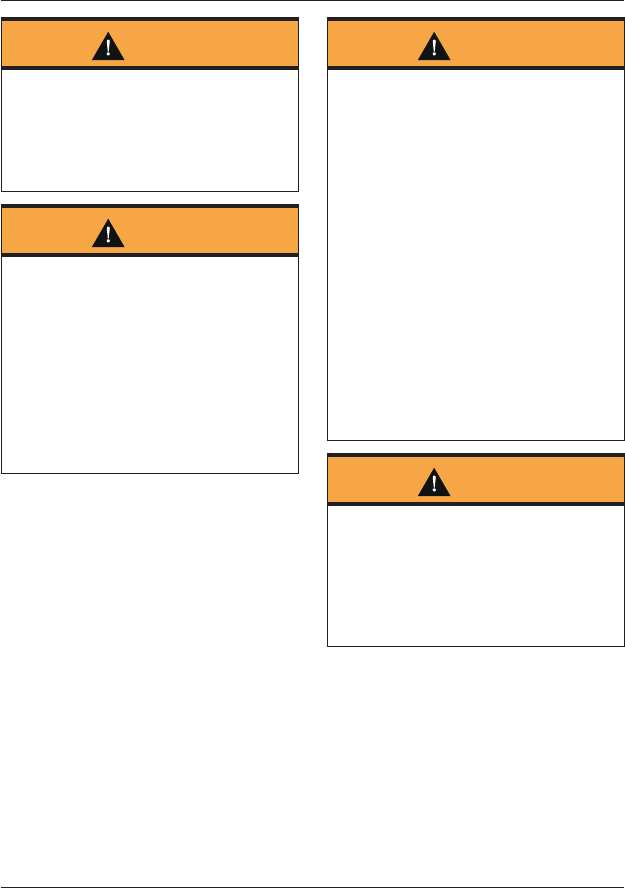
Safety First
10
Warning
Always ride defensively and wear the
protective equipment mentioned
elsewhere in this foreword. Remember,
in an accident, a motorcycle does not
give the same impact protection as a
car.
Warning
This Triumph motorcycle should be
operated within the legal speed limits
for the particular road traveled.
Operating a motorcycle at high speeds
can be potentially dangerous since the
time available to react to given traffic
situations is greatly reduced as road
speed increases. Always reduce speed
in potentially hazardous driving
conditions such as bad weather or
heavy traffic.
Warning
Continually observe and react to
changes in road surface, traffic and
wind conditions. All two-wheeled
vehicles are subject to external forces
which may cause an accident. These
forces include but are not limited to:
Wind draft from passing vehicles
Potholes, uneven or damaged road
surfaces
Bad weather
Rider error.
Always operate the motorcycle at
moderate speed and away from heavy
traffic until you have become
thoroughly familiar with its handling
and operating characteristics. Never
exceed the legal speed limit.
Warning
Ensure that you know and respect the
rules of the road. Read and observe
publications such as ‘MOTORCYCLE
SAFETY’, ‘YOU AND YOUR MOTORCYCLE,
RIDING TIPS’ and also read and become
familiar with the contents of the
MOTORCYCLE HANDBOOK for your state.
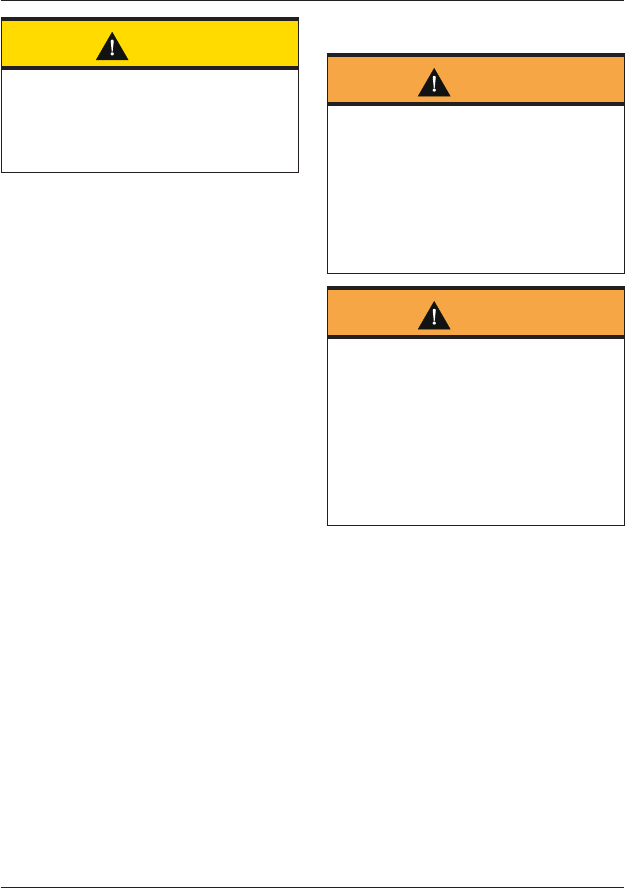
Safety First
11
Caution
This Triumph motorcycle is not
equipped with spark arresters.
Operation in forests, brush or grass
areas may violate state and local laws
and regulations.
Wobble/Weave
A weave is a relatively slow oscillation of
the rear of the motorcycle, while a
wobble is a rapid, possibly strong
shaking of the handlebar. These are
related but distinct stability problems
usually caused by excessive weight in
the wrong place, or by a mechanical
problem such as worn or loose bearings
or under-inflated or unevenly worn tires.
Your solution to both situations is the
same. Keep a firm hold on the
handlebars without locking arms or
fighting the steering. Smoothly ease off
the throttle to slow gradually. Do not
apply the brakes, and do not accelerate
to try to stop the wobble or weave. In
some cases, it helps to shift your body
weight forward by leaning over the tank.
Copyright © 2005 Motorcycle Safety
Foundation. All rights reserved. Used
with permission.
Handlebars and Footrests
Warning
The rider must maintain control of the
vehicle by keeping hands on the
handlebars at all times.
The handling and stability of a
motorcycle will be adversely affected if
the rider removes their hands from the
handlebars, resulting in loss of
motorcycle control and an accident.
Warning
The rider and passenger must always
use the footrests provided, during
operation of the vehicle.
By using the footrests, both rider and
passenger will reduce the risk of
inadvertent contact with any
motorcycle components and will also
reduce the risk of injury from
entrapment of clothing.
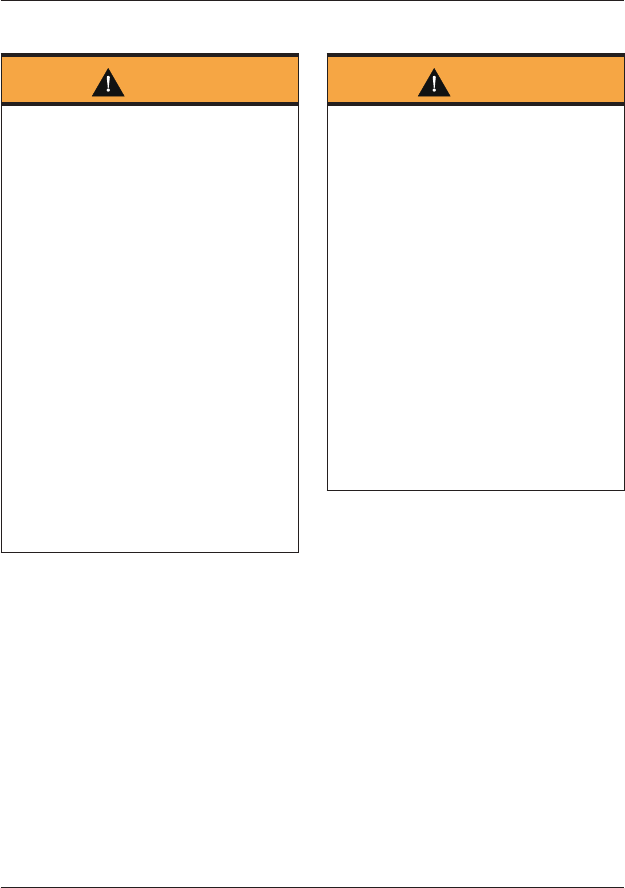
Safety First
12
Parking
Warning
Always switch off the engine and never
leave any keys with the motorcycle
before leaving it unattended. By
removing any keys, the risk of use of
the motorcycle by unauthorized or
untrained persons is reduced.
When parking the motorcycle, always
remember the following:
Engage first gear to help prevent the
motorcycle from rolling off the stand.
The engine and exhaust system will be
hot after riding. DO NOT park where
pedestrians, animals and/or children
are likely to touch the motorcycle.
Do not park on soft ground or on a
steeply inclined surface. Parking under
these conditions may cause the
motorcycle to fall over.
For further details, please refer to the
'How to Ride the Motorcycle' section of
this Owner's Handbook.
Parts and Accessories
Warning
Owners should be aware that the only
approved parts, accessories and
conversions for any Triumph motorcycle
are those which carry official Triumph
approval and are installed to the
motorcycle by an authorized dealer.
In particular, it is extremely hazardous
to install or replace parts or
accessories whose installation requires
the dismantling of, or addition to,
either the electrical or fuel systems
and any such modification could cause
a safety hazard.
The installation of any non-approved
parts, accessories or conversions may
adversely affect the handling, stability
or other aspect of the motorcycle
operation that may result in an
accident causing injury or death.
Triumph does not accept any liability
whatsoever for defects caused by the
installation of non-approved parts,
accessories or conversions or the
installation of any approved parts,
accessories or conversions by non-
approved personnel.
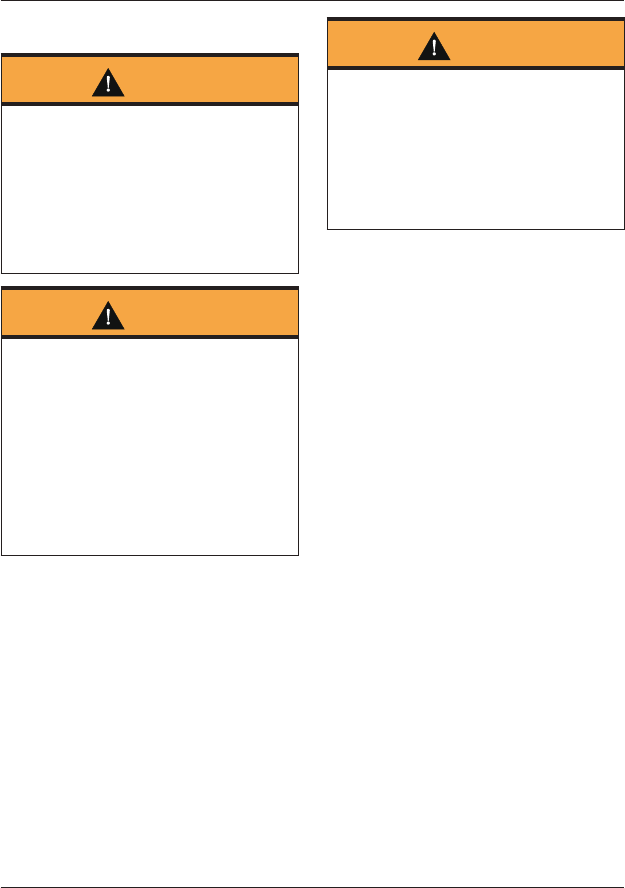
Safety First
13
Maintenance/Equipment
Warning
Consult your authorized Triumph dealer
whenever there is doubt as to the
correct or safe operation of this
Triumph motorcycle.
Remember that continued operation of
an incorrectly performing motorcycle
may aggravate a fault and may also
compromise safety.
Warning
Ensure all equipment that is required
by law is installed and functioning
correctly. The removal or alteration of
the motorcycle’s lights, mufflers,
emission or noise control systems can
violate the law. Incorrect or improper
modification may adversely affect the
handling, stability or other aspect of
the motorcycle operation, which may
result in an accident causing injury or
death.
Warning
If the motorcycle is involved in an
accident, collision or fall, it must be
taken to an authorized Triumph dealer
for inspection and repair. Any accident
can cause damage to the motorcycle
that, if not correctly repaired, may
cause a second accident that may
result in injury or death.
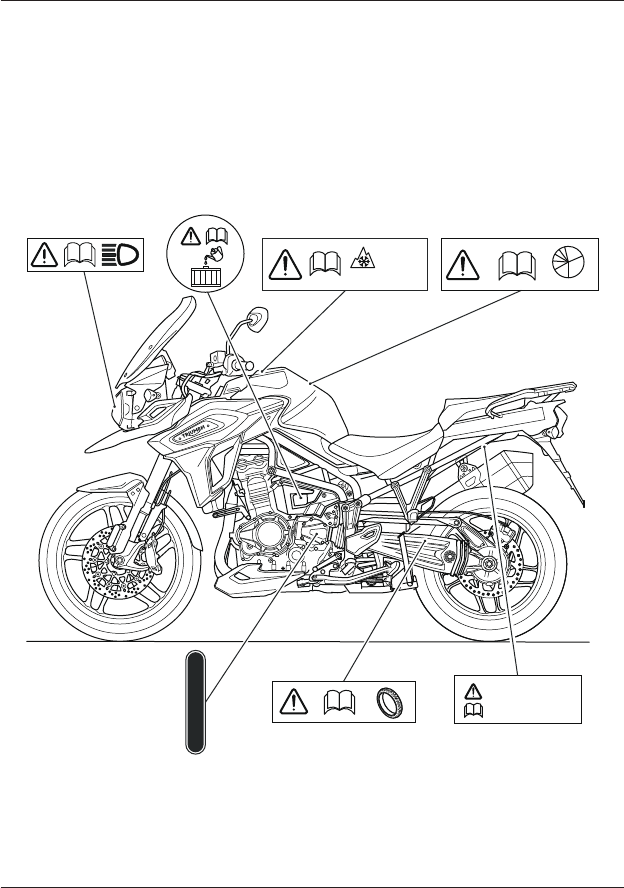
Warning Labels
14
WARNING LABELS
The labels detailed on this and the following pages indicate important safety
information found in this handbook. Before riding, make sure that all riders have
understood and complied with all the information to which these labels relate.
For illustration purposes, the Tiger 1200 XR motorcycle is shown.
Warning Label Locations
MAX LOAD
5 kg (11 lbs)
6
5
4
3
2
N
1
1
2
R.P.M.
34
56
100 KM/H
(60 MPH)
MAX
M S
+
7
1. Headlight (page 201)
2. Coolant (page 172)
3. Snow and Mud Tires (page 217)
4. Breaking-In (page 136)
5. Gear Position (page 145)
6. Tires (page 188)
7. Panniers (if equipped) (page 129)
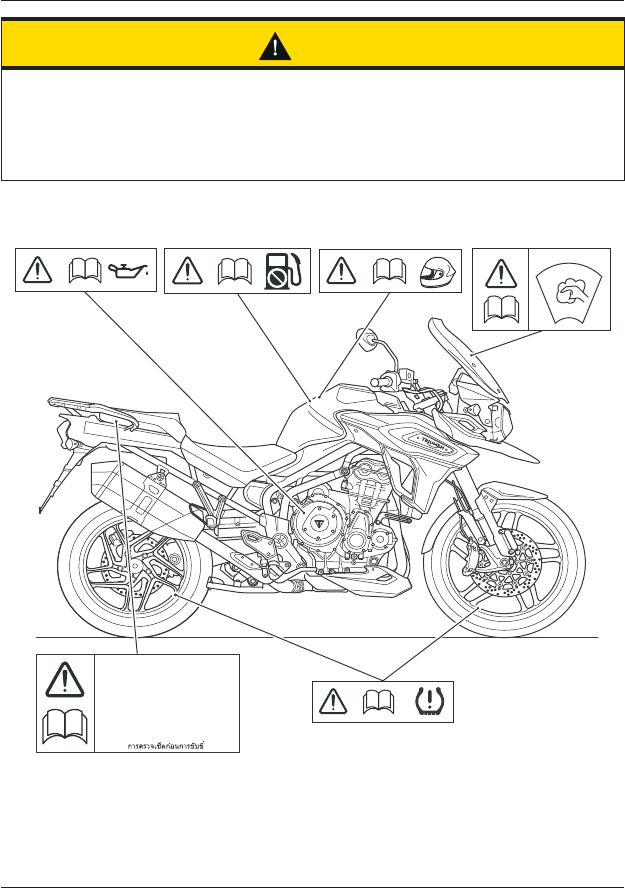
Warning Labels
15
Caution
All warning labels and decals, with the exception of the Breaking-in label, are
mounted on the motorcycle using a strong adhesive. In some cases, labels are
installed prior to an application of paint lacquer.
Therefore, any attempt to remove the warning labels will cause damage to the
paintwork or body work.
P
b
1234
5
6
DAILY SAFETY CHECKS
TÄGLICHE SICHERHEITSKONTROLLEN
CONTROLES DE SECURITE QUOTIDIENS
CHEQUEOS DE SEGURIDAD DIARIOS
VERIFICAÇÕES DIÁRIAS DE SEGURANÇA
VERIFICHE GIORNALIERE DI SICUREZZA
DAGELIJSKE VEILIGHEIDSINSPECTIES
DAGLIG SÄKERHETSKONTROLL
運
行前点検
1. Engine Oil (page 169)
2. Unleaded Fuel (page 115)
3. Helmet (page 9)
4. Windshield (page 118)
5. Daily Safety Checks (page 137)
6. Tire Pressure Monitoring System (TPMS)
(if equipped) (page 111)
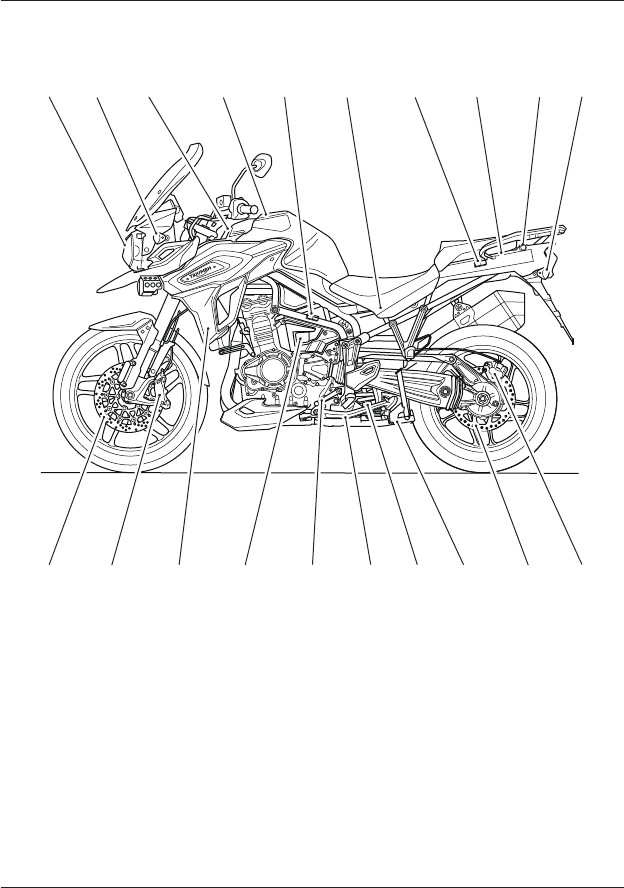
Parts Identification
16
PARTS IDENTIFICATION
123456910
20 19 18 17 16 15 13 12 11
8
14
7
1. Headlight
2. Front turn signal
3. Electrical accessory socket
4. Fuel tank and fuel filler cap
5. Rider’s heated seat switch
(Tiger 1200 XR only)
6. Battery and fuse boxes (under the seat)
7. Passenger’s heated seat switch
(if equipped)
8. USB socket (under the seat)
9. Electrical accessory socket
(if equipped)
10. Rear turn signal
11. Rear brake caliper
12. Rear brake disc
13. Center stand (if equipped)
14. Rear suspension damping adjuster
(Tiger 1200 XR only)
15. Side stand
16. Gear shift pedal
17. Coolant expansion tank
18. Radiator cowl
19. Front brake caliper
20. Front brake disc
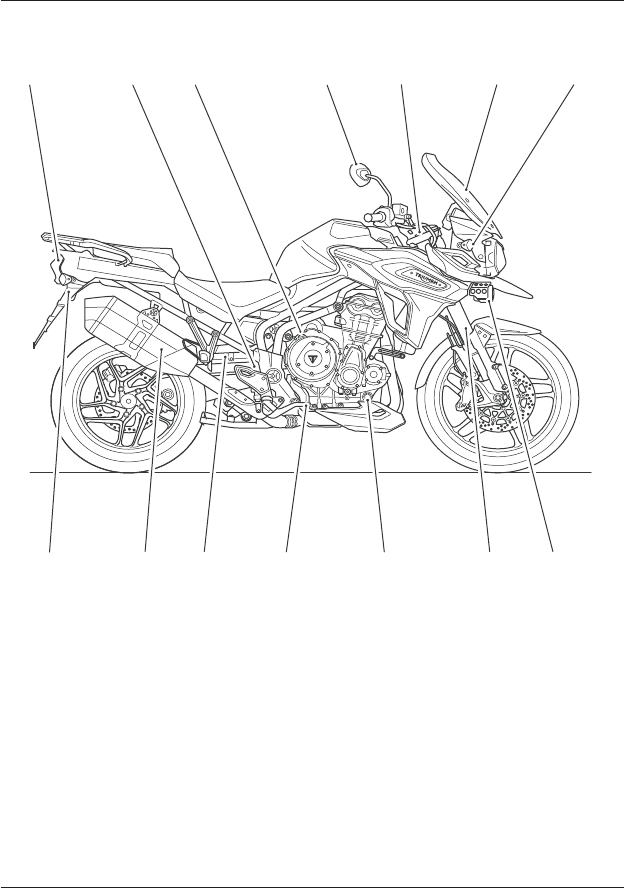
Parts Identification
17
Parts Identification (Continued)
123 4 7
6
13 12 11 10 9 8
14
5
1. Brake/tail light
2. Rear brake fluid reservoir
3. Oil filler cap
4. Mirror
5. Front suspension damping adjusters
(Tiger 1200 XR only)
6. Windshield
7. Headlight adjuster
8. Front fog lights (if equipped)
9. Front fork
10. Engine oil level sight glass
11. Rear brake pedal
12. Rear suspension spring preload
adjuster (model specific)
13. Muffler
14. Seat lock
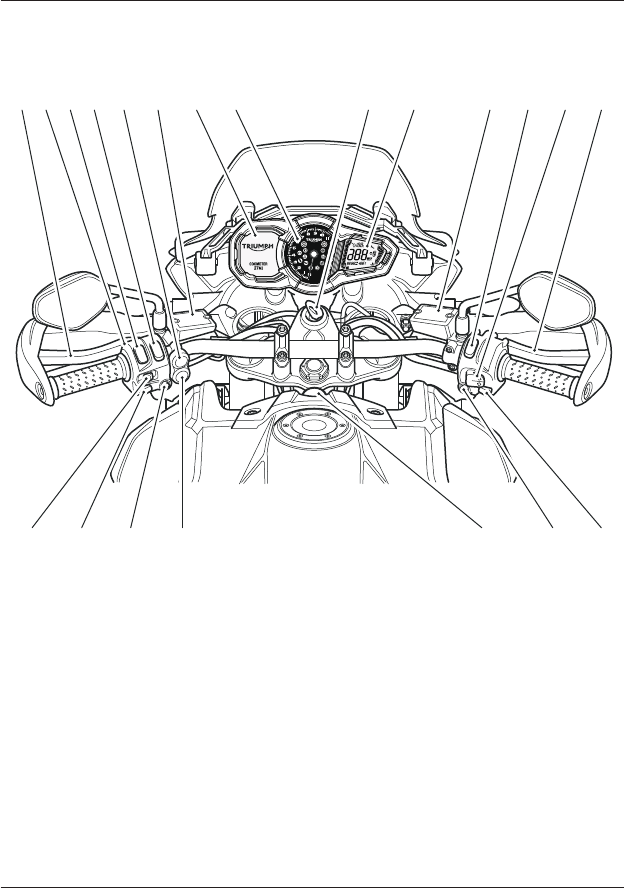
Parts Identification
18
Rider View Parts Identification
Tiger 1200 XR Only
1 2 34 5 6 7 8 9 10 11 12 13 14
15
1617
18192021
1. Clutch lever
2. Instrument select button
3. Headlight dimmer switch
4. Instrument scroll button
5. Fog lights switch (if equipped)
6. Clutch fluid reservoir
7. Multifunction display screen
8. Tachometer
9. Ignition switch
10. Motorcycle status display screen
11. Front brake fluid reservoir
12. Engine stop switch
13. Cruise control adjust button
14. Front brake lever
15. Starter button
16. Hazard warning lights button
17. Electrical accessory socket
18. Heated grips switch (if equipped)
19. Mode button
20. Horn button
21. Turn signal switch
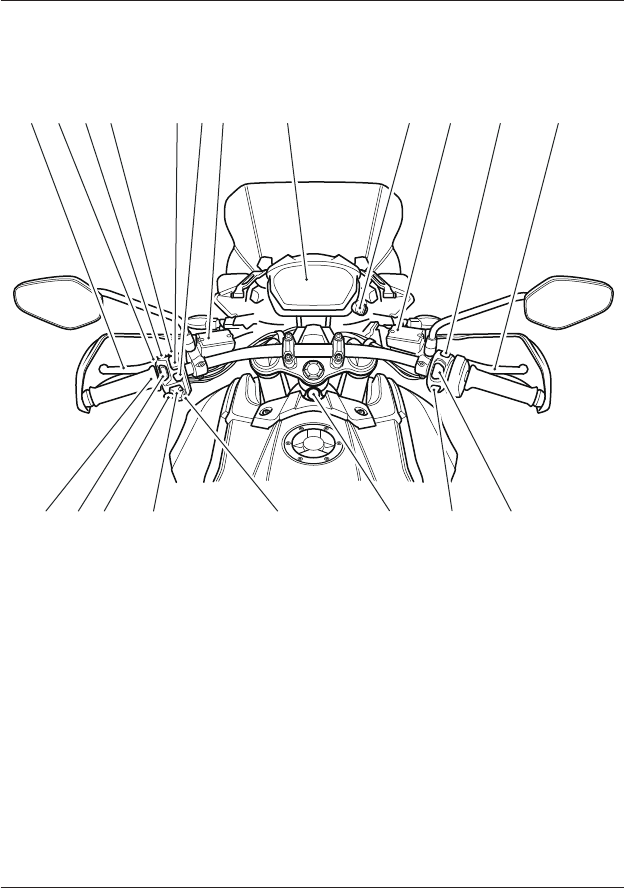
Parts Identification
19
Rider View Parts Identification
All Models except Tiger 1200 XR
ckcx
1 2 34 56
7 9 10 11 12
17
181920 1316 14
8
15
1. Clutch lever
2. Headlight dimmer switch
3. Heated seats switch (if equipped)
4. Front fog lights switch (if equipped)
5. Cruise control adjust switch
6. MODE button
7. Clutch fluid reservoir
8. Multifunction display screen
9. Master ignition switch (if equipped)
10. Front brake fluid reservoir
11. Hazard warning lights switch
12. Front brake lever
13. Engine start/stop switch
14. HOME button
15. Joystick button
16. Electrical accessory socket
17. Turn signal switch
18. Horn button
19. Daytime Running Lights (DRL) switch
(if equipped)
20. Heated grips switch (if equipped)
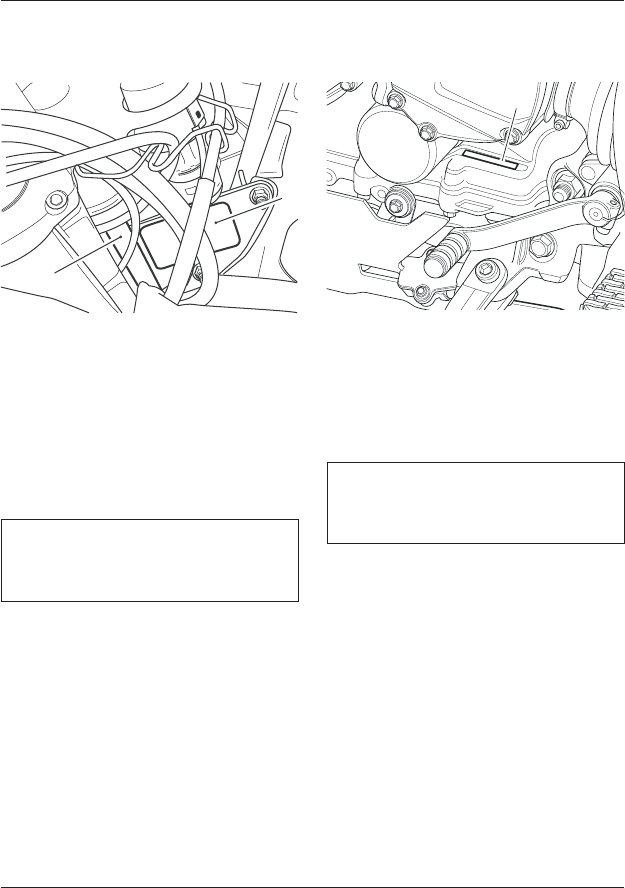
Serial Numbers
20
SERIAL NUMBERS
Vehicle Identification Number (VIN)
1
2
1. VIN number
2. Label
The Vehicle Identification Number (VIN)
is stamped into the steering head area
of the frame. In addition, It is displayed
on a label which is mounted on the right
hand side of the front subframe.
Record the vehicle identification number
in the space provided below.
Engine Serial Number
1
1. Engine serial number
The engine serial number is stamped on
the engine crankcase, immediately
below the gearbox.
Record the engine serial number in the
space provided below.
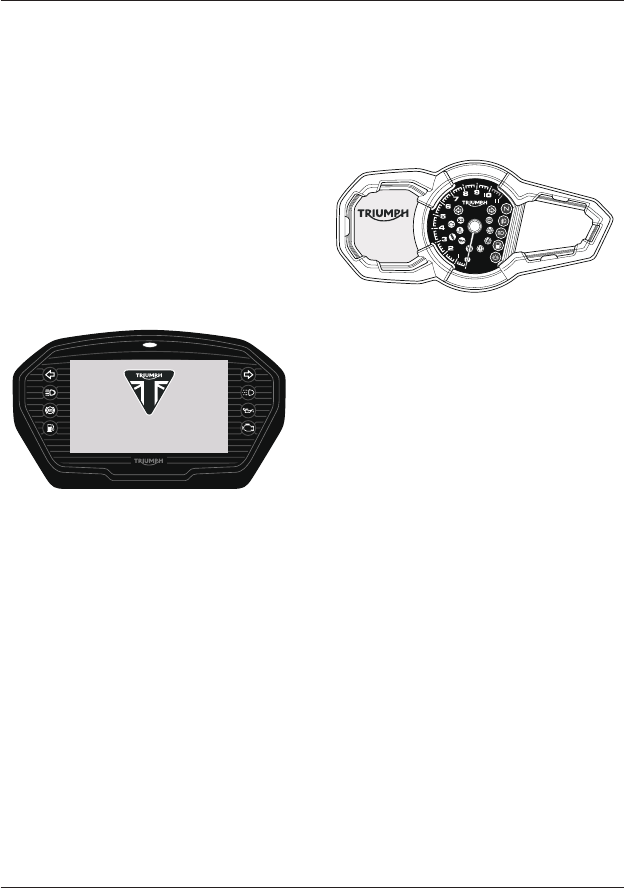
Instruments
21
INSTRUMENTS
Instrument Displays
Overview
There are two types of instrument
displays mounted to specific
motorcycles models.
All Models except Tiger 1200 XR
All models except for Tiger 1200 XR are
equipped with a full color Thin Film
Transistor (TFT) digital instrument
display.
ODOMETER
0
MILES
Thin Film Transistor (TFT) Instrument
Display
For more information on the TFT
instrument display and its operation,
see page 22.
Tiger 1200 XR Models Only
Only Tiger 1200 XR models are equipped
with a Liquid Crystal Display (LCD)
instrument display.
Liquid Crystal Display (LCD) Instrument
Display
For more information on the LCD
instrument display and its operation,
see page 57.

Instruments
22
Thin Film Transistor (TFT) Instrument Display
Table of Contents
Instrument Panel Layout 23
TFT Display Navigation 24
TFT Themes and Styles 24
Warning Lights 24
Speedometer and Odometer 30
Tachometer 31
Gear Position Display 31
Fuel Gage 32
Service Interval Announcement 32
Ambient Air Temperature 32
Riding Modes 33
Riding Mode Selection 34
Information Tray 36
Main Menu 42
Instrument Panel Position Adjustment 56
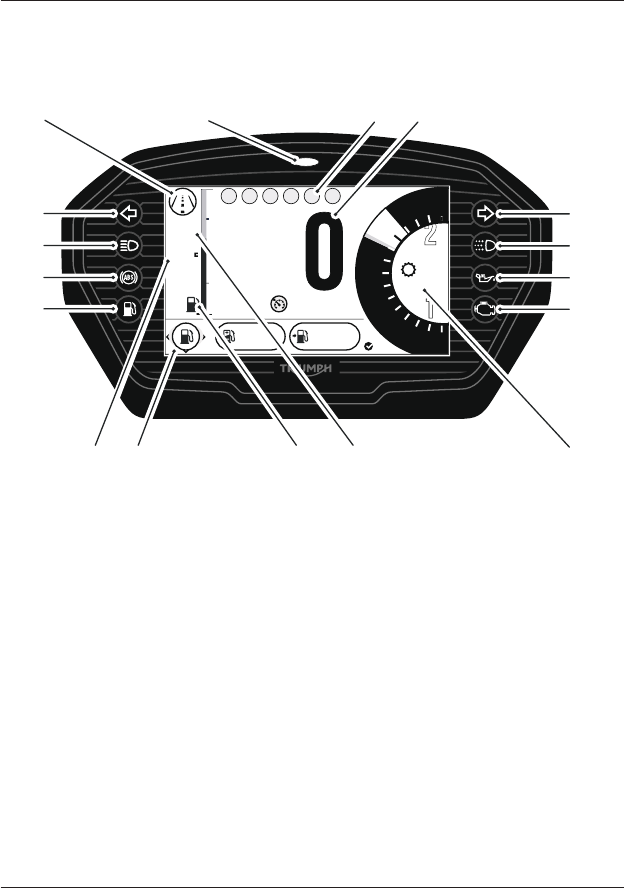
Instruments
23
Instrument Panel Layout
The TFT instrument display is mounted to all models except Tiger 1200 XR. Not all
instrument features are available on all models.
o7:29
17.5
8
6N
4
2
0
12
14
F
E
AM
RPM
x1000
mph
42 122 mi
RANGE
mpg
10
16
15
14
13
4
5
6
7
1
1012
17
9
23
8
11
1. Alarm/immobilizer status indicator
light (alarm is an accessory kit)
2. Warning lights
3. Speedometer
4. Right hand turn signal
5. Daytime Running Light (DRL)
(if equipped)
6. Oil pressure warning light
7. Engine management Malfunction
Indicator Light (MIL)
8. Gear position symbol
9. Clock
10. Fuel gage
11. Information tray
12. Ambient air temperature
13. Fuel level low warning light
14. ABS warning light
15. High beam warning light
16. Left hand turn signal
17. Current riding mode
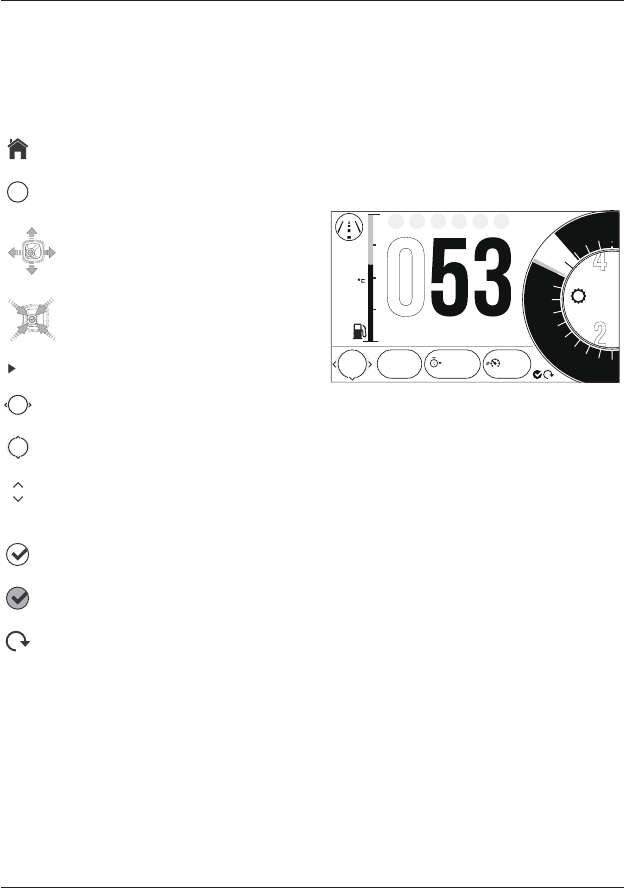
Instruments
24
TFT Display Navigation
The table below describes the
instrument icons and buttons used to
navigate through the instrument menus
described in this handbook.
Home button (right hand
switch housing).
m
Mode button (left hand switch
housing).
Joystick left/right or up/down.
Joystick Centre (press).
Selection arrow (right shown).
Information Tray - left/right
scroll via joystick.
Information Tray - up/down
scroll via joystick.
Option available within the
Information Tray - scroll via
joystick up/down.
Short press (press and
release) via joystick center.
Long press (press and hold)
via joystick center.
Reset current feature, (only
available with joystick long
press).
TFT Themes and Styles
There is the option to change the style
of the instrument display.
Depending on the motorcycle model,
there are either one or two themes.
Each theme has three different styles to
select from.
To select a theme or style, see page 51.
Styles can also be selected through the
Style Options tray, see page 41.
Theme 1, Style 1 is used for visual
recognition throughout this Owner’s
Handbook.
Theme 1
o7:29
12.5
19999 02:25
8
63
4
2
0
12 14
25.2
F
E
TRIP
mi mp/hHH:MM
PM
RPM
x1000
10
Theme 1 Style 1
Warning Lights
Note:
• When the ignition is switched on,
the instrument warning lights will
illuminate for 1.5 seconds and will
then go off (except those which
remain on until the engine starts,
as described in the following pages).
For additional warning and information
messages, see page 37.
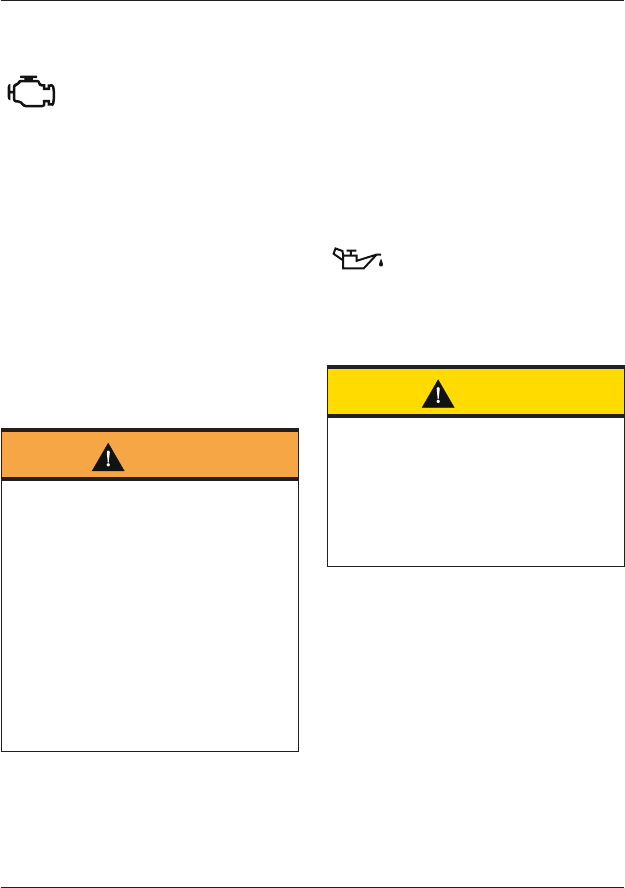
Instruments
25
Engine Management System
Malfunction Indicator Light (MIL)
The Malfunction Indicator Light
(MIL) for the engine management
system illuminates when the ignition is
switched ON (to indicate that it is
working) but should not become
illuminated when the engine is running.
If the MIL becomes illuminated when the
engine is running, this indicates that a
fault has occurred in one or more of the
systems controlled by the engine
management system. In such
circumstances, the engine management
system will switch to 'limp-home' mode
so that the journey may be completed, if
the fault is not so severe that the
engine will not run.
Warning
Reduce speed and do not continue to
ride for longer than is necessary with
the MIL illuminated. The fault may
adversely affect engine performance,
exhaust emissions and fuel
consumption.
Reduced engine performance could
cause a dangerous riding condition,
leading to loss of control and an
accident.
Contact an authorized Triumph dealer
as soon as possible to have the fault
checked and rectified.
Note:
• If the MIL flashes when the ignition
is switched ON contact an
authorized Triumph dealer as soon
as possible to have the situation
rectified. In these circumstances
the engine will not start.
Low Oil Pressure Warning Light
With the engine running, if the
engine oil pressure becomes
dangerously low, the low oil pressure
warning light will illuminate.
Caution
Stop the engine immediately if the low
oil pressure warning light illuminates.
Do not restart the engine until the
fault has been rectified.
Severe engine damage will result from
running the engine when the low oil
pressure warning light is illuminated.
Note:
• The low oil pressure warning light
will illuminate if the ignition is
switched ON without running the
engine.
Immobilizer/Alarm Indicator Light
This Triumph motorcycle is equipped
with an engine immobilizer which is
activated when the ignition is switched
off.
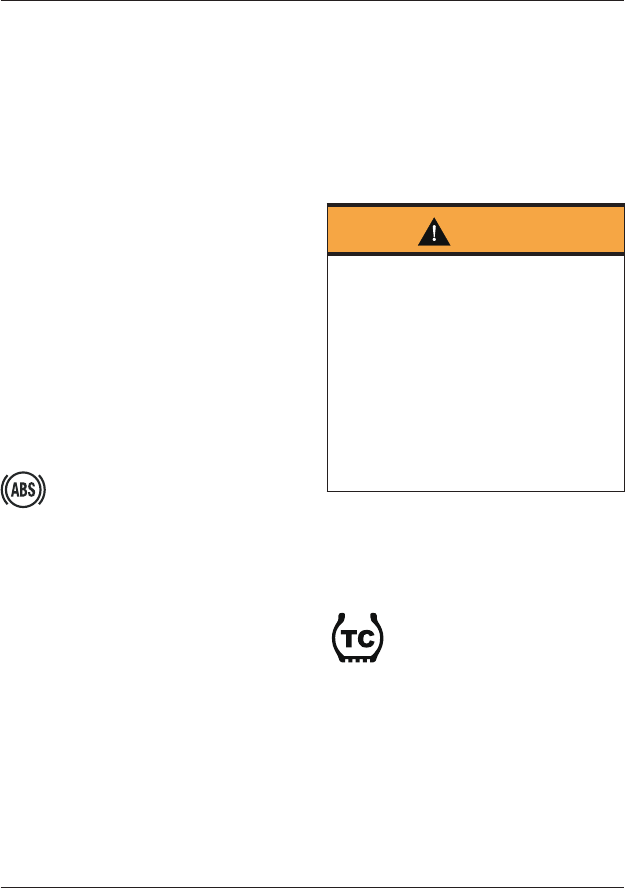
Instruments
26
Not Equipped With Alarm
When the ignition is switched off, the
immobilizer light will flash on and off for
24 hours to show that the engine
immobilizer is on. When the ignition is
switched on, the immobilizer and the
indicator light will be off.
If the indicator light remains on it
indicates that the immobilizer has a
malfunction that requires investigation.
Contact an authorized Triumph dealer
as soon as possible to have the fault
checked and rectified.
Equipped With Alarm
The immobilizer/alarm light will only
illuminate when the conditions
described in the genuine Triumph
accessory alarm instructions are met.
ABS (Anti-Lock Brake System)
Warning Light
When the ignition is switched on,
it is normal that the ABS warning light
will flash on and off. The light will
continue to flash after engine start-up
until the motorcycle first reaches a
speed exceeding 6 mph (10 km/h) when
it will go off.
Note:
• Traction control will not function if
there is a malfunction with the ABS.
The warning lights for the ABS,
traction control and the MIL will be
illuminated.
The warning light should not illuminate
again until the engine is restarted
unless there is a fault, or the ABS is
switched off - the warning light will
remain illuminated.
If the warning light becomes illuminated
at any other time while riding it
indicates that the ABS has a
malfunction that requires investigation.
Warning
If the ABS is not functioning, the brake
system will continue to function as a
non-ABS equipped brake system. Do
not continue to ride for longer than is
necessary with the warning light
illuminated. Contact an authorized
Triumph dealer as soon as possible to
have the fault checked and rectified. In
this situation braking too hard will
cause the wheels to lock resulting in
loss of motorcycle control and an
accident.
For details on how to select different
ABS settings, see page 33.
Traction Control (TC) Indicator Light
The TC indicator light is used to
indicate that the traction control
system is active and is working to limit
rear wheel slip during periods of hard
acceleration or under wet or slippery
road conditions.
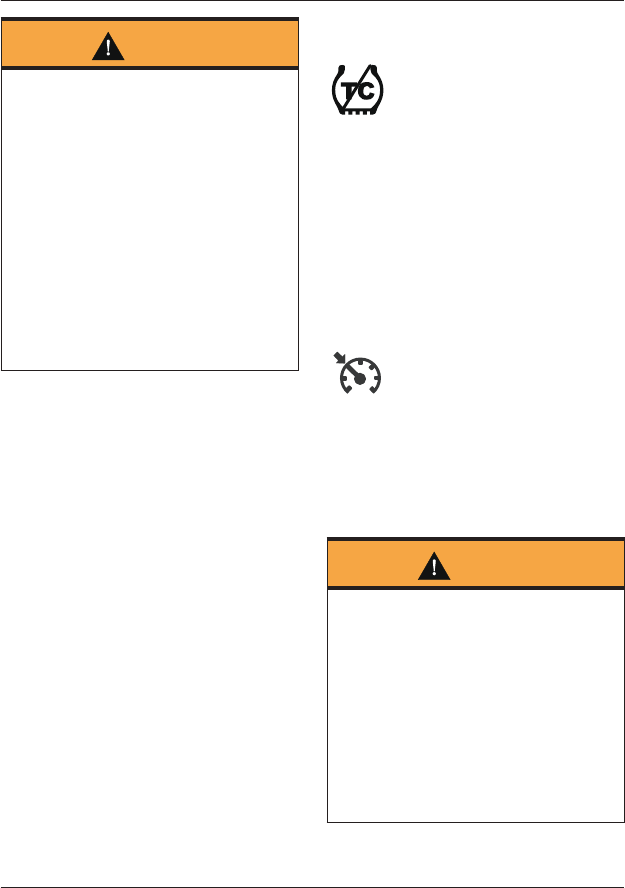
Instruments
27
Warning
If the traction control is not functioning,
care must be taken when accelerating
and cornering on wet/slippery road
surfaces to avoid rear wheel spin. Do
not continue to ride for longer than is
necessary with the Engine Management
System Malfunction Indicator Light (MIL)
and traction control warning lights
illuminated. Contact an authorized
Triumph dealer as soon as possible to
have the fault checked.
Hard acceleration and cornering in this
situation may cause the rear wheel to
spin resulting in loss of motorcycle
control and an accident.
TC Indicator Light Operation:
TC Switched On:
• Under normal riding conditions the
indicator light will remain off.
• The indicator light will flash rapidly
when the traction control system is
working to limit rear wheel slip
during periods of hard acceleration
or under wet or slippery road
conditions.
TC Switched Off:
The indicator light will not illuminate.
Instead the TC disabled warning light
will be illuminated (see page 27).
Note:
• Traction control will not function if
there is a malfunction with the ABS
system. The warning lights for the
ABS, traction control and the MIL
will be illuminated.
Traction Control (TC) Disabled
Warning Light
The TC disabled warning light
should not illuminate unless traction
control is switched off or there is a
malfunction.
If the warning light becomes illuminated
at any other time while riding, it
indicates that the traction control
system has a malfunction that requires
investigation.
Cruise Control Light
The cruise control can only be
activated when the motorcycle is
traveling at a speed between
19 to 100 mph (30 to 160 km/h) and is in
3rd gear or higher. When activated, the
cruise control light will be illuminated
(see page 104).
Warning
Cruise control must only be used
where you can ride safely at a steady
speed.
Cruise control should not be used
when riding in heavy traffic, on roads
with sharp/blind bends or when they
are slippery.
Using cruise control in heavy traffic, on
roads with sharp/blind bends or when
they are slippery, may result in loss of
motorcycle control and an accident.

Instruments
28
Triumph Semi Active Suspension
(TSAS) Warning Light
When the ignition is switched on
the warning light will illuminate for
1.5 seconds and then go out.
The warning light has two modes:
Calibration
The TSAS system will recalibrate
adjustment motors under the following
conditions:
• If the battery has been
disconnected for any reason.
• If a fault occurs with the TSAS
system during normal operation.
The warning light will flash twice every
second during system recalibration, and
a message will be shown in the display.
During recalibration the motorcycle
must remain stationary. Riding the
motorcycle will cause the recalibration
to be stopped and the warning light to
remain lit.
Fault
If the warning light illuminates
continuously or at any other time it
indicates one of the following:
• A system recalibration has been
interrupted. Allow the system to
recalibrate.
• A fault has occurred with the
system that requires investigation.
Warning messages will be shown in
the display. Allow the system to
recalibrate. If the fault is still
present after recalibration, contact
an authorized Triumph dealer as
soon as possible to have the fault
checked and rectified.
Full details of the Triumph Semi Active
Suspension (TSAS) system and the
system calibration are described
starting on page 108.
Turn Signals
When the turn signal switch is
turned to the left or right, the indicator
warning light will flash on and off at the
same speed as the turn signals.
Hazard Warning Lights
To turn the hazard warning lights on or
off, press and release the hazard
warning light switch.
The ignition must be switched ON for
the hazard warning lights to function.
The hazard warning lights will remain on
if the ignition is switched off, until the
hazard warning light switch is pressed
again.
High Beam Button
When the high beam button is
pressed the high beam will be switched
on. Each press of the button will swap
between dip and high beam.
Note:
• If daytime running lights are
installed on the motorcycle, the
high beam button has additional
functionality.
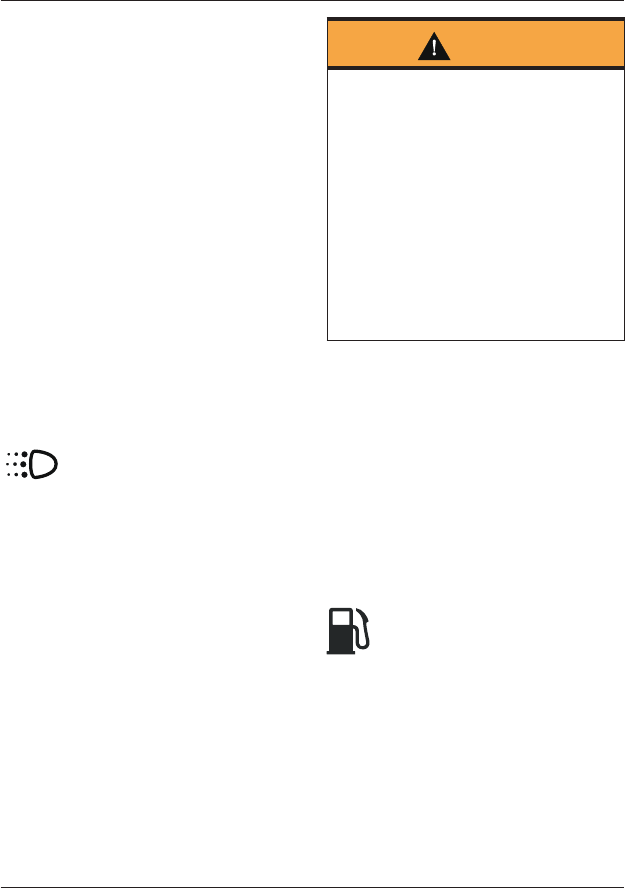
Instruments
29
If the DRL switch is in the daytime
running lights position, then press and
hold the high beam button to turn the
high beam on. It will remain on as long
as the button is held in and will turn off
as soon as the button is released.
Note:
• A lighting on/off switch is not
installed on this model. The brake/
tail light and license plate light all
function automatically when the
ignition is turned to the ON position.
• The headlight will function when
the ignition switch is turned to the
ON position. The headlight will go
off while pressing the starter
button until the engine starts.
Daytime Running Lights (DRL)
When the ignition is switched
ON and the daytime running lights
switch is set to DAYTIME RUNNING
LIGHTS, the daytime running lights
warning light will illuminate.
The daytime running lights and low
beam headlights are operated manually
using a switch on the left hand switch
housing, see page 97.
Warning
Do not ride for longer than necessary
in poor ambient light conditions with
the Daytime Running Lights (DRL) in
use.
Riding with the Daytime Running
Lights when dark, in tunnels or where
poor ambient light is apparent may
reduce the riders vision or blind other
road users.
Blinding other road users or reduced
vision in low ambient light levels may
result in loss of motorcycle control and
an accident.
Note:
• During daylight hours the Daytime
Running Lights improve the
motorcycles visibility to other road
users.
• Low beam headlights must be used
in any other conditions unless the
road conditions allow for high beam
headlights to be used.
Low Fuel Warning Light
The low fuel warning light will
illuminate when there is approximately
1.0 gallon (3.5 liters) of fuel remaining in
the tank.
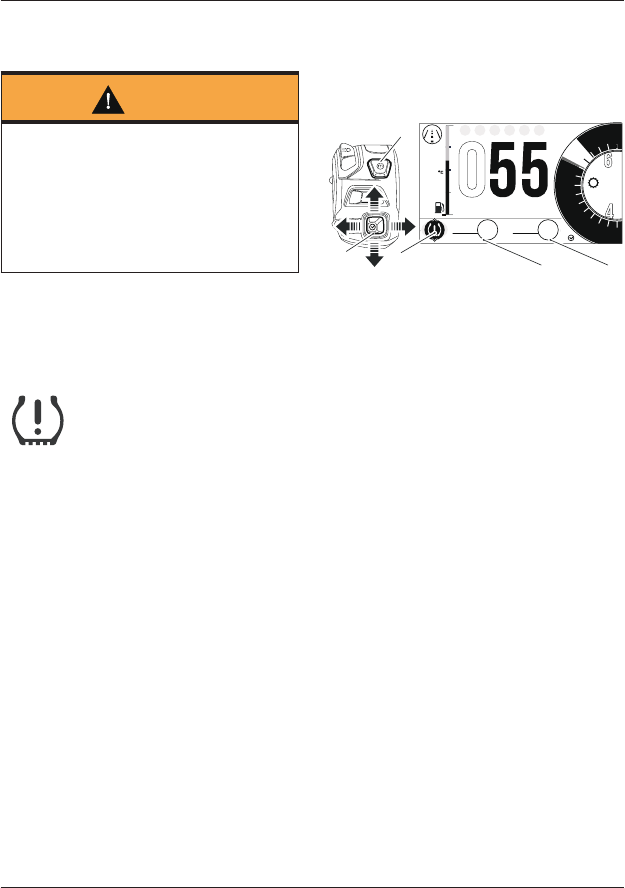
Instruments
30
Tire Pressure Monitoring System
(TPMS) Warning Light (if equipped)
Warning
Stop the motorcycle if the Tire
Pressure Monitoring System (TPMS)
warning light illuminates red.
Do not ride the motorcycle until the
tires have been checked and the tire
pressures are at their recommended
pressure when cold.
Note:
• The Tire Pressure Monitoring
System (TPMS) is available as an
accessory option on all models.
The TPMS warning light will
only illuminate red when the front or
rear tire pressure is below the
recommended pressure, or no signal is
received. It will not illuminate if the tire
is over inflated. For more information,
see page 111.
When the warning light is illuminated,
the TPMS symbol indicating which is the
deflated tire and its pressure will
automatically be visible in the display
area.
o7:29
12.5
19999 02:25
8
65
4
2
0
12 14
25.2
F
E
TRIP
mi mp/hHH:MM
PM
RPM
x1000
mph
cjww
36
PSI
FR
18
PSI
10
1
4
5
2 3
1. TPMS light
2. Front tire indicator
3. Rear tire indicator
4. Mode button
5. Joystick control
The tire pressure at which the warning
light illuminates is temperature
compensated to 68°F (20°C) but the
numeric pressure display associated
with it is not, see page 189. Even if the
numeric display seems at or close to the
standard tire pressure when the
warning light is on, a low tire pressure is
indicated and a puncture is the most
likely cause.
Speedometer and Odometer
The speedometer indicates the road
speed of the motorcycle.
The odometer shows the total distance
that the motorcycle has travelled.
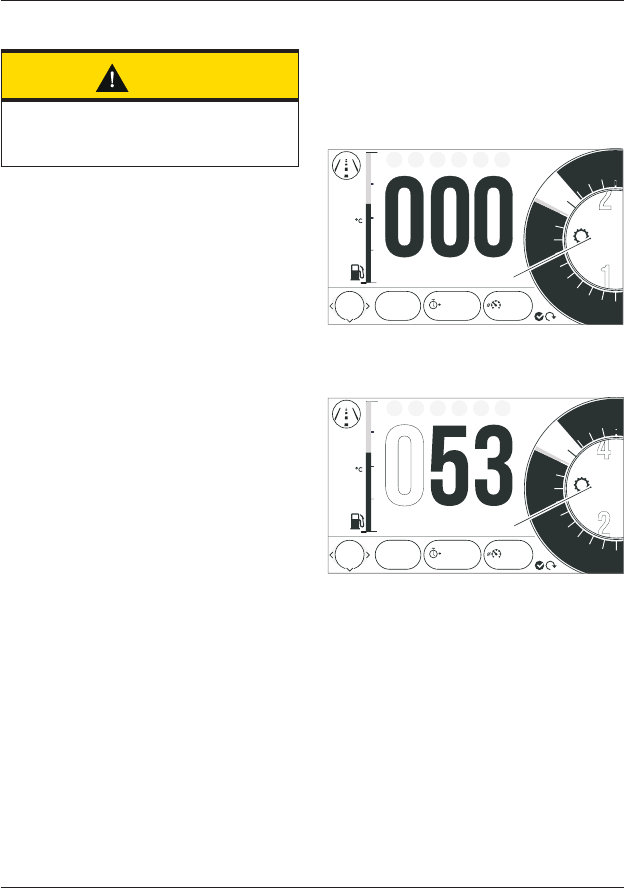
Instruments
31
Tachometer
Caution
Never allow engine speed to enter the
red zone as severe engine damage may
result.
The tachometer shows the engine
speed in revolutions per minute - rpm
(r/min). At the end of the tachometer
range there is the red zone.
Engine speeds in the red zone are above
maximum recommended engine speed
and are also above the range for best
performance.
Gear Position Display
The gear position display indicates
which gear (one to six) has been
engaged. When the transmission is in
neutral (no gear selected), the display
will show N.
o7:29
12.5
19999 02:25
8
6
4
2
0
12 14
25.2
F
E
TRIP
mi mp/hHH:MM
PM
RPM
x1000
10
1
N
1. Gear position display (neutral position
shown)
o7:29
12.5
19999 02:25
8
63
4
2
0
12 14
25.2
F
E
TRIP
mi mp/hHH:MM
PM
RPM
x1000
10
1
1. Gear position display (third gear
shown)
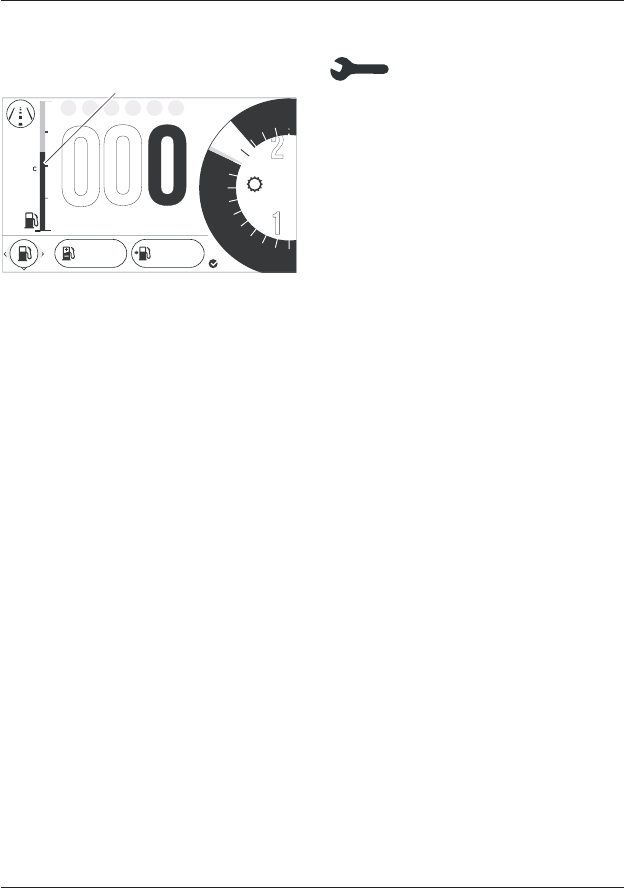
Instruments
32
Fuel Gage
The fuel gage indicates the amount of
fuel in the tank.
o7:29
17.5
8
6N
4
2
0
12
14
F
E
AM
RPM
x1000
mph
1
42 122 mi
RANGE
mpg
10
1. Fuel gage
With the ignition switched on, a filled
line indicates the fuel remaining in the
fuel tank.
Note:
• The fuel gage colors may vary
depending on the theme or style
chosen.
The gage markings indicate
intermediate fuel levels between E
(empty) and F (full).
The low fuel warning light will illuminate
when approximately 1.0 gallon (3.5 liters)
of fuel is remaining in the tank and you
should refuel at the earliest opportunity.
The range to empty and instantaneous
fuel consumption will be also shown in
the information tray. Press the joystick
center to acknowledge and hide the low
fuel warning.
After refueling, the fuel gage and range
to empty information will be updated
only while riding the motorcycle.
Depending on the riding style, updating
could take up to five minutes.
Service Interval Announcement
The service interval
announcement shows the total distance
or time that the motorcycle has
remaining before a service is required.
When the remaining distance is 0 miles
(0 km), or the remaining time is 0 days,
the service symbol will remain on until
the service has been carried out and
the system has been reset by your
authorized Triumph dealer.
If the service is overdue then OVERDUE
will be shown and the service symbol
will be shown in the information tray.
When the service has been carried out
by your authorized Triumph dealer, the
system will be reset.
The distance to the next service or
OVERDUE message will also be shown
on the instrument start up screen when
the ignition is turned on.
The service symbol will also be shown if
a fault has occurred and the ABS and/
or MIL warning lights are illuminated.
Contact an authorized Triumph dealer
as soon as possible to have the fault
checked and rectified.
Ambient Air Temperature
The ambient air temperature is
displayed as either oC or oF.
When the motorcycle is stationary the
heat of the engine may affect the
accuracy of the ambient temperature
display.
Once the motorcycle starts moving the
display will return to normal after a
short time.
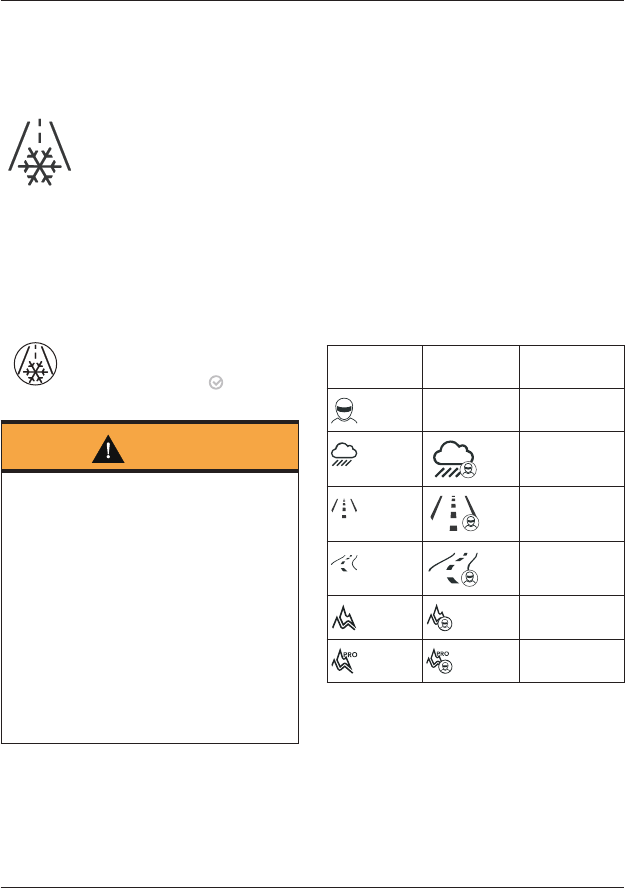
Instruments
33
To change the temperature from °C or
°F see page 53.
Frost Symbol
The frost symbol will
illuminate if the ambient air temperature
is 39°F (4°C) or lower.
The frost symbol will remain illuminated
until the temperature rises to 42°F (6°C).
An alert will also be displayed in the
information tray.
ACKNOWLEDGE
CAUTION: LOW AIR TEMPERATURE
RISK OF SURFACE ICE
1/3 warnings
Warning
Black ice (sometimes called clear ice)
can form at temperatures several
degrees above freezing (32°F (0°C)),
especially on bridges and in shaded
areas.
Always take extra care when the
temperatures are low and reduce
speed in potentially hazardous driving
conditions such as bad weather.
Excess speed, hard acceleration, heavy
braking or hard cornering when roads
are slippery may result in loss of
motorcycle control and an accident.
Riding Modes
The riding modes allow adjustment of
the throttle response (MAP), Anti-lock
Brake System (ABS) and Traction Control
(TC) settings to suit differing road
conditions and rider preferences.
Riding modes can be conveniently
selected using the MODE button and
joystick located on the left hand switch
housing, while the motorcycle is
stationary or moving, see page 34.
Up to six riding modes are available
depending on your model’s specification.
If a riding mode is edited (other than the
RIDER mode), the icon will change as
shown below.
Default Icon Rider Edited
Icon
Description
-RIDER
RAIN
ROAD
SPORT
OFF-ROAD
OFF-ROAD PRO
Each riding mode is adjustable. For more
information, see page 44.
Availability of the ABS, MAP and TC
setting options vary between models.
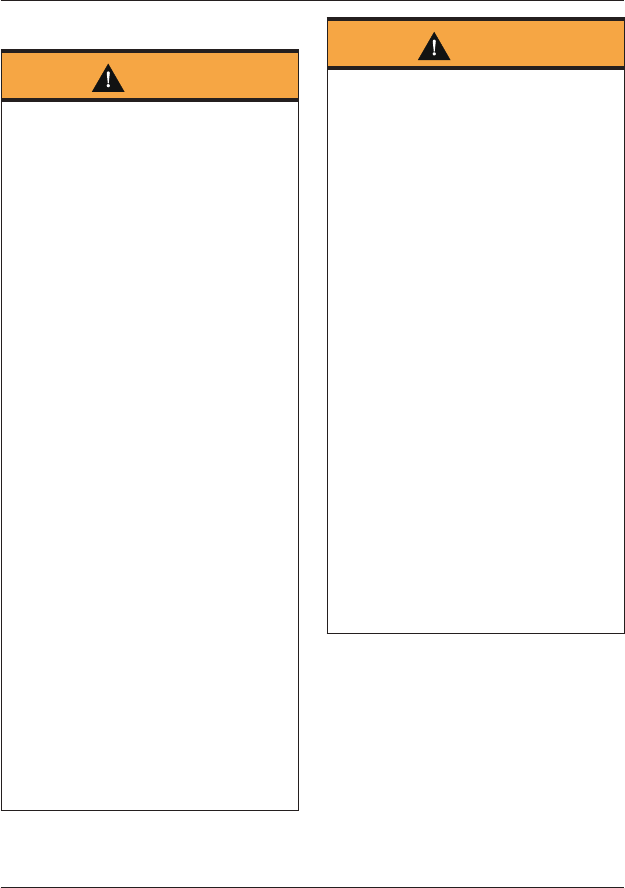
Instruments
34
Riding Mode Selection
Warning
The selection of riding modes while the
motorcycle is in motion requires the
rider to allow the motorcycle to coast
(motorcycle moving, engine running,
throttle closed, clutch lever pulled in
and no brakes applied) for a brief
period of time.
Riding mode selection while the
motorcycle is in motion should only be
attempted:
• At low speed
• In traffic-free areas
• On straight and level roads or
surfaces
• In good road and weather conditions
• Where it is safe to allow the
motorcycle to briefly coast.
Riding mode selection while the
motorcycle is in motion MUST NOT be
attempted:
• At high speeds
• While riding in traffic
• During cornering or on winding roads
or surfaces
• On steeply inclined roads or surfaces
• In poor road/weather conditions
• Where it is unsafe to allow the
motorcycle to coast.
Failure to observe this important
warning may lead to loss of motorcycle
control and an accident.
Warning
If ABS and/or traction control (TC) has
been disabled in the Main Menu as
described on, page 48 for ABS and/or
page 48 for TC settings saved for all
riding modes will be overridden.
ABS and/or TC will remain off
regardless of your riding mode
selection until they have been re-
enabled or, the ignition has been
switched off then on again, or the
MODE button is held in to return to the
default ROAD mode (which enables ABS
and/or TC when the motorcycle is next
stationary).
If the ABS is disabled, the brake system
will function as a non-ABS equipped
braking system. In this situation
braking too hard will cause the wheels
to lock, and may result in loss of
motorcycle control and an accident.
If the traction control is disabled, the
motorcycle will handle as normal but
without traction control. In this
situation accelerating too hard on wet/
slippery road surfaces may cause the
rear wheel to slip, and may result in
loss of motorcycle control and an
accident.

Instruments
35
Warning
After selecting a riding mode, operate
the motorcycle in an area free from
traffic to gain familiarity with the new
settings.
Do not loan your motorcycle to anyone
as they may change the riding mode
settings from the one you are familiar
with, causing loss of motorcycle control
and an accident.
Note:
• The riding mode will default to
ROAD when the ignition is switched
ON, if the OFF-ROAD or RIDER mode
was active the last time the ignition
was switched OFF with ABS or TC
set to OFF-ROAD or OFF in either of
those modes.
• Otherwise, the last selected riding
mode will be remembered and
activated when the ignition is
switched ON.
• If the mode icons are not visible
when the ignition switch is in the
ON position, make sure that the
engine stop switch is in the RUN
position.
Note:
• If the battery is disconnected, then
the RIDER mode settings will
default back to the original factory
settings.
The current riding mode is shown in the
upper left of the display screen.
To select a riding mode:
• Press and release the MODE button
on the left hand switch housing to
activate the riding mode selection
tray at the bottom of the display
screen.
• The currently active riding mode
icon is highlighted with a blue
background.
To change the selected riding mode:
• Either push the joystick left or
right, or repeatedly press the MODE
button until the required mode is in
the center of the display screen,
highlighted with an arrow above it.
• A brief press of the joystick center
will select the required riding mode,
and the icon in the upper left of the
display screen will change.
o7:29
12.5
8
6N
4
2
0
12 14
1
F
E
2 3 4 5 6
PM
RPM
x1000
mph
m
10
3
2
2
1
1. MODE button
2. Current riding mode
3. New riding mode
• Push the joystick left/right or press
the MODE button to scroll through
the riding mode options in the
following order:
– RIDER
– RAIN
– ROAD
– SPORT
– OFF-ROAD
– OFF-ROAD PRO.
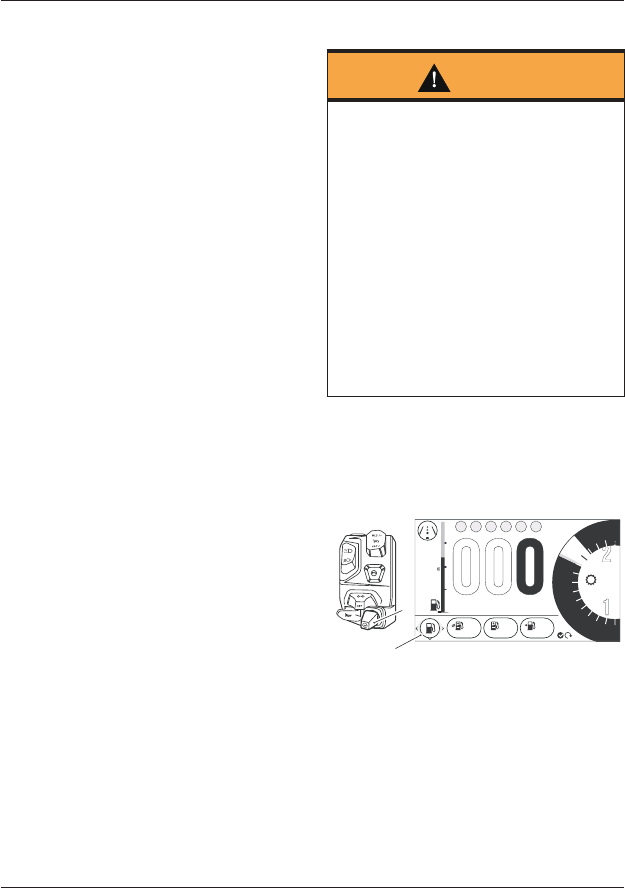
Instruments
36
The selected mode is activated once the
following conditions for switching modes
have been met:
Motorcycle Stationary - Engine Off
• The ignition is switched ON
• The engine stop switch is in the
RUN position.
Motorcycle Stationary - Engine Running
• Neutral gear is selected or the
clutch is pulled in.
Motorcycle in Motion
Within 30 seconds of selecting a riding
mode the rider must carry out the
following simultaneously:
• Close the throttle
• Pull the clutch in
• Make sure that the brakes are not
engaged (allow the motorcycle to
coast).
Note:
• It is not possible to switch into or
out of OFF_ROAD or RIDER modes
while the motorcycle is in motion, if
the ABS or TC settings are set to
OFF-ROAD or OFF in either of those
modes.
• In this case, the motorcycle must
be brought to a stop before the
riding mode change can take place.
If a riding mode change is not
completed, the icon will alternate
between the previous riding mode and
the newly selected riding mode until the
change is complete or it is canceled.
The riding mode selection is now
complete and normal riding can be
resumed.
Information Tray
Warning
When the motorcycle is in motion, only
attempt to switch between the
information tray modes or reset the
fuel information under the following
conditions:
• At low speed
• In traffic free areas
• On straight and level roads or
surfaces
• In good road and weather conditions.
Failure to observe this important
warning could lead to loss of
motorcycle control and an accident.
The information tray appears at the
bottom of the display screen and allows
easy access to different motorcycle
status information.
07:29
17.5 8
6N
4
2
0
12 14
F
E
AM
RPM
x1000
mph
o
10
59 42 12
MPG MPG RANGE
2
1
1. Joystick control
2. Information tray
To view the different information tray
items, push the joystick left/right until
the required information tray item is
shown.
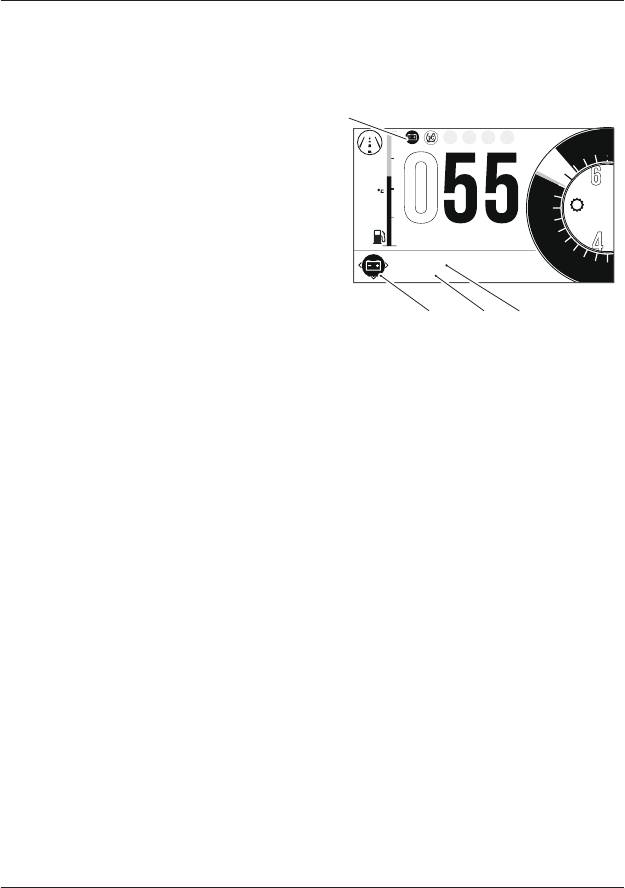
Instruments
37
Note:
• To access the information tray, the
warning messages must first be
acknowledged, see page 37.
The information tray contains the
following information tray items:
• Warnings and Information
Messages, see page 37
• Fuel Information, see page 38
• Tire Pressure Monitoring System
(TPMS) (if equipped), see page 39
• Odometer, see page 39
• Service Interval Announcement, see
page 39
• Screen Contrast, see page 41
• Style Options, see page 41
• Coolant Temperature, see page 41
• Screen Adjustment Height, see
page 42
• Triumph Semi Active Suspension
(TSAS), see page 40
• Trip Meter, see page 38
Different information tray items can be
shown or hidden from the information
tray. For further information, refer to
page 52.
Warnings
Any warnings and information
messages are shown in the Warnings
tray. An example is shown below.
o7:29
12.5 8
65
4
2
0
12 14
F
E
PM
RPM
x1000
10
mph
LOW BATTERY
CHECK MANUAL
1/2 warnings
13
1
2
1. Low battery warning
2. Warning counter
3. Warning description
To view the warnings:
• Push the joystick left/right to scroll
through the options until the
warning review is shown.
• Push the joystick down/up to
review each warning (if more than
one). The warning counter will show
the number of warnings that are
present.
• Push the joystick left/right to
return to the information tray.

Instruments
38
Trip Meter
There are two trip meters that can be
accessed and reset in the information
tray.
10123 02:25 42.5
TRIP
mi
TRIP
HH:MM
mi
mph
HH:MM mph
20246 04:50 42.5
Trip Meter Information Tray
To view a specific trip meter:
• Push the joystick left/right to scroll
through the information tray items
until Trip 1 meter is shown.
• Select TRIP 1 or TRIP 2 by pushing
the joystick down/up.
Note:
• TRIP 2 meter can be shown or
hidden from the information tray.
For more information, see page 50.
To reset a trip meter:
• Select the trip meter to be reset.
• Press and hold the joystick center
for more than one second.
• The trip meter will then be reset.
The trip meter can also be reset from
the Main menu, see page 49.
Fuel Status Information
The Fuel Status information tray shows
fuel consumption information.
59 42 12
MPG MPG RANGE
1235
4
1. Fuel information light
2. Average fuel consumption
3. Instantaneous fuel consumption
4. Range to empty
5. Reset
Fuel Information Light
This light illuminates when the fuel level
warning light is activated.
Average Fuel Consumption
This is an indication of the average fuel
consumption. After being reset the
display will show dashes until 0.1 miles/
km has been covered.
Instantaneous Fuel Consumption
An indication of the fuel consumption at
an instant in time. If the motorcycle is
stationary, --.- will be shown in the
display area.
Range to Empty
This is an indication of the predicted
distance that can be traveled on the
remaining fuel in the tank.
Reset
To reset the average fuel consumption,
press and hold the joystick center.
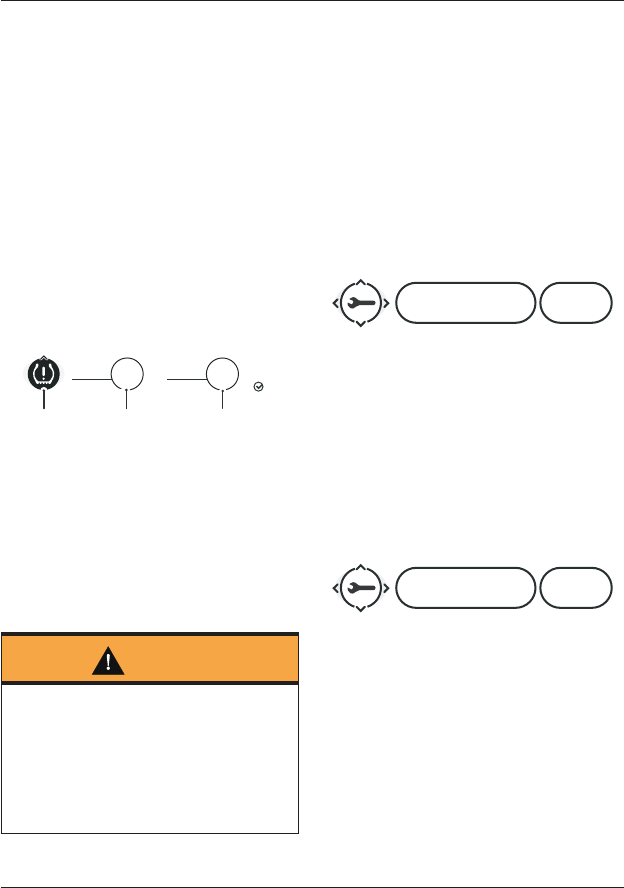
Instruments
39
Note:
• After refueling, the fuel gage and
range to empty information will be
updated only while riding the
motorcycle. Depending on the riding
style, updating could take up to five
minutes.
Tire Pressure Monitoring System
(TPMS) (if equipped)
The Tire Pressure Monitoring System
(TPMS) information tray item shows the
front and rear tire pressures and the
TPMS warning light. For more
information on TPMS, see page 111.
36
PSI
RF 18
PSI
123
1. TPMS warning light
2. Front tire pressure display
3. Rear tire pressure display
TPMS Warning Light
The warning light will only illuminate
when the front or rear tire pressure is
below the recommended pressure. It will
not illuminate if the tire is over inflated.
Warning
Stop the motorcycle if the Tire
Pressure Monitoring System (TPMS)
warning light illuminates.
Do not ride the motorcycle until the
tires have been checked and the tire
pressures are at their recommended
pressure when cold.
Front Tire Pressure Display
This shows the current front tire
pressure.
Rear Tire Pressure Display
This shows the current rear tire
pressure.
Odometer
The odometer shows the total distance
that the motorcycle has traveled.
9060 12/2018 0940OR
miODO
date
mi
Odometer Information Tray
Service Interval Announcement
The Service Interval Announcement
information tray shows the service
symbol, the distance/days remaining
before the next service and the current
odometer reading.
9060 12/2018 0940OR
miODO
date
mi
Service Interval Announcement
Information Tray
For more information on service interval
announcements, see page 32.

Instruments
40
Triumph Semi Active Suspension
(TSAS)
The Triumph Semi Active Suspension
(TSAS) information tray item allows
adjustment of the TSAS settings.
COMFORT
AUTO ON-ROAD
NORMAL SPORT
TSAS Information Tray
(Showing SPORT Selected)
To adjust the TSAS settings:
• Push the joystick left/right to scroll
through the options until the TSAS
settings display is shown.
• Push the joystick center to activate
the TSAS adjustment mode.
Note:
• If the riding modes link is disabled,
changes made to the TSAS damping
settings will remain active until
further adjustment takes place,
regardless of riding mode selection.
• If the riding modes link is enabled,
any adjustments made to the TSAS
damping settings will be saved to
the currently active riding mode.
The new TSAS settings will be
automatically recalled whenever
the riding mode is reselected. The
riding mode’s previous TSAS
settings will be overwritten.
• If the riding modes link is enabled
and a new riding mode is selected,
the new riding mode’s TSAS
settings will automatically become
active.
• TSAS has nine damping settings
ranging from COMFORT (soft) to
SPORT (firm).
• Press and release the joystick
center allows individual selection of
each of the nine settings.
• Press and hold the joystick control
allows direct selection of the preset
COMFORT, NORMAL and SPORT
settings.
• There is a short time-out period to
allow for further scrolling to take
place. After the time-out period has
elapsed, the selected damping
setting will be automatically
activated and the display will
return to the home screen.
Alternatively, press the joystick
center to confirm the setting and
return to the home screen.
For more information on Triumph Semi
Active Suspension (TSAS), see page 108.
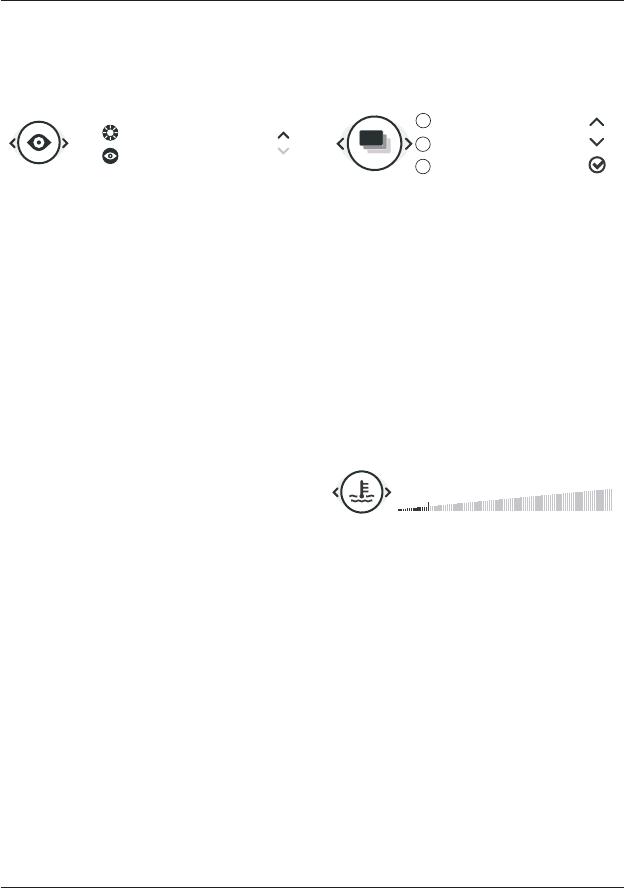
Instruments
41
Screen Contrast
The Screen Contrast information tray
item allows the display screen contrast
to be adjusted.
HIGH CONTRAST
AUTO CONTRAST
Screen Contrast Information Tray
There are two options available:
• HIGH CONTRAST - This option locks
the display screen to the white
background version of each display
screen style for maximum visibility.
• AUTO CONTRAST - This option uses
the instrument light sensor to
adjust the contrast to the most
suitable setting. In bright sunlight,
low brightness settings will be
overridden to make sure that the
instruments can be viewed at all
times.
To select an option:
• Push the joystick down/up to select
either the HIGH CONTRAST or AUTO
CONTRAST option and press the
joystick center to confirm.
If the rider defined brightness setting is
suitable this will be used, see page 52.
Note:
• Do not cover the light sensor on the
display screen as this will stop the
screen contrast from working
correctly.
Style Options
The Style Options information tray item
allows a different style to be applied to
the display screen.
STYLE 1
STYLE 2
STYLE 3
3
2
1
Style Options Information Tray
(Style 2 Selected)
To change the display screen style:
• Push the joystick down/up to select
the required style and then press
the joystick center to confirm.
Coolant Temperature
The Coolant Temperature information
tray item indicates the temperature of
the engine coolant.
COOLANT
C
H
Coolant Temperature Information Tray
When the engine is started from cold
the display will show grey bars. As the
temperature increases more bars in the
display will be shown illuminated. When
the engine is started from hot the
display will show the relevant number of
illuminated bars, dependant on engine
temperature.
The range is between C (cold) and H
(hot) on the display.
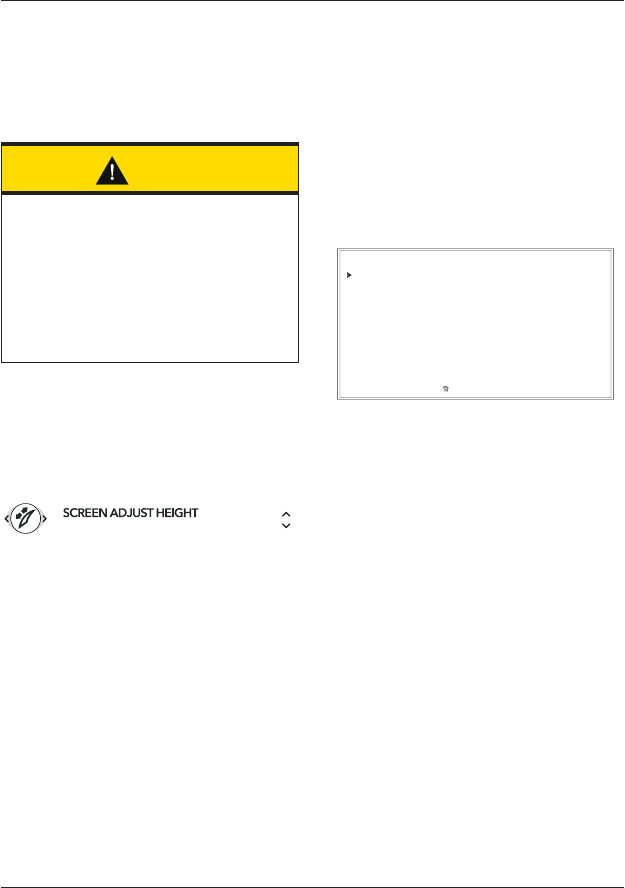
Instruments
42
With the engine running, if the engine
coolant temperature becomes
dangerously high, the high coolant
temperature warning light on the
display will be illuminated and the gage
will be shown in the information tray.
Caution
Stop the engine immediately if the high
coolant temperature warning light
illuminates. Do not restart the engine
until the fault has been rectified.
Severe engine damage will result from
running the engine when the high
coolant temperature warning light is
illuminated.
Windshield Adjustment
The Windshield Adjustment information
tray option allows the windshield height
to be adjusted to an optimum setting.
Windshield Adjustment Mode
To adjust the windshield height:
• Push the joystick left/right until the
windshield adjust option is
highlighted.
• Push the joystick up/down to
adjust the windshield to the
required height.
• Push the joystick left/right to
access another tray item.
Main Menu
To access the Main menu:
• The motorcycle must be stationary
with the ignition switched on.
• Press the HOME button on the
right handlebar switch housing.
• Scroll the Main menu by pushing
the joystick down/up until the
required option is selected and
then press the joystick center to
confirm.
RIDING MODES
BIKE SETUP
TRIP SETUP
DISPLAY SETUP
EXIT
MAIN MENU
RESET TO DEFAULTS
Main Menu Screen
The Main menu allows access to the
following options:
Riding Modes
This menu allows configuration of the
riding modes. For more information, see
page 44.
Bike Set Up
This menu allows configuration of the
following different features of the
motorcycle. For more information, see
page 45.
Trip Set Up
This menu allows configuration of Trip 1
and Trip 2. For more information, see
page 49.

Instruments
43
Display Set Up
This menu allows configuration of the
display options. For more information,
see page 51.
Reset to Defaults
This menu allows all instrument settings
to be returned to the default setting.
For more information, see page 55.
Riding Modes Menu
The Riding Modes menu allows
configuration of the riding modes.
RIDING MODES
BIKE SETUP
TRIP SETUP
DISPLAY SETUP
EXIT
MAIN MENU
RESET TO DEFAULTS
To access the Riding Modes menu:
• Press the HOME button to display
the Main menu.
• Push the joystick down and then
press the joystick center to select
RIDING MODES.
The following model specific options are
available:
• Rider
• Rain
• Road
• Sport
• Off-Road
• Off-Road Pro
• Reset To Defaults.
Riding Modes
To change the riding modes settings:
• From the Riding Modes menu, push
the joystick down/up to select a
specific riding mode and press the
joystick center to confirm.
RIDING MODES
BIKE SETUP
TRIP SETUP
DISPLAY SETUP
EXIT
MAIN MENU RIDING MODES
RIDER
ROAD
SPORT
RESET TO DEFAULTS
RAIN
RESET ALL TO DEFAULTS
OFF-ROAD
OFF-ROAD PRO
• Push the joystick down/up until the
required setting option is selected
and press the joystick center to
confirm.
EXIT
RIDING MODES
ROAD
SPORT
ABS
MAP
TC
RESET TO DEFAULTS
RIDER
RAIN
RIDER
OFF-ROAD PRO
RESET ALL TO DEFAULTS
OFF-ROAD
• Push the joystick down/up until the
required option is selected and
press the joystick center to confirm.
EXIT
ABS
MAP
TC
RIDER ABS
ROAD
RESET TO DEFAULTS
OFF
OFF-ROAD
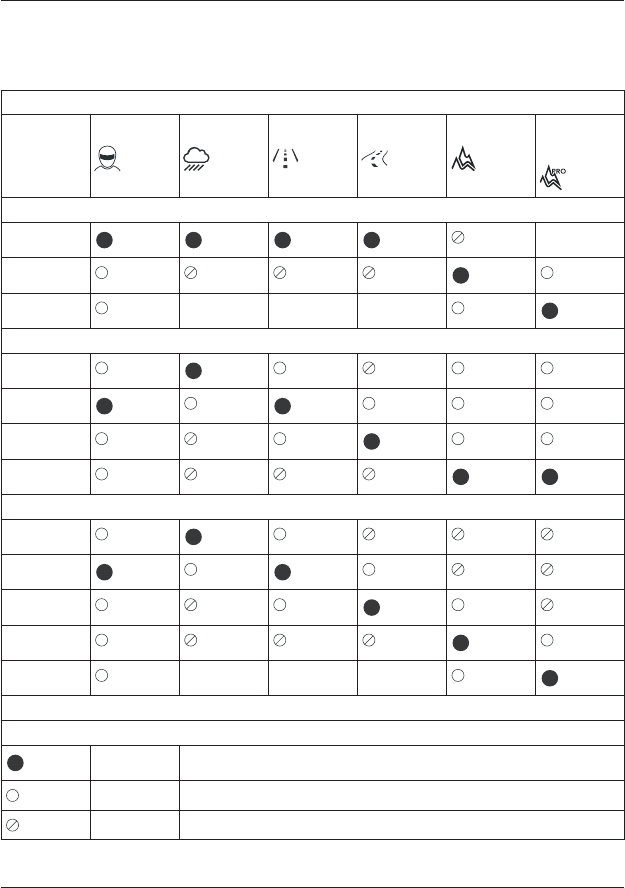
Instruments
44
Riding Mode Configuration
Refer to the following table for the ABS, MAP and TC options available for each riding
mode.
Riding Mode
RIDER RAIN ROAD SPORT OFF-ROAD OFF-ROAD
PRO
ABS (Anti-lock Braking System)
Road
Off-Road1
Off Via Menu Via Menu Via Menu
MAP (Throttle Response)
Rain
Road
Sport1
Off-Road1
TC (Traction Control)
Rain
Road
Sport1
Off-Road1
Off Via Menu Via Menu Via Menu
1 Model Specific
Key
Standard (Factory Default Setting)
Selectable Option
Option Not Available

Instruments
45
Bike Set Up Menu
The Bike Set Up menu allows
configuration of the different features
of the motorcycle.
RIDING MODES
BIKE SETUP
TRIP SETUP
DISPLAY SETUP
EXIT
MAIN MENU
RESET TO DEFAULTS
BIKE SETUP
INDICATORS
ABS
TC
SERVICE
TSAS
TRIUMPH SHIFT ASSIST
HILL HOLD
To access the Bike Set Up menu:
• Press the HOME button to display
the Main menu.
• Push the joystick down and then
press the joystick center to select
BIKE SET UP.
The options available are:
• Triumph Semi Active Suspension
(TSAS)
• Triumph Shift Assist
• Hill Hold
• Turn Signals
• Anti-Lock Braking System (ABS)
• Traction Control (TC)
• Service.
Bike Set Up - TSAS
The Triumph Semi-Active Suspension
System (TSAS) controls adjustment of
the front and rear suspension damping
and automatic rear suspension preload
settings. For more information on TSAS,
see page 108.
TSAS
TRIUMPH SHIFT ASSIST
HILL HOLD
INDICATORS
EXIT
BIKE SETUP
ABS
TSAS
MODE
SETTING (ON-ROAD)
SETTING (OFF-ROAD)
RIDING MODES LINK
TC
SERVICE
Riding Modes Link
The riding modes link allows you to
enable or disable the link between TSAS
and the riding modes.
If the riding modes link is disabled,
changes made to the TSAS damping
settings will remain active until further
adjustment takes place, regardless of
riding mode selection.
If the riding modes link is enabled, any
adjustments made to the TSAS damping
settings will be saved to the currently
active riding mode. The new TSAS
settings will be automatically recalled
whenever the riding mode is reselected.
The riding mode’s previous TSAS
settings will be overwritten.
If the riding modes link is enabled and a
new riding mode is selected, the new
riding mode’s TSAS settings will
automatically become active.

Instruments
46
To disable or enable the TSAS riding
modes link:
• Press the joystick center to select
RIDING MODES LINK.
• Push the joystick down/up to scroll
between DISABLED and ENABLED.
• Press the joystick center to select
the required option.
Mode
This allows the adjustment of the
settings from soft to hard by adjusting
the rebound and compression damping
settings.
Selecting AUTO sets the TSAS system to
automatically detect the type of surface
being ridden on (road or off-road) and
will adjust the rebound and compression
damping settings accordingly.
Setting On-Road
This applies the optimal TSAS settings
for on-road use and adjusts the
rebound and compression damping
settings accordingly.
Setting Off-Road
This applies the optimal TSAS settings
for off-road use and adjusts the
rebound and compression damping
settings accordingly.
Bike Set Up - Triumph Shift Assist
(if equipped)
Triumph Shift Assist triggers a
momentary engine cut to allow gears to
engage, without closure of the throttle
or operation of the clutch. This feature
works for both up-shifts and down-
shifts of gear.
The clutch must be used for stopping
and pulling away.
Triumph Shift Assist will not operate if
the clutch is applied or if an up-shift is
attempted by mistake when in 6th gear.
It is necessary to use a positive pedal
force to make sure there is a smooth
gear shift.
TSAS
TRIUMPH SHIFT ASSIST
HILL HOLD
INDICATORS
EXIT
BIKE SETUP
ABS
TRIUMPH SHIFT ASSIST
DISABLED
ENABLED
TC
SERVICE
To enable/disable Triumph Shift Assist:
• From the Bike Set Up menu, push
the joystick down to select
TRIUMPH SHIFT ASSIST and press
the joystick to confirm.
• Push the joystick down/up to scroll
between ENABLED and DISABLED.
• Press the joystick center to confirm
the required selection.
• The display will then return to the
BIKE SET UP menu.

Instruments
47
Bike Set Up - Hill Hold Control
(if equipped)
Hill hold control assists in making hill
starts. The system (when activated) will
apply the rear brake to hold the
motorcycle in position. The system will
then automatically deactivate and
release the rear brake when it detects
that the motorcycle is attempting to
move off.
TSAS
TRIUMPH SHIFT ASSIST
HILL HOLD
INDICATORS
EXIT
BIKE SETUP
ABS
HILL HOLD
DISABLED
ENABLED
TC
SERVICE
To enable/disable hill hold control:
• From the Bike Set Up menu, push
the joystick down to select HILL
HOLD and press the joystick center
to confirm.
• Push the joystick down to select
either ENABLED or DISABLED.
• Press the joystick center to confirm
the required selection.
• The display will then return to the
Bike Set Up menu.
For more information on hill hold
control, see page 152.
Bike Set Up - Turn Signals
The turn signals can be set to Auto
Basic, Auto Advanced or Manual mode.
EXIT
BIKE SETUP INDICATORS
MANUAL
AUTO BASIC
AUTO ADVANCED
SERVICE
TC
ABS
INDICATORS
TSAS
TRIUMPH SHIFT ASSIST
HILL HOLD
Selecting a Turn Signals Mode
To select the required turn signals mode:
• From the Bike Set Up menu, push
the joystick down to select
INDICATORS and press the joystick
center to confirm.
• Push the joystick down/up to scroll
between AUTO BASIC, AUTO
ADVANCED and MANUAL.
– Auto Basic - The self-canceling
function is on. The turn signals
will activate for eight seconds
and an additional 213 ft. (65
meters).
– Auto Advanced - The self-
canceling function is on. A
quick short press activates the
turn signals for three flashes.
A longer press activates the
turn signals for eight seconds
and an additional 213 ft. (65
meters).
– Manual - The self-canceling
function is off. The turn signals
must be manually canceled
using the turn signal switch.
• Press the joystick center to confirm
the required selection.
• The display will then return to the
Bike Set Up menu.

Instruments
48
Bike Set Up - ABS
It is possible to temporarily disable the
ABS. The ABS cannot be permanently
disabled, it will be automatically enabled
when the ignition is turned off and then
on again, or if the default riding mode is
activated by a long press of the MODE
button.
EXIT
BIKE SETUP ABS
DISABLED
ENABLED
SERVICE
TC
ABS
INDICATORS
TSAS
TRIUMPH SHIFT ASSIST
HILL HOLD
To select the required option:
• From the Bike Set Up menu, push
the joystick down to select ABS and
press the joystick center to confirm.
• Push the joystick down/up to scroll
between ENABLED and DISABLED.
• Press the joystick center to confirm
the required selection.
• The display will then return to the
Bike Set Up menu.
Bike Set Up - Traction Control (TC)
It is possible to temporarily disable the
traction control system. The traction
control cannot be permanently disabled,
it will be automatically enabled when the
ignition is turned off and then on again,
or if the default riding mode is activated
by a long press of the MODE button.
EXIT
BIKE SETUP TC
DISABLED
ENABLED
SERVICE
TC
ABS
INDICATORS
TSAS
TRIUMPH SHIFT ASSIST
HILL HOLD
To select the required option:
• From the Bike Set Up menu, push
the joystick down to select TC and
press the joystick center to confirm.
• Push the joystick down/up to scroll
between ENABLED and DISABLED.
• Press the joystick center to select
the required option.
The display will then return to the BIKE
SET UP display.
Bike Set Up - Service
The service interval is set to a distance
and/or time period.
EXIT
BIKE SETUP
INDICATORS
ABS
SERVICE
5450 mi
01-01-2017 (335 DAYS)
TC
SERVICE
RESET

Instruments
49
To review the service interval:
• From the Bike Set Up menu, push
the joystick down to select SERVICE
and press the joystick center to
confirm.
• Press the joystick center to display
the SERVICE information.
• Selecting RESET allows you to reset
the standard time and distance,
and also any custom times and
distances.
• The display will then return to the
Bike Set Up menu.
Trip Setup
The Trip Set Up menu allows
configuration of the trip meters. Each
trip meter can be configured to be reset
either manually or automatically. The
setup procedure is the same for both
trip meters.
To access the Trip Set Up menu:
• Press the HOME button to display
the Main menu.
• Push the joystick down and then
press the joystick center to select
TRIP SET UP.
The options available are:
• TRIP 1 RESET
• TRIP 2 RESET
• TRIP 2 DISPLAY
Trip Setup - Manual Reset
Manual reset of the trip meters will only
reset the selected trip meter when the
rider chooses to do so.
EXIT
MAIN MENU
MANUAL
AUTOMATIC
RESET NOW AND CONTINUE
CONTINUE WITHOUT RESET
MANUAL
To set the trip meter to reset manually:
• Push the HOME button to display
the MAIN MENU.
• Push the joystick down and then
press the joystick center to select
TRIP SETUP.
• Push the joystick down and then
press the joystick center to select
TRIP 1 RESET or TRIP 2 RESET.
• Push the joystick center to select
MANUAL.
There are two options:
– RESET NOW AND CONTINUE -
Resets all trip meter data in
the relevant trip meter, and
the trip meter will only reset
when manually done so by the
rider.
– CONTINUE WITHOUT RESET -
The trip meter will not be
reset. The trip meter will only
reset when manually done so
by the rider.
• Press the joystick center to confirm
the selection and return to the
previous menu.
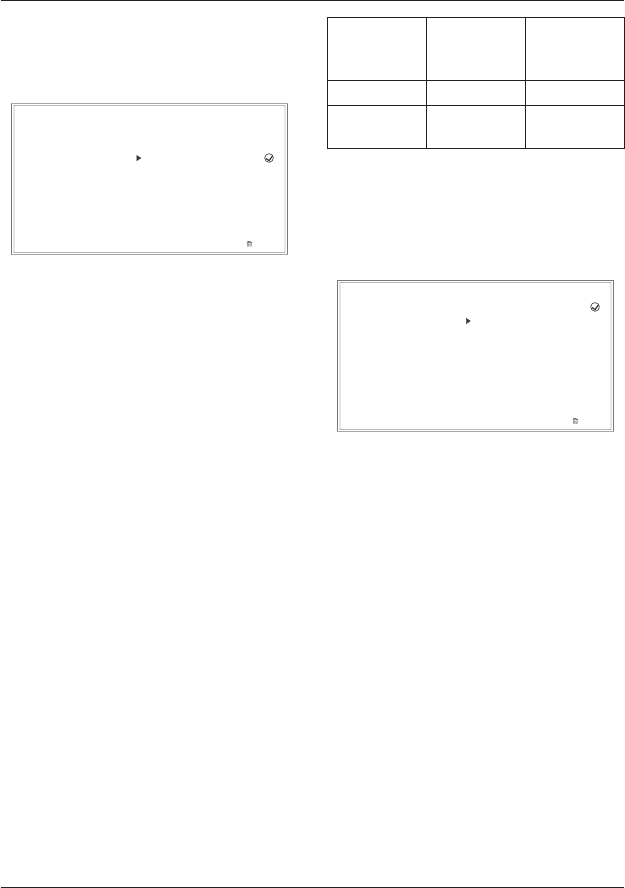
Instruments
50
Trip Setup - Automatic Reset
Automatic reset will reset each trip
meter after the ignition has been
switched off for a set time.
EXIT
TRIP 1 RESET
MANUAL
AUTOMATIC
AUTOMATIC
1 HR
2 HRS
4 HRS
8 HRS
12 HRS
16 HRS
To set the trip meters to reset
automatically:
• Push the HOME button to display
the MAIN MENU.
• Push the joystick down and then
press the joystick center to select
TRIP SETUP.
• Push the joystick down/up and
then press the joystick center to
select TRIP 1 RESET or TRIP 2
RESET.
• Push the joystick down/up and
select AUTOMATIC and then press
the joystick center.
• Push the joystick down/up to select
the timer setting and press the
joystick center to confirm the
required time limit. The required
time limit is then stored in the trip
memory.
When the ignition is turned off, the trip
meter is set to zero when the time
period has elapsed.
The following table shows two examples
of the automatic trip reset functionality.
Ignition
Turned Off
Selected
Time Delay
Trip Meter
Resets to
Zero
10:30 hrs 4 HRS 14:30 hrs
18:00 hrs 16 HRS 10:00 hrs
(next day)
Trip 2 Enable/Disable
Trip 2 meter can be enabled or disabled.
If Trip 2 is disabled it will no longer be
shown in the information tray.
TRIP SETUP
EXIT
TRIP 1 RESET
TRIP 2 DISPLAY
TRIP 2 RESET
TRIP 2 DISPLAY
ENABLED
DISABLED
To enable or disable the Trip 2 meter:
• Push the MODE button to display
the MAIN MENU.
• Push the joystick down to select
TRIP SET UP.
• Push the joystick center to display
the TRIP SET UP menu.
• Push the joystick down/up to scroll
to the TRIP 2 DISPLAY and press
the joystick center.
• Push the joystick down/up to scroll
between ENABLED and DISABLED
and press the joystick center.

Instruments
51
Display Set Up Menu
The Display Set Up menu allows
configuration of the different display
screen options.
EXIT
DISPLAY SETUP
LANGUAGE
UNITS
THEME
BRIGHTNESS (High Contrast)
CLOCK
BRIGHTNESS (Low Contrast)
VISIBLE TRAY
DATE
MAIN MENU
RIDING MODES
BIKE SETUP
TRIP SETUP
DISPLAY SETUP
RESET TO DEFAULTS
To access the Display Set Up menu:
• Press the HOME button to display
the Main menu.
• Push the joystick down and then
press the joystick center to select
DISPLAY SET UP.
The following options are available:
• Styles and Themes
• Brightness
• Visible Tray
• Shift Indicator
• Language
• Set Units
• Set Clock
• Set Date.
Display Set Up - Styles and Themes
Note:
• Themes are only available on
Tiger 1200 XRT and Tiger 1200 XCA.
EXIT
THEME
THEME 1
THEME 2
THEME 1
AUTO
STYLE 1
STYLE 2
STYLE 3
Theme and Style Menu Example
EXIT
STYLE
DISPLAY SETUP
AUTO
STYLE 1
STYLE
STYLE 2
STYLE 3
Style Menu Example
To select a style or theme:
• From the Display Set Up menu,
push the joystick down to select
the STYLES or THEME (if equipped)
menu.
– Tiger 1200 XRT and Tiger 1200
XCA: Push the joystick down/
up to scroll between the
THEMES.
– Press the joystick center to
confirm the selected THEME.
– All Models: Push the joystick
down/up to scroll between the
STYLES.
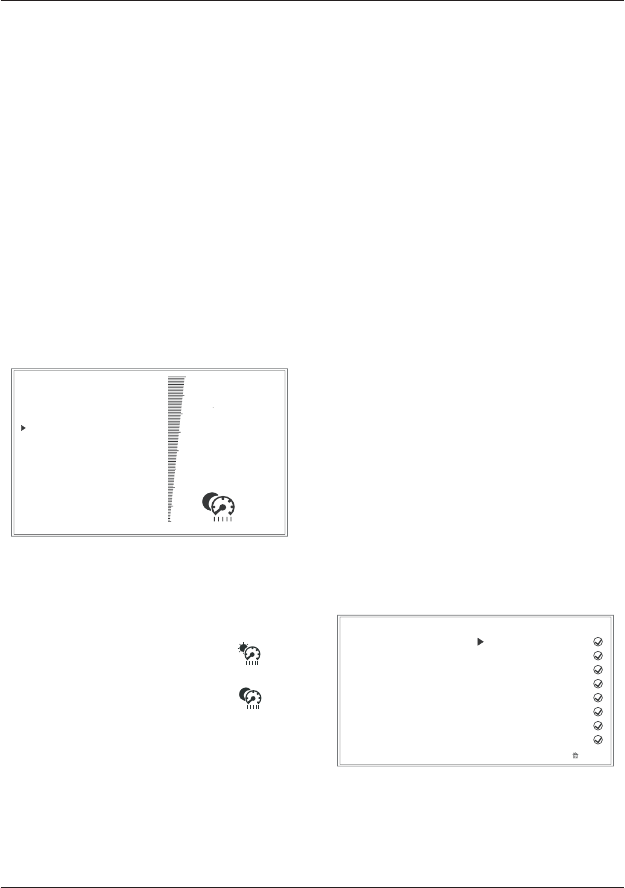
Instruments
52
– Press the joystick center to
confirm the selected STYLE.
• The new style or theme will be
saved. Press the HOME button to
exit.
Note:
• Selecting AUTO will prevent a style
tray from being displayed. The style
is changed with riding modes.
Display Set Up - Brightness
The brightness feature allows the
screen’s brightness contrast to be
changed for day time and night time
riding.
BRIGHTNESS
(LOW CONTRAST)
9
8
7
6
5
4
3
2
1
BRIGHTNESS (High Contrast)
THEME
BRIGHTNESS (Low Contrast)
VISIBLE TRAY
LANGUAGE
UNITS
CLOCK
DATE
DISPLAY SETUP
BRIGHTNESS (LOW CONTRAST) Shown
There are two brightness options to
choose:
• High contrast
(day time mode)
• Low contrast
(night time mode)
To change the brightness level:
• From the Display Set Up menu,
push the joystick down to select
BRIGHTNESS and press the joystick
center to confirm.
• Push the joystick down to select
BRIGHTNESS (High Contrast) or
BRIGHTNESS (Low Contrast) menu.
• Press the joystick center to select
the required menu.
• Push the joystick down/up to
adjust the brightness.
• Press the joystick center to confirm
the required level of brightness.
• Press the HOME button to return
to the main display.
Note:
• In bright sunlight, low brightness
settings will be overridden to make
sure that the instruments can be
viewed at all times.
Display Set Up - Visible Tray
The Visible Tray feature allows the
selection of required information tray
items to be shown in the information
tray.
EXIT
DISPLAY SETUP
LANGUAGE
UNITS
THEME
BRIGHTNESS (High Contrast)
CLOCK
BRIGHTNESS (Low Contrast)
VISIBLE TRAY
DATE
TRIP 2
TRIP 3
FUEL STATUS
CONTRAST
STYLE
VISIBLE TRAY
COOLANT
TPMS
SERVICE INTERVAL

Instruments
53
To select the Visible Tray menu:
• From the Display Set Up menu,
push the joystick down to select
VISIBLE TRAY and press the
joystick center to confirm.
• Push the joystick down/up until the
required information tray item is
selected.
• Press the joystick center to select/
deselect the information tray item.
An information tray item with a tick
next to it will be shown in the tray.
An information tray item without a
tick next to it will not be shown in
the tray.
Display Set Up - Language
There are several different languages
that can be selected to be shown in the
display screen.
EXIT
DISPLAY SETUP
LANGUAGE
UNITS
THEME
BRIGHTNESS (High Contrast)
CLOCK
LANGUAGE
ENGLISH
ESPAÑOL
ITALIANO
DEUTSCH
FRANÇAIS
BRIGHTNESS (Low Contrast)
VISIBLE TRAY
DATE
NEDERLANDS
PORTUGUÊS
SVENSKA
To select a different language:
• From the Display Set Up menu,
push the joystick down to select
LANGUAGE and press the joystick
center to confirm.
• Push the joystick down/up until the
required language is selected.
• Press the joystick center to select/
deselect the required language.
Display Set Up - Set Units
There are different units of
measurement options that can be
shown in the display screen.
EXIT
LANGUAGE
UNITS
THEME
BRIGHTNESS (High Contrast)
CLOCK
DISPLAY SETUP
BRIGHTNESS (Low Contrast)
VISIBLE TRAY
DATE
DISTANCE & ECONOMY
TEMPERATURE
PRESSURE
UNITS
To select the units of measurement
required:
• From the Display Set Up menu,
push the joystick down to select
SET UNITS and press the joystick
center to confirm.
• Push the joystick down/up to select
the required unit; DISTANCE &
ECONOMY, TEMPERATURE or
PRESSURE.
• Push the joystick down/up to select
the required unit of measurement
from the following options:
– DISTANCE & ECONOMY:
– MILES & MPG (UK)
– MILES & MPG (US)
– KM & L/100KM
– KM & KM/L
– TEMPERATURE:
– °C
– °F
– PRESSURE:
– PSI
– BAR
– KPa
• Press the joystick center to
confirm.
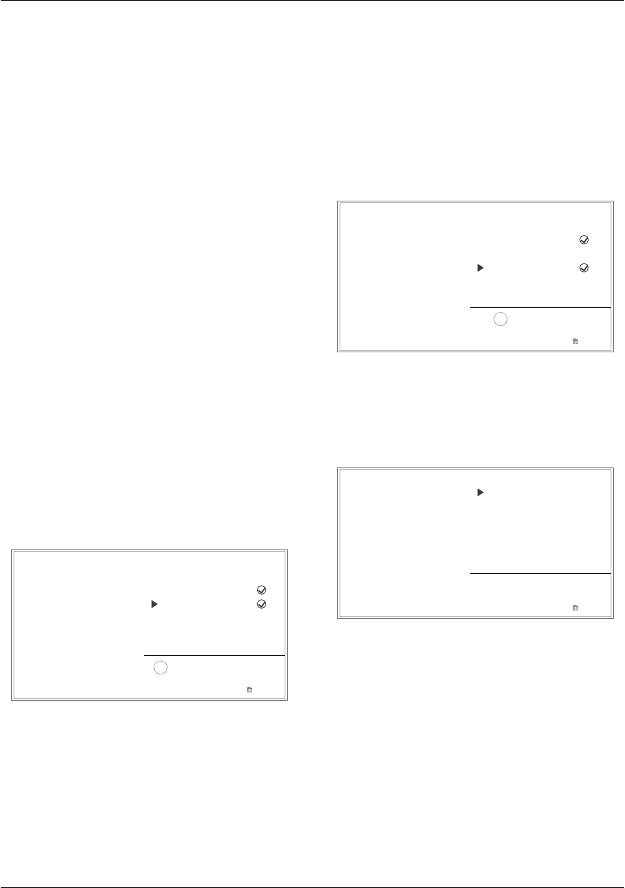
Instruments
54
Display Set Up - Set Clock
This function allows the adjustment of
the clock.
To set the clock:
• From the Display Set Up menu,
push the joystick down to select
SET CLOCK and press the joystick
center to confirm.
• Push the joystick down/up to select
between either 12 HR or 24 HR
clock and press the joystick center
to confirm selection. The clock will
display in either 12 or 24 hour
format. Once the clock format is set
the display will return to the SET
CLOCK menu.
To set the time, push the joystick down/
up to select HOUR or MINUTE.
To Adjust the Hour Setting
• Select HOUR on the display and
press the joystick center, a tick will
appear next to HOUR and the hour
display will flash as shown below.
• Push the joystick down/up to set
the hour and press the joystick
center to confirm.
EXIT
LANGUAGE
UNITS
THEME
BRIGHTNESS (High Contrast)
CLOCK
DISPLAY SETUP
12HR
MINUTE
HOUR
24HR
CLOCK
15:40
BRIGHTNESS (Low Contrast)
VISIBLE TRAY
DATE
To Adjust the Minute Setting
• Select MINUTE on the display and
press the joystick center, a tick will
appear next to MINUTE and the
minute display will flash as shown
below.
• Push the joystick down/up to set
the minute and press the joystick
center to confirm.
EXIT
LANGUAGE
UNITS
THEME
BRIGHTNESS (High Contrast)
CLOCK
DISPLAY SETUP
12HR
MINUTE
HOUR
24HR
CLOCK
15:40
BRIGHTNESS (Low Contrast)
VISIBLE TRAY
DATE
Display Set Up - Set Date
This function allows the adjustment of
the date and date format.
EXIT
LANGUAGE
UNITS
THEME
BRIGHTNESS (High Contrast)
CLOCK
DISPLAY SETUP
BRIGHTNESS (Low Contrast)
VISIBLE TRAY
DATE
DATE
DATE FORMAT
YEAR
MONTH
DAY

Instruments
55
To set the date format:
• From the Display Set Up menu,
push the joystick down to select
SET DATE and press the joystick
center to confirm.
• Press the joystick center to display
DATE FORMAT.
• Push the joystick down/up to select
either of the DD-MM-YYYY, MM-
DD-YYYY or YYYY-MM-DD formats
and press the joystick center to
confirm selection. Once the date
format is set the display will return
to the SET DATE menu.
EXIT
LANGUAGE
UNITS
THEME
BRIGHTNESS (High Contrast)
CLOCK
DISPLAY SETUP
BRIGHTNESS (Low Contrast)
VISIBLE TRAY
DATE
DATE
DATE FORMAT
YEAR
MONTH
DAY
To set the date, push the joystick down/
up to select the DAY, MONTH and YEAR.
• Select YEAR and then press the
joystick center, a tick will appear
next to the YEAR and the YEAR
display will flash.
• Push the joystick down/up to set
the current year and then press
the joystick center to confirm.
• To set the MONTH and DAY repeat
the procedure used to set the year.
Once the date is set the display will
return to the SET DATE menu.
Reset to Defaults
This function allows the main menu
display items to be reset to the default
setting.
RIDING MODES
BIKE SETUP
TRIP SETUP
DISPLAY SETUP
EXIT
MAIN MENU RESET TO DEFAULTS
CONFIRM
CANCEL
RESET TO DEFAULTS
To reset the Main menu display items:
• From the Main menu, push the
joystick down and select RESET TO
DEFAULTS.
• Press the joystick center to
confirm.
• Pushing the joystick down/up,
select CONFIRM or CANCEL from
the Reset to Defaults menu, and
press the joystick center to confirm.
• Confirm - The following main menu
settings and data will be reset to
the factory default values - Riding
Modes, Indicator Set Up, Trip
Computers, Visible Trays, Language,
ABS, Traction Control, Style, and
Display Brightness.
• Cancel - The main menu settings
and data will remain unchanged
and the display will return to the
previous level.
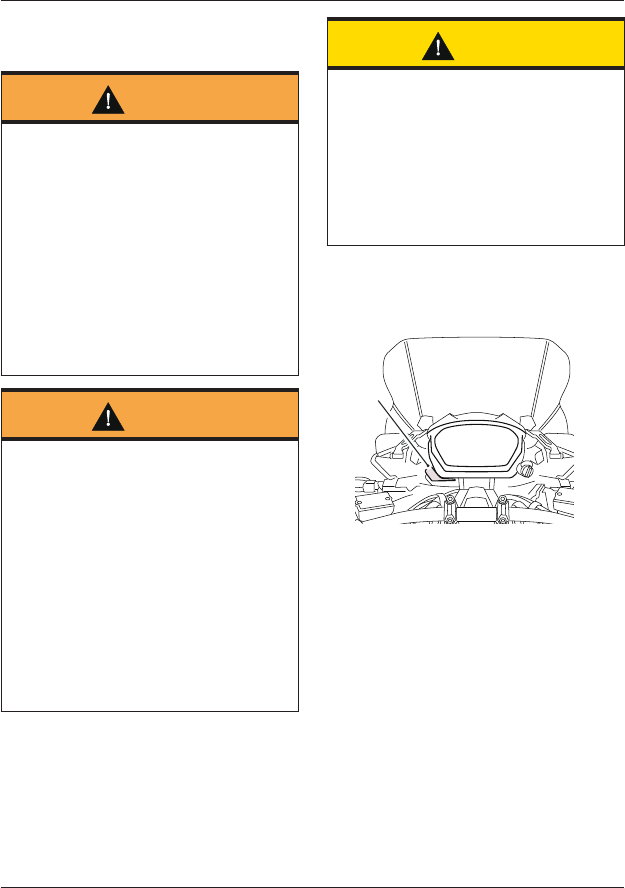
Instruments
56
Instrument Panel Position
Adjustment
Warning
Operation of the motorcycle with an
incorrectly adjusted instrument panel
is dangerous.
An incorrectly adjusted instrument
panel will result in loss of instrument
vision when riding and may cause a
distraction leading to loss of control of
the motorcycle and an accident.
Always adjust the instrument panel to
provide sufficient vision of the
instruments before riding the
motorcycle.
Warning
Never attempt to clean or adjust the
instrument panel while riding the
motorcycle. Removal of the rider’s
hands from the handlebars while riding
the motorcycle will diminish the ability
of the rider to maintain control of the
motorcycle.
Attempting to clean or adjust the
instrument panel while riding the
motorcycle may result in loss of control
of the motorcycle and an accident.
Only attempt to clean or adjust the
instrument panel while stationary.
Caution
Do not press directly onto the
instrument panel display screen.
Only adjust the position of the
instrument panel using the adjustment
handle.
Pressing directly on the instrument
panel display screen may damage the
instrument panel.
The instrument panel can be adjusted
to allow for improved visibility of the
display screen.
1
1. Adjustment handle
To adjust the instrument panel:
Note:
• Moderate force using the thumb
and finger is required to adjust the
position of the instrument panel.
Position the instrument panel to allow
an unobstructed view of the display
screen using the adjustment handle.
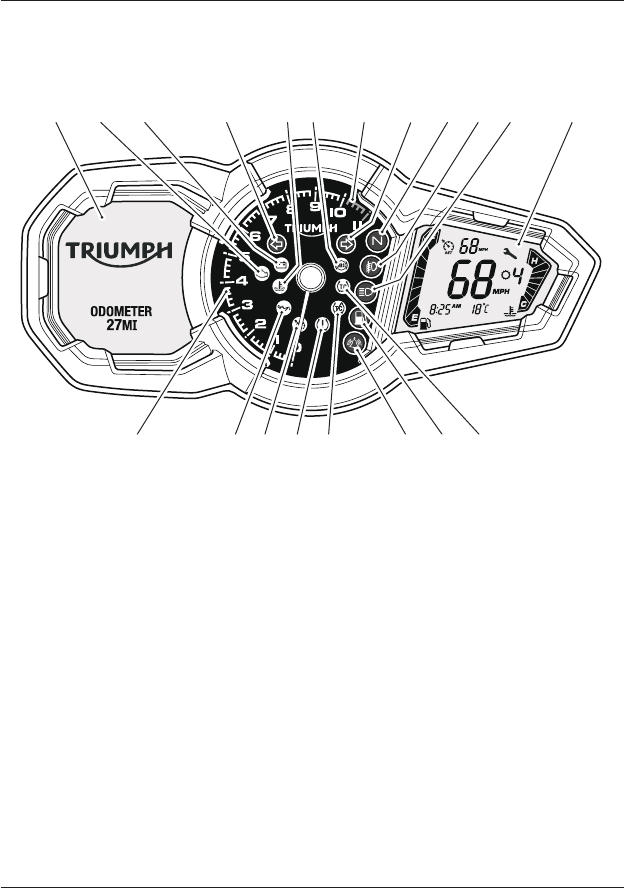
Instruments
58
Instrument Panel Layout
The LCD instrument display is only mounted to the Tiger 1200 XR model.
cisz
123 4 5 6 7 9 10 11 12
1314151617181920
8
1. Multifunction display screen
2. Engine management Malfunction
Indicator Light (MIL)
3. Battery warning light
4. Left hand turn signal light
5. High coolant temperature warning light
6. ABS warning light
7. Tachometer red zone
8. Right hand turn signal light
9. Neutral indicator light
10. Fog lights indicator light
11. High beam indicator light
12. Motorcycle status display screen
13. Traction control indicator light
14. Low fuel level indicator light
15. Alarm/immobilizer status indicator
light (alarm is an accessory kit)
16. Traction control disabled warning light
17. Tire pressure warning light (if equipped
with Tire Pressure Monitoring System
(TPMS))
18. Cruise control light
19. Low oil pressure warning light
20. Tachometer
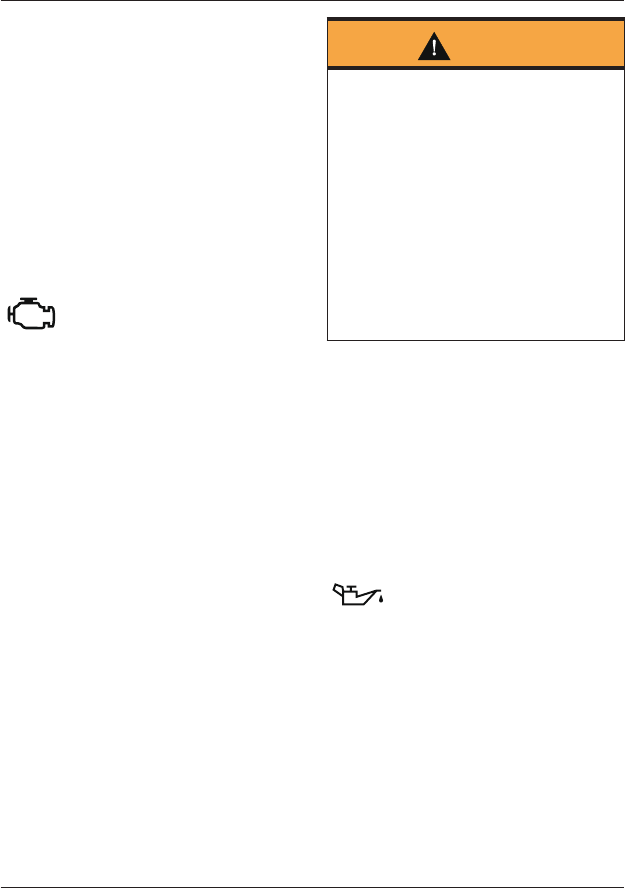
Instruments
59
Warning Lights
Note:
• When the ignition is switched on,
the instrument warning lights will
illuminate for 1.5 seconds and will
then go off (except those which
remain on until the engine starts,
as described in the following pages).
Engine Management System
Malfunction Indicator Light (MIL)
The Malfunction Indicator Light
(MIL) for the engine management
system illuminates when the ignition is
switched ON (to indicate that it is
working) but should not become
illuminated when the engine is running.
If the MIL becomes illuminated when the
engine is running, this indicates that a
fault has occurred in one or more of the
systems controlled by the engine
management system. In such
circumstances, the engine management
system will switch to 'limp-home' mode
so that the journey may be completed, if
the fault is not so severe that the
engine will not run.
Warning
Reduce speed and do not continue to
ride for longer than is necessary with
the MIL illuminated. The fault may
adversely affect engine performance,
exhaust emissions and fuel
consumption.
Reduced engine performance could
cause a dangerous riding condition,
leading to loss of control and an
accident.
Contact an authorized Triumph dealer
as soon as possible to have the fault
checked and rectified.
Note:
• If the MIL flashes when the ignition
is switched ON contact an
authorized Triumph dealer as soon
as possible to have the situation
rectified. In these circumstances
the engine will not start.
Low Oil Pressure Warning Light
With the engine running, if the
engine oil pressure becomes
dangerously low, the low oil pressure
warning light in the tachometer will
illuminate and WARNING - OIL
PRESSURE LOW will be displayed in the
multifunction display screen.
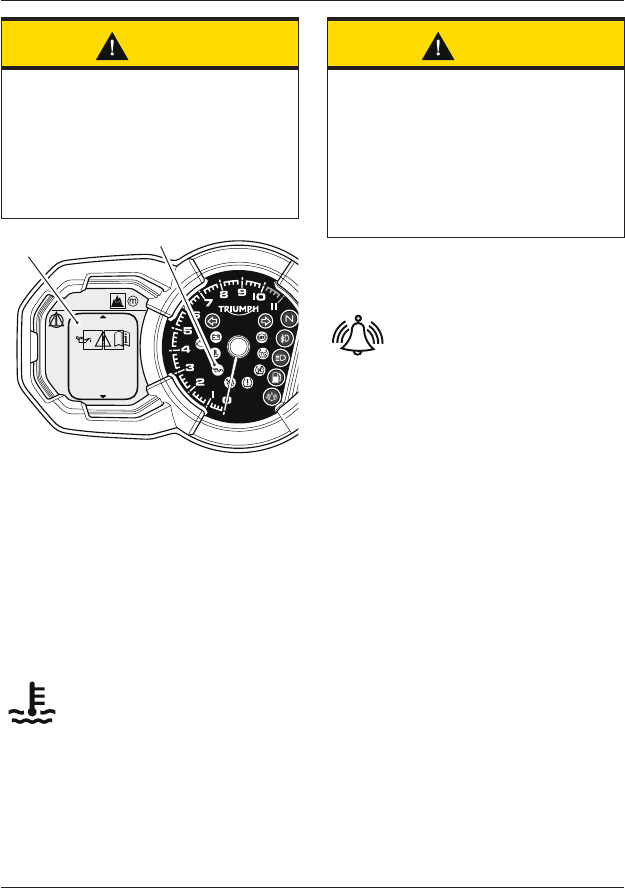
Instruments
60
Caution
Stop the engine immediately if the low
oil pressure warning light illuminates.
Do not restart the engine until the
fault has been rectified.
Severe engine damage will result from
running the engine when the low oil
pressure warning light is illuminated.
OFF-ROAD
WARNING
OIL PRESSURE
LOW
CHECK MANUAL
PRESS SELECT
TO CLEAR
1
2
1. Low oil pressure warning light
2. Instrument message
The low oil pressure warning light in the
tachometer will illuminate if the ignition
is switched on without running the
engine.
High Coolant Temperature Warning
Light
With the engine running, if the
engine coolant temperature becomes
dangerously high, the high coolant
temperature warning light will illuminate.
Caution
Stop the engine immediately if the high
coolant temperature warning light
illuminates. Do not restart the engine
until the fault has been rectified.
Severe engine damage will result from
running the engine when the high
coolant temperature warning light is
illuminated.
Immobiliser/Alarm Indicator Light
This Triumph motorcycle is
equipped with an engine immobilizer
which is activated when the ignition
switch is turned to the OFF position.
Without Alarm Equipped
When the ignition switch is turned to
the OFF position, the immobilizer/alarm
light will flash on and off for 24 hours to
show that the engine immobilizer is on.
When the ignition switch is turned to
the ON position the immobilizer and the
indicator light will be off.
If the indicator light remains on it
indicates that the immobilizer has a
malfunction that requires investigation.
Contact an authorized Triumph dealer
as soon as possible to have the fault
checked and rectified.
With Alarm Equipped
The immobilizer/alarm light will only
illuminate when the conditions
described in the genuine Triumph
accessory alarm instructions are met.
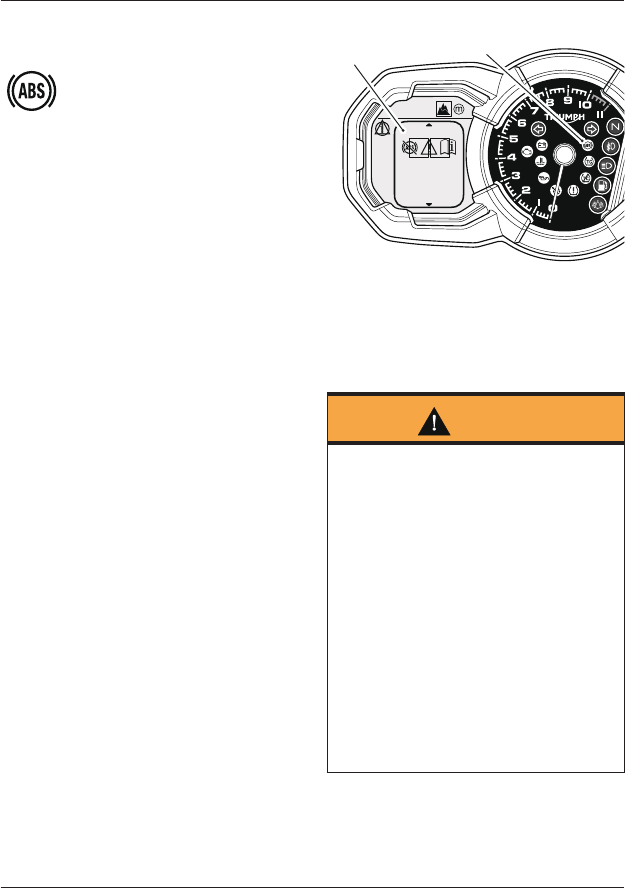
Instruments
61
ABS (Anti-Lock Brake System)
Warning Light
When the ignition switch is
turned to the ON position, it is normal
that the ABS warning light will flash on
and off. The light will continue to flash
after engine start-up until the
motorcycle first reaches a speed
exceeding 6 mph (10 km/h) when it will
go off.
The warning light should not illuminate
again until the engine is restarted
unless there is a fault, or:
• ABS is disabled by the rider - the
warning light will remain illuminated
(see Bike Setup on page 76 or
Riding Mode Configuration on
page 85).
• ABS is set to Off-Road – the
warning light will flash slowly (see
Riding Mode Configuration on
page 85).
Note:
• Traction control and cruise control
may not function if there is a
malfunction with the ABS system.
In this situation, the warning lights
for the ABS, traction control and
the MIL may be illuminated.
If the warning light becomes illuminated
at any other time while riding it
indicates that the ABS has a
malfunction that requires investigation.
The following warning message may be
displayed:
• WARNING - ABS SYSTEM DISABLED
The braking system will be affected as
follows:
WARNING - ABS SYSTEM DISABLED
OFF-ROAD
WARNING
ABS SYSTEM
DISABLED
CHECK MANUAL
PRESS SELECT
TO CLEAR
1
2
1. ABS warning light
2. Instrument message
The message WARNING - ABS SYSTEM
DISABLED indicates that the ABS is not
functioning.
Warning
If the ABS is not functioning or has
been disabled by the rider (see Bike
Setup on page 76 or Riding Mode
Configuration on page 85), the brake
system will continue to function as a
non-ABS braking system.
Do not continue to ride for longer than
is necessary with the warning light
illuminated. In the event of a fault,
contact an authorized Triumph dealer
as soon as possible to have the fault
checked and rectified.
In this situation, braking too hard will
cause the wheels to lock resulting in
loss of motorcycle control and an
accident.
See also Braking on page 146.
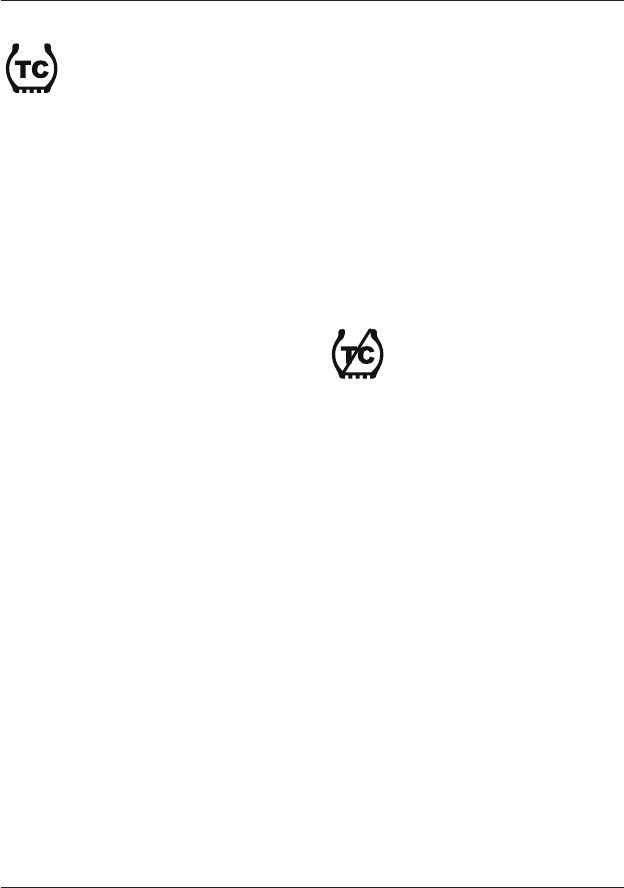
Instruments
62
Traction Control (TC) Indicator Light
The TC indicator light is used to
indicate that the TC system is active
and is working to limit rear wheel slip
during periods of hard acceleration or
under wet or slippery road conditions.
TC Indicator Light Operation:
TC Switched On (Rain, Road or Sport
Settings):
• Under normal riding conditions the
indicator light will remain off.
• The indicator light will flash rapidly
when the TC system is working to
limit rear wheel slip during periods
of hard acceleration or under wet
or slippery road conditions.
TC Switched On (Off-Road Setting):
• Under normal riding conditions, the
indicator light will flash slowly to
indicate that the TC system is set
to Off-Road.
• The TC indicator light will flash
rapidly when the TC system is
working to limit rear wheel slip
during periods of hard acceleration
or under wet or slippery conditions.
TC Switched Off:
The indicator light will not illuminate.
Instead the TC disabled warning light
will be illuminated.
Note:
• Traction control may not function if
there is a malfunction with the ABS
system. In this situation, the
warning lights for the ABS, TC and
the MIL may be illuminated.
Traction Control (TC) Disabled
Warning Light
The TC disabled warning light
should not illuminate unless TC is
disabled by the rider (see Bike Setup on
page 76 or Riding Mode Configuration on
page 85).
If the warning light becomes illuminated
at any other time while riding, it
indicates that the TC system has a
malfunction that requires investigation.
The following warning message may be
displayed:
• WARNING - TC SYSTEM DISABLED
The TC system will be affected as
follows:
The message WARNING - TC SYSTEM
DISABLED indicates that the traction
control system is not functioning.
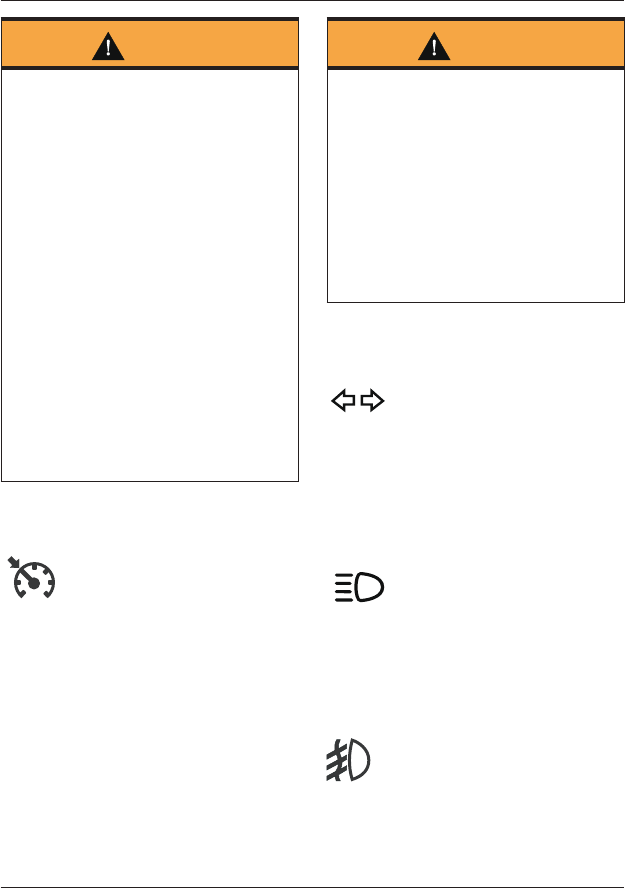
Instruments
63
Warning
If the Traction Control (TC) system is
not functioning, care must be taken
when accelerating and cornering on
wet/slippery road surfaces to avoid
rear wheel spin.
In the event of a fault, the TC disabled
warning light may be accompanied by
the engine management system
malfunction indicator light and/or the
ABS warning light.
Do not continue to ride for longer than
is necessary with any of the above
warning lights illuminated. Contact an
authorized Triumph dealer as soon as
possible to have the fault checked and
rectified.
Hard acceleration and cornering in this
situation may cause the rear wheel to
spin resulting in loss of motorcycle
control and an accident.
Cruise Control Light
The cruise control can only be
activated when the motorcycle is
traveling at a speed between
19 to 100 mph (30 to 160 km/h) and is in
3rd gear or higher. When activated, the
cruise control light in the tachometer
will be illuminated (see page 104).
Warning
Cruise control must only be used
where you can ride safely at a steady
speed.
Cruise control should not be used
when riding in heavy traffic, on roads
with sharp/blind bends or when they
are slippery.
Using cruise control in heavy traffic, on
roads with sharp/blind bends or when
they are slippery, may result in loss of
motorcycle control and an accident.
Turn Signals
When the turn signal switch is
turned to the left or right, the indicator
warning light will flash on and off at the
same speed as the turn signals.
High Beam Switch
When the ignition is switched
ON and the headlight dimmer switch is
set to HIGH BEAM, the high beam
warning light will illuminate.
Fog Lights (if equipped)
When the ignition is switched on
and the fog lights are switched on, the
fog lights warning light will illuminate.
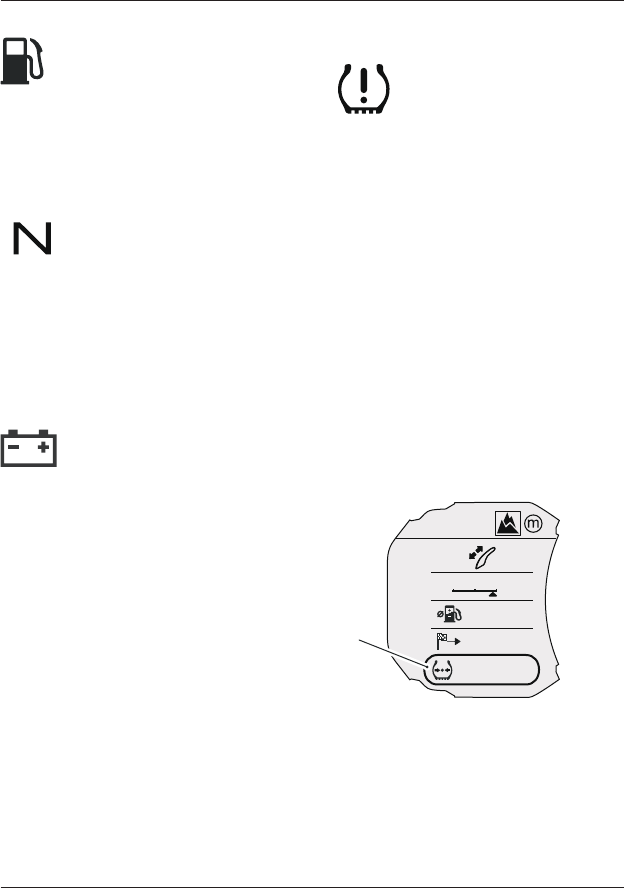
Instruments
64
Low Fuel Warning Light
The low fuel warning light will
illuminate when there is approximately
1.0 gallon (3.5 liters) of fuel remaining in
the tank.
Neutral
The neutral warning light
indicates when the transmission is in
neutral (no gear selected). The warning
light will illuminate when the
transmission is in neutral with the
ignition switch in the ON position.
Battery Warning Light
When the ignition is switched
on, the battery warning light will only
illuminate if a fault is recognized with
the battery.
With the engine running, if the battery
voltage becomes low, the battery
warning light in the tachometer will
illuminate and the message WARNING -
BATTERY LOW will also be shown in the
multifunction display screen.
Once the battery is fully charged the
warning light will go out and the
instrument message will be deactivated.
If the battery warning light remains on
it indicates that there is a malfunction
that requires investigation. Contact an
authorized Triumph dealer as soon as
possible to have the fault checked and
rectified.
Tire Pressure Warning Light
(if equipped with TPMS)
The tire pressure warning
light works in conjunction with the Tire
Pressure Monitoring System (TPMS) (see
page 111).
The warning light will only illuminate
when the front or rear tire pressure is
below the recommended pressure. It will
not illuminate if the tire is over inflated.
When the warning light is illuminated,
the message TPMS - FRONT/REAR TIRE
LOW PRESSURE will be shown in the
multifunction display screen.
Press the SELECT button to
acknowledge the message and return to
the home screen.
After pressing the SELECT button, the
tire pressures display will be
automatically shown in the motorcycle
information section of the home screen.
OFF-ROAD
AUTO
OFF-ROAD
MPG
MI
PSI
PSI
CNS
1
2
36
42
F
R
47
12
1
1. Tire pressures display
The tire pressure at which the warning
light illuminates is temperature
compensated to 68°F (20°C) but the
numeric pressure display associated
with it is not (see page 111). Even if the
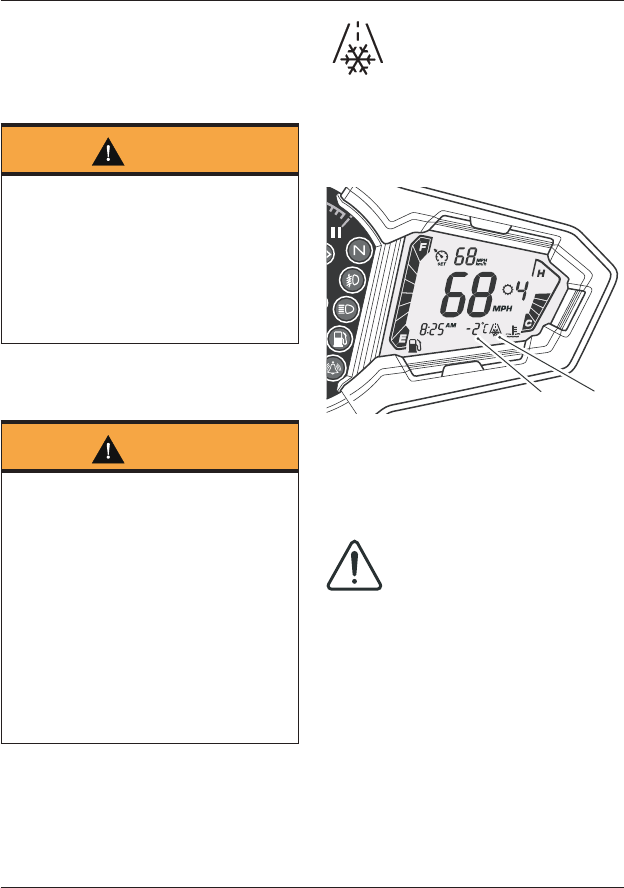
Instruments
65
numeric display seems at or close to the
standard tire pressure when the
warning light is on, a low tire pressure is
indicated and a puncture is the most
likely cause.
Warning
Stop the motorcycle if the tire pressure
warning light illuminates and the
message TPMS - FRONT/REAR TIRE
LOW PRESSURE is displayed.
Do not ride the motorcycle until the
tires have been checked and the tire
pressures are at their recommended
pressure when cold.
Frost Warning Light
Warning
Black ice (sometimes called clear ice)
can form at temperatures several
degrees above freezing (32°F (0°C)),
especially on bridges and in shaded
areas.
Always take extra care when the
temperatures are low and reduce
speed in potentially hazardous driving
conditions such as bad weather.
Excess speed, hard acceleration, heavy
braking or hard cornering when roads
are slippery may result in loss of
motorcycle control and an accident.
The frost warning light
illuminates if the ambient air
temperature is 39°F (4°C) or lower.
The frost warning light will remain
illuminated until the temperature rises
to 42°F (6°C).
1 2
1. Ambient air temperature
2. Frost symbol
Warning and Information Messages
Warning Messages
The following warning messages may be
displayed if a fault is detected:
• OIL PRESSURE LOW (see page 60)
• BATTERY LOW (see page 64)
•
ABS SYSTEM DISABLED (see
page 61)
• TC SYSTEM DISABLED (see page 62)
• FRONT/REAR TIRE PRESSURE LOW
(see page 64)
• SENSOR SIGNAL FRONT/REAR TIRE
(see page 111).
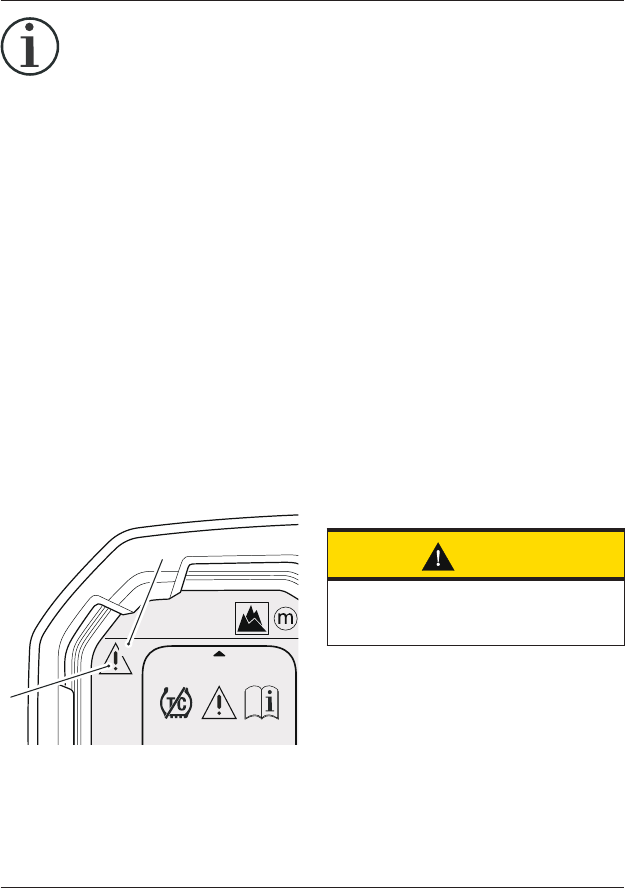
Instruments
66
Information Messages
The following information message may
be displayed:
• TPMS - BATTERY LOW FRONT/
REAR TIRE (see page 64)
When a warning or information
message is activated, the message will
be accompanied by the relevant
warning or information symbol on the
left hand side of the multifunction
display.
It is possible for multiple warning and
information messages to be displayed
when a fault occurs. Where this is the
case, warning messages will take
priority over information messages and
the warning symbol will be displayed on
the left hand side of the multifunction
display.
The number of currently active warning
and information messages is displayed
over the warning/information symbol.
OFF-ROAD
WARNING
TTC SYSTEM
3
1
2
1. Symbol (warning symbol shown)
2. Multiple messages indicated
Use the SCROLL button to scroll
through the messages being displayed.
Press the SELECT button to
acknowledge and hide each message.
Note:
• Some messages are automatically
hidden after a short period.
• Hidden warning and information
messages remain active and will be
redisplayed each time the ignition is
switched on, until the condition
that triggered the message has
been rectified.
• The warning or information symbol
will remain visible in the
multifunction display while active
messages are hidden, along with
the number of hidden messages.
• Hidden warning or information
messages can be viewed using the
Show Warnings function as
described in the Settings Menu on
page 74.
Tachometer
Caution
Never allow engine speed to enter the
red zone as severe engine damage may
result.
The tachometer shows the engine
speed in revolutions per minute - rpm
(r/min). At the end of the tachometer
range there is the red zone.
Engine speeds in the red zone are above
maximum recommended engine speed
and are also above the range for best
performance.
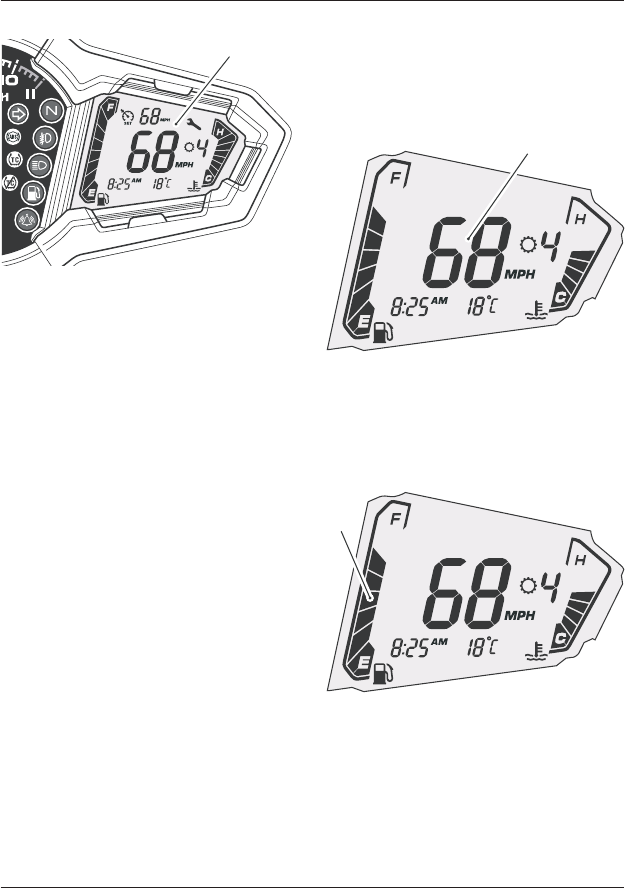
Instruments
67
Motorcycle Status Display Screen
1
1. Motorcycle status display screen
The motorcycle status display screen is
used to display the following:
• Speedometer
• Fuel gage
• Coolant temperature gage
• Gear position display
• Cruise control set speed
• Service indicator
• Clock
• Ambient air temperature and frost
symbol.
Speedometer
The digital speedometer indicates the
road speed of the motorcycle. The read-
out displays the motorcycle road speed
in increments of one mile (or kilometer)
per hour.
1
1. Speedometer
Fuel Gage
The fuel gage indicates the amount of
fuel in the tank.
1
1. Fuel gage
With the ignition switched on, the
number of bars shown in the display
indicates the level of fuel.
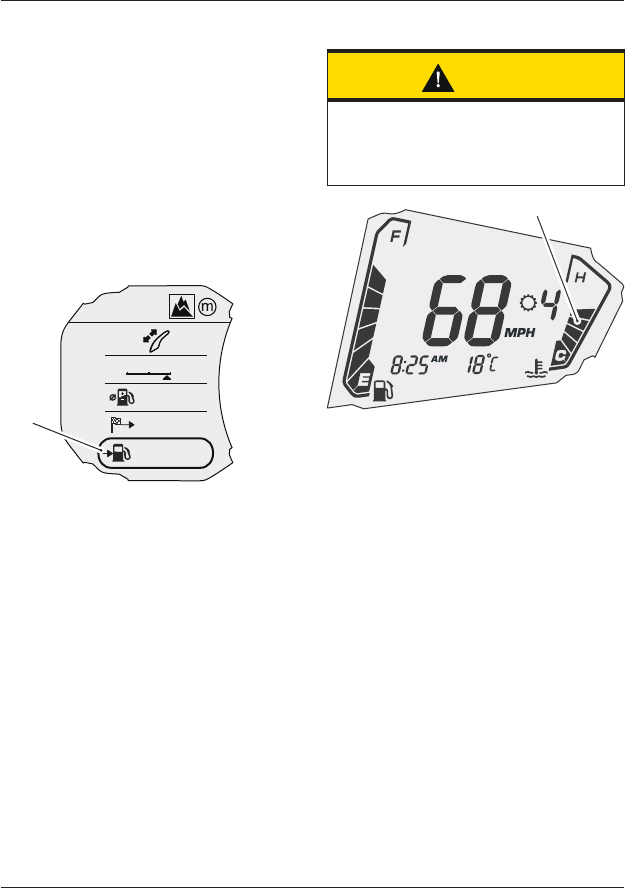
Instruments
68
When the fuel tank is full all eight bars
are displayed and when empty, no bars
are displayed. Other gage markings
indicate intermediate fuel levels
between full and empty.
The low fuel warning light will illuminate
when there is approximately 1.0 gallon
(3.5 liters) of fuel remaining in the fuel
tank (see page 64). At this point, two
bars will be visible in the fuel gage and
the information display in the
multifunction display screen will switch
to the Range to Empty display.
OFF-ROAD
AUTO
OFF-ROAD
MPG
MI
CNS
1
2
47
12
MI
120.1
1
1. Range to empty display
Refuel at the earliest opportunity when
the low fuel warning light is illuminated.
After refueling, the fuel gage and range
to empty information will be updated
only while riding the motorcycle.
Depending on the riding style, updating
could take up to five minutes.
Coolant Temperature Gage
Caution
Do not continue to run the engine if
either of the high temperature
warnings are displayed as severe
engine damage may result.
1
1. Coolant temperature gage
The coolant temperature gage indicates
the temperature of the engine coolant.
When the ignition is switched on, all
eight bars of the display will be shown.
When the engine is started from cold
the display will show no bars. As the
temperature increases more bars in the
display will be shown. When the engine
is started from hot the display will show
the relevant number of bars, dependent
on engine temperature.
The normal temperature range is
between four and six bars.
If the coolant temperature becomes too
high the display will show eight bars and
will start to flash. The high coolant
temperature light in the tachometer will
also flash.
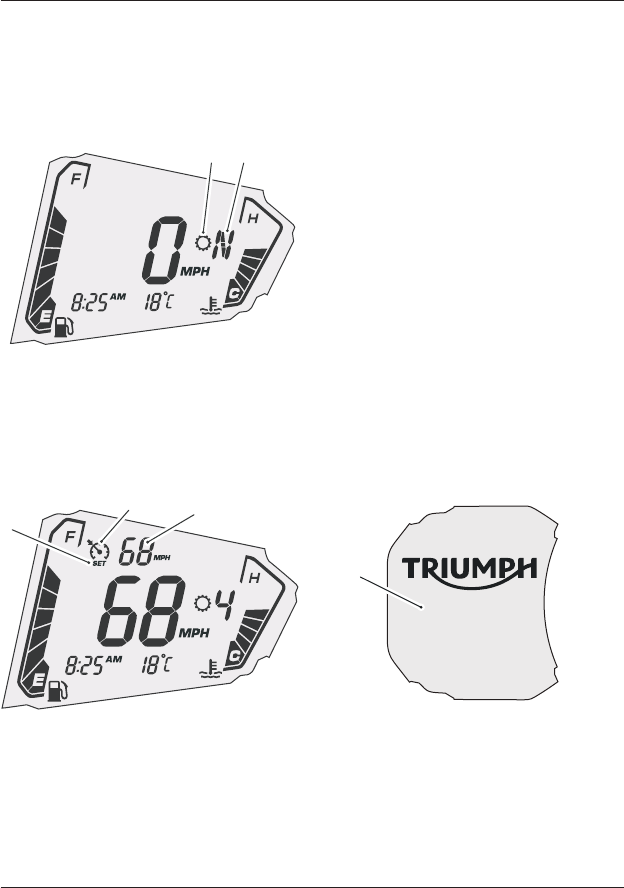
Instruments
69
Gear Position Display
The gear position display indicates
which gear (one to six) has been
engaged. When the transmission is in
neutral (no gear selected), the display
will show N.
1 2
1. Gear position symbol
2. Gear position display (neutral position
shown)
Cruise Control Set Speed
1
2
3
1. Cruise control symbol
2. Cruise control set indicator
3. Cruise control set speed
When cruise control is switched on, the
cruise control symbol will be visible in
the motorcycle status display screen.
The cruise control set speed will be
displayed as -- until a speed has been
set.
Upon setting a speed, the word SET will
be visible below the cruise control
symbol. The set speed will be displayed
and the cruise control light in the
tachometer will be illuminated.
When cruise control is deactivated, the
cruise control light in the tachometer
will go out but the set speed will remain
visible in the motorcycle status display
screen.
For more information, see Cruise Control
on page 104.
Service Indicator
When the ignition is switched on and
the distance to the next service is
500 miles (800 km) or less, the
multifunction display will briefly show
the distance remaining before the next
service in the startup screen.
SERVICE DUE
365 MI
ODOMETER
135 MI
1
1. Distance to next service
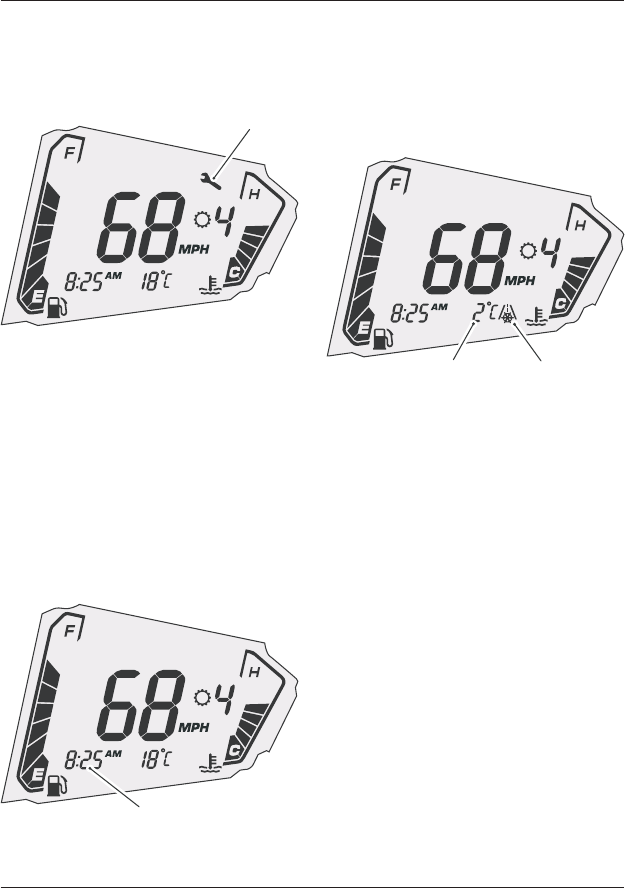
Instruments
70
If the service is overdue the distance
will be displayed as a negative number
and the service indicator will be
displayed in the motorcycle status
display screen.
1
1. Service indicator
When the service has been carried out
by your authorized Triumph dealer, the
system will be reset.
The service indicator will also be
displayed if a fault has occurred and the
ABS and/or MIL warning lights are
illuminated. Contact an authorized
Triumph dealer as soon as possible to
have the fault checked and rectified.
Clock
1
1. Clock - 12 hour format displayed
The clock can be displayed in 12 hour or
24 hour format.
To set the clock see Display Setup on
page 79.
Ambient Air Temperature
1
2
1. Ambient air temperature shown in °C
2. Frost symbol
The ambient air temperature is
displayed in °C or °F.
The frost symbol will illuminate if the
ambient air temperature is 39°F (4°C) or
lower (see page 65).
When the motorcycle is stationary the
heat of the engine may affect the
accuracy of the ambient temperature
display.
Once the motorcycle starts moving the
display will return to normal after a
short time.
To change the temperature from °C or
°F, see Display Setup on page 79.
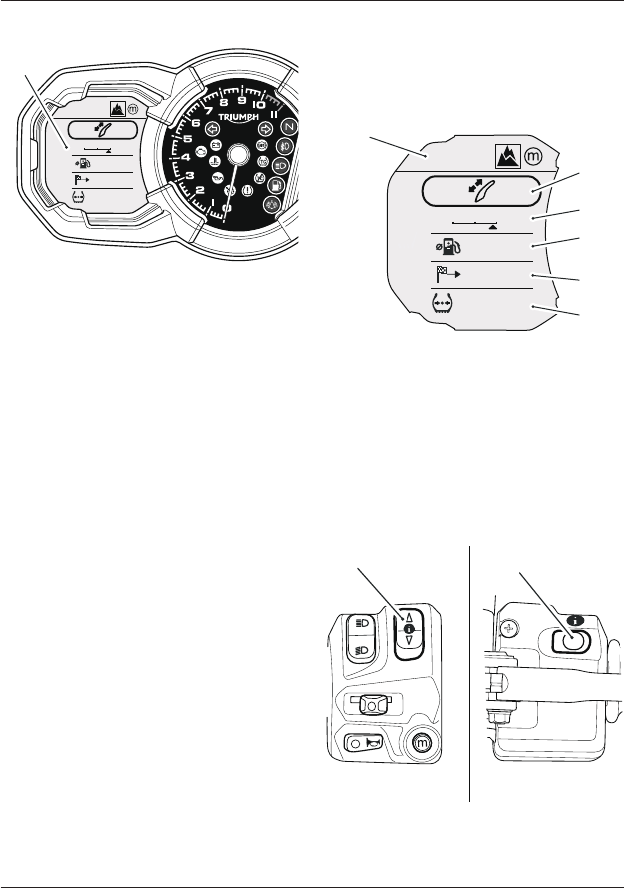
Instruments
71
Multifunction Display Screen
OFF-ROAD
AUTO
OFF-ROAD
MPG
MI
PSI
PSI
CNS
1
2
36
42
F
R
F
R
47
12
1
1. Multifunction display screen
The multifunction display screen allows
the rider to view, select or configure:
• Riding modes
• Windshield position
• Trip computers
• Motorcycle information
• Motorcycle settings
• Display settings.
The multifunction display screen is also
used to display warning and information
messages.
For more information on warning and
information messages, see page 65.
Home Screen
The multifunction display home screen
is used to show the current riding mode,
windshield adjustment mode, trip
meters and motorcycle information.
OFF-ROAD
AUTO
OFF-ROAD
MPG
MI
PSI
PSI
CNS
1
2
36
42
F
R
47
12
1
2
3
4
5
6
1. Current riding mode
2. Windshield adjustment mode
3. Trip 1 display
4. Trip 2 display (if activated)
5. Tire Pressure Monitoring System
(TPMS) information (if equipped)
The home screen will show one trip
meter as default but can be configured
to show two trip meters. For more
information on trip set up, see page 75.
7
8
12
1. SCROLL button
2. SELECT button
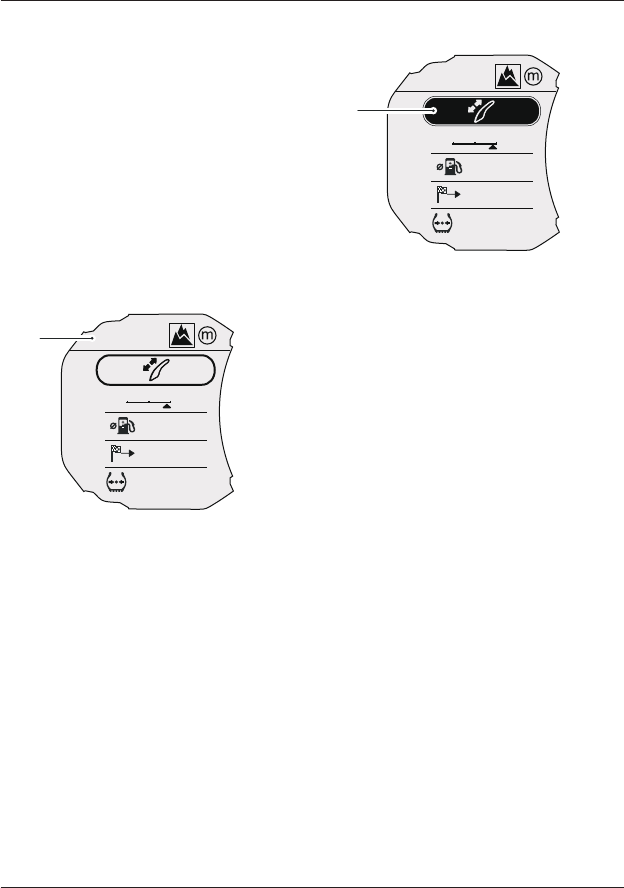
Instruments
72
To adjust or edit the home screen items:
• Press and release the SCROLL
button until the required item is
selected.
• Press and release the SELECT
button to access the selected
item’s sub menu or adjustment
screen.
• Press and hold the SELECT button
to access the Settings menu. For
more information, see page 74.
Riding Mode Display
OFF-ROAD
AUTO
OFF-ROAD
MPG
MI
PSI
PSI
CNS
1
2
36
42
F
R
47
12
1
1. Current riding mode display
Shows the current riding mode. For
more information on riding modes, see
page 81.
Windshield Adjustment Mode
OFF-ROAD
AUTO
OFF-ROAD
MPG
MI
PSI
PSI
CNS
1
2
36
42
F
R
47
12
1
1. Windshield adjustment mode
To access the windshield adjustment
mode:
• Press the SCROLL button until the
windshield adjust display is
selected.
• Press the SELECT button to
activate the windshield adjustment
mode.
• Use the SCROLL button to adjust
the windshield to the required
height.
• There is a short time-out period to
allow for further adjustment to
take place before the instruments
automatically exit the windshield
adjustment mode.
• Alternatively, press the SELECT
button to exit the windshield
adjustment mode.
For more information on windshield
adjustment, see page 118.
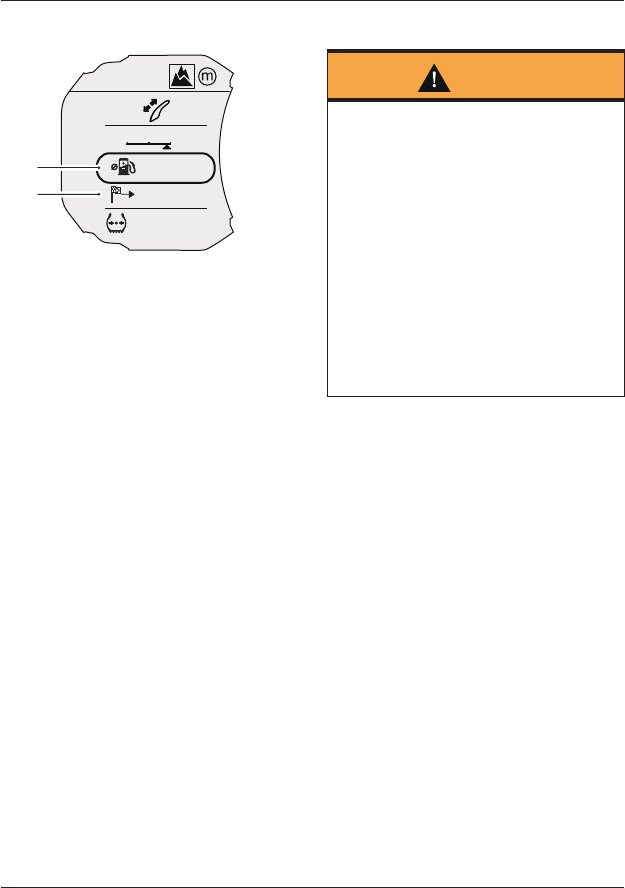
Instruments
73
Trip Meters
OFF-ROAD
AUTO
OFF-ROAD
MPG
MI
PSI
PSI
CNS
1
2
36
42
F
R
47
12
1
2
1. Trip meter 1 display
2. Trip meter 2 display (if activated)
The home screen will permanently
display trip meter one as default, but
can be configured to display two trip
meters. For information on trip set up,
see page 75.
Trip Distance
The total trip distance traveled since
the trip meter was last reset to zero.
Trip Meter Reset
To reset either of the trip meters, from
the home screen select the trip meter to
be zeroed, then press and hold the
SCROLL button in either direction for
two seconds. After two seconds, all
items within the selected trip meter will
reset to zero.
Trip 2 can also be set to automatically
reset after an adjustable time delay of
between one and eight hours. See Trip
Setup on page 75.
Motorcycle Information
Warning
When the motorcycle is in motion, only
attempt to switch between the
information and trip meter display
modes or reset the trip meter under
the following conditions:
• At low speed
• In traffic-free areas
• On straight and level roads or
surfaces
• In good road and weather conditions.
Failure to observe this important
warning could lead to loss of
motorcycle control and an accident.
The motorcycle information display
shows the currently selected motorcycle
information item.
Note:
• If TPMS is equipped, the tire
pressures display will be available
for selection.
• The motorcycle information display
will automatically switch to the
Range to Empty display when the
low fuel warning light is illuminated.
To access the motorcycle information
menu:
• Press the SCROLL button until the
motorcycle information display is
selected.
• Press the SELECT button to enter
the motorcycle information menu.
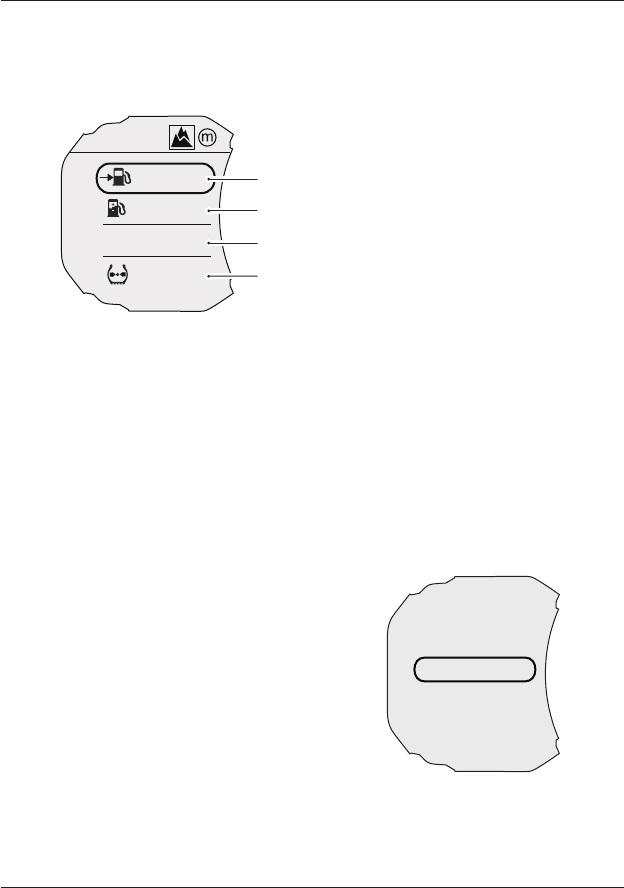
Instruments
74
Motorcycle Information Menu
Any one of the available information
items can be selected to be shown in
the home screen.
OFF-ROAD
MI
120.1
MPG
48
MI
1892
ODO
PSI
4 2R
PSI
3 6F
1
2
3
4
1. Range to empty
2. Instantaneous fuel consumption
3. Odometer
4. Front and rear tire pressures
(if equipped with TPMS)
To select an information item to be
shown in the home screen:
• Press the SCROLL button until the
required information item is
selected.
• Press the SELECT button to confirm
the selection and return to the
home screen.
Each display provides the following
information:
Range to Empty
This is an indication of the probable
distance that can be traveled on the
remaining fuel in the tank.
The distance shown will adapt based on
the level of fuel in the tank and changes
to the riding style.
Instantaneous Fuel Consumption
An indication of the fuel consumption at
an instant in time. If the motorcycle is
stationary, --.- will be shown in the
display area.
Odometer
Shows the total distance that the
motorcycle has traveled.
Front and Rear Tire Pressures
(if equipped with TPMS)
The front and rear tire pressures are
shown only if the Tire Pressure
Monitoring System (TPMS) is installed.
Dashes will be shown in the tire
pressure display until the motorcycle
reaches a speed of approximately
12 mph (20 km/h).
Settings Menu
To access the SETTINGS menu:
• Press and hold the SELECT button
on the left hand switch housing
until the SETTINGS menu is shown
in the multifunction display screen.
SETTINGS
EXIT
SHOW WARNINGS
RIDING MODES
TRIP SETUP
BIKE SETUP
DISPLAY SETUP
SETTINGS Menu
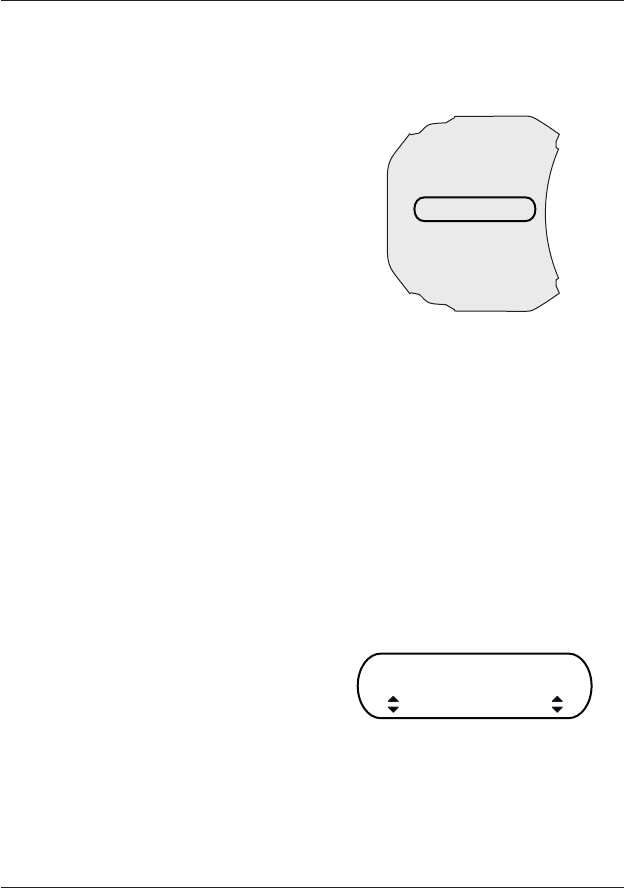
Instruments
75
The following menu items are available
for selection:
• EXIT
• SHOW WARNINGS (see page 75)
• RIDING MODES (see page 75)
• TRIP SETUP (see page 75)
• BIKE SETUP (see page 76)
• DISPLAY SETUP (see page 79).
A description of each menu item is
described in the following pages.
Exit
Select EXIT to return to the home
screen.
Show Warnings
Select SHOW WARNINGS to exit the
SETTINGS menu and display all active
warning or information messages in the
multifunction display screen.
For more information on warning and
information messages, see page 65.
Riding Modes
From the SETTINGS menu, select RIDING
MODES to configure the ABS, MAP and
TC settings for each available riding
mode.
For more information on riding mode
configuration, see page 85.
Trip Setup
From the SETTINGS menu, select TRIP
SET UP to configure and reset the trip
meters.
TRIP SETUP
EXIT
TRIP 1 RESET
TRIP 2 RESET
TRIP 2 DISPLAY
AUTO RESET
TRIP SETUP Screen
The following menu items are available
for selection:
• EXIT
• TRIP 1 RESET
• TRIP 2 RESET
• TRIP 2 DISPLAY
• AUTO RESET.
Exit
Select EXIT to return to the SETTINGS
menu.
Trip 1 and Trip 2 Reset
TRIP 1 RESET
CONFIRM
TRIP 1 RESET (CONFIRM Shown)
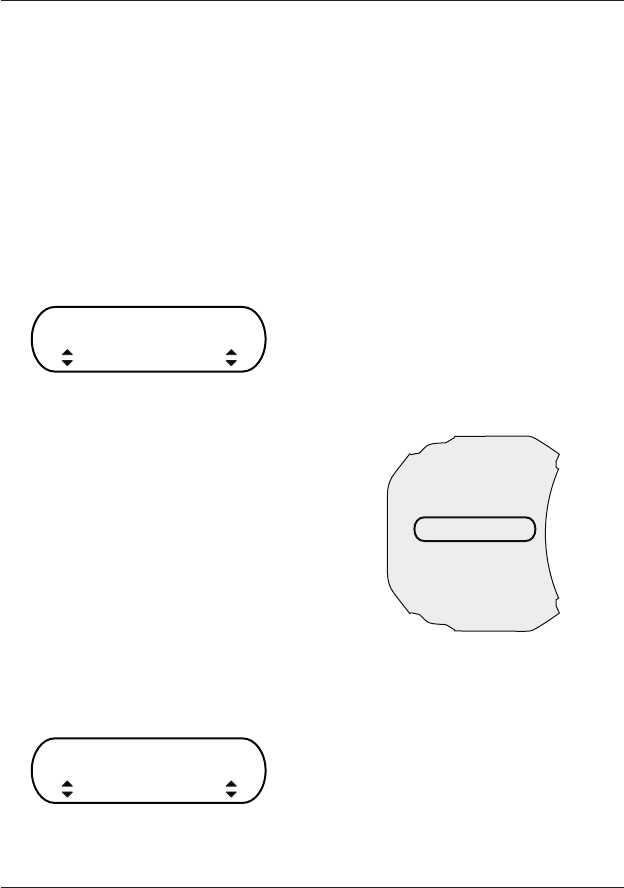
Instruments
76
To reset TRIP 1 or TRIP 2:
• Press the SCROLL button to select
the required trip meter to reset,
either TRIP 1 RESET or TRIP 2
RESET.
• Press the SCROLL button to select
CONFIRM, then press the SELECT
button.
• All items within the selected trip
meter will be immediately reset to
zero and the display will return to
the TRIP SETUP menu.
Trip 2 Display
TRIP 2 DISPLAY
ENABLE
TRIP 2 DISPLAY (ENABLE Shown)
To enable or disable the TRIP 2 DISPLAY:
• Press the SCROLL button to select
TRIP 2 DISPLAY, then press the
SELECT button.
• Press the SCROLL button to select
ENABLE or DISABLE.
• Press the SELECT button to confirm
the selection and return to the
TRIP SETUP menu.
Auto Reset
The AUTO RESET function applies to
TRIP 2 only. TRIP 1 must be reset
manually using TRIP 1 RESET as
previously described.
AUTO RESET
4 HRS
AUTO RESET (4 HRS Shown)
To auto reset the trip meters:
• Press the SCROLL button to select
AUTO RESET, then press the
SELECT button.
• Press the SCROLL button to select
OFF, 1 HR, 2 HRS, 4 HRS or 8 HRS.
• Press the SELECT button to confirm
the selection and return to the
TRIP SETUP menu.
• After the ignition has been
switched OFF and the set time has
elapsed, all items within TRIP 2 will
be reset to zero.
Bike Setup
From the SETTINGS menu, select BIKE
SET UP to configure the Anti-Lock
Braking System (ABS) and Traction
Control (TC) settings.
BIKE SETUP
EXIT
ABS
TC
BIKE SETUP Menu
The following menu items are available
for selection:
• EXIT
• ABS
• TC.
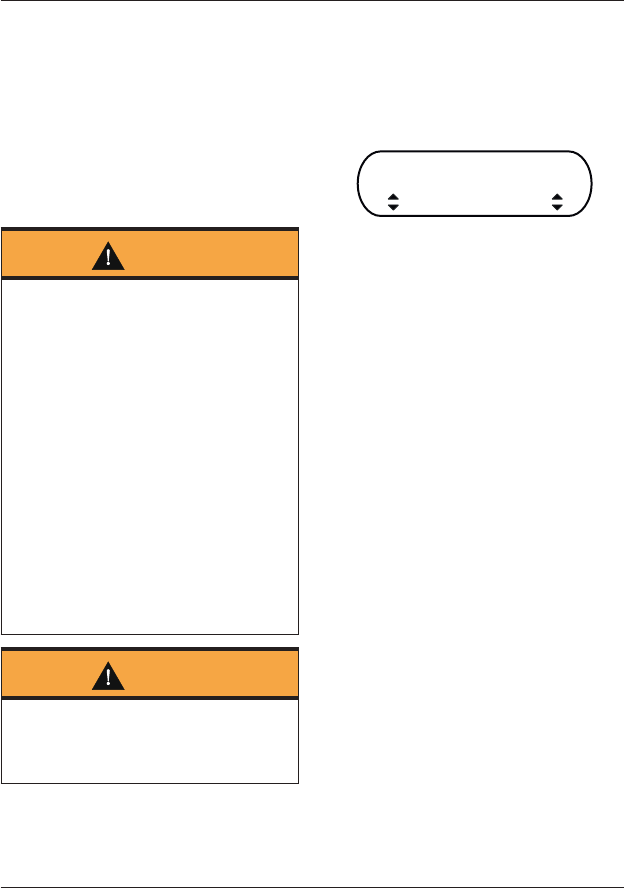
Instruments
77
Exit
Select EXIT to return to the SETTINGS
menu.
Anti-Lock Braking System (ABS)
It is possible to temporarily disable the
ABS system. The ABS system cannot be
permanently disabled, it will be
automatically enabled when the ignition
is turned OFF and then ON again.
Warning
Selecting ABS DISABLE will disable the
anti-lock braking system.
The ABS settings stored for each riding
mode will be overridden, regardless of
whether they are set to Road, Off-
Road or OFF.
The ABS and the riding mode ABS
settings will not be enabled again until
ENABLE is selected from the ABS menu
or the ignition is turned OFF then ON
again.
If the ABS is disabled, the brake system
will function as a non-ABS braking
system. In this situation braking too
hard will cause the wheels to lock, and
may result in loss of motorcycle control
and an accident.
Warning
Do not attempt to adjust the ABS
settings while the motorcycle is in
motion as this may lead to loss of
motorcycle control and an accident.
To enable or disable the ABS system:
• Press the SCROLL button to select
ABS, then press the SELECT button
to confirm.
• Press the SCROLL button to select
ENABLE or DISABLE.
ABS
ENABLE
ABS (ENABLE Shown)
• Press the SELECT button to confirm
the selection and return to the
BIKE SETUP menu.
• If DISABLE is selected, the ABS
warning light will be illuminated and
the message WARNING - ABS
SYSTEM DISABLED will be briefly
shown in the multifunction display
screen.
• The ABS and all riding mode ABS
settings will be disabled until the
ABS is re-enabled. All ABS settings
are automatically enabled when the
ignition is turned OFF and then ON
again.
Note:
• If the ABS is disabled by the rider,
traction control and cruise control
(if equipped) will still function.
Traction Control (TC)
It is possible to temporarily disable the
Traction Control (TC) system. The TC
system cannot be permanently disabled,
it will be automatically enabled when the
ignition is turned OFF and then ON
again.
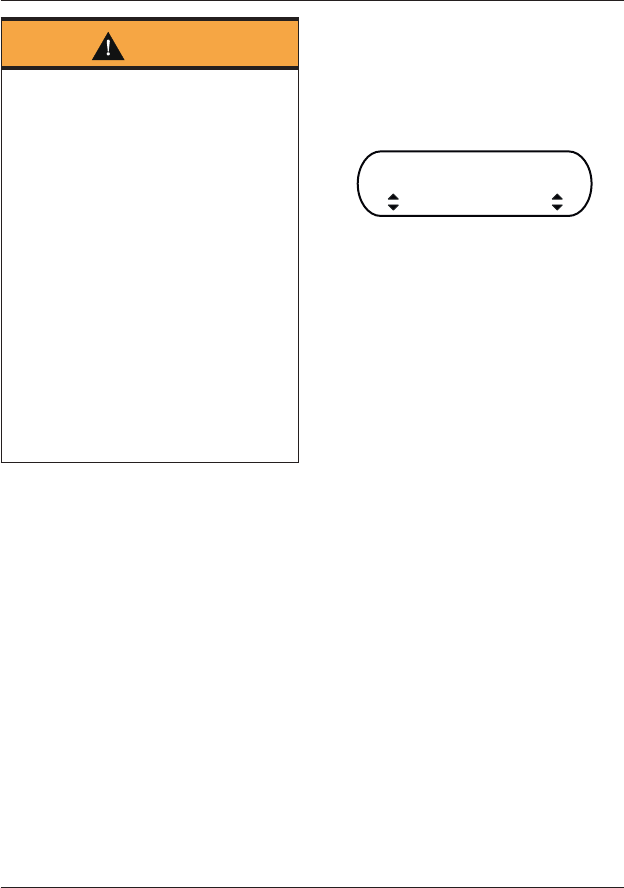
Instruments
78
Warning
Selecting TC DISABLE will disable the
traction control system.
All traction control settings stored for
each riding mode will be overridden
regardless of whether they are set to
Rain, Road, Sport, Off-Road or Off.
Traction control and the riding mode
TC settings will not be enabled again
until ENABLE is selected from the TC
menu, or the ignition is turned OFF
then ON again.
If traction control is disabled, the
motorcycle will handle as normal but
without traction control. In this
situation accelerating too hard on wet/
slippery road surfaces may cause the
rear wheel to slip, and may result in
loss of motorcycle control and an
accident.
To enable or disable the traction control:
• Press the SCROLL button to select
TC, then press the SELECT button
to confirm.
• Press the SCROLL button to select
ENABLE or DISABLE.
TC
ENABLE
TC (ENABLE Shown)
• Press the SELECT button to confirm
the selection and return to the
BIKE SETUP menu.
• If DISABLE is selected, the TC
disabled warning light will be
illuminated and the message
WARNING - TC SYSTEM DISABLED
will be briefly shown in the
multifunction display screen.
• Traction control and all riding mode
traction control settings will be
disabled until the traction control is
re-enabled. All traction control
settings are automatically enabled
when the ignition is turned OFF and
ON again.
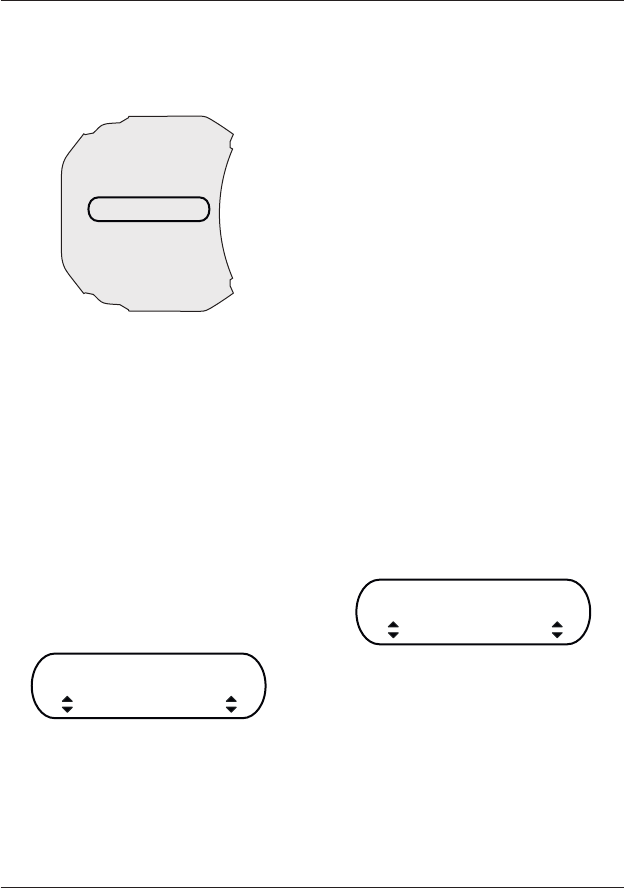
Instruments
79
Display Setup
From the SETTINGS menu, select
DISPLAY SETUP to configure the display
settings.
DISPLAY SETUP
EXIT
LANGUAGE
SET UNITS
SET CLOCK
BRIGHTNESS
DISPLAY SETUP Menu
The following menu items are available
for selection:
• EXIT
• LANGUAGE
• SET UNITS
• SET CLOCK
• BRIGHTNESS.
Exit
Select EXIT to return to the SETTINGS
menu.
Language
LANGUAGE
ENGLISH
LANGUAGE Menu (ENGLISH Shown)
The following languages are available:
• English
• French
• German
• Italian
• Dutch
• Spanish
• Swedish
• Brazilian.
To select a language:
• Press the SCROLL button to select
LANGUAGE, then press the SELECT
button to confirm.
• Press the SCROLL button to select
the required language, then press
the SELECT button to confirm and
return to the DISPLAY SETUP
menu.
Note:
• All menu items displayed will
change to the newly selected
language when the SELECT button
is pressed.
Set Units
DISTANCE
MILES
DISTANCE Menu (MILES shown)
To set the display units:
• Press the SCROLL button to select
SET UNITS, then press SELECT to
confirm.
• The DISTANCE menu is then shown.
Press the SCROLL button to select
MILES or KM and then press the
SELECT button to confirm.
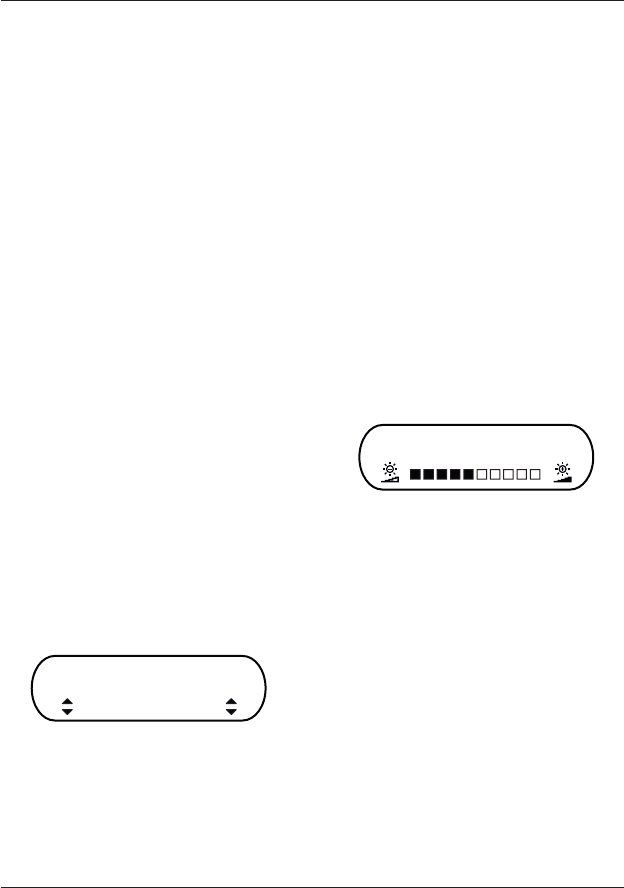
Instruments
80
Note:
• If DISTANCE has been set to MILES,
the menu options available will be
MPG (UK) or MPG (US).
• If DISTANCE has been set to KM, the
menu options available will be KM/L
or L/100 KM.
• Use the SCROLL button to select
the required unit and press the
SELECT button to confirm.
Note:
• If DISTANCE has been set to MILES,
then TEMP (temperature) is shown.
Press the SCROLL button to select
either °F or °C and then press the
SELECT button to confirm.
• If DISTANCE has been set to KM,
then the temperature display will
be automatically set to °C.
• If equipped with TPMS, then the
PRESSURE menu is shown.
• Press the SCROLL button to select
either PSI, BAR or kPa.
• Press the SELECT button to confirm
the settings and return to the
DISPLAY SETUP menu.
Set Clock
SET CLOCK
24 HR
SET CLOCK (24 HR Shown)
To set the clock:
• Press the SCROLL button to select
SET CLOCK, then press the SELECT
button to confirm.
• Press the SCROLL button to select
the required clock display either
12 HR or 24 HR format and press
the SELECT button to confirm.
• The SET HOUR menu is now shown.
Press the SCROLL button to select
the required hour display and press
the SELECT button.
• The SET MINUTE menu is now
shown. Press the SCROLL button to
select the required minute display
and press the SELECT button to
confirm and return to the DISPLAY
SETUP menu.
Brightness
BRIGHTNESS
BRIGHTNESS Menu
To adjust the brightness of the screen:
• Press the SCROLL button to select
BRIGHTNESS, then press the
SELECT button to confirm.
• Press the SCROLL button to adjust
the instrument brightness using
the adjustment slider between
levels 1 (lowest) to 10 (highest).
• Press the SELECT button to save
the selection and return to the
DISPLAY SETUP menu.
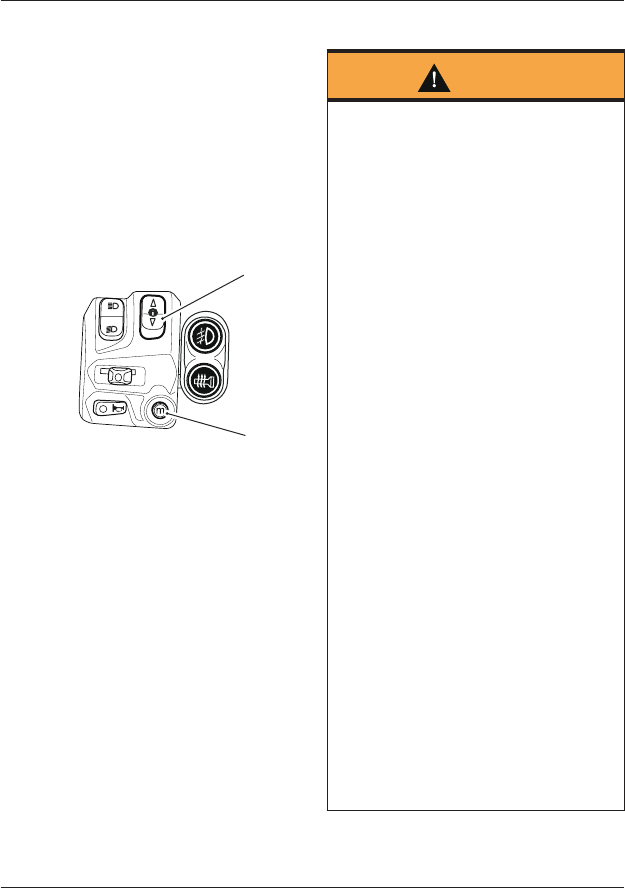
Instruments
81
Riding Modes
The riding mode system allows
adjustment of the Anti-lock Brake
System (ABS), throttle response (MAP)
and Traction Control (TC) settings to suit
different road conditions and rider
preferences.
Riding modes can be selected using the
MODE and SCROLL buttons on the left
hand switch housing, while the
motorcycle is stationary or moving.
2
1
1. MODE button
2. SCROLL button
The following riding modes are available:
• RAIN
• ROAD
• OFF-ROAD
Each riding mode is fully adjustable but
availability of the ABS, MAP and TC
settings options may vary between
modes. For more information on riding
mode configuration, see page 85.
Riding Mode Selection
Warning
The selection of riding modes while the
motorcycle is in motion requires the
rider to allow the motorcycle to coast
(motorcycle moving, engine running,
throttle closed, clutch lever pulled in
and no brakes applied) for a brief
period of time.
Riding mode selection while the
motorcycle is in motion should only be
attempted:
• At low speed
• In traffic-free areas
• On straight and level roads or
surfaces
• In good road and weather conditions.
• Where it is safe to allow the
motorcycle to briefly coast.
Riding mode selection while the
motorcycle is in motion MUST NOT be
attempted:
• At high speeds
• While riding in traffic
• During cornering or on winding roads
or surfaces
• On steeply inclined roads or surfaces
• In poor road/weather conditions
• Where it is unsafe to allow the
motorcycle to coast.
Failure to observe this important
warning may lead to loss of motorcycle
control and an accident.
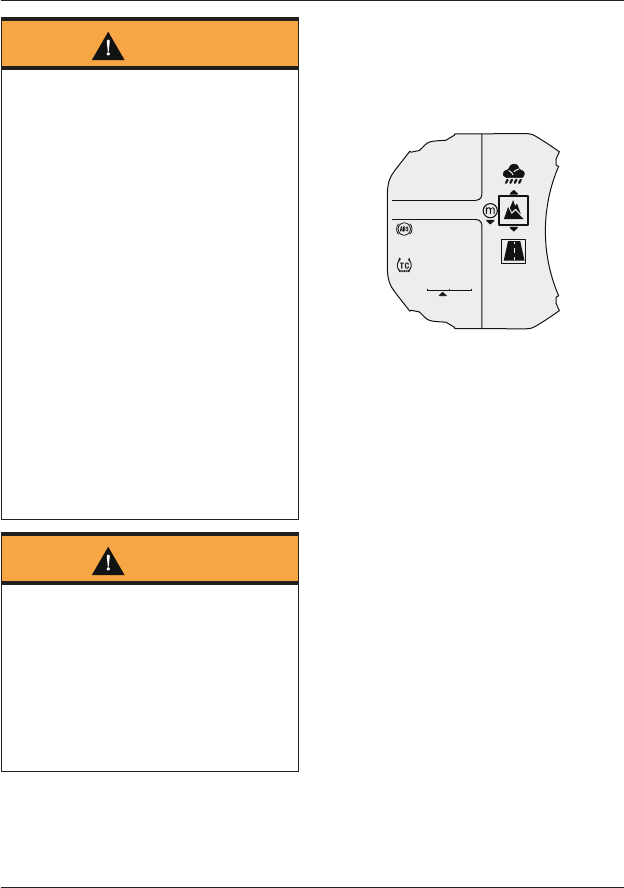
Instruments
82
Warning
If ABS and/or TC has been disabled
using the BIKE SETUP menu, the ABS
and/or TC settings saved for all riding
modes will be overridden.
ABS and/or TC will remain OFF
regardless of the riding mode selection,
until they have been re-enabled or, the
ignition has been switch OFF then ON
again.
If the ABS is disabled, the brake system
will function as a non-ABS braking
system. In this situation braking too
hard will cause the wheels to lock, and
may result in loss of motorcycle control
and an accident.
If the traction control is disabled, the
motorcycle will handle as normal but
without traction control. In this
situation accelerating too hard on wet/
slippery road surfaces may cause the
rear wheel to slip, and may result in loss
of motorcycle control and an accident.
Warning
After selecting a riding mode, operate
the motorcycle in an area free from
traffic to gain familiarity with the new
settings.
Do not loan your motorcycle to anyone
as they may change the riding mode
settings from those you are familiar
with, causing loss of motorcycle control
and an accident.
To select a riding mode:
Press and release the MODE button on
the left hand switch housing to activate
the riding mode selection menu in the
multifunction display.
OFF-ROAD
OFF-ROAD
OFF-ROAD
OFF-ROAD
OFF-ROAD
CNS
MAP
Riding Mode Selection Menu
Further presses of the MODE button will
scroll through the riding modes in the
following order:
• RAIN
• ROAD
• OFF-ROAD.
Alternatively, the SCROLL button can be
used to scroll up or down through the
riding modes.
Note:
• To allow the user to scroll between
each of the modes, there is a short
time-out to allow for further
scrolling to take place before the
highlighted riding mode is
automatically activated.
Scroll through the riding modes until the
desired mode is highlighted in the
selection window.
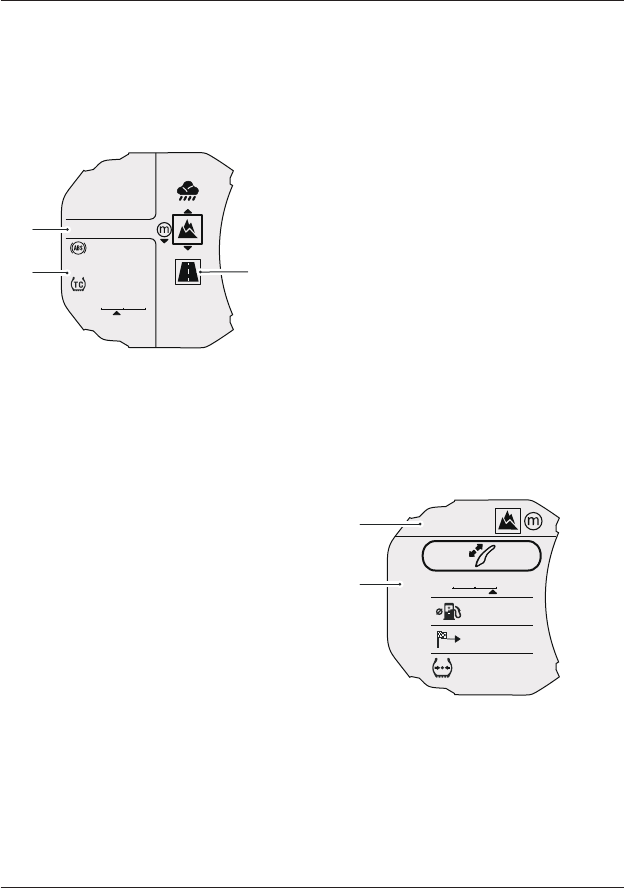
Instruments
83
The name of the highlighted riding mode
and its currently stored ABS, MAP and
TC settings, are displayed on the left
hand side of the multifunction display.
The currently active riding mode is
indicated with a border.
OFF-ROAD
OFF-ROAD
OFF-ROAD
OFF-ROAD
OFF-ROAD
CNS
MAP
1
23
1. Selected riding mode
2. Selected riding mode’s ABS, MAP and
TC settings
3. Currently active riding mode
The riding mode shown in the selection
window is automatically activated once
the time-out has elapsed, and the
following conditions for switching modes
have been met.
Motorcycle Stationary - Engine Off
• The ignition is switched ON.
• The engine stop switch is in the
RUN position.
Motorcycle Stationary - Engine On
• Neutral gear is selected or the
clutch is pulled in.
Motorcycle in Motion
Within 30 seconds of selecting a riding
mode the rider must carry out the
following simultaneously:
• Close the throttle
• Pull the clutch in
• Make sure that the brakes are not
engaged (allow the motorcycle to
coast).
Note:
• It is not possible to select OFF-
ROAD mode while the motorcycle is
in motion, if the ABS or TC settings
are set to OFF-ROAD or OFF.
• In this case, the motorcycle must
be brought to a stop before the
riding mode change can take place.
Once the ABS, MAP and TC settings
have changed, the multifunction display
will return to the home screen and the
selected riding mode will be shown.
OFF-ROAD
AUTO
OFF-ROAD
MPG
MI
PSI
PSI
CNS
1
2
36
42
F
R
47
12
2
1
1. Selected riding mode
2. Home screen
The riding mode change is now
complete and normal riding can be
resumed.
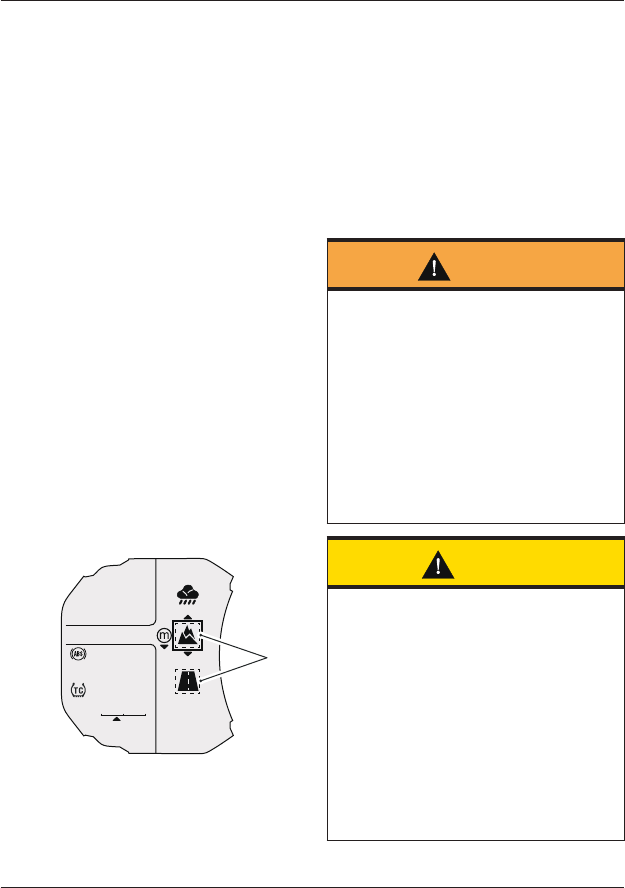
Instruments
84
Note:
• The riding mode will default to
ROAD when the ignition is switched
ON if the OFF-ROAD mode was
active the last time the ignition was
switched OFF, with ABS and/or TC
set to OFF-ROAD or OFF.
• Otherwise, the last selected riding
mode will be remembered and
activated when the ignition is
switched ON.
• If the mode icons are not visible
when the ignition switch is in the
ON position, make sure that the
engine stop switch is in the RUN
position.
Incomplete Riding Mode Changes
In the event of an incomplete riding
mode change, both the previous and
newly selected riding modes will be
highlighted with a dashed border. This
indicates that the ABS, MAP or TC
settings specified by the newly
requested riding mode have not been
correctly activated.
OFF-ROAD
OFF-ROAD
OFF-ROAD
OFF-ROAD
OFF-ROAD
CNS
MAP
1
1. Incomplete riding mode change
In this case the MIL, ABS or TC warning
light(s) may be illuminated depending on
the current state of each system.
In the event of an incomplete riding
mode change:
• Safely bring the motorcycle to a
stop.
• Select neutral gear.
• Turn the ignition OFF and then back
ON again.
• Select the required riding mode.
• Restart the engine and continue
riding.
Warning
Do not stop the engine using the
ignition switch or engine stop switch
while the motorcycle is moving.
Always bring the motorcycle to a stop
safely and engage neutral gear prior to
stopping the engine.
Stopping the engine by turning off the
ignition or engine stop switch while the
motorcycle is moving can lock the rear
wheel causing loss of motorcycle
control and an accident.
Caution
Do not stop the engine using the
ignition switch or engine stop switch
while the motorcycle is moving.
Always bring the motorcycle to a stop
safely and engage neutral gear prior to
stopping the engine.
The transmission is pressure lubricated
only when the engine is running.
Inadequate lubrication may cause
damage or seizure of the transmission,
which can lead to sudden loss of
motorcycle control and an accident.

Instruments
85
Riding Mode Configuration
Refer to the following table for the ABS,
MAP and TC options available for each
riding mode.
Riding Mode
RAIN ROAD OFF-ROAD
ABS (Anti-lock Braking System)
Road
Off-Road
Off
MAP (Throttle Response)
Rain
Road
Off-Road
TC (Traction Control)
Rain
Road
Off-Road
Off
Key
Standard (Factory Default Setting)
Selectable Option
Option Not Available
ABS Option Descriptions
Warning
The OFF-ROAD ABS option is NOT
intended for use with normal, on-road
riding.
Use of the rear brake pedal in this
situation can cause the rear wheel to
lock under heavy braking.
Riding on-road with the ABS set to
OFF-ROAD can lead to instability when
braking which may result in loss of
motorcycle control and an accident.
Warning
If the ABS is disabled, the brake system
will function as a non-ABS braking
system. In this situation braking too
hard will cause the wheels to lock, and
may result in loss of motorcycle control
and an accident.
• Road - Optimal ABS setting for road
use.
• Off-Road - Optimal ABS setting for
off-road use as follows:
• Front Brake Lever Operation - If the
front brake lever is operated only,
the partially integrated braking
system will also apply a small
amount of rear brake as described
in Braking on page 146. In this
situation, the level of ABS
intervention is optimized for off-
road riding for both front and rear
wheels.
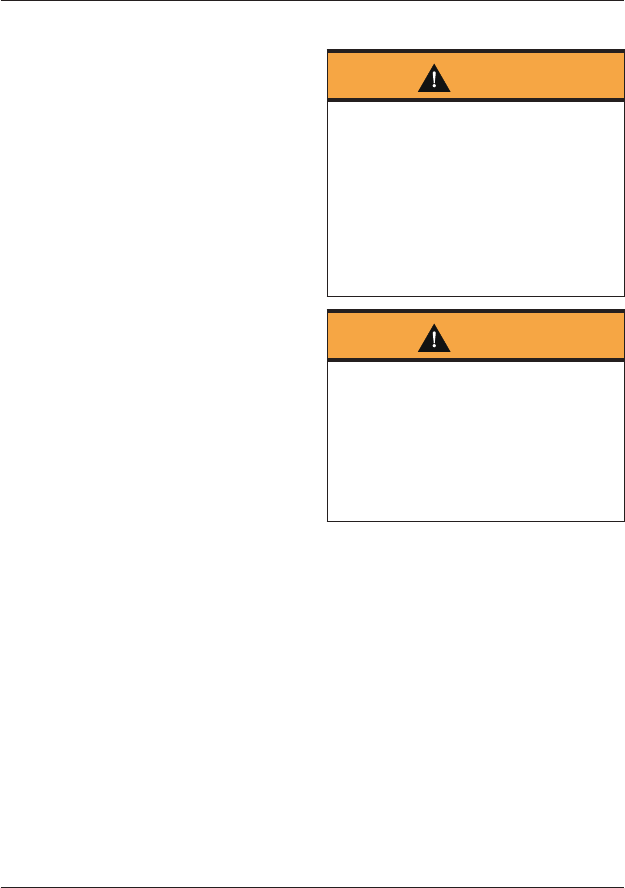
Instruments
86
• Rear Brake Pedal Operation - If the
rear brake pedal is operated at any
point, all rear braking input will be
controlled directly by the rear
brake pedal. Operating the rear
brake pedal will override any rear
braking input applied by the
partially integrated braking system,
through use of the front brake
lever. In this situation, the level of
ABS intervention is optimized for
off-road riding for the front wheel,
but the rear wheel will be allowed
to lock under heavy braking. Use of
the rear brake pedal alone will only
apply the rear brake and the rear
wheel will be allowed to lock under
heavy braking. The ABS warning
light will flash slowly.
• Off - ABS is turned off. The ABS
warning light will be illuminated.
MAP Option Descriptions
• Rain - Reduced throttle response
when compared to the Road
setting, for wet or slippery
conditions.
• Road - Standard throttle response.
• Off-Road - Optimal throttle
response setting for off-road use.
TC Option Descriptions
Warning
The OFF-ROAD TC option is not
intended for normal, on-road riding.
Riding on-road with TC set to OFF-
ROAD can produce instability under
acceleration due to the increased
amount of rear wheel slip allowed.
Instability caused by rear wheel slip
may lead to loss of motorcycle control
and an accident.
Warning
If the traction control is disabled, the
motorcycle will handle as normal but
without traction control. In this
situation accelerating too hard on wet/
slippery road surfaces may cause the
rear wheel to slip, and may result in
loss of motorcycle control and an
accident.
• Rain - Optimal TC setting for wet or
slippery conditions. Allows reduced
rear wheel slip when compared with
the Road setting.
• Road - Optimal TC setting for road
use, allows a small amount of rear
wheel slip.
• Off-Road - TC is set up for off-road
use, allowing increased rear wheel
slip when compared to the Rain,
Road and Sport settings. The TC
indicator light will flash slowly.
• Off - TC is turned OFF. The TC
disabled warning light will be
illuminated.
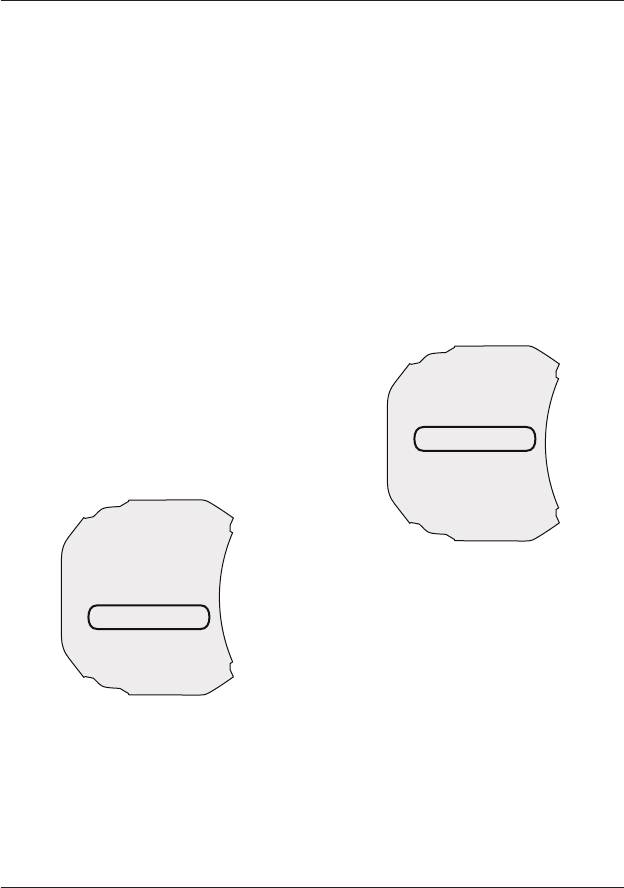
Instruments
87
Note:
• During riding mode configuration,
ABS and TC can be activated or
deactivated in the Off-Road and
Rider modes.
• If the riding mode being configured
is currently selected, adjustments
to the ABS, MAP and TC systems
will become immediately active.
• If the riding mode being configured
is not currently selected,
adjustments to the ABS, MAP and
TC systems are saved and will
become active the next time the
riding mode is selected.
To configure a riding mode:
With the motorcycle stationary, press
and hold the SELECT button to activate
the SETTINGS menu.
Use the SCROLL button to select RIDING
MODES then press the SELECT button
to confirm the selection.
RIDING MODES
EXIT
RAIN
ROAD
OFF-ROAD
RIDING MODES Menu
Use the SCROLL button to select the
riding mode to be configured, then
press the SELECT button to enter the
selected riding mode’s configuration
menu.
Alternatively, press and hold the MODE
button to provide direct access to a
riding mode’s configuration menu as
follows:
From the Home Screen
Press and hold the MODE button while
in the Home screen to activate the
configuration menu for the currently
active riding mode.
From the RIDING MODES Menu
Press and hold the MODE button while
in the RIDING MODES menu to activate
the configuration menu for the required
riding mode.
OFF-ROAD
EXIT
ABS
MAP
TC
RESET
OFF-ROAD Configuration Menu
(MAP Selected)
From a riding mode’s configuration
menu, press the SCROLL button until
the required option is selected. Press
the SELECT button to confirm and view
the option’s menu.
Exit
Select EXIT to return to the RIDING
MODES menu.
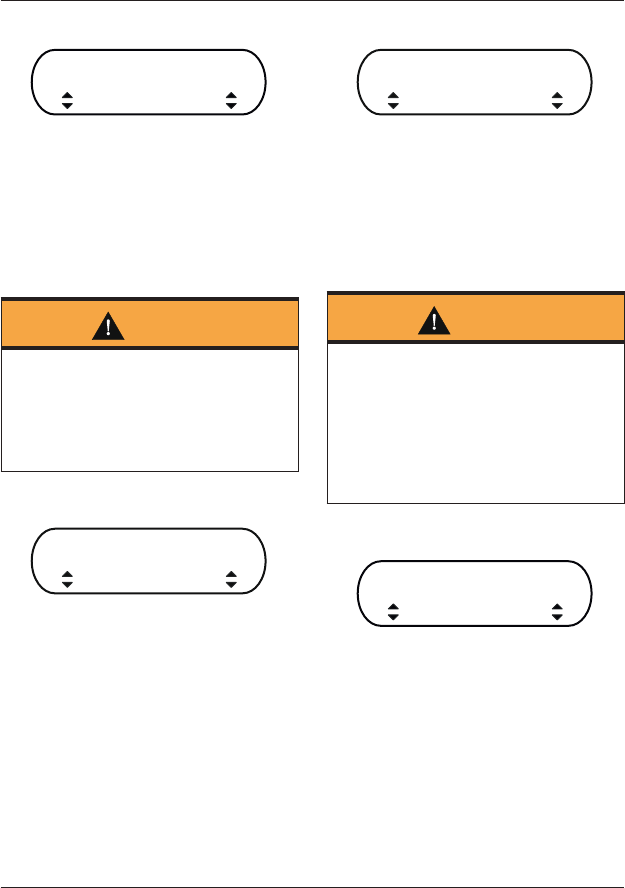
Instruments
88
ABS
ABS
ROAD
ABS Menu (ROAD Selected)
To change the ABS setting:
• From the ABS menu, press the
SCROLL button to select the
required option. Press the SELECT
button to confirm the selection and
return to the configuration menu.
Warning
If the ABS is disabled, the brake system
will function as a non-ABS braking
system. In this situation braking too
hard will cause the wheels to lock, and
may result in loss of motorcycle control
and an accident.
MAP
MAP
ROAD
MAP Menu (ROAD Selected)
To change the MAP setting:
• From the MAP menu, press the
SCROLL button to select the
required option. Press the SELECT
button to confirm the selection and
return to the configuration menu.
TC
TC
ROAD
TC Menu (ROAD Selected)
To change the TC setting:
• From the TC menu, press the
SCROLL button to select the
required option. Press the SELECT
button to confirm the selection and
return to the configuration menu.
Warning
If the traction control is disabled, the
motorcycle will handle as normal but
without traction control. In this
situation accelerating too hard on wet/
slippery road surfaces may cause the
rear wheel to slip, and may result in
loss of motorcycle control and an
accident.
Reset
RESET
CONFIRM
RESET Menu (CONFIRM Selected)
To reset the riding modes:
• From the RESET menu, press the
SCROLL button to select CONFIRM
to return the selected riding mode’s
configuration to the factory default
settings.
• Refer to the table on page 85 for
details of the factory default
settings for each riding mode.

General Information
89
GENERAL INFORMATION
Table of Contents
Hand Controls 91
Keyless Ignition (if equipped) 91
Master Ignition Switch (if equipped) 92
Ignition Key 92
Ignition Switch/Steering Lock 93
Right Handlebar Switches 94
Right Handlebar Switches 96
Left Handlebar Switches 97
Left Handlebar Switches 100
Throttle Control 102
Brake and Clutch Lever Adjusters 103
Cruise Control 104
Activating Cruise Control 105
Adjusting the Set Speed While in Cruise Control 106
Deactivating Cruise Control 106
Resuming the Cruise Control Set Speed 107
Triumph Semi Active Suspension (TSAS) (if equipped) 108
Traction Control (TC) 109
Optimized Cornering Traction Control (if equipped) 110
Traction Control Settings 111
Tire Pressure Monitoring System (TPMS) (if equipped) 111
Tire Pressure Sensor Serial Number 112
System Display 112
Sensor Batteries 113
TPMS System Fault 113
Tire Pressures 114
Low Tire Pressure 114
Fuel 115
Fuel 115
Fuel Tank Cap 116
Filling the Fuel Tank 117
Windshield 118
Handlebar Adjustment 119
Stands 121
Side Stand 121
Center Stand (if equipped) 121

General Information
90
Seats 122
Seat Care 122
Passenger Seat 122
Rider's Seat 123
Rider’s Seat Height Adjustment 124
Heated Seats (if equipped) 124
Helmet Hook 126
Tool Kit, Handbook and the Triumph Accessory D-Lock 126
Electrical Accessory Sockets 127
Universal Serial Bus (USB) Socket 128
Expedition Aluminum Panniers (if equipped) 129
Breaking-In 136
Daily Safety Checks 137
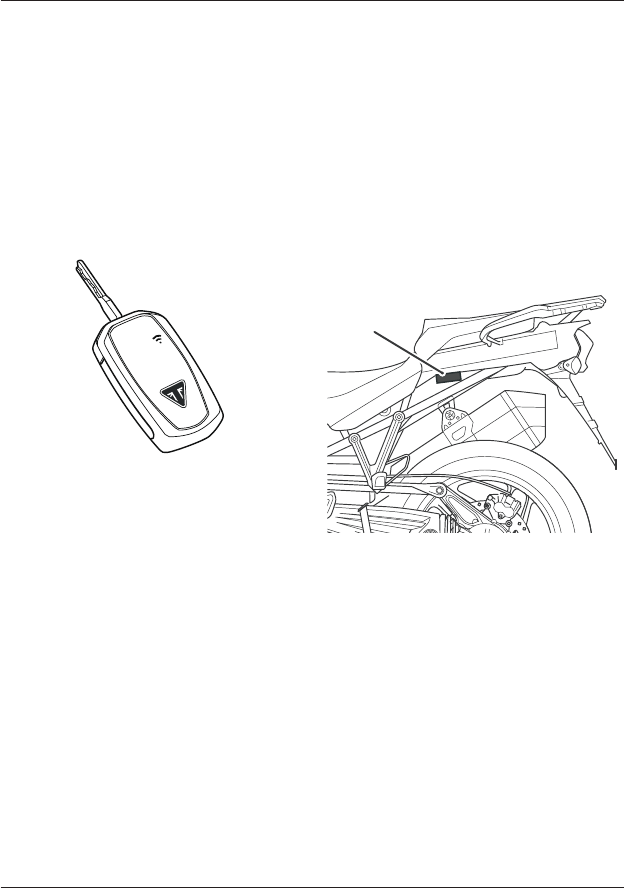
General Information
91
Hand Controls
Keyless Ignition (if equipped)
The keyless ignition system allows the
motorcycle to be started without the
use of a mechanical key.
There are three keys supplied with the
motorcycle. One smart key and two
standard keys.
Smart Key
Note:
• An additional smart key can be
purchased from your Triumph dealer.
However, only three keys can be
programmed to the motorcycle. This
can be a combination of smart keys
and standard keys.
Smart Key Operation
Press the button on the smart key to
turn the key on. The button light shows
green briefly to indicate that the smart
key is on.
A short press on the smart key button
shows the status of the smart key; red
is OFF and green is ON. A long press of
the button will change the status to OFF
or ON after briefly showing the original
status color first.
The smart key must be within close
proximity (three feet/one meter) of the
system sensor, which is located on the
left hand side of the motorcycle under
the passenger seat. If the smart key is
out of range of the sensor then it will be
unresponsive and the keyless ignition
cannot be activated.
1
Sensor Location
For more information on starting the
engine with keyless ignition, see
page 144.
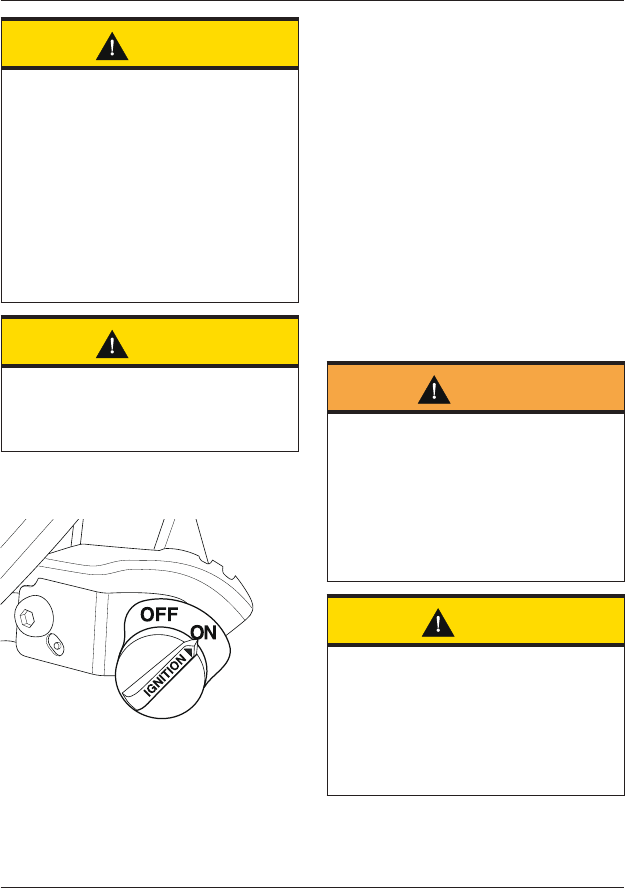
General Information
92
Caution
All keys supplied with the motorcycle
are specific to the individual
motorcycle. They cannot be used on
another motorcycle.
If all keys are lost, misplaced or
damaged, then the chassis control unit
on the motorcycle will need to be
replaced.
To avoid unnecessary cost and time,
make sure that all spare keys are kept
in a secure location.
Caution
If there is a fault with the smart key or
the smart key battery is flat then take
the smart key to the nearest Triumph
dealer to rectify.
Master Ignition Switch (if equipped)
ckde
Master Ignition Switch
The master ignition switch is only
mounted to motorcycles in the United
States and Canada. The master ignition
switch is located on the right hand side
of the instrument panel.
To operate the motorcycle with the
keyless ignition, the master ignition
switch must be in the ON position.
If the master ignition switch is in the
OFF position then the keyless ignition
cannot be used and the motorcycle
cannot be started.
Ignition Key
Tiger 1200 XR Only
Warning
Additional keys, key rings/chains or
items attached to the ignition key may
interfere with the steering, leading to
loss of motorcycle control and an
accident.
Remove all additional keys, key rings/
chains and items from the ignition key
before riding the motorcycle.
Caution
Additional keys, key rings/chains or
items attached to the ignition key may
cause damage to the motorcycle's
painted or polished components.
Remove all additional keys, key rings/
chains and items from the ignition key
before riding the motorcycle.
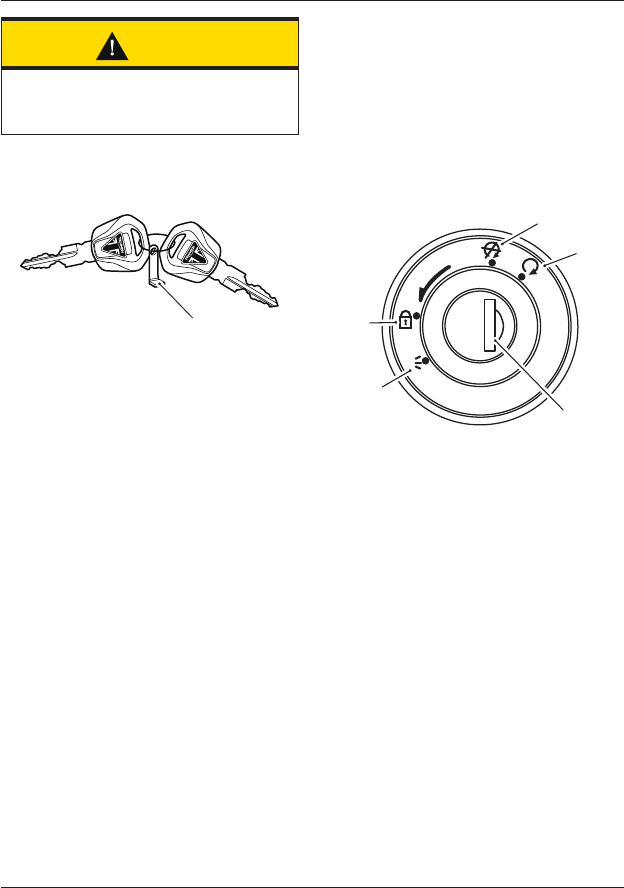
General Information
93
Caution
Do not store the spare key with the
motorcycle as this will reduce all
aspects of security.
1
cixj
1. Key number tag
In addition to operating the ignition
switch/steering lock, the ignition key is
required to operate the seat lock and
fuel tank cap.
When the motorcycle is delivered from
the factory, two ignition keys are
supplied together with a small tag
bearing the key number. Make a note of
the key number and store the spare key
and key number tag in a safe place
away from the motorcycle.
There is a transponder within the
ignition keys to turn off the engine
immobilizer. To make sure the
immobilizer functions correctly, always
have only one of the ignition keys near
the ignition switch. Having two ignition
keys near the switch may interrupt the
signal between the transponder and the
engine immobilizer. In this situation the
engine immobilizer will remain active
until one of the ignition keys is removed.
Always get replacement keys from your
authorized Triumph dealer. Replacement
keys must be 'paired' with the
motorcycle’s immobilizer by your
authorized Triumph dealer.
Ignition Switch/Steering Lock
Tiger 1200 XR Only
P
U
S
H
P
O
F
F
O
N
3
2
5
1
4
1. Ignition switch/steering lock
2. LOCK position
3. OFF position
4. ON position
5. PARK position
Engine Immobilizer
The ignition barrel housing acts as the
antenna for the engine immobilizer.
When the ignition switch is turned to
the OFF position and the ignition key is
removed, the engine immobilizer is on.
The engine immobilizer is turned off
when the ignition key is in the ignition
switch and it is turned to the ON
position.
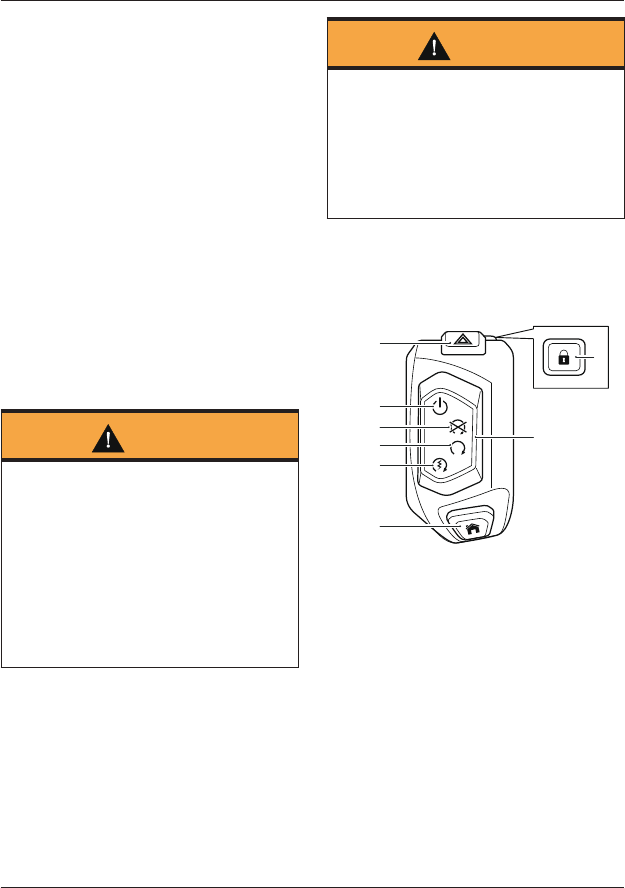
General Information
94
Ignition Switch Positions
This is a four-position, key operated
switch. The key can be removed from
the switch only when it is in the OFF,
LOCK or P (PARK) position.
TO LOCK: Turn the handlebar fully to the
left, turn the key to the OFF position,
push and fully release the key, then
rotate it to the LOCK position.
PARKING: Turn the key from the LOCK
position to the P position. The steering
will remain locked, and the position
lights will be switched on.
Note:
• Do not leave the steering lock in
the P position for long periods of
time as this will cause the battery
to discharge.
Warning
For reasons of security and safety,
always move the ignition switch to the
OFF, LOCK or PARK position and remove
the key when leaving the motorcycle
unattended.
Any unauthorized use of the
motorcycle may cause injury to the
rider, other road users and pedestrians
and may also cause damage to the
motorcycle.
Warning
With the key in the LOCK or P position
the steering will become locked.
Never turn the key to the LOCK or P
positions while the motorcycle is
moving as this will cause the steering
to lock. Locked steering will cause loss
of motorcycle control and an accident.
Right Handlebar Switches
All Models except Tiger 1200 XR
ckdp
1
3
4
5
7
6
2
8
1. HOME button
2. Engine start/stop switch
3. QUICK START position
4. RUN position
5. STOP position
6. Power ON/OFF position
7. Hazard warning lights switch
8. Steering lock button
HOME Button
The HOME button is used to access the
main menu on the instrument display.
Press and release the HOME button to
select between the main menu and
instrument display.
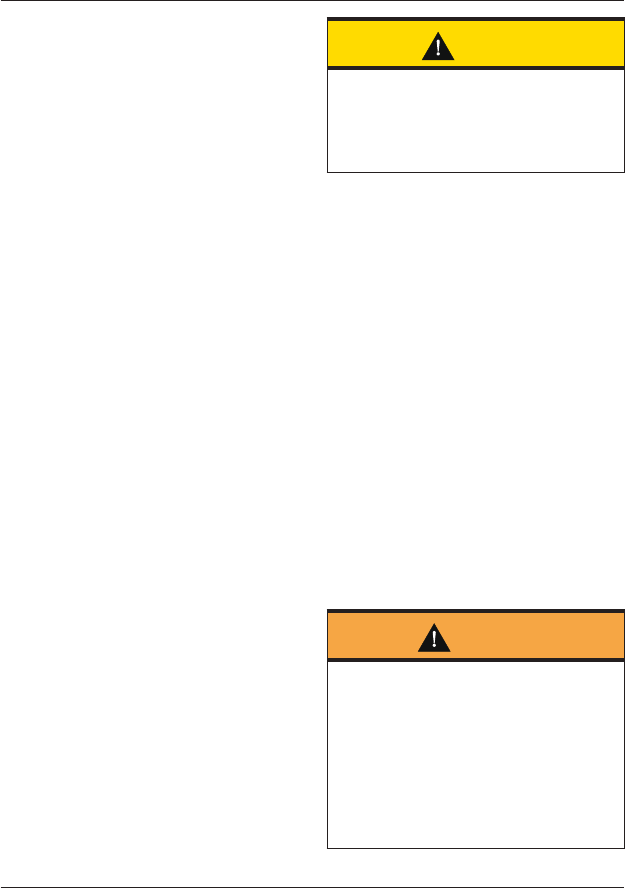
General Information
95
QUICK START Position
The QUICK START position operates the
electric starter allowing for a quicker
ignition start.
From the ignition off, press and hold the
engine start/stop switch in the
QUICKSTART position with all the correct
conditions met, to start the motorcycle.
For more information, see page 144.
RUN Position
The engine start/stop switch must be in
the RUN position for the motorcycle to
operate.
STOP Position
The STOP position stops the engine.
Note:
• Although the engine stop position
stops the engine, it does not turn
off all the electrical circuits and
may cause difficulty in restarting
the engine due to a discharged
battery.
Power ON/OFF Position
The Power ON/OFF position switches
the electrical circuits and the
instrument display between on or off.
This allows access to the instrument
display without starting the engine
when switched ON.
Caution
Do not leave the switch in the Power
ON position for a long period of time as
this may cause damage to electrical
components and will discharge the
battery.
Hazard Warning Lights Button
To turn the hazard warning lights on or
off, press and release the hazard
warning light button.
The ignition must be switched on for the
hazard warnings lights to be activated,
but the hazard lights will remain active
if the ignition is switched off until the
hazard warning light button is pressed
again.
Steering Lock Button
To lock the motorcycle, turn the
handlebar fully to the left and press the
steering lock button.
When the ignition is off then the engine
immobilizer is on. The engine immobilizer
is turned off when the ignition is started.
Warning
For reasons of security and safety,
always make sure the steering lock is
on when leaving the motorcycle
unattended.
Any unauthorized use of the
motorcycle may cause injury to the
rider, other road users and pedestrians
and may also cause damage to the
motorcycle.
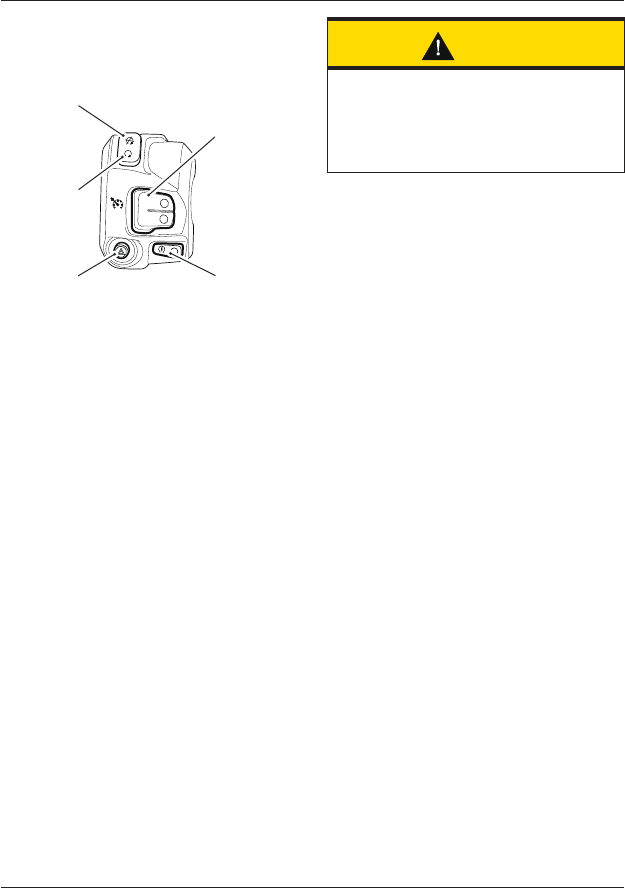
General Information
96
Right Handlebar Switches
Tiger 1200 XR Only
RES /+
SET /-
4
3
1
5
ON
2
1. Engine stop switch - STOP position
2. Engine stop switch - RUN position
3. Cruise control adjust button
4. Starter button
5. Hazard warning lights button
Engine Stop Switch
In addition to the ignition switch being
turned to the ON position, the engine
stop switch must be in the RUN position
for the motorcycle to operate.
The engine stop switch is for emergency
use. If an emergency arises which
requires the engine to be stopped, move
the engine stop switch to the STOP
position.
Note:
• Although the engine stop switch
stops the engine, it does not turn
off all the electrical circuits and
may cause difficulty in restarting
the engine due to a discharged
battery. Ordinarily, only the ignition
switch should be used to stop the
engine.
Caution
Do not leave the ignition switch in the
ON position unless the engine is
running as this may cause damage to
electrical components and will
discharge the battery.
Starter Button
The starter button operates the electric
starter. For the starter to operate, the
clutch lever must be pulled to the
handlebar.
Note:
• Even if the clutch lever is pulled to
the handlebar, the starter will not
operate if the side stand is down
and a gear is engaged.
Cruise Control Adjust Button
The cruise control adjust button is a
two way switch with the top marked
RES/+ and the bottom marked SET/-
(see page 104).
Hazard Warning Lights Button
To turn the hazard warning lights on or
off, press and release the hazard
warning light button.
The ignition must be switched on for the
hazard warnings lights to be activated,
but the hazard lights will remain active
if the ignition is switched off until the
hazard warning light button is pressed
again.
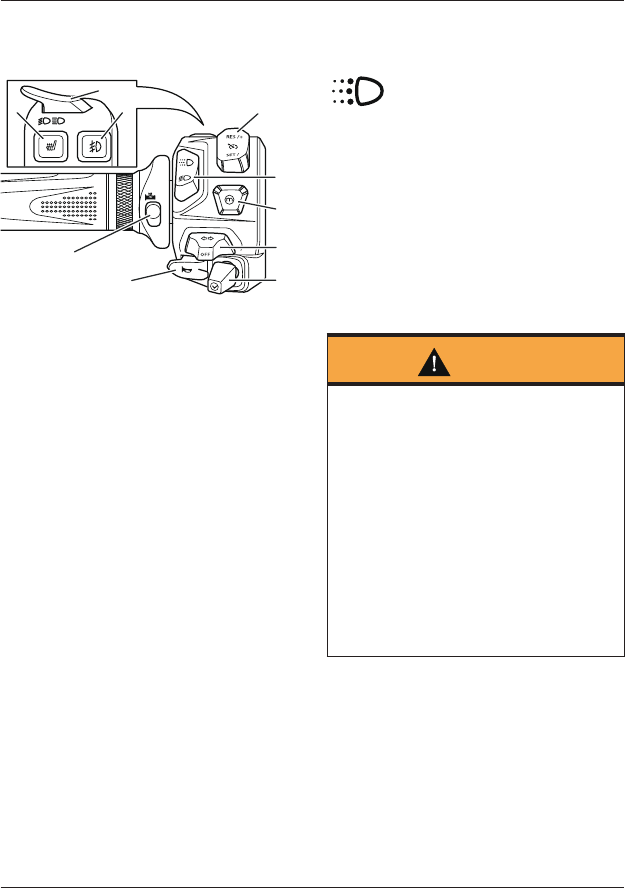
General Information
97
Left Handlebar Switches
All Models except Tiger 1200 XR
ckdf
5
6
1
2
3
7
8
9
10
4
1. Cruise control adjust switch
2. Daytime Running Lights (DRL) switch
(if equipped)
3. MODE button
4. Turn signal switch
5. Joystick button
6. Horn button
7. Heated grips switch
8. Front fog lights switch (if equipped)
9. High beam button
10. Rider’s heated seat switch (if equipped)
Cruise Control Adjust Button
The cruise control adjust button is a
two way switch with the top marked
RES/+ and the bottom marked SET/-.
For more information on cruise control
operation, see page 104.
Daytime Running Lights (DRL)
Switch (if equipped)
When the ignition is switched
ON and the daytime running lights
switch is set to DRL mode, the daytime
running lights warning light will
illuminate.
The daytime running lights and low
beam headlights are operated manually
using the DRL switch. Press the top of
the switch for DRL mode, and the
bottom of the switch for low beam
headlight mode.
Warning
Do not ride for longer than necessary
in poor ambient light conditions with
the Daytime Running Lights (DRL) in
use.
Riding with the daytime running lights
when dark, in tunnels or where poor
ambient light is apparent may reduce
the riders vision or blind other road
users.
Blinding other road users or reduced
vision in low ambient light levels may
result in loss of motorcycle control and
an accident.
Note:
• During daylight hours the daytime
running lights improve the motor-
cycles visibility to other road users.
• Low beam headlights must be used
in any other conditions unless the
road conditions allow for high beam
headlights to be used.

General Information
98
MODE Button
When the MODE button is pressed and
released it will activate the Riding Mode
Selection Menu in the display screen.
Further presses of the MODE button will
scroll through the available riding modes
(see Riding Mode Selection on page 81).
Press and hold the MODE button
provides direct access to a riding
mode’s configuration menu.
For more information on riding mode
selection and configuration, see
page 85).
Turn Signal Switch
When the turn signal switch is pushed
to the left or right and released, the
corresponding turn signals will flash on
and off. To turn off the turn signals,
push and release the switch in the
central position.
Models Equipped with Automatic
Self-Canceling Turn Signals
A short press and release of the turn
signal switch to the left or right will
cause the corresponding turn signals to
flash on and off three times, then go off.
A longer press and release of the turn
signal switch to the left or right will
cause the corresponding turn signals to
flash on and off until they are canceled
as follows:
The turn signal self-cancel system
becomes active eight seconds after
operating a turn signal. Eight seconds
after turning the turn signal on and
after riding a further 213 ft. (65 meters),
the turn signal self-cancel system will
automatically turn off the turn signals.
To disable the turn signal self-cancel
system refer to the Bike Setup section
on page 47.
The turn signals can be canceled
manually. To manually turn off the turn
signal, press and release the turn signal
switch in the central position.
Joystick Button
The Joystick is used to operate the
following functions of the instruments:
• Up - scroll the menu from the
bottom to the top
• Down - scroll the menu from the
top to the bottom
• Left - scroll the menu to the left
• Right - scroll the menu to the right
• Center - press to confirm selection.
Horn Button
When the horn button is pushed, with
the ignition switch turned to the ON
position, the horn will sound.
Heated Grips Switch
The heated grips will only heat when
the engine is running.
When the heated grips are switched on,
the heated grips symbol will appear in
the display and the selected heat level
will be shown.
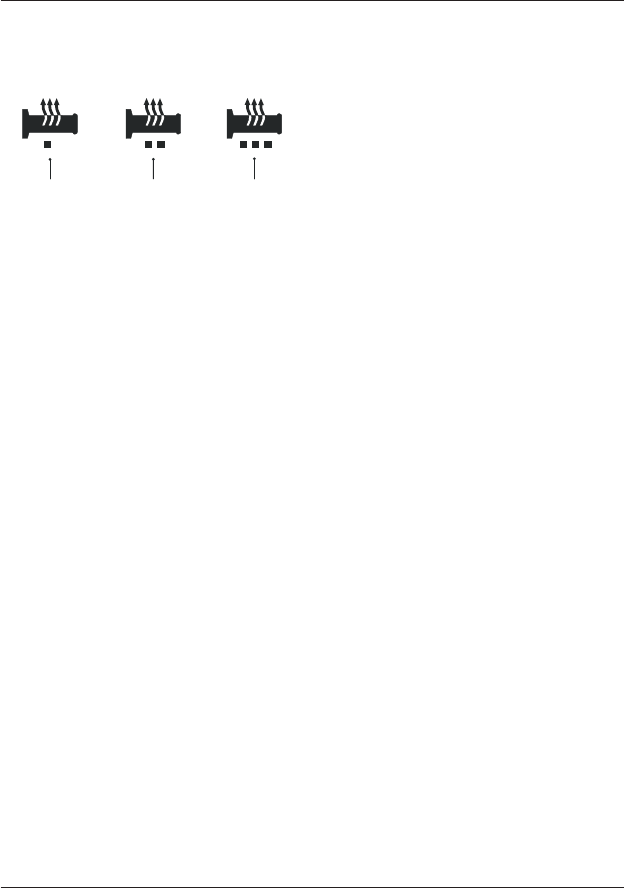
General Information
99
There are three levels of heat: low,
medium and high. This is indicated by
the different colors of the symbols
shown in the display.
1
23
1. Low heat symbol (yellow)
2. Medium heat symbol (orange)
3. High heat symbol (red)
For maximum benefit in cold conditions,
from the OFF position press the switch
once for the high heat setting initially
and then reduce the heat level by
pressing the switch again for a low heat
setting when the grips have warmed up.
To turn off the heated grips, press and
release the switch until the heated grips
symbol is no longer shown in the
display.
Low Power Voltage Cut Off
If a low voltage is detected, the heated
grips switch will power off. The heated
grips will not function again until the
voltage rises to a safe level.
The switch will not power back on
automatically even if the voltage rises to
the safe level. The user must manually
press the switch again to activate the
heated grips.
Fog Lights Switch (if equipped)
To turn the fog lights on or off, with the
headlights on, press and release the fog
lights switch. When the fog lights are
turned on, the fog lights indicator will
illuminate in the display.
Note:
• The fog lights switch will only
operate when the headlights are on.
• The fog lights switch will reset to
off when the ignition is turned off
then on again.
High Beam Button
The high beam button has a different
function depending on whether Daytime
Running Lights (DRL) are installed or
not. When the high beam is turned on,
the high beam indicator light will
illuminate in the display.
Models with Daytime Running
Lights (DRL)
If the DRL switch is in the Daytime
Running Lights (DRL) position, then
press and hold the high beam button to
turn the high beam on. It will remain on
as long as the button is held in and will
turn off as soon as the button is
released.
If the DRL switch is in the dip beam
position, press the high beam button to
switch the high beam on. Each press of
the button will swap between dip and
high beam.
Note:
• A lighting on/off switch is not
installed on this model. The brake/
tail light and license plate light all
function automatically when the
ignition is turned to the ON position.
• The headlight will function when
the ignition is turned on and the
engine is running.
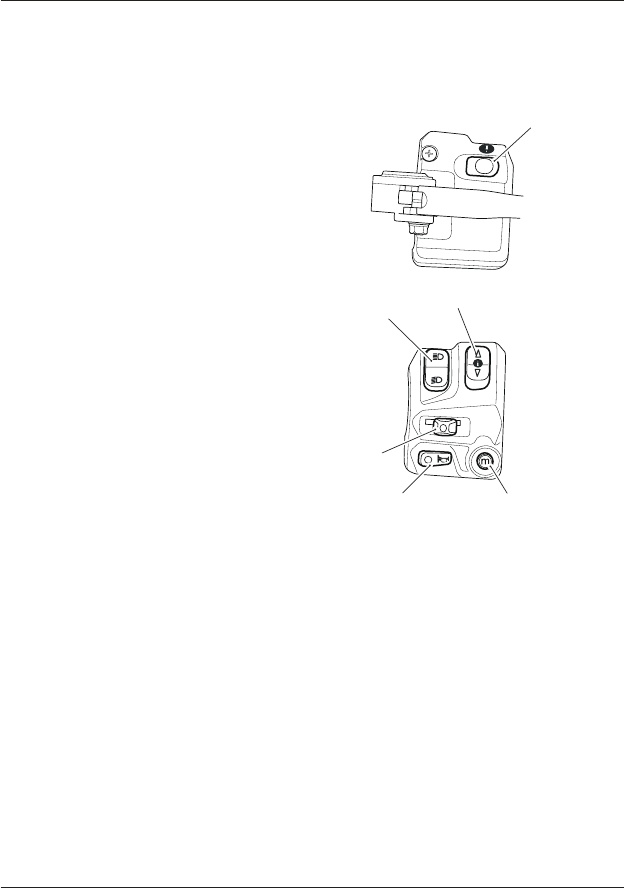
General Information
100
Models without Daytime Running
Lights (DRL)
Press the high beam button to switch
the high beam on. Each press of the
button will swap between dip and high
beam.
Note:
• A lighting on/off switch is not
installed on this model. The position
light, brake/tail light and license
plate light all function automatically
when the ignition is turned to the
ON position.
• The headlight will function when
the ignition is turned on and the
engine is running.
Rider’s Heated Seat Switch
(if equipped)
The rider’s heated seat will only heat
when the engine is running. When the
rider’s heated seat is switched on, then
the rider’s heated seat symbol will
appear in the display. The selected heat
level will also be indicated by the color
of the symbol.
For more information, see page 124.
Left Handlebar Switches
Tiger 1200 XR Only
4
5
1
2
36
1. Headlight dimmer switch
2. Turn signal switch
3. Horn button
4. Instruments SELECT button
5. Instruments SCROLL button
6. MODE button
Headlight Dimmer Switch
High or dip beam can be selected with
the headlight dimmer switch. To select
high beam, push the switch forward. To
select dip beam, push the switch
rearwards. When the high beam is
turned on, the high beam indicator light
will illuminate in the tachometer.

General Information
101
Pass Function
With the headlight dimmer switch set to
the dip beam position, pressing the
bottom of the switch will activate the
pass function.
When pressed, the headlight high beam
will be switched on. It will remain on as
long as the switch is held in and will
turn off as soon as the switch is
released.
Note:
• A lighting on/off switch is not
installed on this model. The position
light, brake/tail light and license
plate light all function automatically
when the ignition is turned to the
ON position.
• The headlight will function when
the ignition switch is turned to the
ON position and the engine is
running.
There are two alternate ways to turn on
the headlight without the engine
running:
• Pull in the clutch lever then turn
the ignition to the ON position. The
headlight will be on and will remain
on when the clutch lever is
released.
• With the ignition on and the
headlight dimmer switch set to the
dip beam position, pressing the
bottom of the switch will activate
the headlight. The headlight will
remain on when the switch is
released.
The headlight will go off while pressing
the starter button until the engine
starts.
Turn Signal Switch
When the turn signal switch is pushed
to the left or right and released, the
corresponding turn signals will flash on
and off. To turn off the turn signals,
push and release the switch in the
central position.
Horn Button
When the horn button is pushed, with
the ignition switch turned to the ON
position, the horn will sound.
Instrument SELECT Button
When the SELECT button is pressed and
released it will select the menu
highlighted in the multifunction display
screen.
Pressing and holding the SELECT button
when the motorcycle is stationary will
activate the Settings Menu in the
multifunction display (see Settings Menu
on page 74).
Instrument SCROLL Button
When the SCROLL button is pressed and
released it will scroll through the menu
visible in the instrument's display
screen.
MODE Button
When the MODE button is pressed and
released it will activate the Riding Mode
Selection Menu in the multifunction
display screen. Further presses of the
mode button will scroll through the
available riding modes (see Riding Mode
Selection on page 81).
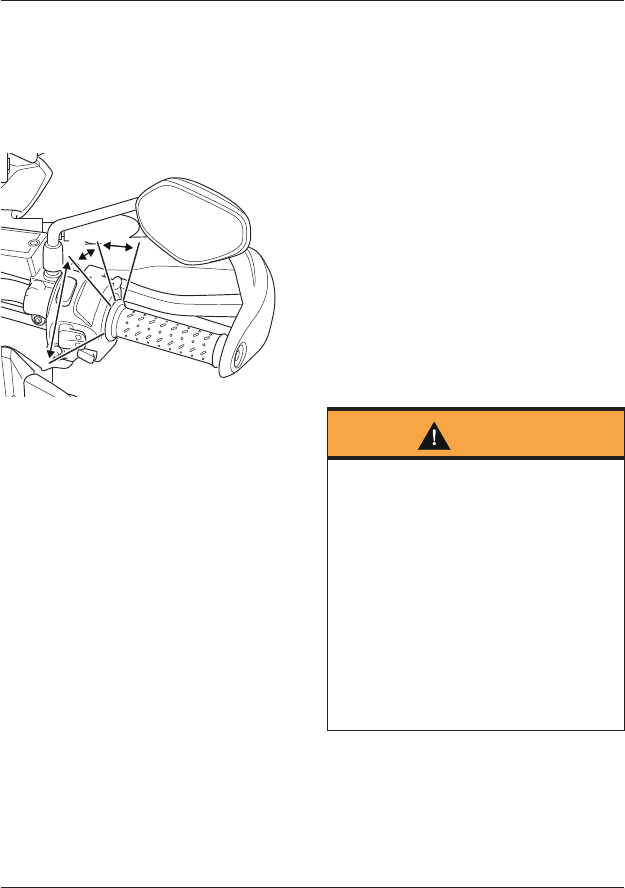
General Information
102
Pressing and holding the MODE button
will provide direct access to a Riding
Mode’s Configuration Menu (see Riding
Mode Configuration on page 85).
Throttle Control
2
1
3
1. Throttle open position
2. Throttle closed position
3. Cruise control cancel position
This Triumph model has an electronic
throttle twist grip to open and close the
throttle via the engine control unit.
There are no direct-acting cables in the
system.
The throttle grip has a resistive feel to it
as it is rolled rearwards to open the
throttle. When the grip is released it will
return to the throttle closed position by
its internal return spring and the
throttle will close.
From the closed position, the throttle
twist grip can be rolled forward
0.12 - 0.16 in (3 - 4 mm) to deactivate the
cruise control (see page 106).
There are no user adjustments for the
throttle control.
If there is a malfunction with the
throttle control the Malfunction
Indicator Light (MIL) becomes
illuminated and one of the following
engine conditions may occur:
• MIL illuminated, restricted engine
RPM and throttle movement
• MIL illuminated, limp-home mode
with the engine at a fast idle
condition only
• MIL illuminated, engine will not
start.
For all of the above conditions contact
an authorized Triumph dealer as soon
as possible to have the fault checked
and rectified.
Brake Use
Warning
Reduce speed and do not continue to
ride for longer than is necessary with
the malfunction indicator light
illuminated. The fault may adversely
affect engine performance, exhaust
emissions and fuel consumption.
Reduced engine performance could
cause a dangerous riding condition,
leading to loss of motorcycle control
and an accident.
Contact an authorized Triumph dealer
as soon as possible to have the fault
checked and rectified.
At low throttle opening (approximately
68°F (20°C)), the brakes and throttle can
be used together.
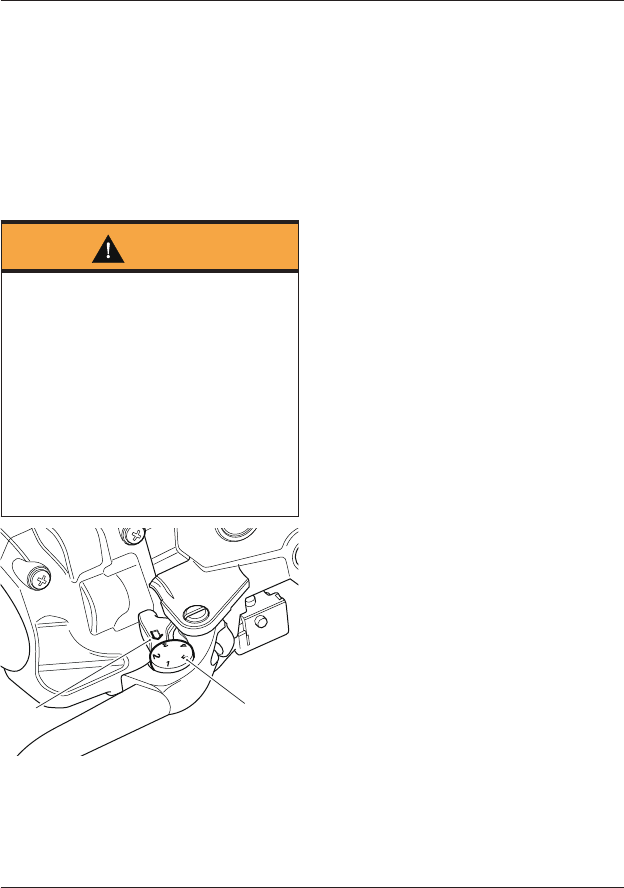
General Information
103
At high throttle opening (greater than
68°F (20°C)), if the brakes are applied for
more than two seconds the throttles will
close and the engine speed will reduce.
To return to normal throttle operation,
release the throttle control, release the
brakes and then re-open the throttle.
Brake and Clutch Lever Adjusters
Warning
Do not attempt to adjust the lever with
the motorcycle in motion as this may
lead to loss of motorcycle control and
an accident.
After adjusting the lever, operate the
motorcycle in an area free from traffic
to gain familiarity with the new lever
setting. Do not loan your motorcycle to
anyone as they may change the lever
setting from the one you are familiar
with causing loss of motorcycle control
and an accident.
21
chdd_2
1. Adjuster wheel, brake lever shown
2. Arrow mark
An adjuster is mounted to both the
front brake and clutch levers. The
adjusters allow the distance from the
handlebar to the lever to be changed to
one of five positions for the front brake
lever or four positions for the clutch
lever, to suit the span of the operator's
hands.
To adjust the lever:
• Push the lever forward and turn
the adjuster wheel to align one of
the numbered positions with the
arrow mark on the lever holder.
• The distance from the handlebar
grip to the released lever is
shortest when set to number five,
and longest when set to number
one.
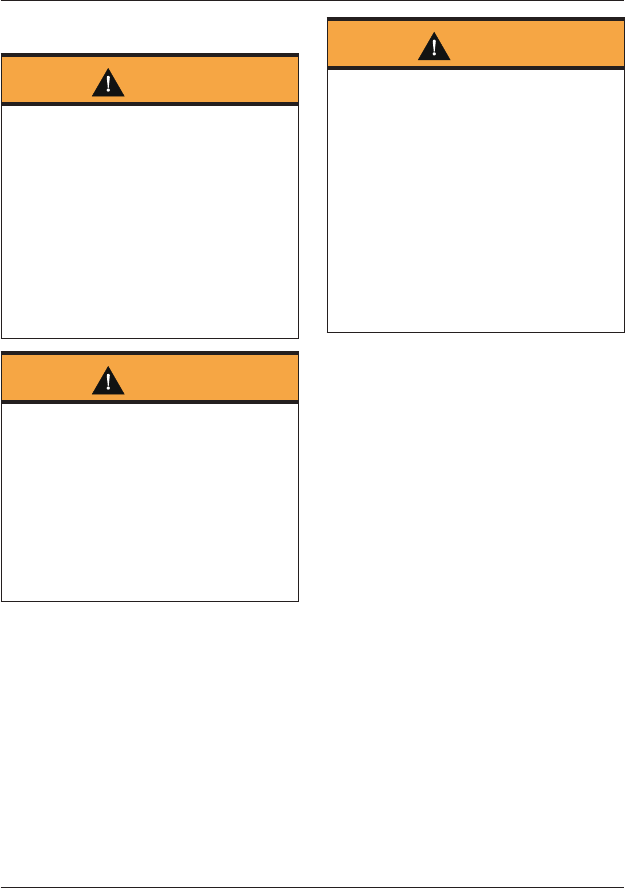
General Information
104
Cruise Control
Warning
Cruise control must only be used
where you can drive safely at a steady
speed.
Cruise control should not be used
when riding in heavy traffic, on roads
with sharp/blind bends or when they
are slippery.
Using cruise control in heavy traffic, on
roads with sharp/blind bends or when
they are slippery, may result in loss of
motorcycle control and an accident.
Warning
This Triumph motorcycle should be
operated within the legal speed limits
for the particular road traveled.
Operating a motorcycle at high speeds
can be potentially dangerous since the
time available to react to given traffic
situations is greatly reduced as speed
increases. Always reduce speed in
consideration of weather and traffic
conditions.
Warning
Only operate this Triumph motorcycle
at high speed in closed-course, on-
road competition or on closed-course
racetracks. High speed operation
should only then be attempted by
riders who have been instructed in the
techniques necessary for high speed
riding and are familiar with the
motorcycle's behavior in all conditions.
High speed operation in any other
circumstances is dangerous and will
lead to loss of motorcycle control and
an accident.
Note:
• Cruise control may not function if
there is a malfunction with the ABS
system and the ABS warning light
is illuminated.
• Cruise control will continue to
function if a riding mode is selected
with ABS set to Off-Road or Off.
• Cruise control will continue to
function if ABS has been disabled.
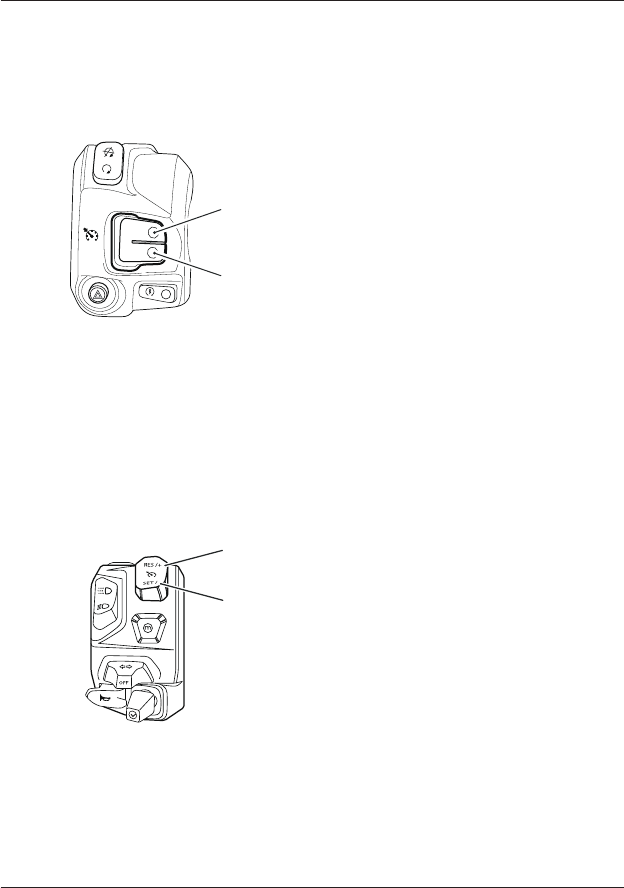
General Information
105
Tiger 1200 XR Only
The cruise control buttons are located
on the right hand switch housing and
can be operated with minimum
movement by the rider.
RES /+
SET /-
ON
2
1
1. Cruise control RES/+ button
2. Cruise control SET/- button
All Models except Tiger 1200 XR
The cruise control buttons are located
on the left hand switch housing and can
be operated with minimum movement
by the rider.
1
2
1. Cruise control RES/+ button
2. Cruise control SET/- button
Cruise control can be switched on or off
at any time but it cannot be activated
until all the conditions described on
page 105 have been met.
Activating Cruise Control
To turn on the cruise control system,
press the SET/- button. The cruise
control symbol will be shown in the
display screen. The cruise control set
speed will be shown as ‘--’ indicating
that a speed has not yet been set.
To activate cruise control, the following
conditions have to be met:
• The motorcycle must be traveling
at a speed between 19 to 100 mph
(30 to 160 km/h).
• The motorcycle must be in 3 rd gear
or higher.
• Once these conditions have been
met, press the SET/- button to
activate cruise control. The cruise
control symbol will be shown in a
green light in the TFT display to
indicate that cruise control is now
active.
The word SET will be shown next to the
cruise control symbol. The cruise control
set speed will be shown and the cruise
control light will illuminate in the
tachometer indicating that cruise
control is active.
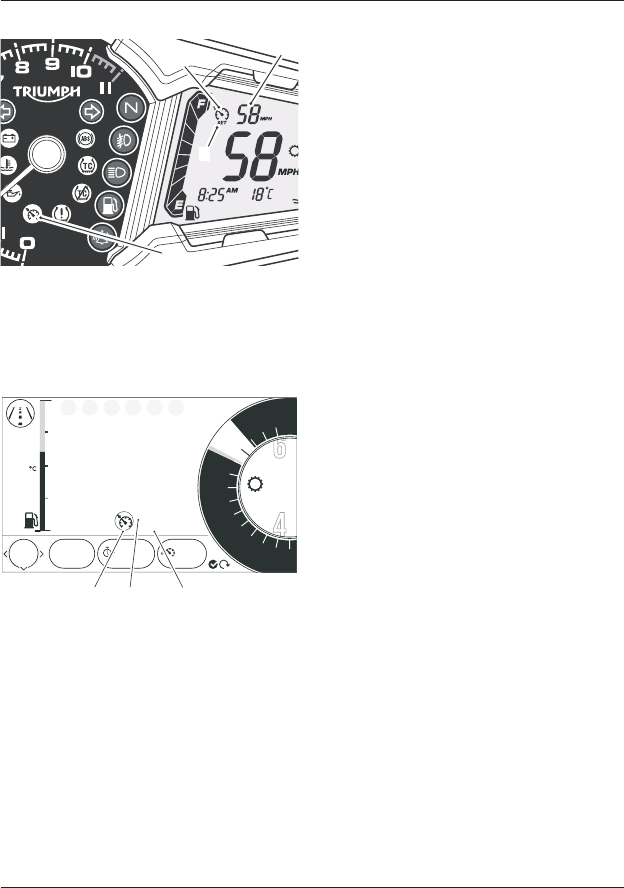
General Information
106
Tiger 1200 XR Only
4
1
2
3
1. Cruise control symbol
2. Cruise control set indicator
3. Cruise control set speed
4. Cruise control light
All Models except Tiger 1200 XR
o7:29
12.5
19999 02:25
8
6
4
2
0
25.2
F
E
TRIP
mi mp/hHH:MM
PM
SET
58
mp/h
10
585
12 14
RPM
x1000
123
1. Cruise control symbol
2. Cruise control set indicator
3. Cruise control set speed
The cruise control system will maintain
the set speed until:
• The set speed is adjusted as
described on page 106.
• Cruise control is deactivated as
described on page 106.
Adjusting the Set Speed While in
Cruise Control
To adjust the set speed while in cruise
control, press and release the:
• RES/+ button to increase the speed
• SET/- button to decrease the
speed.
Each press of the buttons will adjust
the speed by 1 mph or 1 km/h. If the
buttons are held, the speed
continuously increases or decreases in
single digit increments.
Stop pressing the adjust button when
the desired speed is shown in the
display.
Note:
• The cruise control set speed display
will flash until the new set speed
has been achieved.
• If riding up a steep incline and
cruise control is unable to maintain
the set speed, the cruise control set
speed display will flash until the
motorcycle has regained the set
speed.
An alternative way to increase the
speed in cruise control is to accelerate
to the desired speed using the throttle
grip and then press the SET/- button.
Deactivating Cruise Control
The cruise control can be deactivated
by one of the following methods:
• Roll the throttle twist grip fully
forward.
• Pull the clutch lever.
• Operate the front or rear brake.
• Increase speed by using the
throttle for more than 60 seconds.
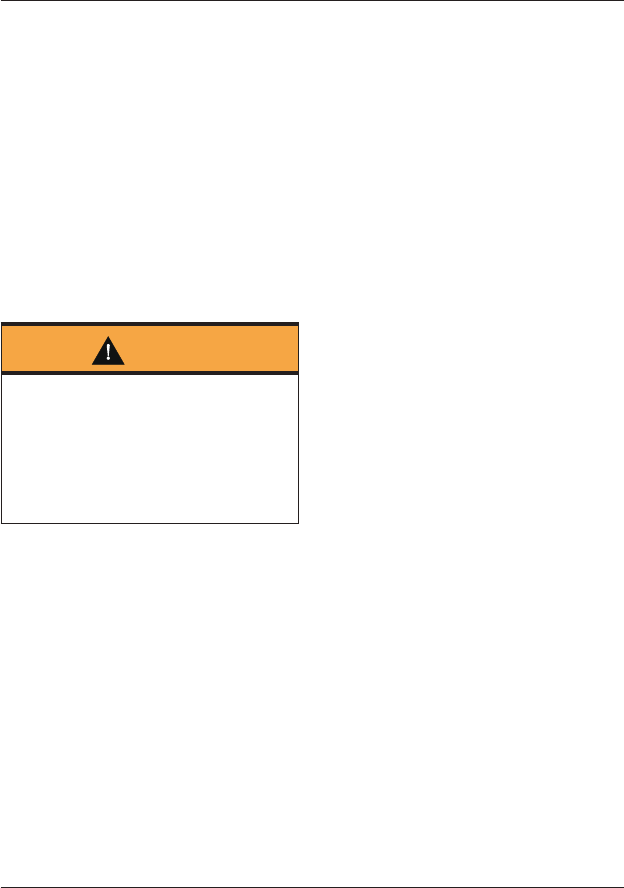
General Information
107
Upon deactivation, the cruise control
light will go out in the tachometer but
the SET indicator and set speed will still
be shown in the display screen,
indicating that the cruise control set
speed has been stored.
The cruise control set speed can be
resumed as described on page 107,
provided the cruise control has not
been deactivated by turning the ignition
switch to the OFF position.
Resuming the Cruise Control Set
Speed
Warning
When resuming cruise control, always
make sure that the traffic conditions
are suitable for the set speed.
Using cruise control in heavy traffic, on
roads with sharp/blind bends or when
they are slippery, may result in loss of
motorcycle control and an accident.
Cruise control will be deactivated if one
of the following actions has been taken:
• Roll the throttle twist grip fully
forward.
• Pull the clutch lever.
• Operate the front or rear brake.
• Increase speed by using the
throttle grip for more than
60 seconds.
The cruise control set speed can be
resumed by pressing and releasing the
RES/+ button provided a set speed has
been stored.
The motorcycle must be traveling at a
speed between 19 to 100 mph (30 to
160 km/h) and be in 3rd gear or higher.
A stored set speed is indicated by the
word SET next to the cruise control
symbol in the display screen.
The stored set speed will remain in the
cruise control memory until the ignition
switch has been turned to the OFF
position.
Note:
• The cruise control set speed display
will flash until the resumed set
speed has been achieved.

General Information
108
Triumph Semi Active
Suspension (TSAS)
(if equipped)
Note:
• All models except for Tiger 1200 XR
are equipped with Triumph Semi
Active Suspension (TSAS).
Warning
After adjusting the suspension,
operate the motorcycle in an area free
from traffic to gain familiarity with the
new settings.
Do not loan your motorcycle to anyone
as they may change the suspension
settings from the one you are familiar
with causing loss of motorcycle control
and an accident.
The Triumph Semi-Active Suspension
System (TSAS) controls adjustment of
the front and rear suspension damping
and automatic rear suspension preload
settings.
TSAS allows a convenient remote
adjustment of the TSAS mode and
damping settings through the
instruments, while the motorcycle is
stationary or moving.
TSAS adjustments are made
instantaneously once a new mode or
damping setting has been selected and
the engine is running.
TSAS Modes
The following TSAS modes are available
for selection:
• Auto - The TSAS system will
automatically detect the type of
surface being ridden on (road or
off-road) and will adjust rebound
and compression damping settings
accordingly.
• Off-Road - Optimal TSAS settings
for off-road use.
TSAS Damping Settings
There are a total of nine damping
settings available for selection ranging
from COMFORT (soft) to SPORT (firm)
with the three main settings being:
• COMFORT
• NORMAL
• SPORT.
For more information on accessing the
TSAS settings, see page 45.
System Calibration
The TSAS system will recalibrate
adjustment motors under the following
conditions:
• If the battery has been
disconnected for any reason.
• If a fault occurs with the TSAS
system during normal operation.
The warning light will flash twice every
second during system recalibration.
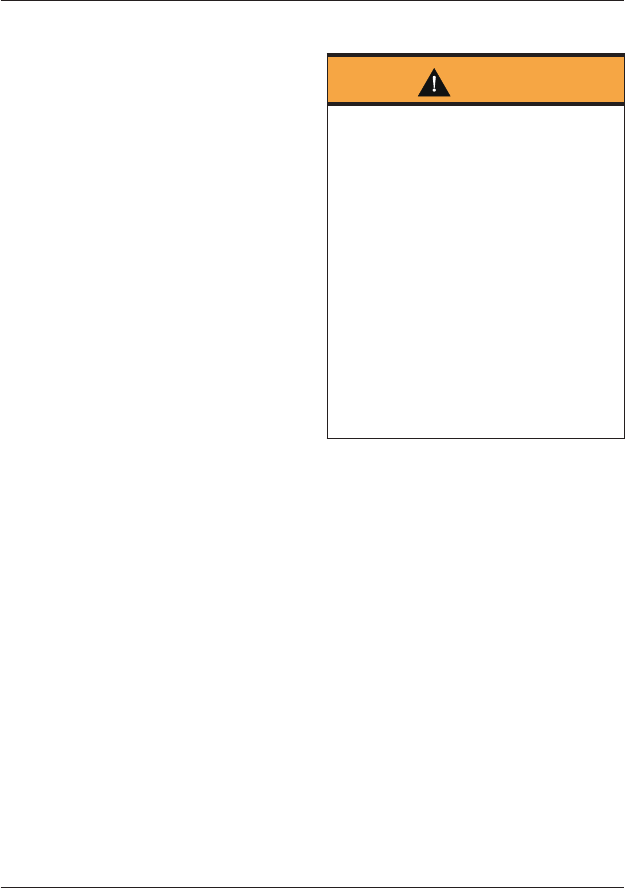
General Information
109
To allow the system to calibrate
correctly, the following procedure must
be adhered to:
• Turn the ignition on. Do not start
the engine.
• Wait for the warning light to stop
flashing indicating that adjustment
motor calibration is complete.
• Start the engine. If the warning
light resumes flashing. the
adjustment motors are being
recalibrated due to low battery
voltage.
• Wait for the warning light to stop
flashing before riding the
motorcycle.
Failure to follow this procedure will
cause the recalibration to be stopped
and the warning light to remain lit.
In this case the warning light will
extinguish once the recalibration is next
allowed to complete.
Traction Control (TC)
Warning
The traction control and optimized
cornering traction control systems are
not a substitute for riding
appropriately for the prevailing surface
and weather conditions. The systems
cannot prevent loss of traction due to:
• excessive speed when entering turns
• accelerating at a sharp lean angle
• braking.
Traction control or optimized cornering
traction control cannot prevent the
front wheel from slipping.
Failure to observe any of the above
may result in loss of motorcycle control
and an accident.
All motorcycles are equipped with
Traction Control (TC).
Traction control is a system that helps
to maintain traction when accelerating
on wet/slippery road surfaces. If
sensors detect that the rear wheel is
losing traction (slipping), the traction
control system will engage and alter the
engine power until traction to the rear
wheel has been restored.
The traction control indicator light will
flash while it is engaged and the rider
may notice a change to the sound of
the engine.
For information on the traction control
indicator light operation, see page 26
and page 62.
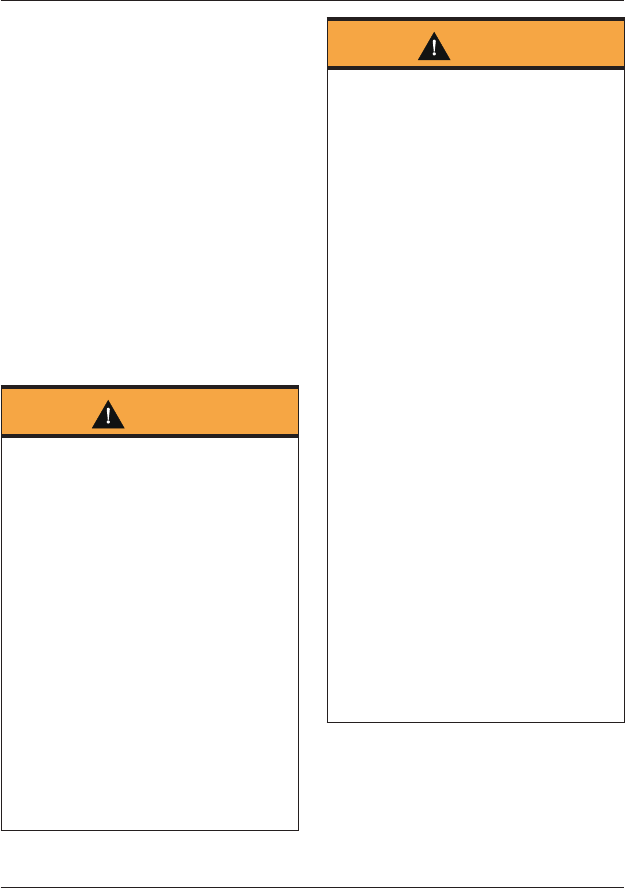
General Information
110
Optimized Cornering Traction
Control (if equipped)
Note:
• All models except Tiger 1200 XR are
equipped with optimized cornering
Traction Control (TC).
Optimized cornering traction control is a
system designed to give the rider
increased control should the traction
control be activated while the
motorcycle is leaning in a corner.
The system constantly monitors the
lean angle of the motorcycle and adapts
the level of traction control intervention
to maintain rear wheel traction during
cornering.
Warning
If the TC system is not functioning,
care must be taken when accelerating
and cornering on wet/slippery road
surfaces to avoid rear wheel spin.
In the event of a fault, the TC disabled
warning light may be accompanied by
the engine management system
malfunction indicator light and/or the
ABS warning light.
Do not continue to ride for longer than
is necessary with any of the above
warning lights illuminated. Contact an
authorized Triumph dealer as soon as
possible to have the fault checked and
rectified.
Hard acceleration and cornering in this
situation may cause the rear wheel to
spin resulting in loss of motorcycle
control and an accident.
Warning
If a fault occurs with the optimized
cornering TC system, the TC disabled
warning light will illuminate and a
message will be shown in the display.
In this situation, the TC system will
continue to operate but without the
optimized cornering function, provided
that:
• There are no other faults with the TC
system.
• TC has NOT been disabled by the rider
(see Bike Setup on page 48 or Riding
Mode Configuration on page 44).
Care must be taken when accelerating
and cornering on wet/slippery road
surfaces to avoid rear wheel spin.
In the event of a fault, the TC disabled
warning light may be accompanied by
the engine management system
malfunction indicator light and/or the
ABS warning light.
Do not continue to ride for longer than
is necessary with any of the above
warning lights illuminated. Contact an
authorized Triumph dealer as soon as
possible to have the fault checked and
rectified.
Hard acceleration and cornering in this
situation may cause the rear wheel to
spin resulting in loss of motorcycle
control and an accident.
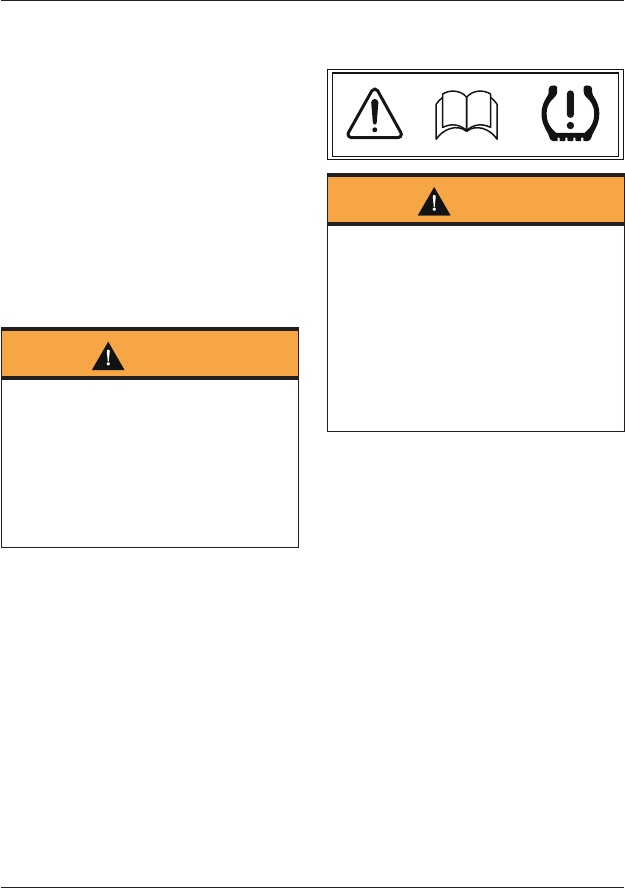
General Information
111
Note:
• TC and optimized TC control
(if equipped) may not function if
there is a malfunction with the ABS
system. In this situation, the
warning lights for the ABS, TC and
the MIL may be illuminated.
For full details of the TC disabled
warning light operation and its
associated instrument warning
messages, see page 27.
Traction Control Settings
Warning
If the traction control is disabled, the
motorcycle will handle as normal but
without traction control.
In this situation accelerating too hard
on wet/slippery road surfaces may
cause the rear wheel to slip, and may
result in loss of motorcycle control and
an accident.
The TC system can be disabled as
described in Bike Setup on page 48, or
set to the conditions described in Riding
Mode Configuration on page 44.
Tire Pressure Monitoring
System (TPMS) (if equipped)
Warning
The daily check of tire pressures must
not be excluded because of the
installation of the TPMS. Check the tire
pressure when the tires are cold and
using an accurate tire pressure gage
(see page 189).
Use of the TPMS system to set
inflation pressures may lead to
incorrect tire pressures leading to loss
of motorcycle control and an accident.
Function
Tire pressure sensors are mounted to
the front and rear wheels. These
sensors measure the air pressure inside
the tire and transmit pressure data to
the instruments. The sensors will not
transmit data until the motorcycle
reaches a speed of approximately
12 mph (20 km/h). Two dashes will be
visible in the system display until the
tire pressure signal is received.
After bring the motorcycle to a stop, the
sensors continue to transmit data for
approximately seven minutes before
switching off. The tire pressure values
remain visible in the system display until
the sensors switch off.
An adhesive label will be mounted to the
wheel rim to indicate the position of the
tire pressure sensor, which is near the
valve.
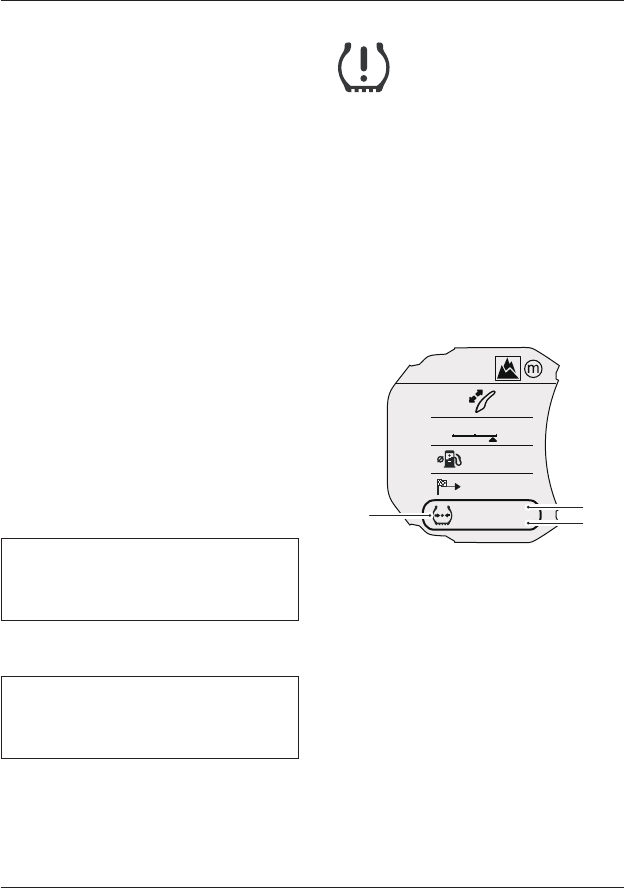
General Information
112
Note:
• The Tire Pressure Monitoring
System (TPMS) is available as an
accessory kit. It must be installed
by your authorized Triumph dealer.
• The TPMS display on the
instruments will only be activated
when the system has been installed.
Tire Pressure Sensor Serial Number
The serial number for the tire pressure
sensor is printed on a label attached to
the sensor. This number may be
required by your authorized Triumph
dealer for service or diagnostics.
When the tire pressure monitoring
system is being installed to the
motorcycle, make sure that your
authorized Triumph dealer records the
serial numbers of the front and rear tire
pressure sensors in the spaces provided
below.
Front Tire Pressure Sensor
Rear Tire Pressure Sensor
System Display
The tire pressure warning
light works in conjunction with the Tire
Pressure Monitoring System (TPMS).
The warning light will only illuminate
when the front or rear tire pressure is
below the recommended pressure. It will
not illuminate if the tire is over inflated.
When the warning light is illuminated,
the TPMS symbol indicating which is the
deflated tire and its pressure will
automatically be shown in the display.
Tiger 1200 XR Only
OFF-ROAD
AUTO
OFF-ROAD
MPG
MI
PSI
PSI
CNS
1
2
36
42
F
R
47
12
12
3
1. TPMS symbol
2. Front tire pressure indicator
3. Rear tire pressure indicator
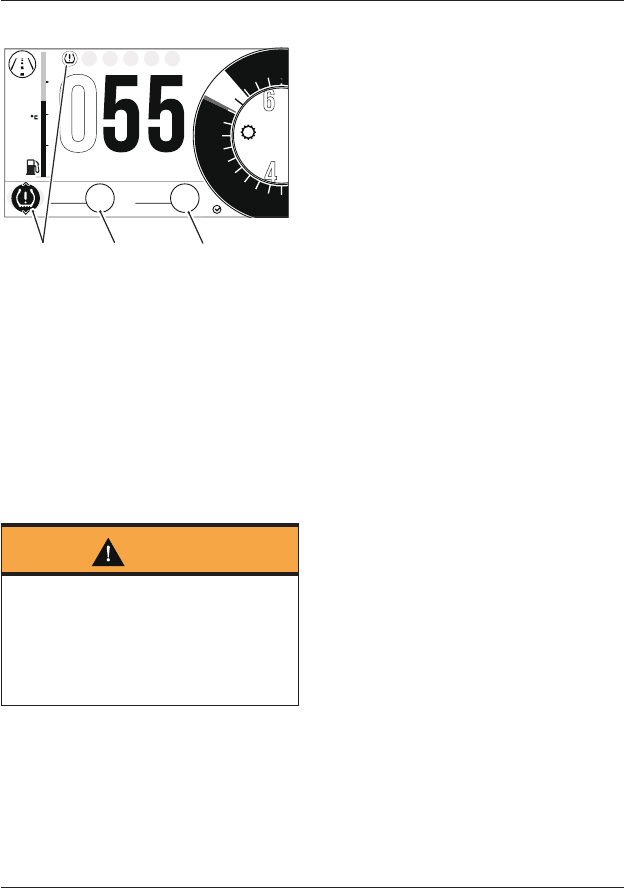
General Information
113
All Models except Tiger 1200 XR
o7:29
12.5
19999 02:25
8
65
4
2
0
12 14
25.2
F
E
TRIP
mi mp/hHH:MM
PM
RPM
x1000
mph
10
42
PSI
FR
30
PSI
1
2 3
1. Warning lights
2. Front tire pressure indicator
3. Rear tire pressure indicator
The tire pressure at which the warning
light illuminates is temperature
compensated to 68°F (20°C) but the
numeric pressure display associated
with it is not. Even if the numeric display
seems at or close to the standard tire
pressure when the warning light is on, a
low tire pressure is indicated and a
puncture is the most likely cause.
Warning
Stop the motorcycle if the tire pressure
warning light illuminates.
Do not ride the motorcycle until the
tires have been checked and the tire
pressures are at their recommended
pressure when cold.
The motorcycle information display will
automatically switch to the tire
pressure display when a low tire
pressure is detected.
Dashes will be displayed in the tire
pressure display until the motorcycle
reaches a speed of approximately
12 mph (20 km/h).
Sensor Batteries
When the battery voltage in a pressure
sensor is low a message will be shown in
the display, and the TPMS symbol or
message will indicate which wheel
sensor has the low battery voltage.
If the batteries are completely flat, only
dashes will be shown in the display
screen, the red TPMS warning light will
be on and the TPMS symbol will flash
continuously. A message will also be
shown in the display.
Contact your authorized Triumph dealer
to have the sensor replaced and the
new serial number recorded in the
spaces provided on page 112.
With the ignition switched on, if TPMS
symbol flashes continuously or the
TPMS warning light remains on there is
a fault with the TPMS system. Contact
your Triumph dealer to have the fault
rectified.
TPMS System Fault
If a fault occurs with the TPMS system,
the red TPMS warning light will be
illuminated and the message SENSOR
SIGNAL FRONT/REAR TIRE will be shown
in the display. Contact your authorized
Triumph dealer to have the fault
rectified.
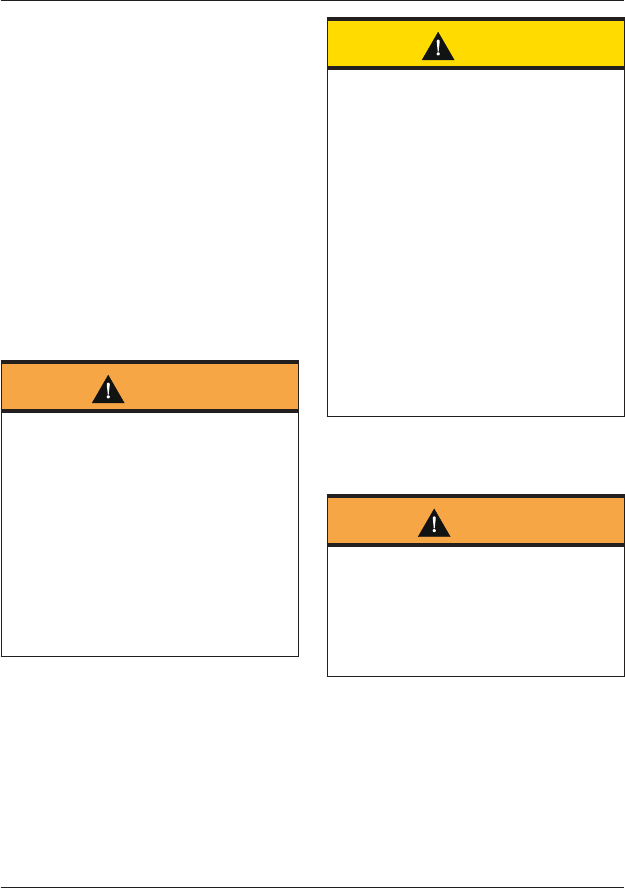
General Information
114
Tire Pressures
The tire pressures shown on your
instrument panel indicate the actual tire
pressure at the time of selecting the
display. This may differ from the
inflation pressure set when the tires are
cold because tires become warmer
during riding, causing the air in the tire
to expand and the inflation pressure to
increase. The cold inflation pressures
specified by Triumph take account of
this.
Only adjust tire pressures when the
tires are cold using an accurate tire
pressure gage (see page 189), and do
not use the tire pressure display on the
instruments.
Warning
The Tire Pressure Monitoring System
(TPMS) is not to be used as a tire
pressure gage when adjusting the tire
pressures. For correct tire pressures,
always check the tire pressures when
the tires are cold and using an
accurate tire pressure gage (see
page 189).
Use of the TPMS system to set
inflation pressures may lead to
incorrect tire pressures leading to loss
of motorcycle control and an accident.
Caution
Do not use anti puncture fluid or any
other item likely to obstruct air flow to
the TPMS sensor’s orifices. Any
blockage to the air pressure orifice of
the TPMS sensor during operation will
cause the sensor to become blocked,
causing irreparable damage to the
TPMS sensor assembly.
Damage caused by the use of anti
puncture fluid or incorrect
maintenance is not considered a
manufacturing defect and will not be
covered under warranty.
Always have your tires mounted by
your authorized Triumph dealer and
inform them that tire pressure sensors
installed on the wheel.
Low Tire Pressure
Warning
Stop the motorcycle if the tire pressure
warning light illuminates.
Do not ride the motorcycle until the
tires have been checked and the tire
pressures are at their recommended
pressure when cold.
If a low tire pressure is detected, the
tire pressure warning light will illuminate
and a message will be shown in the
display (see page 64 or page 30).
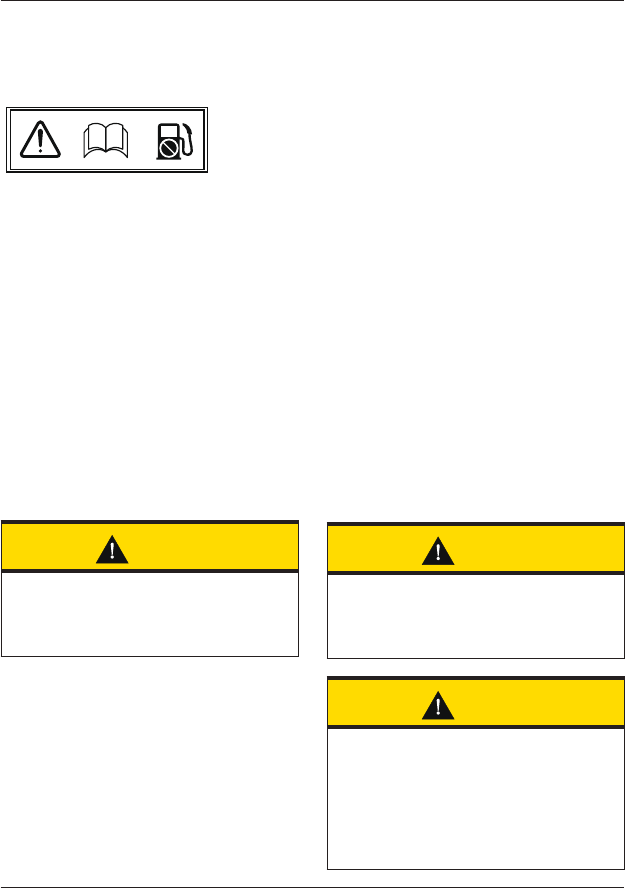
General Information
115
Fuel
Fuel Requirement/Refueling
P
b
cbny
Fuel Grade
These Triumph motorcycles are designed
to run on unleaded gasoline with a CLC
or AKI octane rating (R+M)/2 of 87 or
higher. Federal regulations require that
pumps delivering unleaded gasoline are
marked ‘UNLEADED’ and that the Cost of
Living Council (CLC) or Anti-Knock Index
(AKI) octane rating is also displayed.
These ratings are an average of the
Research Octane Number (RON) and the
Motor Octane Number (MON).
In certain circumstances engine
calibration may be required. Always
refer to your authorized Triumph dealer.
Caution
The use of leaded gasoline is illegal in
some countries, states or territories.
Check local regulations before using
leaded gasoline.
Note:
• If ‘knocking’ or ‘pinging’ occurs at a
steady engine speed under normal
load, use a different brand of
gasoline or gasoline which has a
higher octane rating.
Oxygenated Gasoline
To help in meeting clean air standards,
some areas of the U.S. use oxygenated
gasoline to help reduce harmful
emissions. These gasolines are a blend
of conventional gasoline and another
compound such as alcohol. This Triumph
motorcycle will give its best performance
when using unleaded gasoline. However,
the following should be used as a guide
if you use any oxygenated fuels.
Ethanol
Ethanol fuel is a mixture of 10% Ethanol
and 90% gasoline and is often described
under the names ‘gasohol’, ‘Ethanol
enhanced’, or ‘contains Ethanol’. This fuel
may be used in your Triumph motorcycle.
MTBE (Methyl Tertiary Butyl Ether)
The use of gasolines containing up to
15% MTBE (Methyl Tertiary Butyl Ether)
is permitted in this Triumph motorcycle.
Methanol
Caution
Fuels containing methanol should not
be used as damage to components in
the fuel system can be caused by
contact with methanol.
Caution
Because of the generally higher
volatility of oxygenated fuels, starting,
engine response and fuel consumption
may be adversely affected by their use.
Should any of these difficulties be
experienced, run the motorcycle on
normal unleaded gasoline.
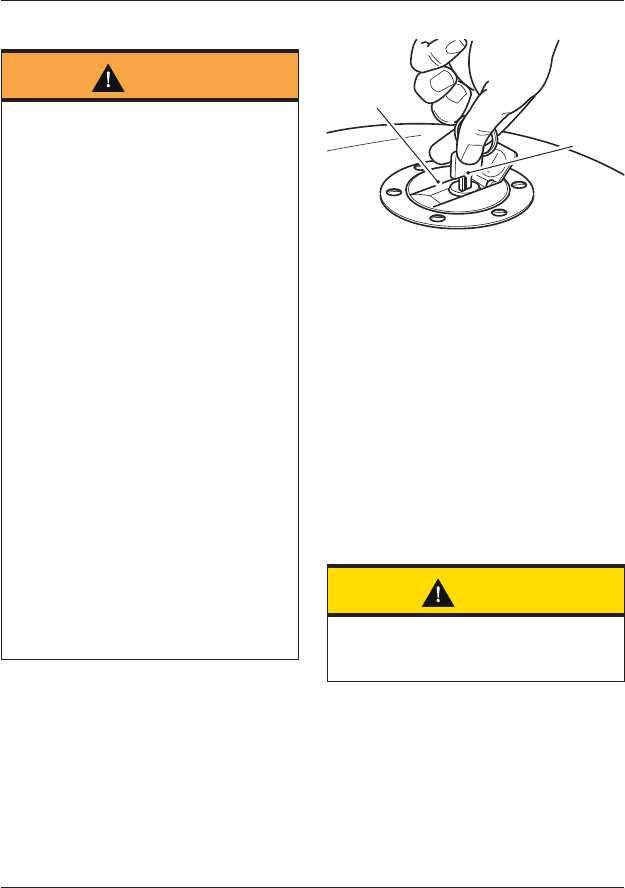
General Information
116
Refueling
Warning
To help reduce hazards associated with
refueling, always observe the following
fuel safety instructions:
Gasoline (fuel) is highly flammable and
can be explosive under certain
conditions. When refueling, turn the
ignition switch to the OFF position.
Do not smoke.
Do not use a mobile telephone.
Make sure the refueling area is well
ventilated and free from any source of
flame or sparks. This includes any
appliance with a pilot light.
Never fill the tank until the fuel level
rises into the filler neck. Heat from
sunlight or other sources may cause
the fuel to expand and overflow
creating a fire hazard.
After refueling always check that the
fuel filler cap is correctly closed.
Because gasoline (fuel) is highly
flammable, any fuel leak or spillage, or
any failure to observe the safety
advice given above will lead to a fire
hazard, which could cause damage to
property, injury to persons or death.
Fuel Tank Cap
cbmm_2
1
2
1. Fuel tank cap
2. Key
To open the fuel tank cap:
• Lift up the flap covering the lock
itself.
• Insert the key into the lock and
turn the key clockwise.
To close and lock the cap:
• Push the cap down into place with
the key inserted, until the lock
clicks into place.
• Remove the key and close the key
cover.
Caution
Closing the cap without the key
inserted will damage the cap, tank and
lock mechanism.
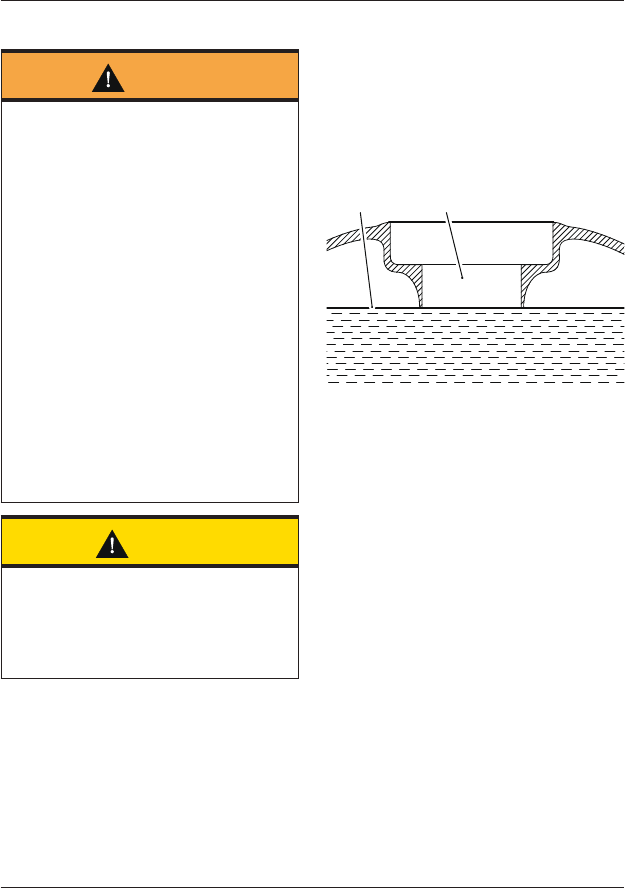
General Information
117
Filling the Fuel Tank
Warning
Overfilling the tank can lead to fuel
spillage.
If fuel is spilled, thoroughly clean up
the spillage immediately and dispose of
the materials used safely.
Take care not to spill any fuel on the
engine, exhaust pipes, tires or any
other part of the motorcycle.
Because fuel is highly flammable, any
fuel leak or spillage, or any failure to
observe the safety advice given above
may lead to a fire hazard, which could
cause damage to property and injury
or death to persons.
Fuel spilled near to, or onto the tires
will reduce the tires’ ability to grip the
road. This will result in a dangerous
riding condition potentially causing loss
of motorcycle control and an accident.
Caution
Avoid filling the tank in rainy or dusty
conditions where airborne material can
contaminate the fuel.
Contaminated fuel may cause damage
to fuel system components.
Fill the fuel tank slowly to help prevent
spillage. Do not fill the tank to a level
above the bottom of the filler neck. This
will make sure there is enough air space
to allow for fuel expansion if the fuel
inside the tank expands through
absorption of heat from the engine or
from direct sunlight.
cbnm
2
1
1. Fuel filler neck
2. Maximum fuel level
After refueling always check that the
fuel filler cap is correctly closed.
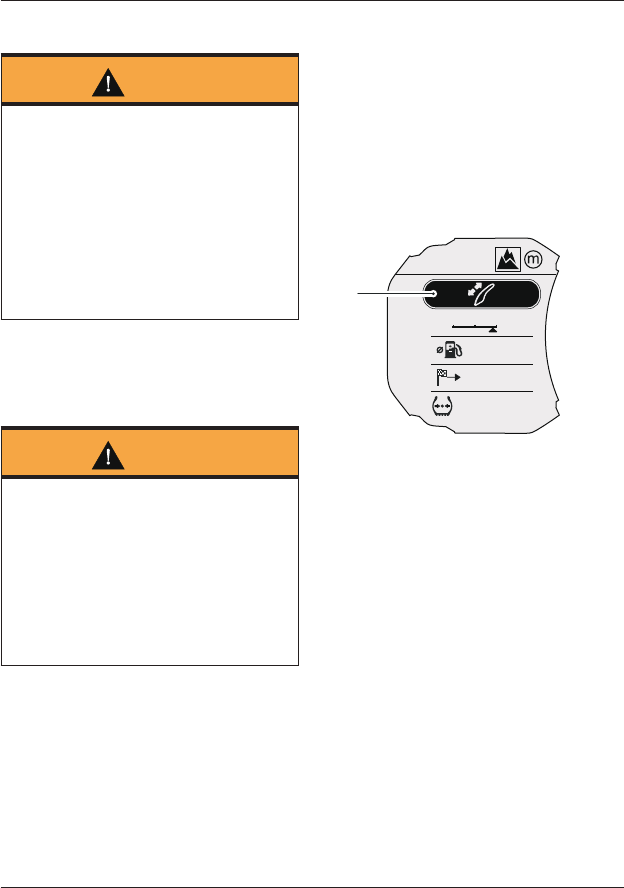
General Information
118
Windshield
Warning
Never attempt to clean the windshield
while riding the motorcycle.
Removal of the rider's hands from the
handlebars while riding the motorcycle
will diminish the ability of the rider to
maintain the control of the motorcycle.
Attempting to clean the windshield
while riding the motorcycle may result
in loss of motorcycle control and an
accident.
For windshield cleaning information, see
page 213.
Windshield Adjustment
Warning
Never place loose items of clothing,
fingers, hands or any other part of the
body near the windshield during
adjustment.
Personal injury may result from
trapping parts of the body or loose
items of clothing between the
windshield and the motorcycle
bodywork.
The windshield is adjusted electronically.
Tiger 1200 XR Only
To adjust the windshield:
• The ignition must be on.
Adjustment is possible with the
motorcycle stationary or in motion.
• To access the windshield
adjustment mode, from the home
screen, press the SCROLL button
until the windshield adjust display
is highlighted.
OFF-ROAD
AUTO
OFF-ROAD
MPG
MI
PSI
PSI
CNS
1
2
36
42
F
R
47
12
1
1. Windshield adjustment mode
• Press the SELECT button to
activate the windshield adjustment
mode.
• Use the SCROLL button to adjust
the windshield to the desired
height.
• There is a short time-out period to
allow for further adjustment to
take place before the instruments
automatically exit the windshield
adjustment mode.
•
Alternatively, press the SELECT
button to exit the windshield
adjustment mode.
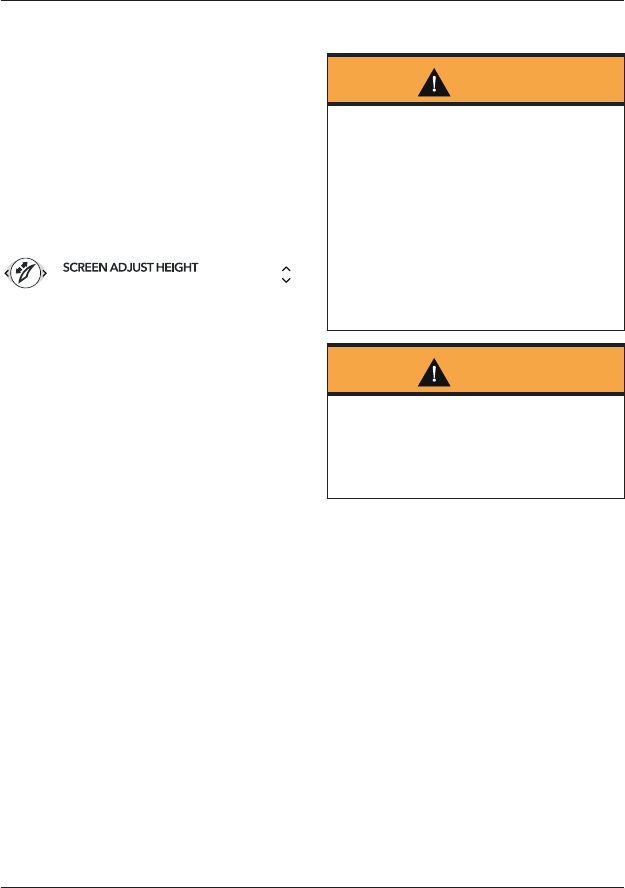
General Information
119
All Models except Tiger 1200 XR
To adjust the windshield height:
• The ignition must be on.
Adjustment is possible with the
motorcycle stationary or in motion.
• The windshield height can only be
adjusted from the information tray
at the bottom of the display screen.
• Push the joystick left/right until the
windshield adjust option is
highlighted.
Windshield Adjustment Mode
• Push the joystick up/down to
adjust the windshield to the
required height.
• Push the joystick left/right to
access another tray item.
Handlebar Adjustment
Warning
It is recommended to have handlebar
adjustments carried out by a trained
technician of an authorized Triumph
dealer.
Handlebar adjustments carried out by
a technician who is not of an
authorized Triumph dealer may affect
the handling, stability or other aspects
of the motorcycle’s operation which
may result in loss of motorcycle control
and an accident.
Warning
Before starting work, make sure that
the motorcycle is stabilized and
adequately supported. This will help
prevent injury to the operator or
damage to the motorcycle.
Note:
• This procedure assumes the
handlebars are in the standard
position, as delivered from the
factory. If the handlebars have
already been adjusted as described
below, the bolt positions will be
reversed.
The handlebars are adjustable for reach
by approximately 0.78 in (20 mm).
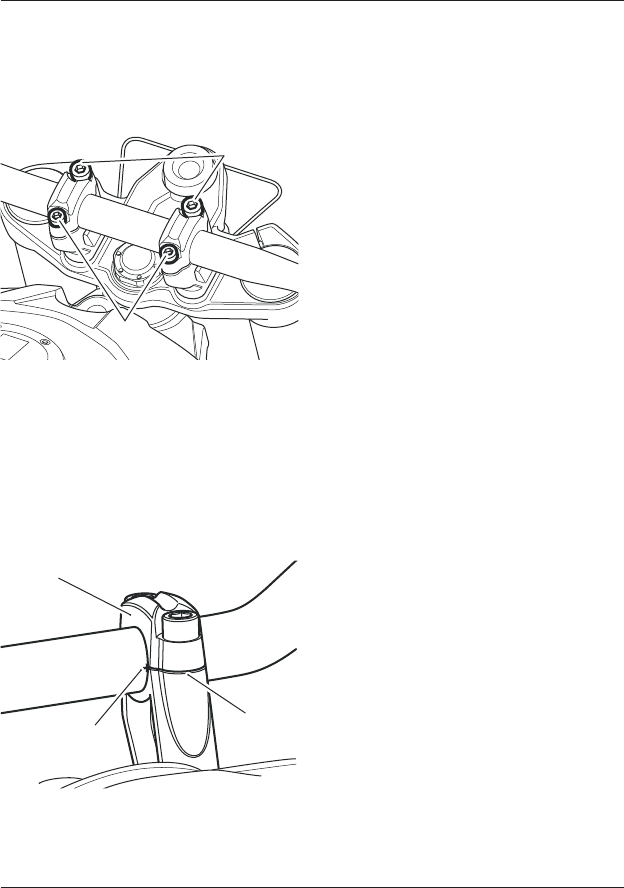
General Information
120
To adjust the handlebars:
• Loosen and remove the handlebar
rear (0.31 in (8 mm) threaded) clamp
bolts, and then the front (0.39 in
(10 mm) threaded) clamp and riser
bolts.
2
1
chiv_3
1. 0.39 in (10 mm) bolts
2. 0.31 in (8 mm) bolts
• Lift the handlebars out of the
handlebar risers and support with
the aid of an assistant.
• Rotate both risers through 180°
and align the bolt holes.
• Reposition the handlebars to the
risers.
2
3
1
chiu_2
1. Upper clamp, left hand
2. Clamp split line, front
3. Handlebar alignment mark
• Reinstall the upper clamps, and
secure with the two 0.39 in (10 mm)
threaded bolts in the rear bolt
positions. Do not fully tighten the
bolts at this stage.
• Rotate the handlebar so that the
alignment marking on the
handlebar aligns with the front left
hand split line of the clamp riser.
• Tighten the 0.39 in (10 mm) bolts to
26 lbf ft (35 Nm).
• Reinstall the 0.31 in (8 mm) bolts to
the front positions and tighten to
19 lbf ft (26 Nm).
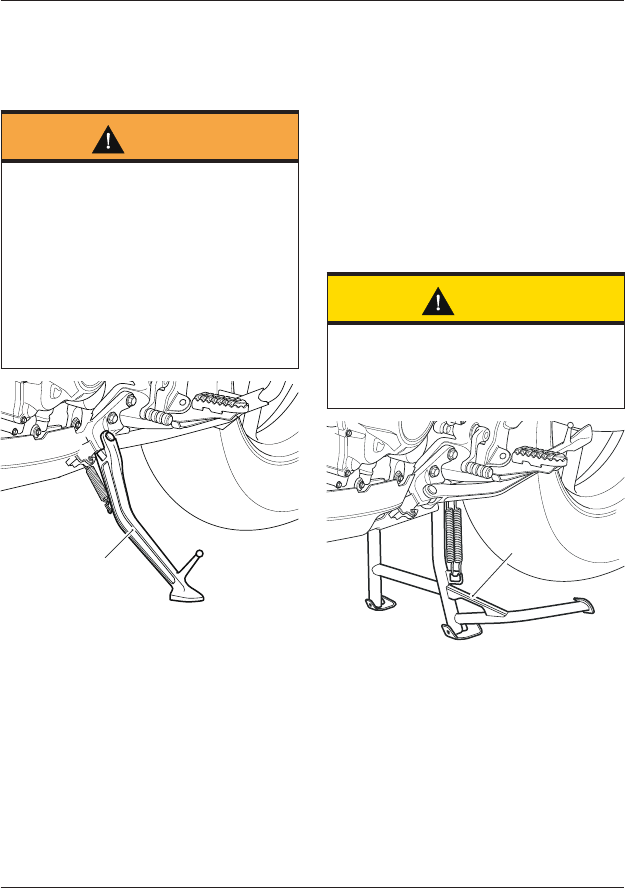
General Information
121
Stands
Side Stand
Warning
The motorcycle is equipped with an
interlock system to prevent it from
being ridden with the side stand in the
down position.
Never attempt to ride with the side
stand down or interfere with the
interlock mechanism as this will cause
a dangerous riding condition leading to
loss of motorcycle control and an
accident.
1
chde 2
1. Side stand
The motorcycle is equipped with a side
stand on which the motorcycle can be
parked.
Before riding, always make sure that the
side stand is fully up after first sitting
on the motorcycle.
Note:
• When using the side stand, always
turn the handlebars fully to the left
and leave the motorcycle in first
gear.
For instructions on safe parking, refer
to the How to Ride the Motorcycle
section.
Center Stand (if equipped)
Caution
Do not use body panels or the seat as
a hand-hold when placing the
motorcycle on the center stand as this
will cause damage.
1
chdf_1
1. Center stand
To set the motorcycle on the center
stand, step down firmly on the foot
finder part of the stand, then lift the
motorcycle up and to the rear using the
rear rack as a handhold.
For instructions on safe parking, refer
to the How to Ride the Motorcycle
section.
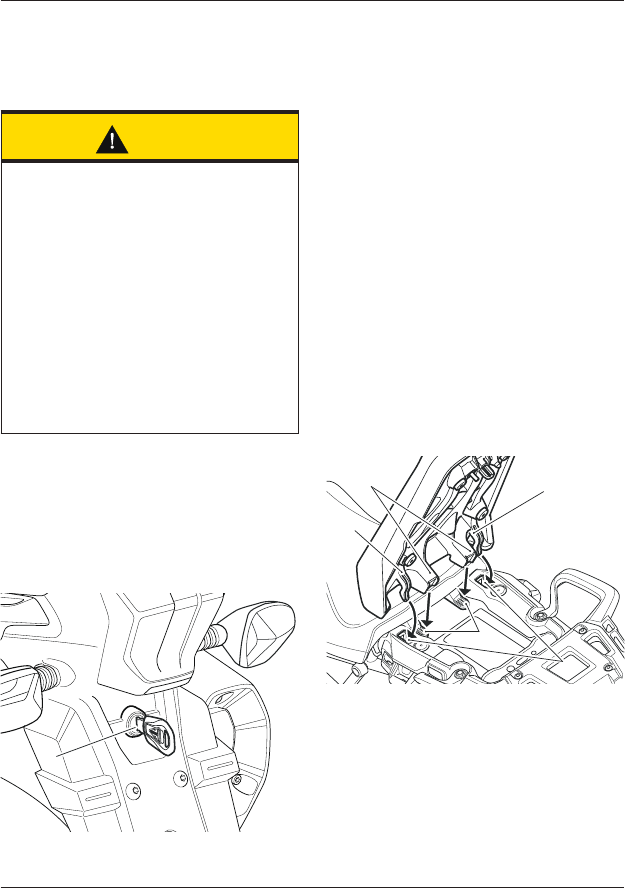
General Information
122
Seats
Seat Care
Caution
To prevent damage to the seat or seat
cover, care must be taken not to drop
the seat.
Do not lean the seat against the
motorcycle or any surface which may
damage the seat or seat cover.
Instead, place the seat, with the seat
cover facing upwards, on a clean, flat
surface which is covered with a soft
cloth.
Do not place any item on the seat
which may cause damage or staining
to the seat cover.
For seat cleaning information, see
page 212.
Passenger Seat
The seat lock is located on the rear
fender, below the brake/tail light unit.
1
1. Seat lock
To remove the seat:
• Insert the ignition key into the seat
lock and turn it counterclockwise
while pressing down on the rear of
the seat. This will release the seat
from its lock and allow it to be slid
rearwards.
• If equipped with heated seats,
disconnect the heated seat’s
electrical connector for complete
removal from the motorcycle.
To re-install the seat:
• Reconnect the heated seat’s
electrical connector (if equipped),
engage the seat's two outer
brackets under the loops on the
subframe and the two inner
brackets to brackets on the rider's
seat.
• Gently push the seat forwards and
press down at the rear to engage
in the seat lock.
1
2
31
4
1. Passenger seat outer brackets
2. Subframe loops
3. Passenger seat inner brackets
4. Rider seat brackets
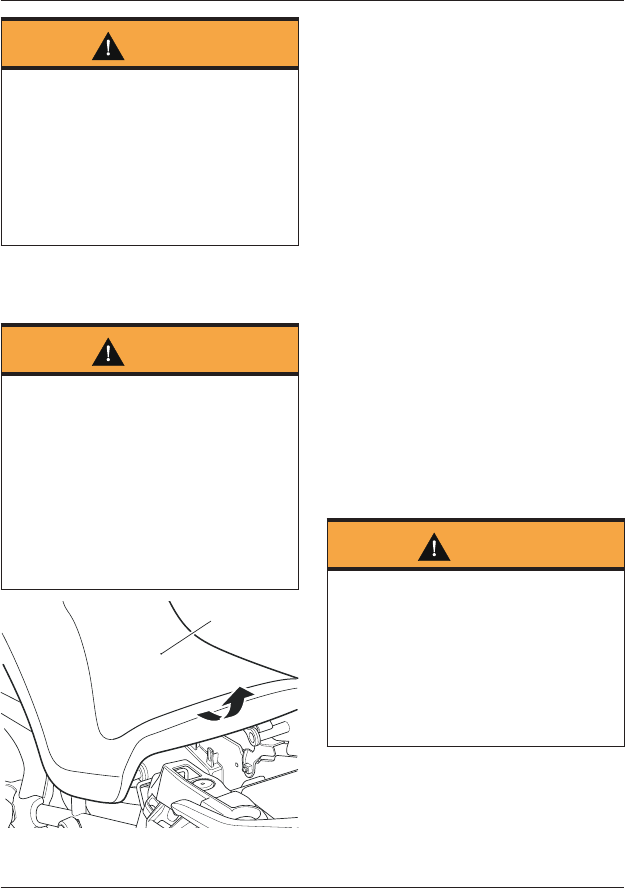
General Information
123
Warning
To prevent detachment of the seat
during riding, after installation always
grasp the seat and pull firmly upwards.
If the seat is not correctly secured, it
will detach from the lock.
A loose or detached seat could cause
loss of motorcycle control and an
accident.
Rider's Seat
Warning
The rider’s seat is only correctly
retained and supported once the
passenger seat is correctly mounted.
Never ride the motorcycle with the
passenger seat detached or removed,
as the front seat will not be secured
and may move.
A loose or detached seat could cause
loss of motorcycle control and an
accident.
1
1. Rider’s seat
To remove the rider’s seat:
• Remove the passenger seat (see
page 122).
• Grasp the rider’s seat on either
side, and slide it rearwards and
upwards.
• If equipped with heated seats,
disconnect the heated seat’s
electrical connector for complete
removal from the motorcycle.
To re-install the seat:
• Reconnect the heated seat’s
electrical connector (if equipped).
• Engage the seat's front rail into the
bracket at the rear of the fuel tank
and lower the rear rail into the rear
brackets.
• Push down firmly on the rear of the
seat.
• Reinstall the passenger seat (see
page 122).
Rider’s Seat Height Adjustment
Warning
Always adjust both seat height
adjusters.
Adjusting only one height adjuster may
prevent correct installation of the seat.
Riding the motorcycle with an
incorrectly mounted seat may cause
loss of motorcycle control and an
accident.
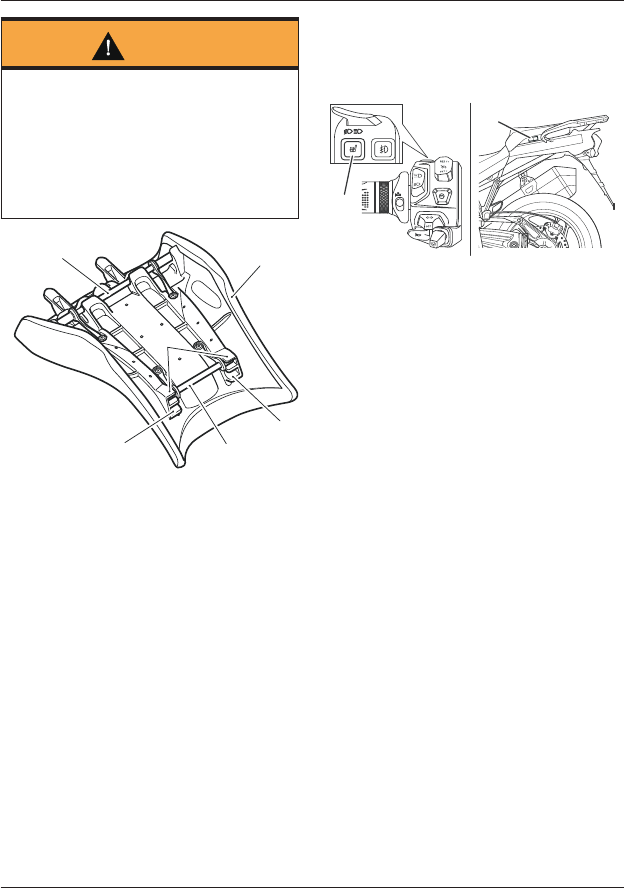
General Information
124
Warning
After adjusting the seat, operate the
motorcycle in an area free from traffic
to gain familiarity with the new seat
position.
Riding the motorcycle with the seat in
an unfamiliar position may cause loss
of motorcycle control and an accident.
4
4
2
5
31
chdi_2
1. Rider’s seat
2. Front height adjuster
3. Rear height adjuster
4. Low seat height position (front shown)
5. High seat height position (front shown)
The rider’s seat is adjustable for height
by approximately 0.78 in (20 mm).
To adjust the rider’s seat:
• Remove the rider’s seat (see
page 123).
• Reposition both seat height
adjusters to the higher or lower
position as required. Make sure
that both adjuster rails are fully
engaged in their brackets on the
seat.
• Reinstall the rider’s seat (see
page 123).
Heated Seats (if equipped)
The heated seats switches (if equipped)
are located on the left hand side of the
motorcycle.
1
2
1. Rider’s heated seat switch location
2. Passenger’s heated seat switch
location
The heated seats will only heat when
the engine is running. When the heated
seats are switched on, the heated seats
symbol will appear in the display. The
selected heat level for each seat will
also be indicated by the color of the
symbol.
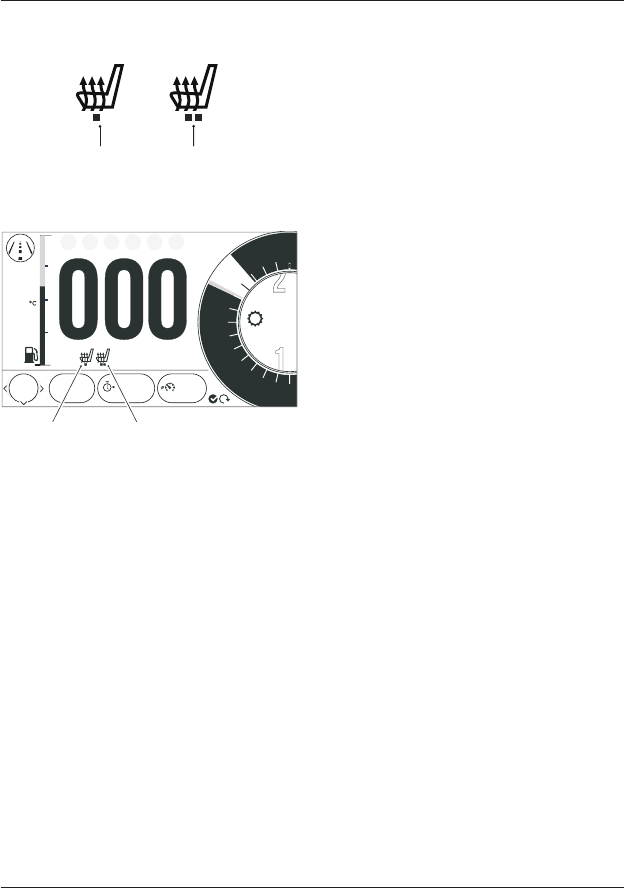
General Information
125
There are two levels of heat: low and
high.
1 2
1. Low heat symbol (amber)
2. High heat symbol (red)
o7:29
12.5
19999 02:25
8
6
4
2
0
12 14
25.2
F
E
TRIP
mi mp/hHH:MM
PM
RPM
x1000
10
1
N
2
1. Rider’s heated seat (low heat selected)
2. Passenger’s heated seat (high heat
selected)
Rider Heated Seat
• For maximum benefit in cold
conditions, from the OFF position
press the rider heated seat switch
once for the high heat setting
initially, and then reduce the heat
level by pressing the rider heated
seat switch again for the low heat
setting when the seat has warmed
up.
• To turn the rider heated seat off,
press and release the rider heated
seat switch until the heated seats
symbol is no longer shown in the
display.
Passenger Heated Seat
• For maximum benefit in cold
conditions, switch the passenger
heated seat switch to the high heat
setting initially and then reduce the
heat level by switching the
passenger heated seat switch to
the low heat setting when the
passenger seat has warmed up.
• To turn the passenger heated seat
off, move the switch to its central
position. After a short delay, the
passenger heated seat symbol will
no longer be shown in the display.
Low Power Voltage Cut Off
If a low voltage is detected the heated
seats switches will power off. The
heated seats will not function again
until the voltage rises to a safe level.
The switches will not power back on
automatically even if the voltage rises to
the safe level. The ignition must be
switched off then on again to activate
the heated seats.
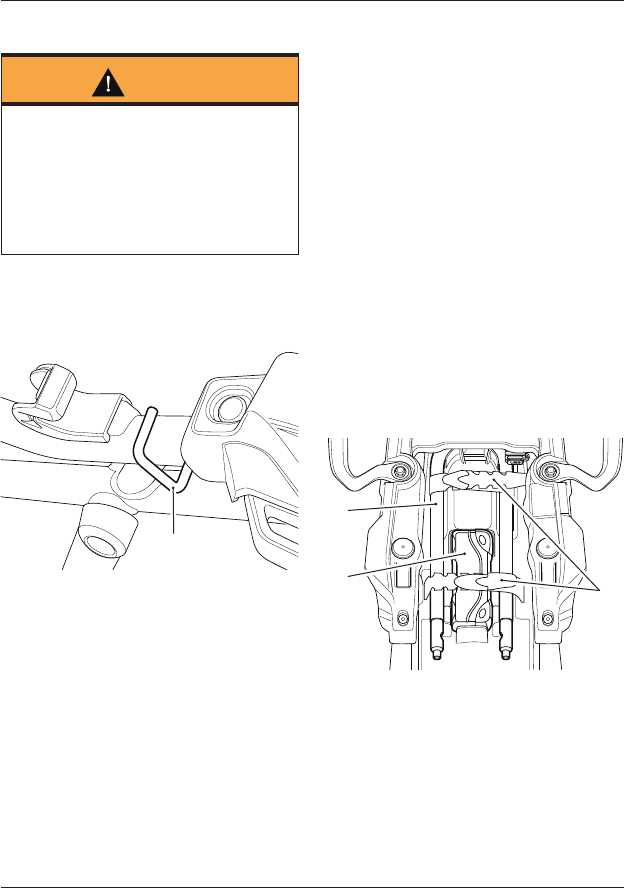
General Information
126
Helmet Hook
Warning
Never ride the motorcycle with
helmet(s) secured to the helmet hook.
Riding the motorcycle with helmet(s)
secured to the helmet hook may cause
the motorcycle to become unstable
leading to loss of motorcycle control
and an accident.
A helmet can be secured to the
motorcycle using the helmet hook
located on the left hand side of the
motorcycle, beneath the rider's seat.
ciuw
1
1. Helmet hook
To attach a helmet to the motorcycle:
•
Remove the rider's seat (see
page 123) and loop the helmet chin
strap over the hook.
• To secure the helmet, reinstall the
seat and lock into position (see
page 123).
Tool Kit, Handbook and the
Triumph Accessory D-Lock
The tool kit and handbook are located
beneath the passenger seat.
Space is provided under the passenger
seat to store a Triumph accessory
D-lock (available from your Triumph
dealer).
To secure the lock:
• Remove the passenger seat (see
page 122).
• Release the straps and remove the
handbook and tool kit.
• Position the U-section of the lock
to the rear fender tray support
features, making sure that the
open end faces towards the front
of the motorcycle.
• Position the lock body into the rear
fender tray as shown below.
cjhl
2
1
3
1. Lock U-section
2. Lock body
3. Straps
• Mount the tool kit and handbook
above the D-lock and secure using
the tool kit straps.
• Reinstall the passenger seat (see
page 122).
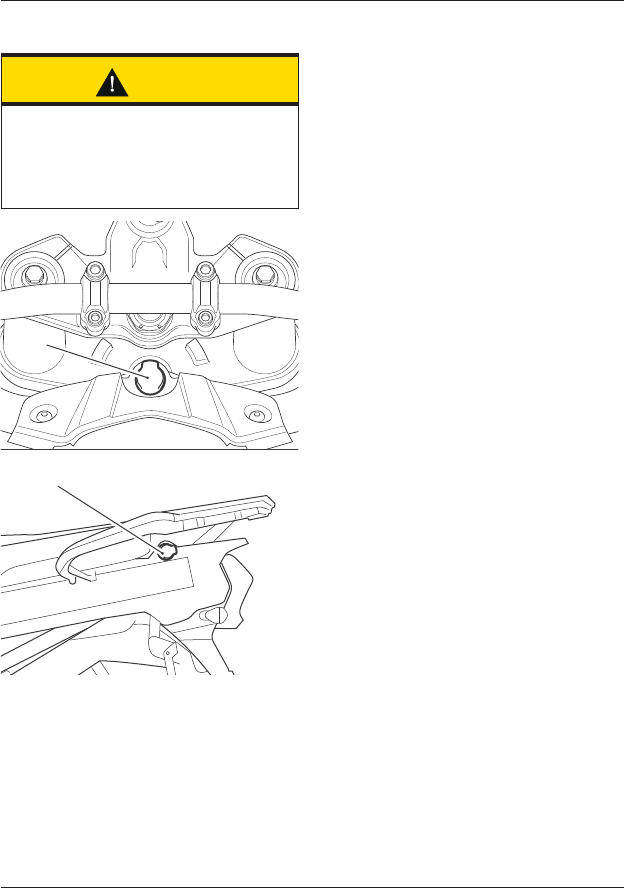
General Information
127
Electrical Accessory Sockets
Caution
Do not leave electrical accessories
connected to the front electrical
accessory socket when the engine is
not running as this will discharge the
battery.
1
2
1. Front electrical accessory socket
2. Rear electrical accessory socket
(if equipped)
All Models
An electrical accessory socket is
provided on the motorcycle, located in
front of the fuel tank.
The socket will provide a 12 Volt
electrical supply and is permanently live.
Fuse number seven protects the front
electrical accessory socket circuit, refer
to the label in the fuse box lid for fuse
amperage.
All Models Except Tiger 1200 XR
An additional electrical accessory socket
is provided, located on the left side,
towards the rear of the motorcycle.
The additional electrical accessory
socket is available for Tiger 1200 XR
models as an accessory kit from your
authorized Triumph dealer.
The socket will provide a 12 Volt
electrical supply and is live when the
engine is running.
The rear electrical accessory socket is
protected by a chassis ECM, which will
automatically cut power to the socket in
the event of an overload.
Power can be restored to the rear
electrical accessory socket by turning
the ignition switch off then on again,
provided that the socket is not still
overloaded.
Note:
• To protect the battery from
excessive discharge while using
mounted electrical accessories, the
combined total current which may
be drawn through the electrical
accessory sockets is five Amps.
• A plug, suitable for use with the
accessory socket, is available from
your authorized Triumph dealer.
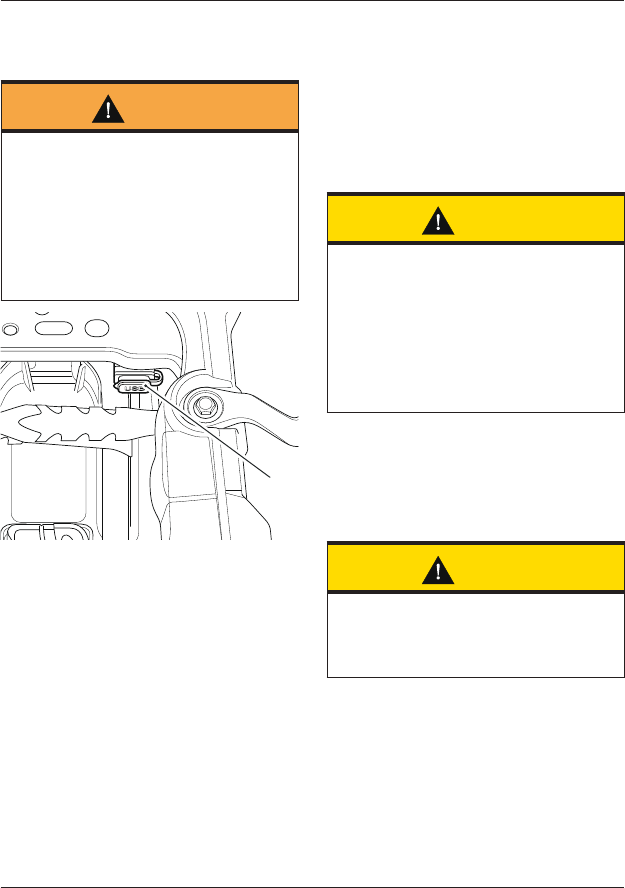
General Information
128
Universal Serial Bus (USB)
Socket
Warning
The USB socket is not waterproof
unless the waterproof cap is installed.
Do not connect electronic devices while
it is raining.
Water in the USB socket could lead to
an electrical problem, resulting in
motorcycle damage, loss of motorcycle
control and an accident.
cjhl_1
1
1. USB socket
A Universal Serial Bus (USB) socket is
provided, located under the passenger
seat. The connector provides a 5 Volt, 2
Amp power supply which is suitable for
charging electronic devices such as
mobile phones, cameras and GPS
devices.
To access the USB socket:
• Remove the passenger seat.
• Remove the cap from the USB
socket.
• Connect your device using a
suitable USB cable, then stow the
device and USB cable in the space
available under the passenger seat.
Caution
Make sure that all electronic devices
and cables are safely secured under
the seat when riding.
Make sure there is sufficient space
surrounding any electronic devices for
the seat to close without causing any
damage to the electronic device or the
motorcycle.
• Install the passenger seat, making
sure that the device or USB cable is
not trapped.
• Turn the ignition on and start the
engine.
Caution
Do not leave the ignition switch in the
ON position unless the engine is
running as this will discharge the
battery.
• When your device has finished
charging, remove the passenger
seat and disconnect the device.
• Reinstall the USB socket cap and
reinstall the passenger seat.
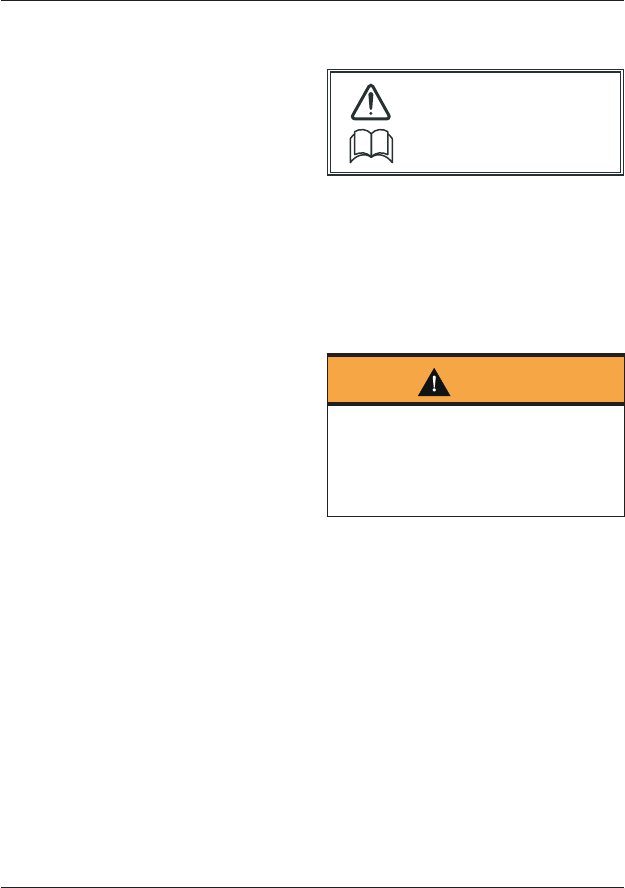
General Information
129
Note:
• The USB socket is protected by a
chassis ECM, which will
automatically cut power to the
socket in the event of an overload.
• Power can be restored to the USB
socket by turning the ignition
switch off then on again, provided
that the socket is not still
overloaded.
Expedition Aluminum
Panniers (if equipped)
MAX LOAD
5 kg (11 lbs)
The Expedition Aluminum Panniers and
mounting rails are available as an
accessory option.
For more details on the Expedition
Aluminum Panniers and all other
luggage solutions available, contact your
authorized Triumph dealer or visit www.
triumph.co.uk.
Warning
Do not move or lift the motorcycle by
using any part of the panniers,
mounting rails or luggage system.
Damage to the motorcycle and/or
personal injury may occur.
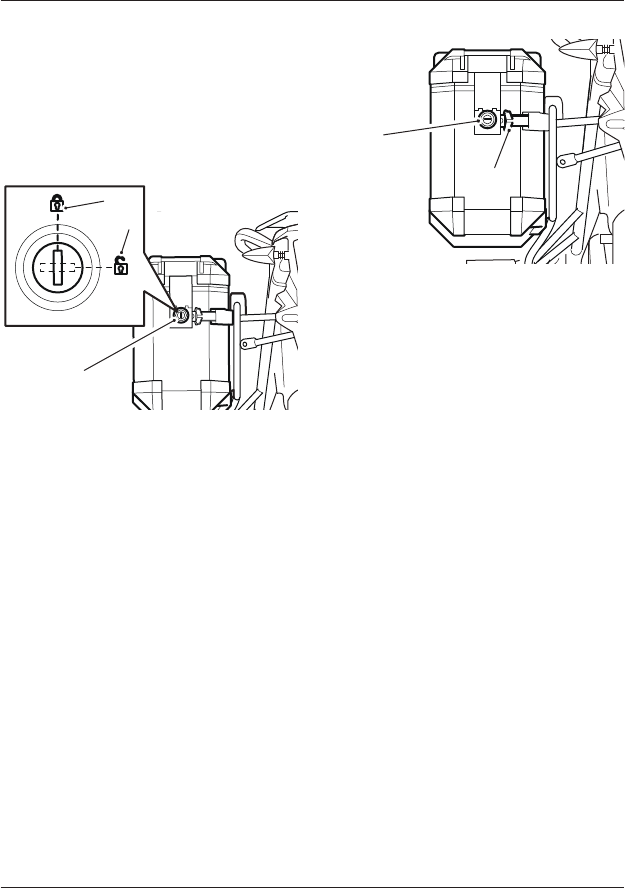
General Information
130
Note:
• The same procedure can be
followed to remove and mount the
left hand or the right hand
panniers.
• The pannier lock barrel has two
positions as shown.
2
3
1
1. Lock barrel
2. Lock position
3. Unlock position
To Remove Each Pannier:
2
1
1. Lock (left hand pannier shown)
2. Locking mechanism release lever
To unlock and remove the pannier from
the pannier mountings:
• Turn the key to the UNLOCK
position.
• While supporting the pannier, pull
the locking mechanism release
lever to detach the pannier from
the upper mounting points.
• Lift the pannier free from the lower
mounting points.
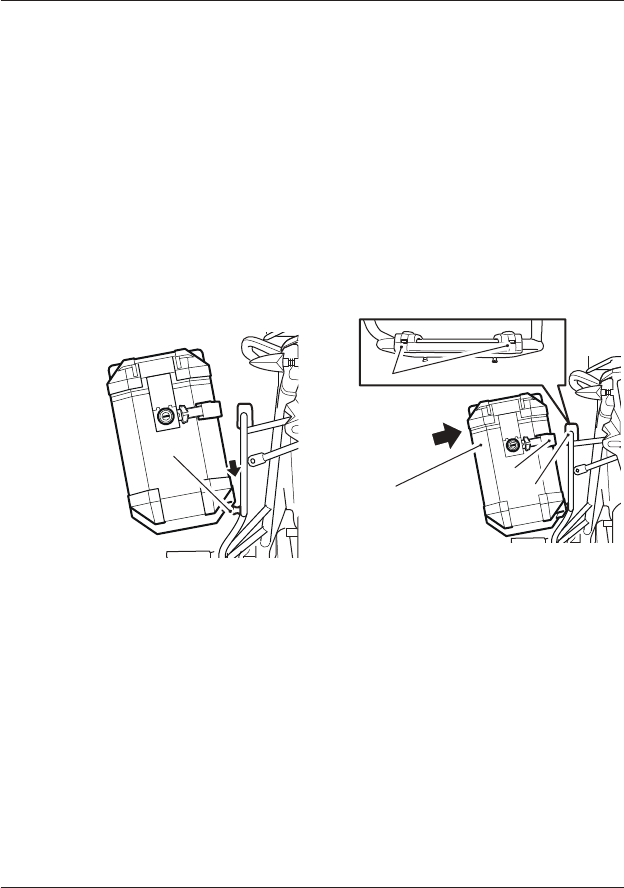
General Information
131
To Install Each Pannier
• Insert the key into the lock.
• Turn the key to the UNLOCK
position.
Note:
• The left hand and right hand
panniers must be mounted to the
correct side of the motorcycle.
When mounting the panniers, make
sure that the lock barrels are facing
towards the rear of the motorcycle.
• Position the pannier onto the lower
pannier mounting points as shown
below.
1
1. Lower pannier mounting point
• Position the pannier’s locking
mechanism onto the upper
mounting points.
• Press the pannier inwards to
engage the locking mechanism.
Note:
• An audible click can be heard when
the pannier’s upper mounting
locking mechanism is engaged.
• Two status indicators are also
provided on the top of the upper
mounting point. The status
indicators will change color from
red to green when the locking
mechanism is correctly engaged.
• If the status indicators remain red,
the upper mounting locking
mechanism is not correctly
engaged.
2
1
4
3
1. Pannier
2. Upper mounting point
3. Locking mechanism
4. Status indicators
• Lock the pannier to the rail by
turning the key to the LOCK
position.
• Remove the key.
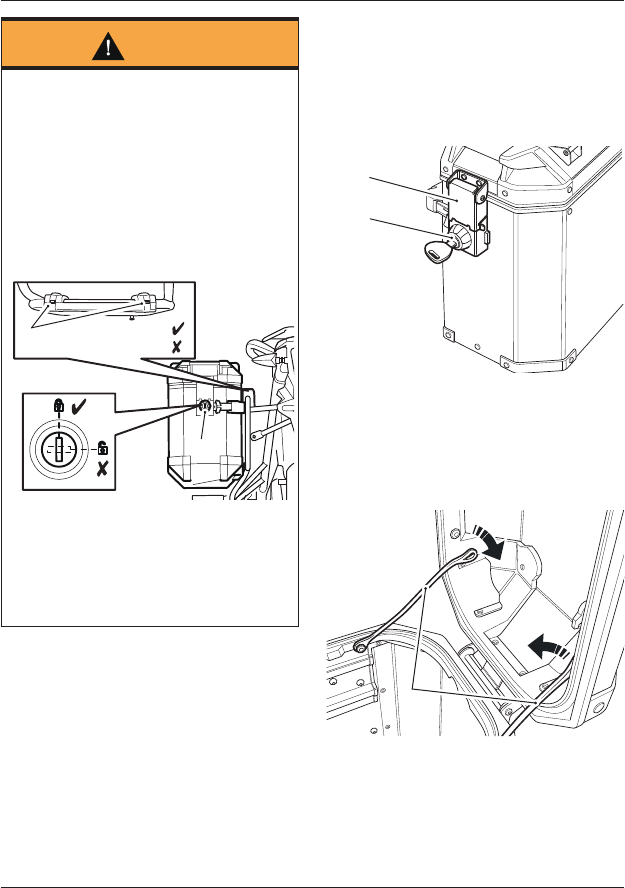
General Information
132
Warning
An incorrectly mounted pannier may
detach while riding, resulting in a
dangerous riding condition.
Before riding, always make sure that
both panniers are mounted correctly.
Make sure that the status indicators
located on the top of the pannier’s
upper mounting points are green and
that the lock barrel is turned to the
LOCK position and the key removed.
1
2
1. Locking mechanism status indicators
2. Lock barrel
A pannier that detaches while riding
may cause loss of motorcycle control
and an accident.
Pannier Operation
To unlock and open the pannier:
• Insert the key and turn it to the
UNLOCK position.
• Release the pannier lid latch. The
lid can then be opened.
cisb_2
1
2
1. Lock barrel - UNLOCK position
2. Pannier lid latch
• The lid can also be removed from
the pannier. To remove the lid,
detach the retaining straps as
shown below.
cisd_1
1
1. Retaining straps
• Press downwards on the quick
release mechanism for the pannier
lid hinge.
• Slide the lid down and to the rear
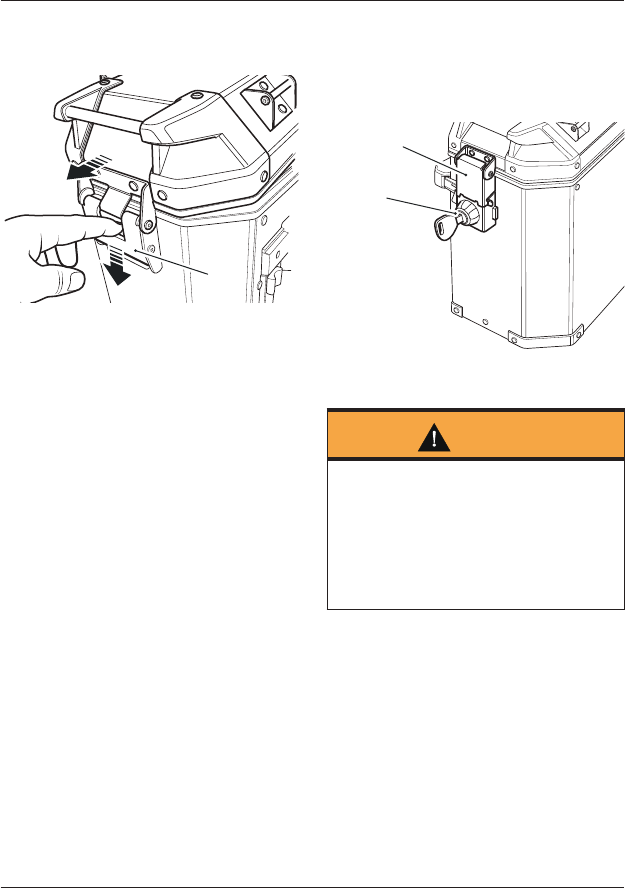
General Information
133
to release the pannier lid hinge. The
lid can now be removed from the
pannier.
cise_1
1
1. Pannier lid hinge quick release
mechanism
To install the pannier lid:
• Press downwards on the quick
release mechanism and relocate
the pannier lid hinge.
• Release the quick release
mechanism, making sure that the
hinge is correctly engaged.
• Attach the retaining straps to the
pannier lid.
To close and lock the pannier:
• Close the lid and secure with the
pannier lid latch.
• Turn the key to the LOCK position
and remove it.
cisb_4
1
2
1. Lock barrel - LOCK position
2. Pannier lid latch
Warning
The maximum safe load for each
pannier is stated on a label inside the
pannier.
Never exceed this loading limit as this
may cause the motorcycle to become
unstable leading to loss of motorcycle
control and an accident.
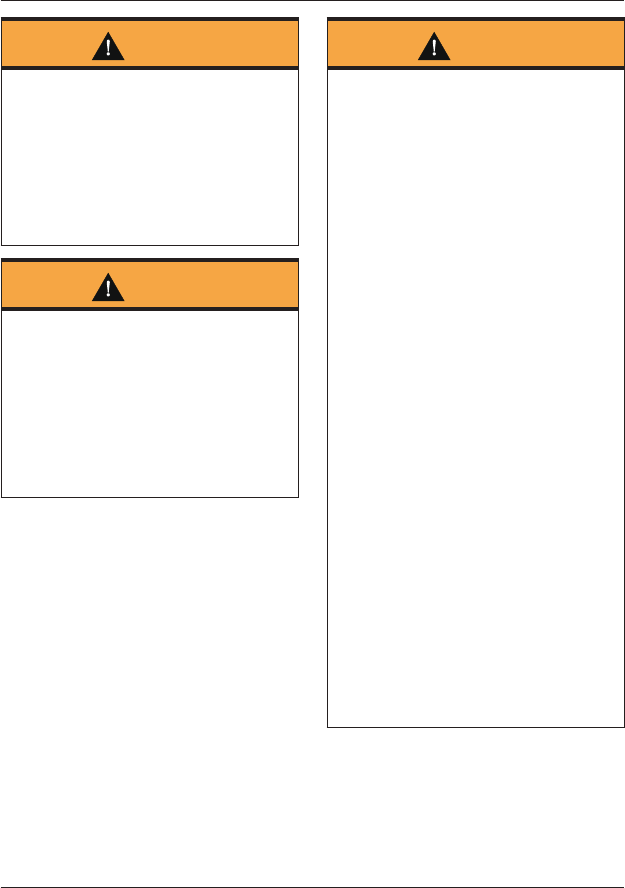
General Information
134
Warning
The Expedition Aluminum Panniers are
designed to be mounted as a pair.
Never ride the motorcycle with only
one pannier installed.
Riding the motorcycle with one pannier
installed may cause the motorcycle to
become unstable leading to loss of
motorcycle control and an accident.
Warning
After mounting or removing the
panniers, operate the motorcycle in a
safe area free from traffic to gain
familiarity with the new handling
characteristics.
Operation when not familiar with the
new characteristics of the motorcycle
may result in loss of motorcycle control
and an accident.
Warning
Incorrect loading may result in an
unsafe riding condition leading to loss
of motorcycle control and an accident.
Always make sure that any loads
carried are evenly distributed on both
sides of the motorcycle. Make sure
that the load is correctly secured such
that it will not move around while the
motorcycle is in motion.
Evenly distribute the load within each
pannier. Pack heavy items at the
bottom and on the inboard side of the
pannier.
Always check the load security
regularly (though not while the
motorcycle is in motion) and make sure
that the load does not extend beyond
the rear of the motorcycle. Never
exceed the maximum vehicle loading
weight of:
Tiger 1200 XR - 507 lb (230 kg)
Tiger 1200 XRx - 502 lb (228 kg)
Tiger 1200 XRx-LRH - 507 lb (230 kg)
Tiger 1200 XRT - 502 lb (228 kg)
Tiger 1200 XCx - 491 lb (223 kg)
Tiger 1200 XCA - 493 lb (224 kg).
This maximum loading weight is made
up from the combined weight of the
rider, passenger, any accessories
installed and any load carried.
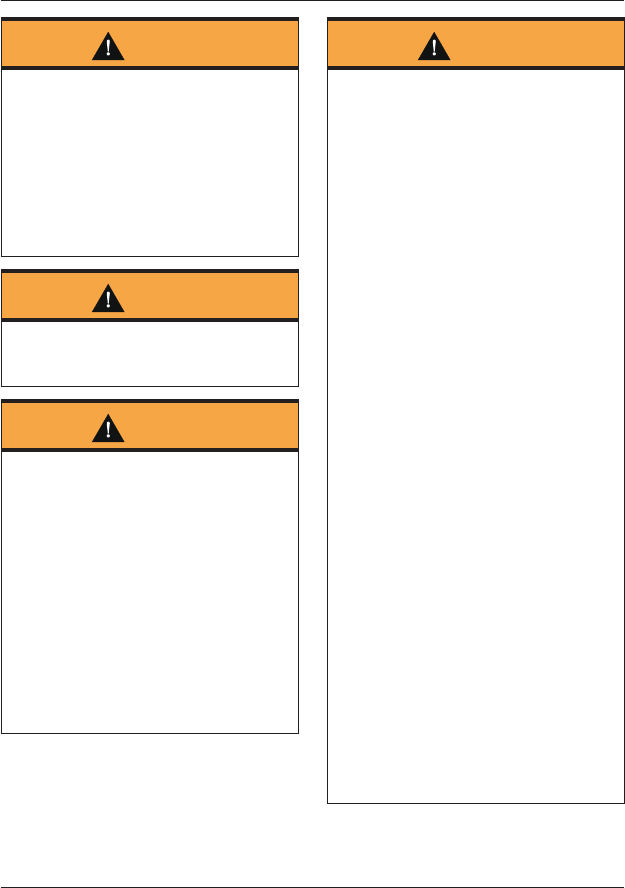
General Information
135
Warning
For models that have manually
adjustable suspension, make sure that
front and rear spring preload and
damping settings are suitable for the
loading condition of the motorcycle
(see page 185).
Note the maximum permissible payload
for the panniers is stated on a label
inside the pannier.
Warning
This motorcycle must not be operated
above the legal road speed limit except
in authorized closed-course conditions.
Warning
Only operate this Triumph motorcycle
at high speed in closed-course on-road
competition or on closed-course
racetracks. High-speed operation
should only be attempted by riders
who have been instructed in the
techniques necessary for high-speed
riding and are familiar with the
motorcycle's characteristics in all
conditions.
High-speed operation in any other
circumstances is dangerous and will
lead to loss of motorcycle control and
an accident.
Warning
Never ride an accessory-equipped
motorcycle, or a motorcycle carrying a
payload of any kind, at speeds above
80 mph (130 km/h). In either/both of
these conditions, speeds in excess of
80 mph (130 km/h) should not be
attempted even where the legal speed
limit permits this.
The presence of accessories and/or
payload will cause changes in the
stability and handling of the motorcycle.
Failure to allow for changes in
motorcycle stability may lead to loss of
motorcycle control and an accident.
When riding at high speed, always be
aware that various motorcycle configu-
ration and environmental factors can
adversely affect the stability of your
motorcycle. For example:
• Incorrectly balanced loads on both
sides of the motorcycle.
• Incorrectly adjusted front and rear
suspension settings.
• Incorrectly adjusted tire pressures.
• Excessively or unevenly worn tires.
• Side winds and turbulence from other
vehicles.
• Loose clothing.
Remember that the 80 mph (130 km/h)
absolute limit will reduce by the instal-
lation of non-approved accessories,
incorrect loading, worn tires, overall
motorcycle condition and poor road or
weather conditions.

General Information
136
Breaking-In
R.P.M.
cboa
Breaking-in is the name given to the
process that occurs during the first
hours of a new vehicle's operation.
In particular, internal friction in the
engine will be higher when components
are new. Later on, when continued
operation of the engine has ensured
that the components have 'bedded in',
this internal friction will be greatly
reduced.
A period of careful breaking-in will
ensure lower exhaust emissions, and
will optimize performance, fuel economy
and longevity of the engine and other
motorcycle components.
During the first 500 miles (800 km):
• Do not use full throttle;
• Avoid high engine speeds at all
times;
• Avoid riding at one constant engine
speed, whether fast or slow, for a
long period of time;
• Avoid aggressive starts, stops, and
rapid accelerations, except in an
emergency;
• Do not ride at speeds greater than
3/4 of maximum speed.
From 500 to 1,000 miles (800 to 1,500 km):
• Engine speed can gradually be
increased to the rev limit for short
periods.
Both during and after breaking-in has
been completed:
• Do not overrev the engine when
cold;
• Do not lug the engine. Always
downshift before the engine begins
to 'struggle';
• Do not ride with engine speeds
unnecessarily high. Shifting up a
gear helps reduce fuel consumption,
reduces noise and helps to protect
the environment.
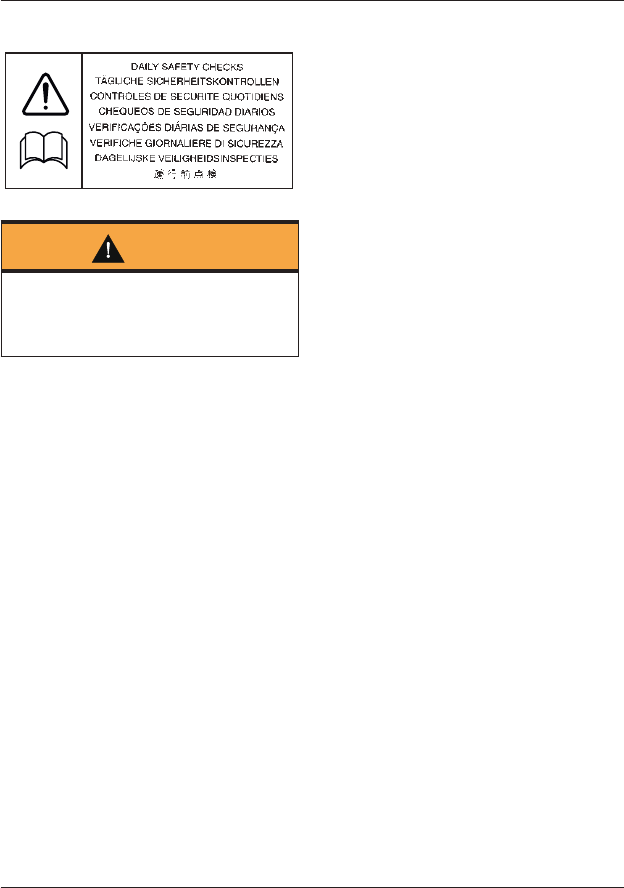
General Information
137
Daily Safety Checks
cboc
Warning
Failure to perform these checks every
day before you ride may result in seri-
ous motorcycle damage or an accident
causing serious injury or death.
Check the following items each day
before you ride. The time required is
minimal, and these checks will help make
sure you have a safe, reliable ride.
If any irregularities are found during
these checks, refer to the Maintenance
and Adjustment section or see your
authorized Triumph dealer for the action
required to return the motorcycle to a
safe operating condition.
Check:
Fuel: Adequate supply in tank, no fuel
leaks (see page 115).
Engine Oil: Correct level visible at sight
glass. Add correct specification oil as
required. No leaks from the engine or oil
cooler (see page 169).
Final Drive: No oil leaks (see page 176).
Tires/Wheels: Correct inflation pressures
(when cold). Tread depth/wear, tire/wheel
damage, punctures etc. (see page 188).
Nuts, Bolts, Fasteners: Visually check
that steering and suspension
components, axles, and all controls are
properly tightened or fastened. Inspect
all areas for loose/damaged fasteners.
Steering Action: Smooth but not loose
from lock to lock. No binding of any of
the control cables (see page 182).
Brakes: Pull the brake lever and push
the brake pedal to check for correct
resistance. Investigate any lever/pedal
where the travel is excessive before
meeting resistance, or if either control
feels spongy in operation (see page 177).
ABS: Make sure that the ABS warning
light does not remain illuminated at
speeds above 6 mph (10 km/h) when
moving off (see page 149).

General Information
138
Brake Pads: There should be more than
0.06 in (1.5 mm) of friction material
remaining on all the pads (see page 177).
Brake Fluid Levels: No brake and clutch
fluid leakage. Brake fluid levels must be
between the MAX and MIN marks on
both reservoirs (see page 180).
Front Forks: Smooth action. No leaks
from fork seals (see page 183).
Throttle: Throttle grip free play
0.08 - 0.12 in (2 - 3 mm). Make sure that
the throttle grip returns to the idle
position without sticking (see page 102).
Clutch Fluid Level: No brake and clutch
fluid leakage. The clutch fluid level must
be between the MAX and MIN marks on
the reservoir (see page 175).
Coolant: No coolant leakage. Check the
coolant level in the expansion tank
(when the engine is cold) (see page 172).
Electrical Equipment: All lights and the
horn function correctly (see page 92
and page 91).
Engine Stop: Stop switch turns the
engine off (see page 140).
Stands: Returns to the fully up position
by spring tension. Return springs not
weak or damaged (see page 121).

How to Ride the Motorcycle
139
HOW TO RIDE THE MOTORCYCLE
Table of Contents
Stopping the Engine 140
Stopping the Engine 141
Starting the Engine 142
Starting the Engine 144
Moving Off 145
Shifting Gears 145
Braking 146
Anti-Lock Braking System (ABS) 149
Optimized Cornering ABS 150
ABS Warning Light 151
Hill Hold Control (if equipped) 152
Activation 153
Deactivation 154
Hill Hold Unavailable Message 154
Parking 154
Considerations for High Speed Operation 156
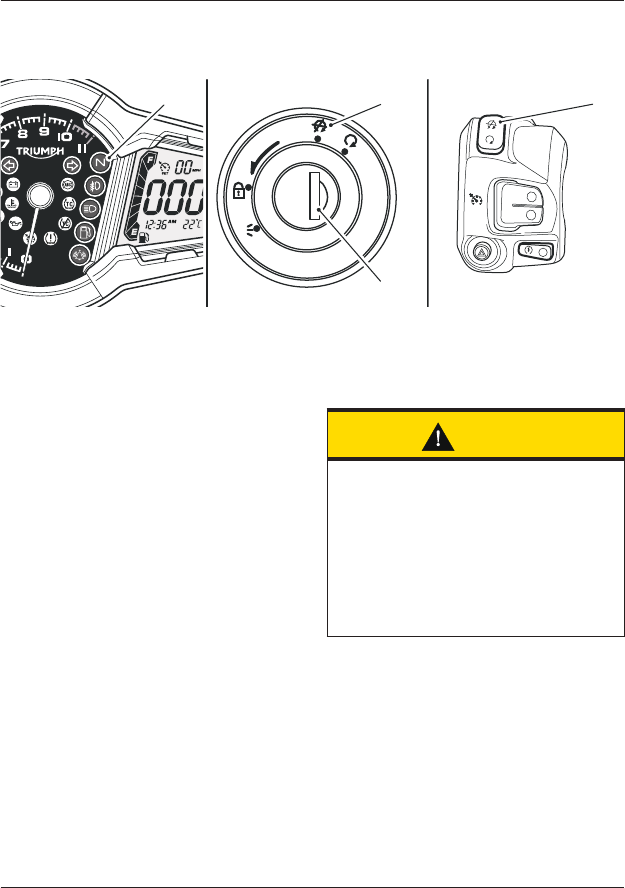
How to Ride the Motorcycle
140
Stopping the Engine
Tiger 1200 XR Only
P
U
S
H
P
O
F
F
O
N
RES /+
SET /-
ON
3
4
21
1. Neutral indicator light
2. OFF position
3. Ignition switch
4. Engine stop switch - STOP position
To stop the engine:
• Close the throttle completely.
• Select neutral.
• Turn the ignition switch off.
• Select first gear.
• Support the motorcycle on a firm,
level surface with the side or center
stand.
• Lock the steering.
Caution
The engine should normally be stopped
by turning the ignition switch to the
OFF position.
The engine stop switch is for
emergency use only.
Do not leave the ignition switched on
with the engine stopped. This will
cause electrical damage.
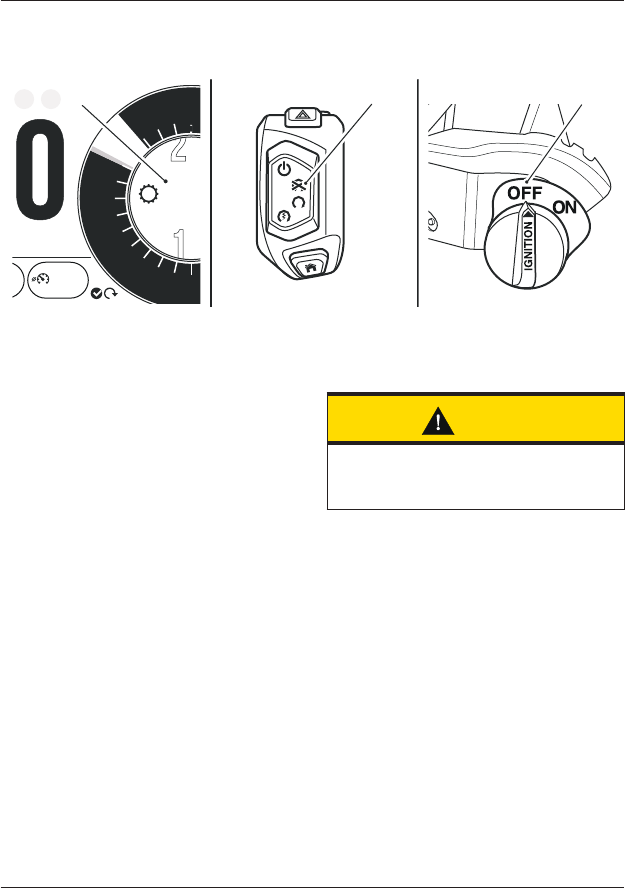
How to Ride the Motorcycle
141
Stopping the Engine
All Models except Tiger 1200 XR
25
8
6
4
2
0
12 14
25.2
mp/h
MM
RPM
x1000
10
N
321
1. Neutral indicator light
2. Engine stop switch - STOP position
3. Master ignition switch - OFF position (if equipped)
To stop the engine:
• Close the throttle completely.
• Select neutral.
• Place the engine stop switch in the
STOP position.
• Turn the master ignition switch to
the OFF position (if equipped).
• Select first gear.
• Support the motorcycle on a firm,
level surface with the side or center
stand.
• Lock the steering.
Caution
Do not leave the ignition switched on
with the engine stopped. This will
cause electrical damage.
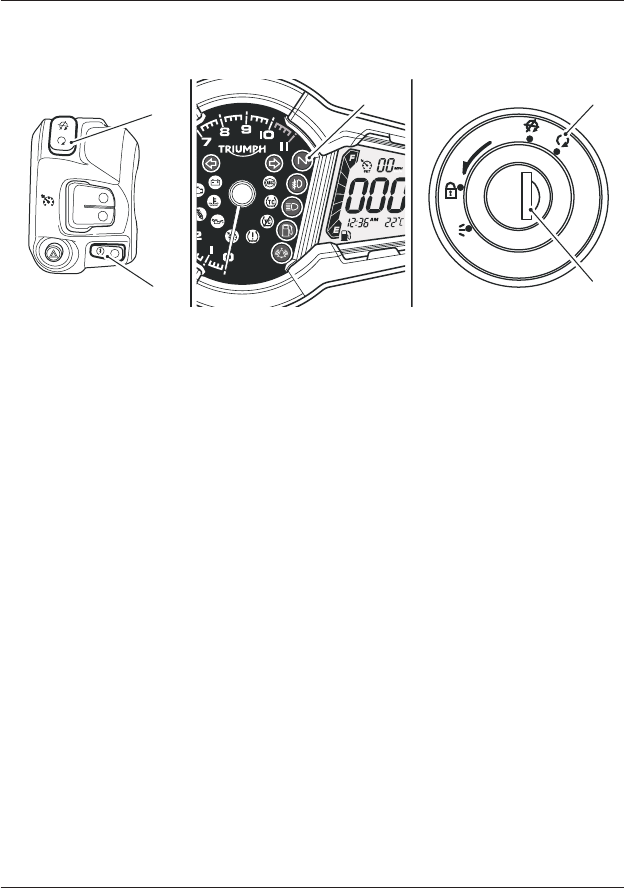
How to Ride the Motorcycle
142
Starting the Engine
Tiger 1200 XR
P
U
S
H
P
O
F
F
O
N
3
5
4
RES /+
SET /-
ON
2
1
1. Engine stop switch - RUN position
2. Starter button
3. Neutral indicator light
4. ON position
5. Ignition switch
To start the engine:
• Check that the engine stop switch
is in the RUN position.
• Make sure that the transmission is
in neutral.
• Turn the ignition switch on.
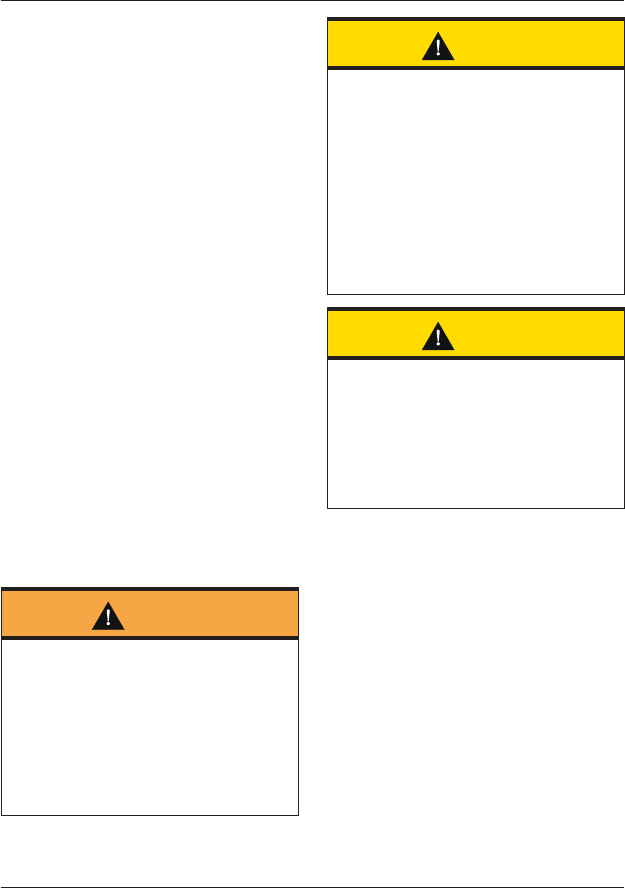
How to Ride the Motorcycle
143
Note:
• When the ignition is switched on,
the tachometer needle will quickly
sweep from zero to maximum and
then return to zero. The instrument
warning lights will illuminate and
will then go off (except those which
normally remain on until the engine
starts - see Warning Lights on
page 59). It is not necessary to wait
for the needle to return to zero
before starting the engine.
• A transponder is installed within
the key to turn off the engine
immobilizer. Only have one of the
ignition keys near the ignition
switch. Having two ignition keys
near the switch may interrupt the
signal between the transponder
and the engine immobilizer. In this
situation the engine immobilizer will
remain active until one of the
ignition keys is removed.
• Pull the clutch lever fully into the
handlebar.
• Leaving the throttle fully closed,
push the starter button until the
engine starts.
Warning
Never start the engine or run the
engine in a confined area.
Exhaust fumes are poisonous and can
cause loss of consciousness and death
within a short period of time.
Always operate your motorcycle in the
open air or in an area with adequate
ventilation.
Caution
Do not operate the starter
continuously for more than five
seconds as the starter motor will
overheat and the battery will become
discharged. Wait 15 seconds between
each operation of the starter to allow
for cooling and recovery of battery
power.
Do not let the engine idle for long
periods as this may lead to overheating
which will cause damage to the engine.
Caution
If the low oil pressure warning light
illuminates after starting the engine,
stop the engine immediately and
investigate the cause.
Running the engine with low oil
pressure will cause severe engine
damage.
The motorcycle is equipped with starter
lockout switches. The switches prevent
the electric starter from operating when
the transmission is not in neutral with
the side stand down.
If the side stand is extended while the
engine is running, and the transmission
is not in neutral then the engine will
stop regardless of clutch position.
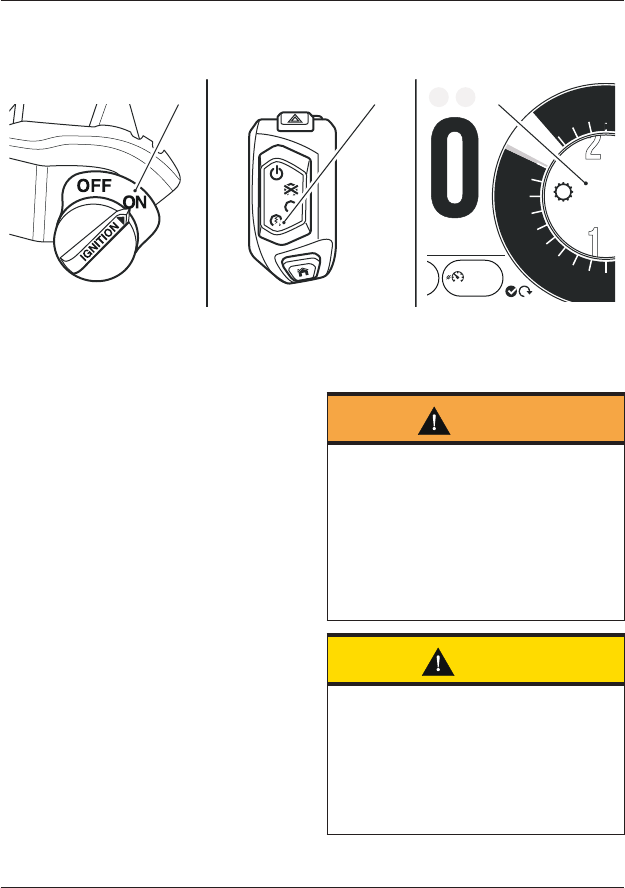
How to Ride the Motorcycle
144
Starting the Engine
All Models except Tiger 1200 XR
02:25
8
6
4
2
0
12 14
25.2
mp/h
HH:MM
RPM
x1000
10
N
21 3
1. Master ignition switch (if equipped)
2. Engine start/stop switch - QUICK START position
3. Neutral indicator light
To start the engine:
• Make sure that the master ignition
switch (if equipped) is turned to the
ON position, see page 92.
• Pull the clutch lever fully into the
handlebar.
• Press and hold the QUICK START
position on the engine start/stop
switch until the engine starts.
• Make sure that the transmission is
in neutral.
The motorcycle is equipped with starter
lockout switches. The switches prevent
the electric starter from operating when
the transmission is not in neutral with
the side stand down.
If the side stand is extended while the
engine is running, and the transmission
is not in neutral then the engine will
stop regardless of clutch position.
Warning
Never start the engine or run the
engine in a confined area.
Exhaust fumes are poisonous and can
cause loss of consciousness and death
within a short period of time.
Always operate your motorcycle in the
open air or in an area with adequate
ventilation.
Caution
If the low oil pressure warning light
illuminates after starting the engine,
stop the engine immediately and
investigate the cause.
Running the engine with low oil
pressure will cause severe engine
damage.
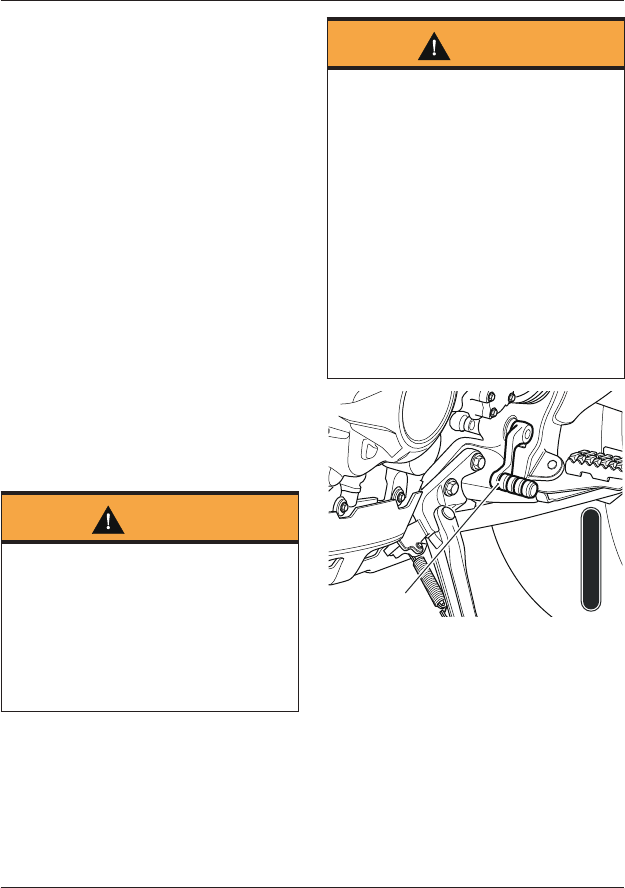
How to Ride the Motorcycle
145
Note:
• A transponder is installed within
the key to turn off the engine
immobilizer. Only have one of the
ignition keys near the ignition
switch. Having two ignition keys
near the switch may interrupt the
signal between the transponder
and the engine immobilizer. In this
situation the engine immobilizer will
remain active until one of the
ignition keys is removed.
Moving Off
Pull in the clutch lever and select first
gear. Open the throttle a little and let
out the clutch lever slowly. As the
clutch starts to engage, open the
throttle a little more, allowing enough
engine speed to avoid stalling.
Shifting Gears
Warning
Do not shift to a lower gear at speeds
that will cause excessive engine rpm
(r/min). This can lock the rear wheel
causing loss of motorcycle control and
an accident.
Engine damage may also be caused.
Shifting down should be done such
that low engine speeds will be ensured.
Warning
With the traction control enabled, it will
limit the amount of front wheel lift and
rear wheel slip.
If the traction control is not
functioning or disabled, avoid opening
the throttle too far or too fast in any
of the lower gears as this can lead to
the front wheel lifting from the ground
(pulling a wheelie) and to the rear tire
breaking traction (wheel spin).
Always open the throttle cautiously,
particularly if you are unfamiliar with
the motorcycle, as a wheelie or loss of
traction will cause loss of motorcycle
control and an accident.
1
6
5
4
3
2
N
1
1. Gear shift pedal
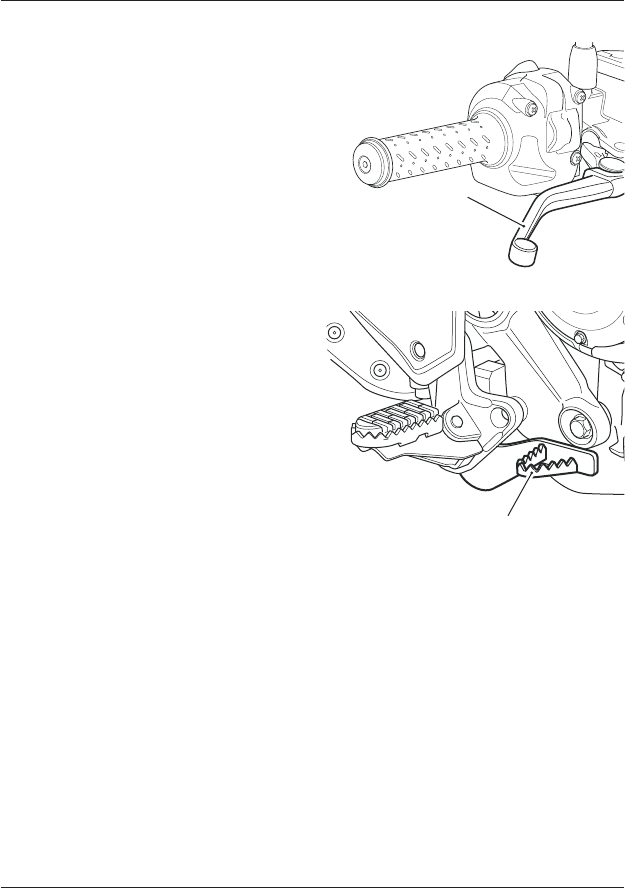
How to Ride the Motorcycle
146
To shift gears:
• Close the throttle while pulling in
the clutch lever.
• Shift into the next higher or lower
gear.
• Open the throttle part way, while
releasing the clutch lever. Always
use the clutch when shifting gear.
• The gear shift mechanism is the
positive stop type. This means that,
for each movement of the gear
shift pedal, you can only select
each gear, one after the other, in
ascending or descending order.
Braking
chex_ 1
1
1. Front brake lever
1
1. Rear brake pedal
All motorcycle models are equipped with
a partially integrated braking system,
combined with the Anti-lock Braking
System (ABS).
The partially integrated braking system
is designed to increase the braking
efficiency of the rider.
When the rider applies the front brake,
a small amount of rear brake is also
applied, allowing for balanced braking.
The amount of rear brake application is
related to the level of braking force
applied by the rider through the front
brake lever.
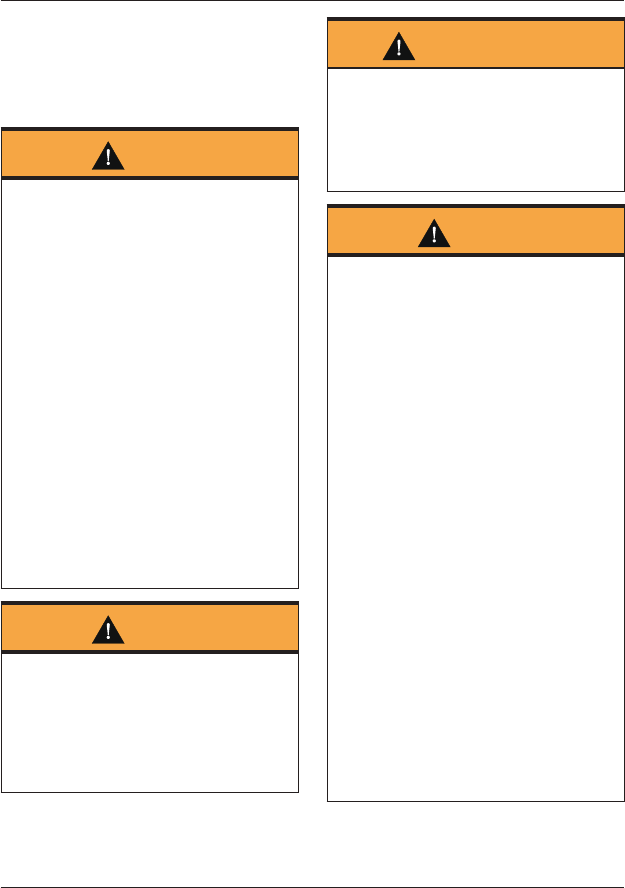
How to Ride the Motorcycle
147
Use of the rear brake pedal alone will
only apply the rear brake.
For full brake effectiveness, always
operate the front brake lever and rear
brake pedal together.
Warning
WHEN BRAKING, OBSERVE THE
FOLLOWING:
Close the throttle completely, leaving
the clutch engaged to allow the engine
to help slow down the motorcycle.
Shift down one gear at a time such
that the transmission is in first gear
when the motorcycle comes to a
complete stop.
When stopping, always apply both
brakes. Normally the front brake should
be applied a little more than the rear.
Shift down or fully disengage the
clutch as necessary to keep the engine
from stalling.
If the ABS is not functioning or has
been disabled, never lock the brakes, as
this may cause loss of motorcycle
control and an accident.
Warning
For emergency braking, disregard
down shifting, and concentrate on
applying the front and rear brakes as
hard as possible without skidding.
Riders should practice emergency
braking in a traffic-free area (see ABS
warnings below/over).
Warning Continued
Triumph strongly recommends that all
riders take a course of instruction,
which includes advice on safe brake
operation. Incorrect brake technique
could result in loss of control and an
accident.
Warning
For your safety, always exercise
extreme caution when braking
(whether equipped with ABS or not),
accelerating or turning as any
improper action can cause loss of
motorcycle control and an accident.
Independent use of the front or rear
brakes reduces overall braking
performance. Extreme braking may
cause either wheel to lock, reducing
control of the motorcycle and causing
an accident (see ABS warnings below).
When possible, reduce speed or brake
before entering a turn as closing the
throttle or braking in mid-turn may
cause wheel slip leading to loss of
motorcycle control and an accident.
When riding in wet or rainy conditions,
or on loose surfaces, the ability to
maneuver and stop will be reduced. All
of your actions should be smooth
under these conditions. Sudden
acceleration, braking or turning may
cause loss of motorcycle control and
an accident.
For more information on optimized
cornering ABS see page 150.
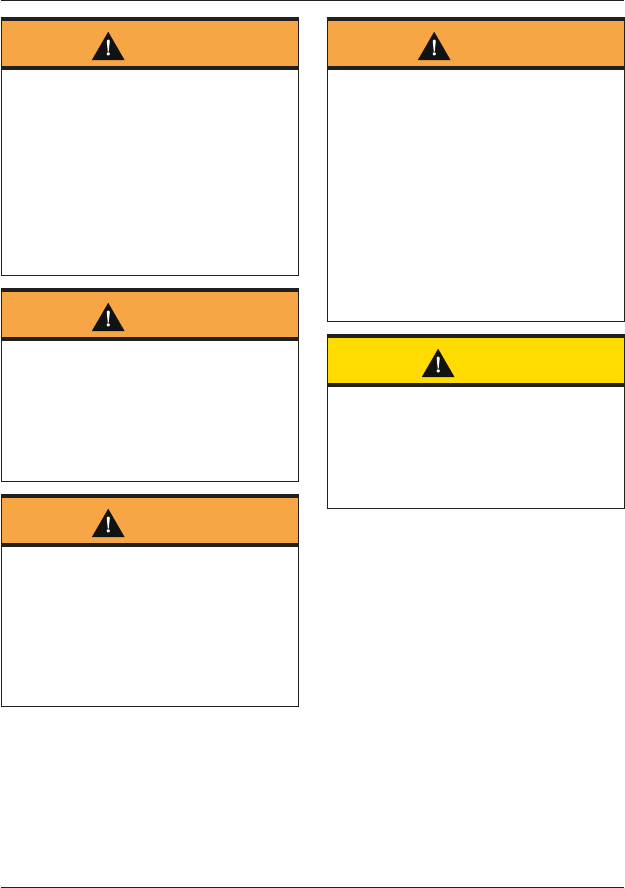
How to Ride the Motorcycle
148
Warning
When descending a long, steep
gradient or mountain pass, make use
of the engine's braking effect by down
shifting and use both front and rear
brakes intermittently.
Continuous brake application or use of
the rear brake only can overheat the
brakes and reduce their effectiveness
leading to loss of motorcycle control
and an accident.
Warning
Riding with your foot on the brake
pedal or your hands on the brake lever
may actuate the brake light, giving a
false indication to other road users. It
may also overheat the brake, reducing
braking effectiveness leading to loss of
motorcycle control and an accident.
Warning
Do not coast with the engine switched
off, and do not tow the motorcycle. The
transmission is pressure-lubricated
only when the engine is running.
Inadequate lubrication may cause
damage or seizure of the transmission,
which can lead to sudden loss of
motorcycle control and an accident.
Warning
When using the motorcycle on loose,
wet, or muddy roads, braking
effectiveness will be reduced by dust,
mud or moisture collecting on the
brakes.
Always brake earlier in these
conditions to ensure brake surfaces
are cleaned by the braking action.
Riding the motorcycle with brakes
contaminated with dust, mud or
moisture may cause loss of motorcycle
control and an accident.
Caution
Due to the nature of the partially
integrated braking system, any
attempts to spin the rear wheel while
the front brake is applied (Burnout) will
cause damage to the braking system
and drivetrain.
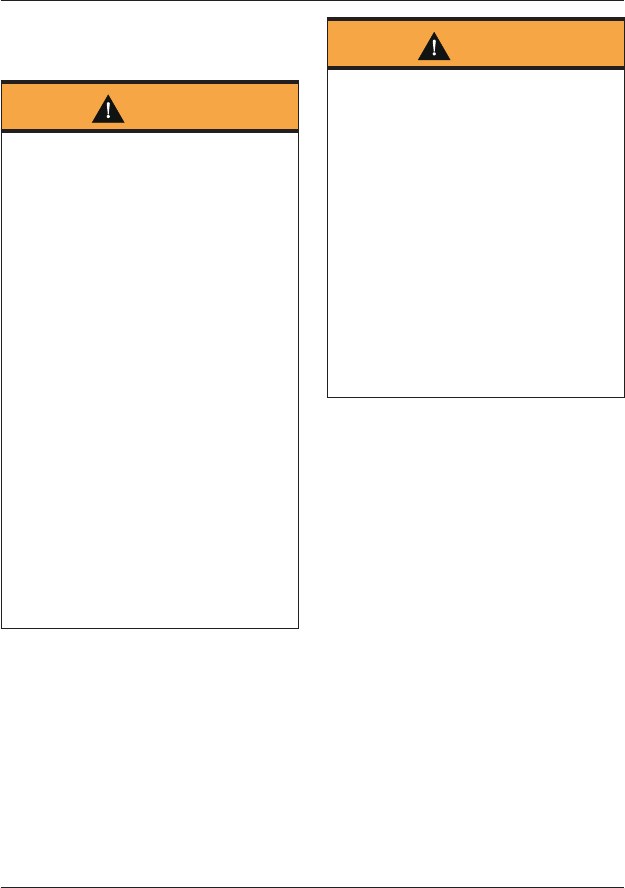
How to Ride the Motorcycle
149
Anti-Lock Braking System
(ABS)
Warning
ABS helps prevent the wheels from
locking, therefore maximizing the
effectiveness of the braking system in
emergencies and when riding on
slippery surfaces. The potentially
shorter braking distances ABS allows
under certain conditions are not a
substitute for good riding practice.
Always ride within the legal speed limit.
Never ride without due care and
attention and always reduce speed in
consideration of weather, road and
traffic conditions.
Take care when cornering. If the brakes
are applied in a corner, ABS will not be
able to counteract the weight and
momentum of the motorcycle. This can
result in loss of motorcycle control and
an accident.
Under some circumstances it is
possible that a motorcycle equipped
with ABS may require a longer
stopping distance than an equivalent
motorcycle without ABS.
Warning
If the ABS is not functioning or has
been disabled (see Bike Setup on
page 76 or Riding Mode Configuration
on page 85), the brake system will
continue to function as a non-ABS
braking system.
Do not continue to ride for longer than
is necessary with the warning light
illuminated. In the event of a fault,
contact an authorized Triumph dealer
as soon as possible to have the fault
checked and rectified.
In this situation, braking too hard will
cause the wheels to lock resulting in
loss of motorcycle control and an
accident.
Note:
• Normally, the rider will perceive
ABS operation as a harder feel or a
pulsation of the brake lever and
pedal.
• The ABS may be activated by
sudden upward or downward
changes in the road surface.
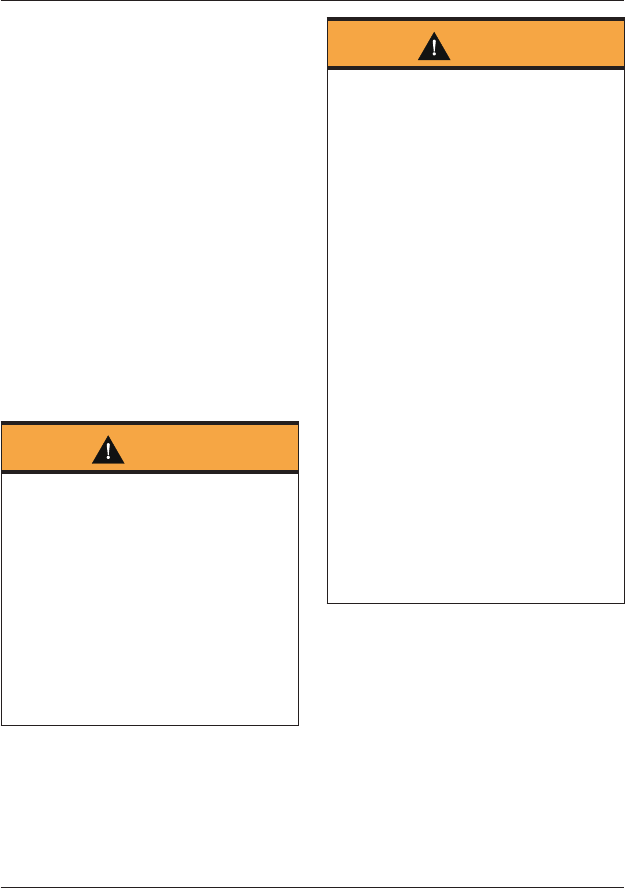
How to Ride the Motorcycle
150
Optimized Cornering ABS
Note:
• All models except Tiger 1200 XR are
equipped with the optimized
cornering ABS.
The optimized cornering ABS is a
system designed to give the rider
increased control should the ABS be
activated while the motorcycle is leaning
in a corner.
A sensor constantly monitors the lean
angle of the motorcycle. If the
motorcycle is leaning in a corner and
the ABS is activated, the system will use
the lean angle measurement to apply
the ABS in a manner most suitable to
help the rider maintain motorcycle
control.
Warning
The optimized cornering ABS is a
system designed to help the rider in
emergency braking situations.
The system is designed to give the
rider increased control should the ABS
be activated while the motorcycle is
leaning in a corner.
The potential increased control that
the optimized cornering braking
system allows under certain conditions
is not a substitute for good riding
practice.
Warning
Always ride within the legal speed limit.
Never ride without due care and
attention and always reduce speed in
consideration of weather, surface and
traffic conditions.
Take care when cornering.
If the motorcycle is leaning in a corner
and the ABS is activated, the optimized
cornering ABS will use the lean angle
measurement from a sensor to apply
the ABS in a manner most suitable to
help the rider maintain motorcycle
control. The optimized cornering ABS
will not however be able to fully
counteract the weight and momentum
of the motorcycle and braking too hard
while cornering may result in loss of
motorcycle control and an accident.
Under some circumstances it is
possible that a motorcycle equipped
with optimized cornering ABS may
require a longer stopping distance
than an equivalent motorcycle without
ABS, or an equivalent motorcycle
equipped with ABS but not equipped
with optimized cornering ABS.
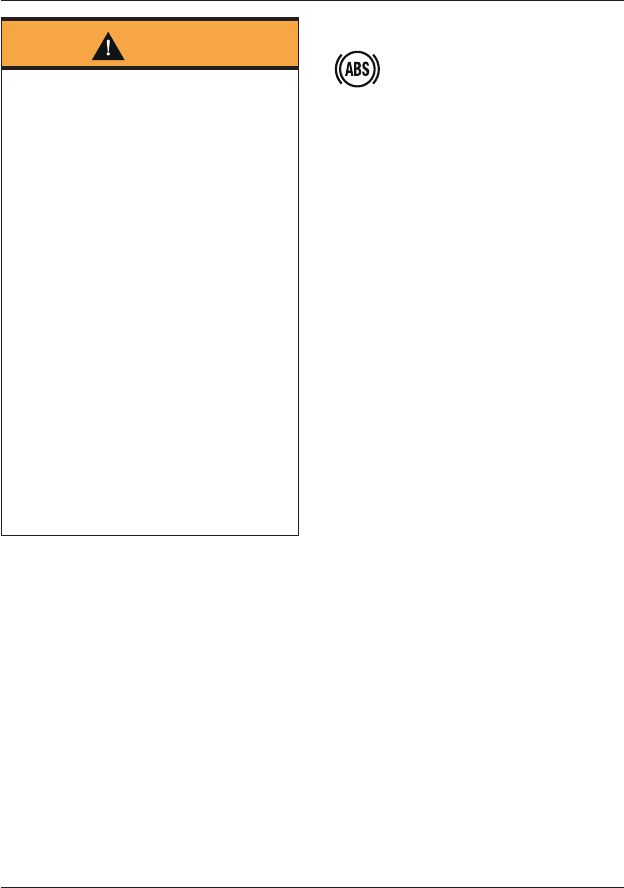
How to Ride the Motorcycle
151
Warning
If the optimized cornering ABS is not
functioning, the ABS warning light will
illuminate and the message ABS
SYSTEM - CORNERING ABS DISABLED
will be displayed in the multifunction
display.
In this situation, the ABS will continue
to operate but without the optimized
cornering function, provided that:
• There are no other ABS faults
• The ABS has not been disabled by the
rider (see Bike Setup on page 76 or
Riding Mode Configuration on page 85).
Do not continue to ride for longer than
is necessary with the warning light
illuminated. In the event of a fault,
contact an authorized Triumph dealer
as soon as possible to have the fault
checked and rectified.
In this situation, braking too hard
during cornering may result in loss of
motorcycle control and an accident.
ABS Warning Light
When the ignition switch is
turned to the ON position, it is normal
for the ABS warning light to flash on
and off.
If the ABS warning light is constantly
illuminated it indicates that the ABS
function is not available because:
• the ABS has been disabled by the
rider (see Bike Setup on page 76 or
Riding Mode Configuration on
page 85).
• the ABS has a malfunction that
requires investigation.
If the ABS warning light becomes
illuminated while riding, it indicates that
the ABS has a malfunction that requires
investigation. One of the following
warning messages may be displayed in
the multifunction display:
• WARNING - ABS SYSTEM DISABLED
• ABS SYSTEM - CORNERING ABS
DISABLED (models equipped with
optimized cornering ABS only).
For more information on the ABS
warning light, see page 61.
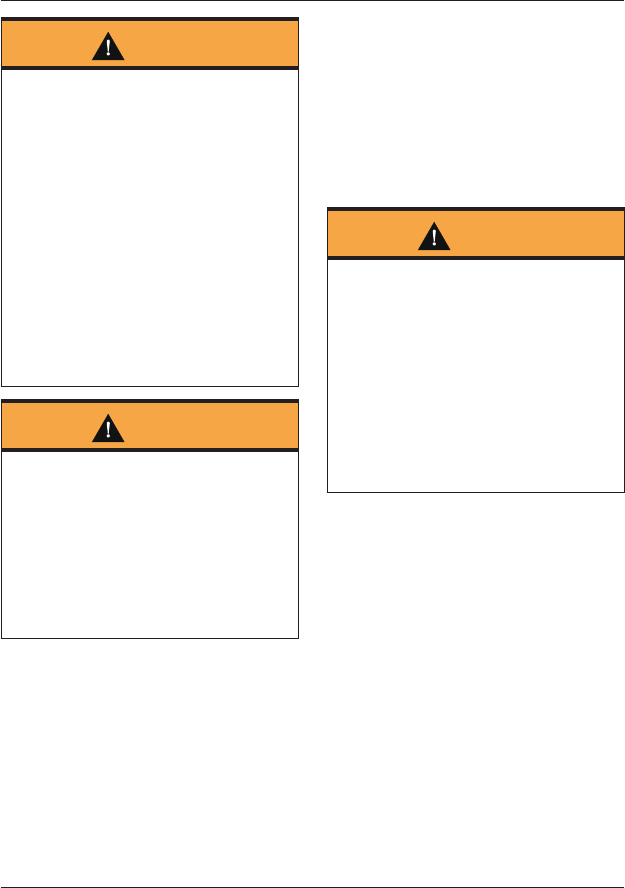
How to Ride the Motorcycle
152
Warning
The ABS warning light will illuminate
after three minutes, if the rear wheel is
driven while the motorcycle is on a
stand.
If the motorcycle was ridden prior to
being placed on a stand, this time will
reduced to one minute and the ABS
warning light will be accompanied by
the MIL.
This reaction is normal.
When the ignition is switched off and
the motorcycle is restarted, the
warning light(s) will remain illuminated
until the motorcycle reaches a speed
exceeding 6 mph (10 km/h).
Warning
The ABS computer operates by
comparing the relative speed of the
front and rear wheels.
Use of non-recommended tires can
affect wheel speed and cause the ABS
function not to operate, potentially
leading to loss of motorcycle control
and an accident in conditions where
the ABS would normally function.
Hill Hold Control (if equipped)
Hill hold control assists the rider in
making hill starts. The system (when
activated) will apply the rear brake to
hold the motorcycle in position. The
system will then automatically
deactivate and release the rear brake
when it detects that the rider is
attempting to move off.
Warning
Avoid activating the hill hold control
system on slippery surfaces.
The hill hold control system will not be
able to prevent the motorcycle from
slipping, if it is activated on a surface
where there is insufficient levels of tire
grip to hold the motorcycle in position.
Activating the hill hold control system
on a slippery surface could cause the
motorcycle to slip, leading to loss of
motorcycle control and an accident.
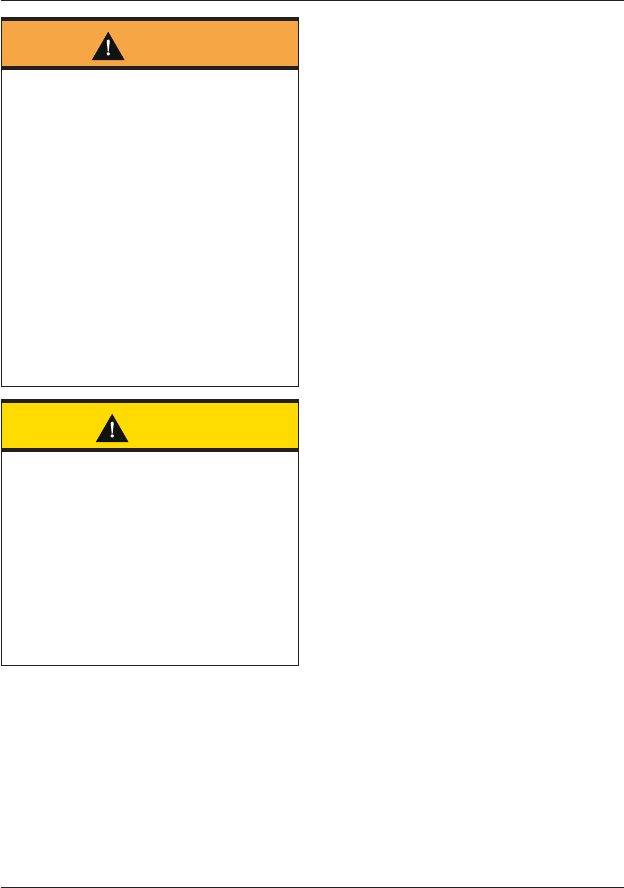
How to Ride the Motorcycle
153
Warning
The hill hold control system will
deactivate if the side stand is moved to
the down position, the ignition is
switched off, the engine stop switch is
moved to the STOP position or if the
engine is stopped for any other reason.
The hill hold control system will also
deactivate if a fault occurs which
causes the MIL to illuminate.
In these circumstances, the front brake
must be manually applied to prevent
the motorcycle from rolling.
Failure to prevent the motorcycle from
rolling may lead to loss of motorcycle
control and an accident.
Caution
The hill hold control system is not
designed to be used as a parking
brake.
Do not continually activate the hill hold
system for periods of longer than
10 minutes.
Continuous activation of the hill hold
control system for periods of longer
than 10 minutes may cause damage to
the ABS system.
Activation
Note:
• The hill hold control system will not
operate if there is a fault with the
ABS or engine management
systems and the ABS and/or MIL
warning lights are illuminated.
To activate the hill hold control system,
bring the motorcycle to a stop.
For hill hold control to activate:
• The engine must be running
• The side stand must be in the up
position
• The motorcycle must be stationary.
When all of the above conditions are
met, squeeze the front brake lever
firmly and quickly, then release. Upon
releasing the lever, the message HILL
HOLD ACTIVATED will appear in the
multifunction display.
The hill hold control system is now
active and the rear brake will be
automatically applied.
The message HILL HOLD ACTIVATED will
remain visible in the multifunction
display until hill hold control is
deactivated.
The rear brake will remain applied until:
• The system detects that the rider
is attempting to move off.
• Hill hold control is manually
deactivated by the rider.
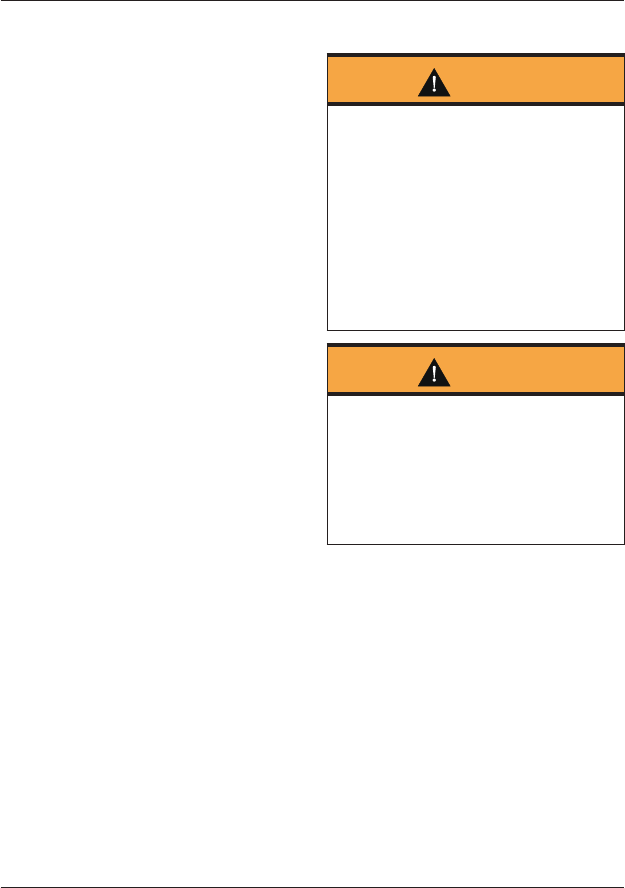
How to Ride the Motorcycle
154
Deactivation
The hill hold control system will
automatically deactivate when it detects
that the rider is attempting to move off.
The system will progressively release
the rear brake to assist the rider in
moving off.
The hill hold control system can also be
manually deactivated by a second firm
squeeze of the front brake lever.
The message HILL HOLD DEACTIVATED
will be displayed briefly in the
multifunction display.
Hill Hold Unavailable Message
If when attempting to activate the hill
hold control system, the message HILL
HOLD UNAVAILABLE - CHECK MANUAL is
displayed, this indicates one or more of
the following:
• The activation conditions described
on page 153 have not been met.
• There is a fault with the ABS or
engine management systems and
the ABS and/or MIL warning lights
are illuminated. See Warning Lights
on page 59.
The hill hold control system can be
enabled or disabled (see Bike Setup on
page 47).
Parking
Warning
Gasoline is extremely flammable and
can be explosive under certain
conditions. If parking inside a garage or
other structure, be sure it is well
ventilated and the motorcycle is not
close to any source of flame or sparks.
This includes any appliance with a pilot
light.
Failure to follow the above advice may
cause a fire resulting in damage to
property or personal injury.
Warning
The engine and exhaust system will be
hot after riding. DO NOT park where
pedestrians and children are likely to
touch the motorcycle.
Touching any part of the engine or
exhaust system when hot may cause
unprotected skin to become burnt.
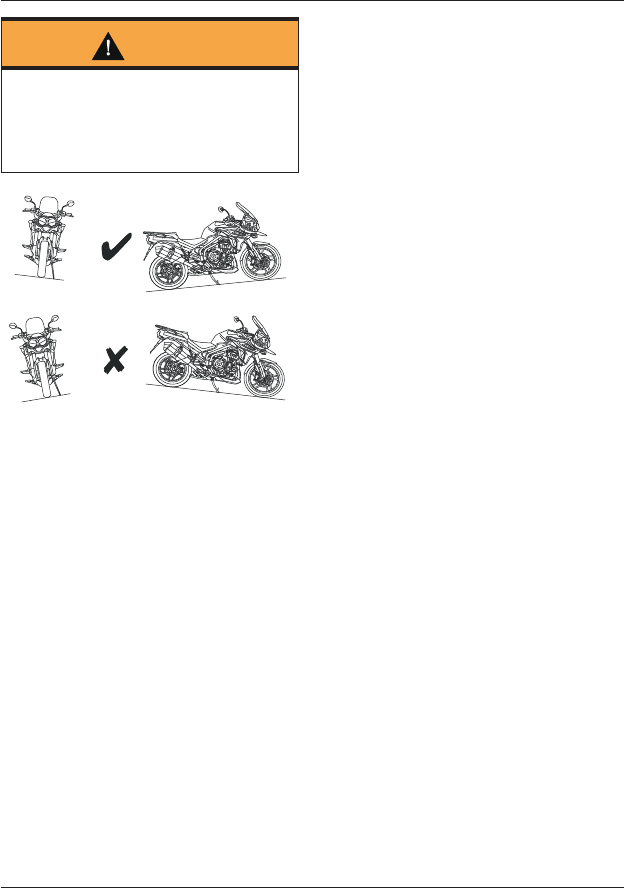
How to Ride the Motorcycle
155
Warning
Do not park on a soft or on a steeply
inclined surface. Parking under these
conditions may cause the motorcycle
to fall over causing damage to
property and personal injury.
Select neutral and turn the ignition
switch to the OFF position.
Lock the steering to help prevent theft.
Always park on a firm, level surface to
prevent the motorcycle from falling. This
is particularly important when parking
off-road.
When parking on a hill, always park
facing uphill to prevent the motorcycle
from rolling off the stand. Engage first
gear to prevent the motorcycle from
moving.
On a lateral (sideways) incline, always
park such that the incline naturally
pushes the motorcycle towards the side
stand.
Do not park on a lateral (sideways)
incline of greater than 6° and never
park facing downhill.
Note:
• When parking near traffic at night,
or when parking in a location where
parking lights are required by law,
leave the tail, license plate and
position lights on by turning the
ignition switch to P (PARK) on
Tiger 1200 XR models.
For Tiger
1200 XR models, do not leave
the switch in the P position for long
periods of time as this will discharge the
battery.
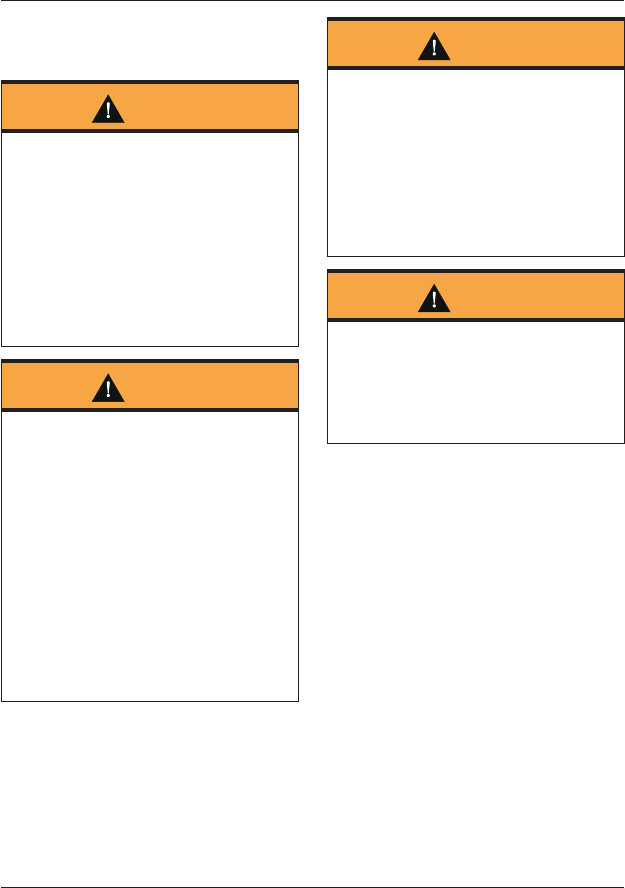
How to Ride the Motorcycle
156
Considerations for High
Speed Operation
Warning
This Triumph motorcycle should be
operated within the legal speed limits
for the particular road traveled.
Operating a motorcycle at high speeds
can be potentially dangerous since the
time available to react to given traffic
situations is greatly reduced as road
speed increases.
Always reduce speed in consideration
of weather and traffic conditions.
Warning
Only operate this Triumph motorcycle
at high speed in closed-course on-road
competition or on closed-course
racetracks.
High speed operation should only then
be attempted by riders who have been
instructed in the techniques necessary
for high-speed riding and are familiar
with the motorcycle's characteristics in
all conditions.
High speed operation in any other
circumstances is dangerous and will
lead to loss of motorcycle control and
an accident.
Warning
The handling characteristics of a
motorcycle at high speed may vary
from those you are familiar with at
legal road speeds.
Do not attempt high speed operation
unless you have received sufficient
training and have the required skills as
a serious accident may result from
incorrect operation.
Warning
The listed items below are extremely
important and must never be
neglected. A problem, which may not
be noticed at normal operating speeds,
may be greatly exaggerated at high
speeds.
General
Make sure that the motorcycle has been
maintained according to the scheduled
maintenance chart.
Steering
Check that the handlebar turns
smoothly without excessive free play or
tight spots. Make sure that the control
cables do not restrict the steering in
any way.
Luggage
Make sure that any luggage containers
are closed, locked and securely installed
on the motorcycle.
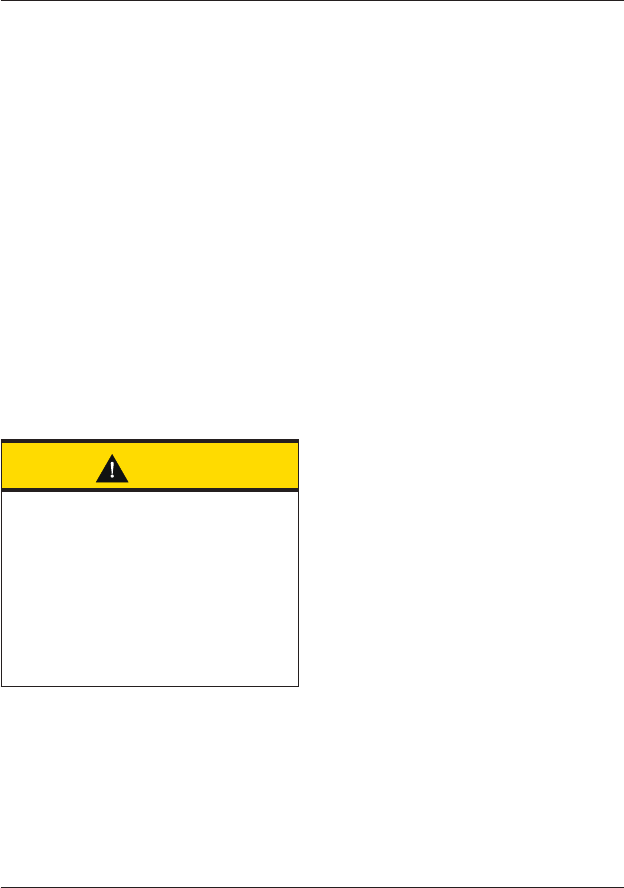
How to Ride the Motorcycle
157
Brakes
Check that the front and rear brakes
are functioning properly.
Tires
High speed operation is hard on tires,
and tires that are in good condition are
crucial to riding safely. Examine their
overall condition, inflate to the correct
pressure (when the tires are cold), and
check the wheel balance. Securely install
the valve caps after checking tire
pressures. Observe the information
given in the Maintenance and
Specification sections on tire checking
and tire safety.
Fuel
Have sufficient fuel for the increased
fuel consumption that will result from
high-speed operation.
Caution
The exhaust system is equipped with a
catalytic converter to help reduce
exhaust emission levels.
The catalytic converter can be
permanently damaged if the motorcycle
is allowed to run out of fuel or if the fuel
level is allowed to get very low.
Always make sure that you have
adequate fuel for your journey.
Engine Oil
Make sure that the engine oil level is
correct. Make sure that the correct
grade and type of oil is used when
topping off.
Final Drive Oil
Make sure that the final drive oil level is
correct. Make sure that the correct
grade and type of oil is used when
topping off.
Coolant
Check that the coolant level is at the
upper level line in the expansion tank.
(Always check the level with the engine
cold.)
Electrical Equipment
Make sure that the headlight, rear/
brake light, turn signals, horn, etc. all
work properly.
Miscellaneous
Visually check that all fasteners are
tight.
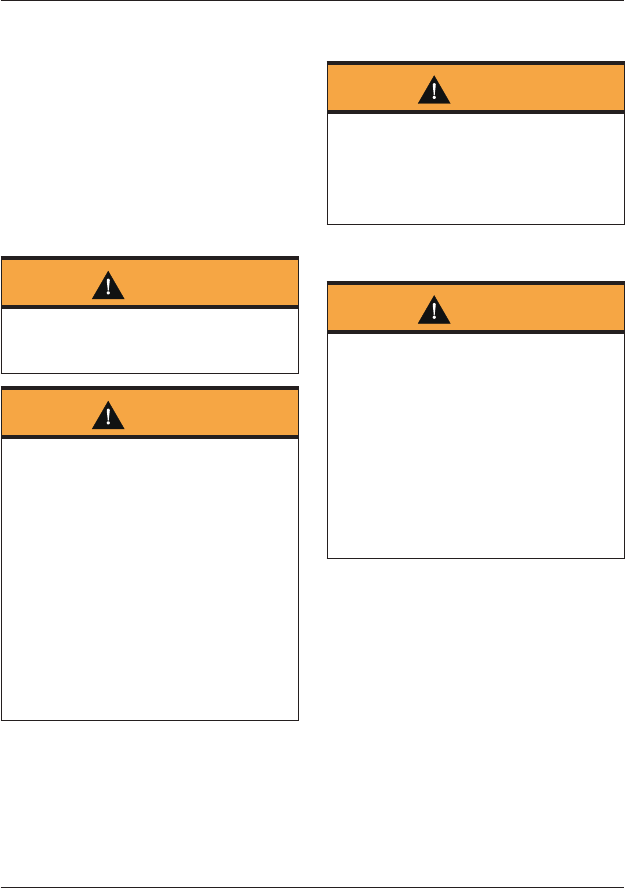
Accessories, Loading and Passengers
158
ACCESSORIES, LOADING AND PASSENGERS
The addition of accessories and carrying
additional weight can affect the
motorcycle's handling characteristics
causing changes in stability and
necessitating a reduction in speed. The
following information has been prepared
as a guide to the potential hazards of
adding accessories to a motorcycle and
carrying passengers and additional
loads.
Warning
This motorcycle must not be operated
above the legal road speed limit except
in authorized closed-course conditions.
Warning
Only operate this Triumph motorcycle
at high speed in closed-course, on-
road competition or on closed-course
racetracks. High speed operation
should only then be attempted by
riders who have been instructed in the
techniques necessary for high speed
riding and are familiar with the
motorcycle's characteristics in all
conditions.
High speed operation in any other
circumstances is dangerous and will
lead to loss of motorcycle control and
an accident.
Warning
Do not move or lift the motorcycle by
using any part of the luggage system
or any accessories.
Damage to the motorcycle and/or
personal injury may occur.
Accessories
Warning
Do not install accessories or carry
luggage that impairs the control of the
motorcycle.
Make sure that you have not adversely
affected the visibility of any lighting
component, road clearance, banking
capability (i.e. lean angle), control
operation, wheel travel, front fork
movement, visibility in any direction, or
any other aspect of the motorcycle's
operation.
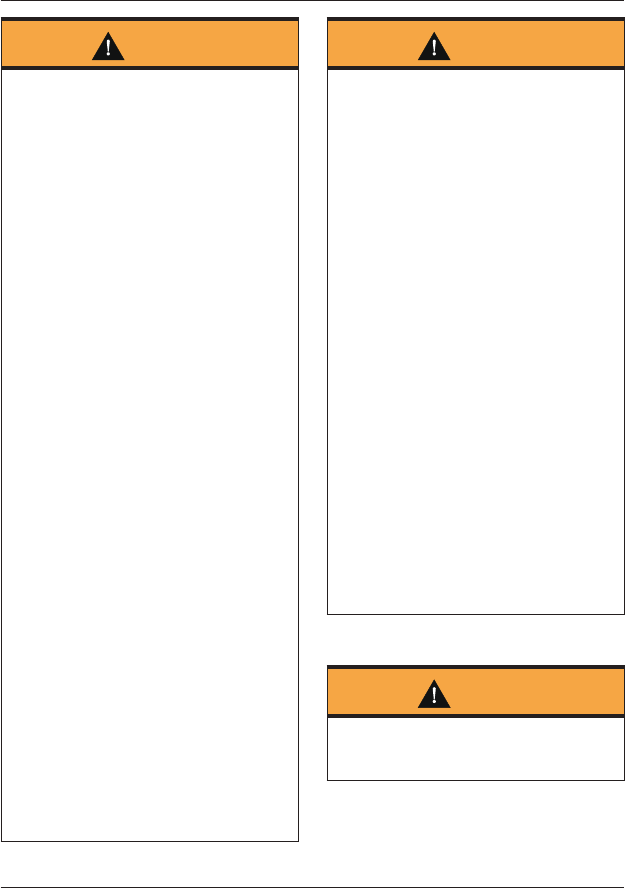
Accessories, Loading and Passengers
159
Warning
Never ride an accessory-equipped
motorcycle, or a motorcycle carrying a
payload of any kind, at speeds above
80 mph (130 km/h). In either/both of
these conditions, speeds in excess of
80 mph (130 km/h) should not be
attempted even where the legal speed
limit permits this.
The presence of accessories and/or
payload will cause changes in the
stability and handling of the
motorcycle.
Failure to allow for changes in
motorcycle stability may lead to loss of
motorcycle control and an accident.
When riding at high speed, always be
aware that various motorcycle
configuration and environmental
factors can adversely affect the
stability of your motorcycle. For
example:
• Incorrectly balanced loads on both
sides of the motorcycle.
• Incorrectly adjusted front and rear
suspension settings.
• Incorrectly adjusted tire pressures.
• Excessively or unevenly worn tires.
• Side winds and turbulence from other
vehicles.
• Loose clothing.
Remember that the 80 mph (130 km/h)
absolute limit will reduce by the
installation of non-approved
accessories, incorrect loading, worn
tires, overall motorcycle condition and
poor road or weather conditions.
Warning
Owners should be aware that the only
approved parts, accessories and
conversions for any Triumph
motorcycle are those which carry
official Triumph approval and are
installed to the motorcycle by an
authorized dealer.
In particular, it is extremely hazardous
to install or replace parts or
accessories whose installation requires
the dismantling of, or addition to,
either the electrical or fuel systems
and any such modification could cause
a safety hazard.
The installation of any non-approved
parts, accessories or conversions may
adversely affect the handling, stability
or other aspect of the motorcycle
operation that may result in an
accident causing injury or death.
Triumph does not accept any liability
whatsoever for defects caused by the
installation of non-approved parts,
accessories or conversions or the
installation of any approved parts,
accessories or conversions by non-
approved personnel.
Loading
Warning
Incorrect loading may result in an
unsafe riding condition leading to loss
of motorcycle control and an accident.
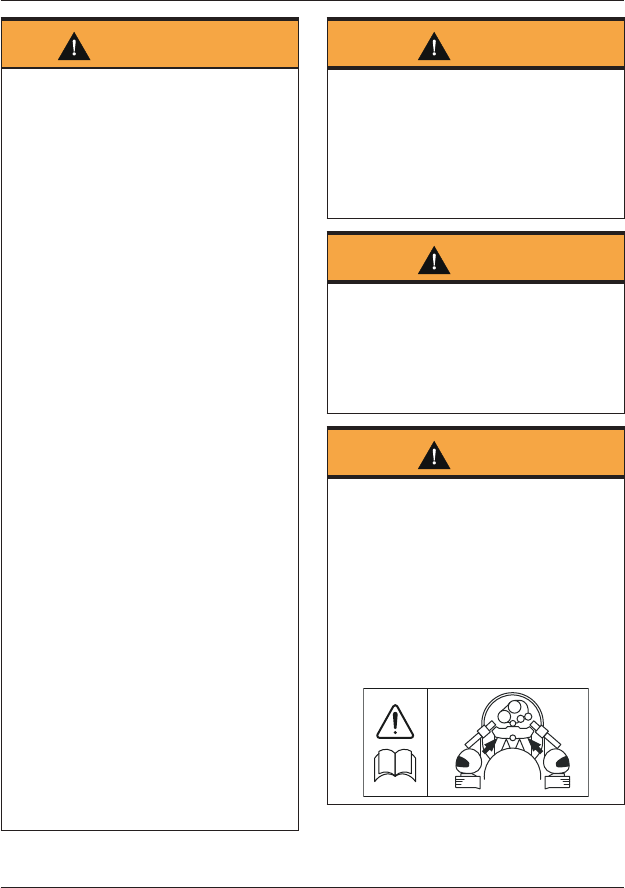
Accessories, Loading and Passengers
160
Warning Continued
Always make sure that any loads
carried are evenly distributed on both
sides of the motorcycle. Make sure
that the load is correctly secured such
that it will not move around while the
motorcycle is in motion.
Evenly distribute the load within each
pannier. Pack heavy items at the
bottom and on the inboard side of the
pannier.
Always check the load security regularly
(though not while the motorcycle is in
motion) and make sure that the load
does not extend beyond the rear of the
motorcycle. Never exceed the maximum
vehicle loading weight of:
Tiger 1200 XR - 507 lb (230 kg)
Tiger 1200 XRx - 502 lb (228 kg)
Tiger 1200 XRx-LRH - 507 lb (230 kg)
Tiger 1200 XRT - 502 lb (228 kg)
Tiger 1200 XCx - 491 lb (223 kg)
Tiger 1200 XCA - 493 lb (224 kg).
This maximum loading weight is made
up from the combined weight of the
rider, passenger, any accessories
installed and any load carried.
For models that have manually
adjustable suspension, make sure that
front and rear spring preload and
damping settings are suitable for the
loading condition of the motorcycle
(see page 185).
Note the maximum permissible payload
for the panniers is stated on a label
inside the pannier.
Warning
The maximum safe load for each
pannier is stated on a label inside the
pannier.
Never exceed this loading limit as this
may cause the motorcycle to become
unstable leading to loss of motorcycle
control and an accident.
Warning
The maximum safe load for the top box
is stated on a label inside the top box.
Never exceed this loading limit as this
may cause the motorcycle to become
unstable leading to loss of motorcycle
control and an accident.
Warning
Never attempt to store any items
between the frame and the fuel tank.
This can restrict the steering and will
cause loss of motorcycle control
leading to an accident.
Weight attached to the handlebar or
front fork will increase the mass of the
steering assembly and can result in
loss of steering control leading to an
accident.
X
X
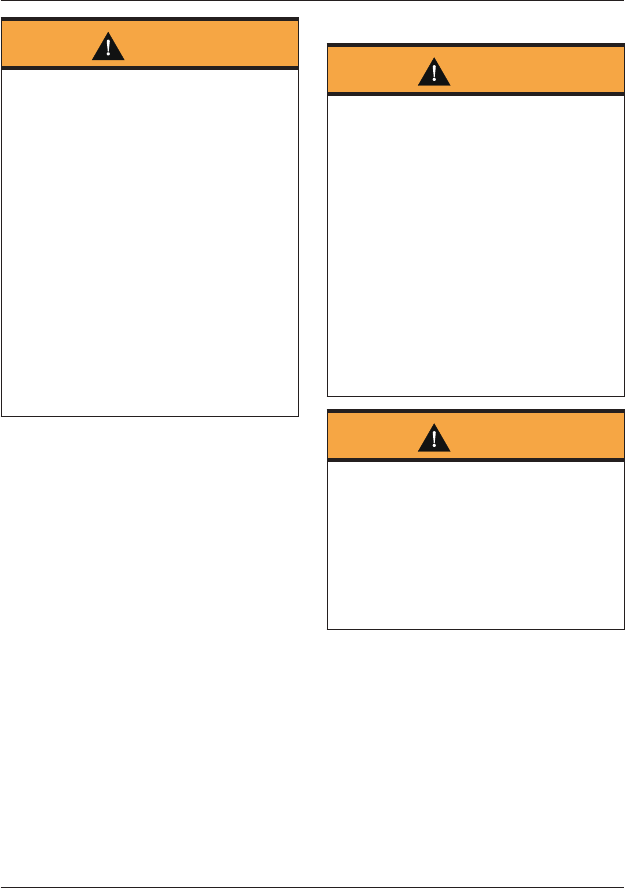
Accessories, Loading and Passengers
161
Warning
If the passenger seat is used to carry
small objects, they must not exceed
5 kg (11 lb) in weight, must not impair
control of the motorcycle, must be
securely attached and must not
extend beyond the rear or sides of the
motorcycle.
Carrying objects in excess of 5 kg (11 lb)
in weight, that are insecure, impair
control or extend beyond the rear or
sides of the motorcycle may lead to
loss of motorcycle control and an
accident.
Even if small objects are correctly
loaded onto the passenger seat, the
maximum speed of the motorcycle
must be reduced to 80 mph (130 km/h).
Note:
• Adjust the headlight aim to
compensate for additional loads
(see page 203).
Passengers
Warning
The handling and braking capabilities
of a motorcycle will be affected by the
presence of a passenger. The rider
must make allowances for these
changes when operating the
motorcycle with a passenger and
should not attempt such operation
unless trained to do so and without
becoming familiar and comfortable with
the changes in motorcycle operating
characteristics that this brings about.
Motorcycle operation without making
allowances for the presence of a
passenger could lead to loss of
motorcycle control and an accident.
Warning
Do not carry a passenger unless they
are tall enough to reach the footrests
provided.
A passenger who is not tall enough to
reach the footrests will be unable to sit
securely on the motorcycle and may
cause instability leading to loss of
motorcycle control and an accident.
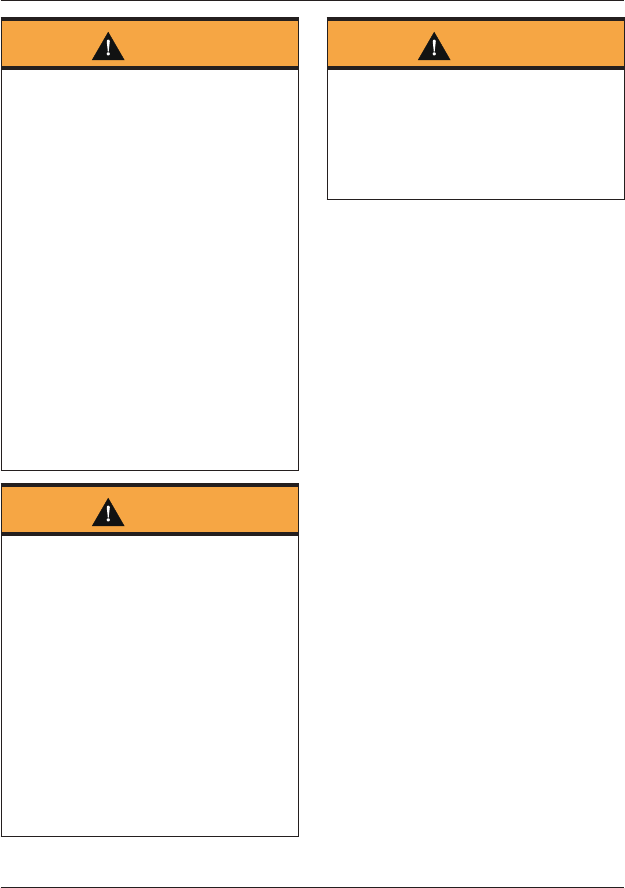
Accessories, Loading and Passengers
162
Warning
Your passenger should be instructed
that they can cause loss of motorcycle
control by making sudden movements
or by adopting an incorrect seated
position.
The rider should instruct the
passenger as follows:
• It is important that the passenger
sits still while the motorcycle is in
motion and does not interfere with the
operation of the motorcycle.
• To keep their feet on the passenger
footrests and to firmly hold onto the
grab handles or the rider's waist or
hips.
Advise the passenger to lean with the
rider when traveling around corners
and not to lean unless the rider does
so.
Warning
The handling and braking capabilities
of a motorcycle will be affected by the
presence of a passenger. The rider
must make allowances for these
changes when operating the
motorcycle with a passenger and
should not attempt such operation
unless trained to do so and without
becoming familiar and comfortable with
the changes in motorcycle operating
characteristics that this brings about.
Motorcycle operation without making
allowances for the presence of a
passenger could lead to loss of
motorcycle control and an accident.
Warning
Do not carry animals on your
motorcycle.
An animal could make sudden and
unpredictable movements that could
lead to loss of motorcycle control and
an accident

Maintenance
163
MAINTENANCE
Table of Contents
Scheduled Maintenance 165
Scheduled Maintenance Table 167
Engine Oil 169
Engine Oil Level Inspection 169
Engine Oil and Oil Filter Change 170
Disposal of Used Engine Oil and Oil Filters 171
Oil Specification and Grade 172
Cooling System 172
Coolant Level Inspection 173
Coolant Level Adjustment 173
Coolant Change 174
Throttle Control 175
Clutch 175
Clutch Fluid Level Inspection and Adjustment 175
Final Drive Unit 176
Final Drive Oil Level Adjustment 176
Brakes 177
Brake Wear Inspection 177
Breaking-in New Brake Discs and Pads 178
Brake Pad Wear Compensation 178
Disc Brake Fluid 179
Front Brake Fluid Level Inspection and Adjustment 180
Rear Brake Fluid Inspection and Adjustment 181
Brake Light 181
Steering/Wheel Bearings 182
Steering Inspection 182
Steering (Steering Head) Bearings Inspection 182
Wheel Bearings Inspection 183
Front Suspension 183
Front Fork Inspection 183
Front Suspension Adjustment 184
Compression Damping Adjustment 184
Rebound Damping Adjustment 185
Front Suspension Setting Chart 185
Rear Suspension 186
Rear Suspension Adjustment 186

Maintenance
164
Spring Preload Adjustment 186
Rebound Damping Adjustment 187
Rear Suspension Setting Chart 187
Tires 188
Tire Inflation Pressures 189
Tire Wear 189
Minimum Recommended Tread Depth 190
Tire Replacement 190
Battery 193
Battery Removal 194
Battery Disposal 194
Battery Maintenance 195
Battery Discharge 195
Battery Discharge During Storage and Infrequent Use of the Motorcycle 195
Battery Charging 196
Battery Installation 197
Fuse Boxes 197
Main Fuse 197
ABS Fuse 198
Fuse Box 198
Fuse Identification 199
Chassis Electronic Control Module (Chassis ECM) 200
Headlights 201
Daytime Running Light (DRL) (if equipped) 202
Bend Lighting (if equipped) 202
Headlight Adjustment 203
Bulb Replacement 205
Headlights 205
Front Fog Lights (if equipped) 206
Brake/Tail Light/License Plate Light 206
Turn Signal Lights 206
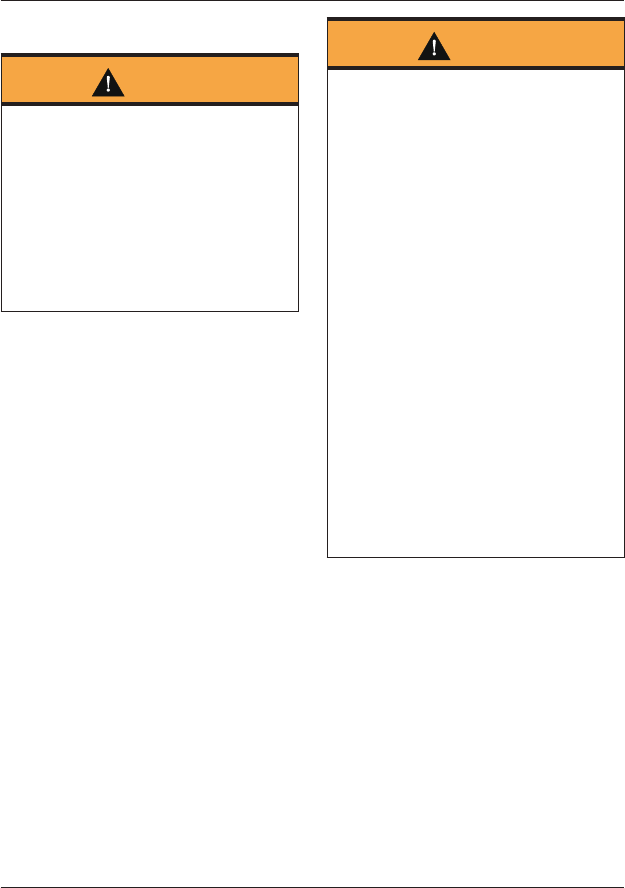
Maintenance
165
Scheduled Maintenance
Warning
Triumph Motorcycles cannot accept
any responsibility for damage or injury
resulting from incorrect maintenance
or improper adjustment carried out by
the owner.
Since incorrect or neglected mainte-
nance can lead to a dangerous riding
condition, always have an authorized
Triumph dealer carry out the scheduled
maintenance of this motorcycle.
Warning
All maintenance is vitally important
and must not be neglected. Incorrect
maintenance or adjustment may cause
one or more parts of the motorcycle to
malfunction. A malfunctioning motor-
cycle may lead to loss of control and
an accident.
Weather, terrain and geographical lo-
cation affect maintenance. The mainte-
nance schedule should be adjusted to
match the particular environment in
which the vehicle is used and the de-
mands of the individual owner.
Special tools, knowledge and training
are required in order to correctly carry
out the maintenance items listed in the
scheduled maintenance chart. Only an
authorized Triumph dealer will have
this knowledge and equipment.
Since incorrect or neglected mainte-
nance can lead to a dangerous riding
condition, always have an authorized
Triumph dealer carry out the scheduled
maintenance of this motorcycle.

Maintenance
166
To maintain the motorcycle in a safe
and reliable condition, the maintenance
and adjustments outlined in this section
must be carried out as specified in the
schedule of daily checks, and also in line
with the scheduled maintenance chart.
The information that follows describes
the procedures to follow when carrying
out the daily checks and some simple
maintenance and adjustment items.
Scheduled maintenance may be carried
out by your authorized Triumph dealer in
three ways; annual maintenance, mileage
based maintenance or a combination of
both, depending on the mileage the
motorcycle travels each year.
1. Motorcycles traveling less than
10,000 miles (16,000 km) per year
must be maintained annually. In
addition to this, mileage based
items require maintenance at their
specified intervals, as the
motorcycle reaches this mileage.
2. Motorcycles traveling approximately
10,000 miles (16,000 km) per year
must have the annual maintenance
and the specified mileage based
items carried out together.
3. Motorcycles traveling more than
10,000 miles (16,000 km) per year
must have the mileage based items
maintained as the motorcycle
reaches the specified mileage. In
addition to this, annual based items
will require maintenance at their
specified annual intervals.
In all cases maintenance must be
carried out at or before the specified
maintenance intervals shown. Consult
an authorized Triumph dealer for advice
on which maintenance schedule is most
suitable for your motorcycle.
Triumph Motorcycles cannot accept any
responsibility for damage or injury
resulting from incorrect maintenance or
improper adjustment.
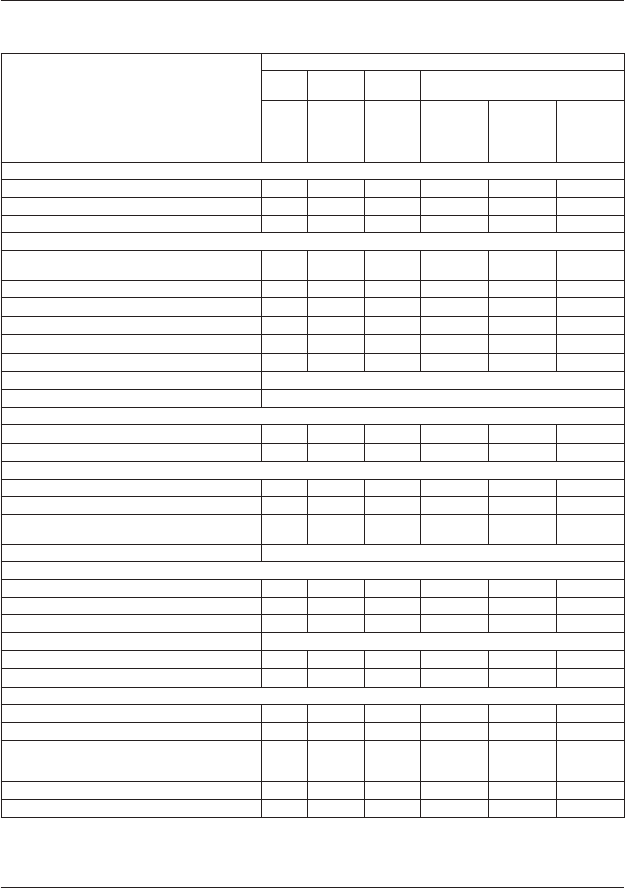
Maintenance
167
Scheduled Maintenance Table
Operation Description
Odometer Reading in Miles (km) or Time Period, whichever comes first
First
Service
Annual
Service
Mileage Based Service
Every
500 (800)
1 Month
Ye a r
10,000 and
30,000
(16,000 and
48,000)
20,000
(32,000)
40,000
(64,000)
Lubrication
Engine – check for leaks Day • • • • •
Engine oil – replace - • • • • •
Engine oil filter – replace - • • • • •
Fuel System and Engine Management
Autoscan – carry out a full Autoscan using the Triumph
diagnostic tool (print a customer copy) - • • • • •
Fuel system – check for leaks, chafing etc. Day • • • • •
Air cleaner – replace - • • •
Throttle body plate (butterfly) – check/clean - • • •
Throttle bodies – balance - • • •
Secondary air injection system – check - • •
Fuel hoses – replace Every four years, regardless of mileage
Evaporative loss hoses – replace Every four years, regardless of mileage
Ignition System
Spark plugs – check - •
Spark plugs – replace - • •
Cooling System
Cooling system – check for leaks Day • • • • •
Coolant level – check/adjust Day • • • • •
Cooling system - check coolant hoses for chafing,
cracks or damage. Replace if necessary - • • •
Coolant – replace Every 3 years, regardless of mileage
Engine
Clutch – check operation Day • • • • •
Clutch master cylinder – check for leaks - • • • • •
Clutch fluid levels – check Day • • • • •
Clutch fluid – replace Every 2 years, regardless of mileage
Valve clearances – check/adjust - • •
Camshaft timing - check/adjust - • •
Wheels and Tires
Wheels – inspect for damage Day • • • • •
Wheel bearings – check for wear/smooth operation - • • • • •
Wheels – check wheels for broken or damaged spokes
and check spoke tightness (models with spoked wheels
only)
- • • • • •
Tire wear/tire damage – check Day • • • • •
Tire pressures – check/adjust Day • • • • •
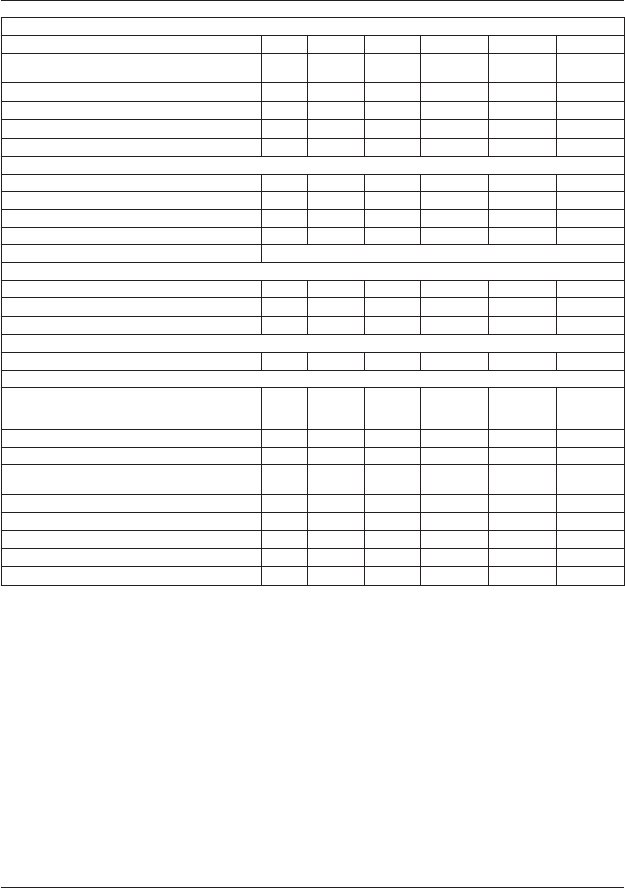
Maintenance
168
Steering and Suspension
Steering – check for free operation Day • • • • •
Front and rear suspension - check for damage/leaks/
smooth operation
Day • • • • •
Fork oil – replace - •
Steering head bearings – check/adjust - • • • •
Steering head bearings – lubricate - • •
Rear suspension linkage – check/lubricate - • •
Brakes
Brake pads – check wear levels Day • • • • •
Brake master cylinders – check for fluid leaks Day • • • • •
Brake calipers – check for fluid leaks and seized pistons Day • • • • •
Brake fluid levels – check Day • • • • •
Brake fluid – replace Every 2 years, regardless of mileage
Final Drive
Final drive – check for oil leaks Day • • • • •
Final drive oil level – check - • • • •
Final drive oil – replace – only first service - •
Electrical
Lights, instruments and electrical systems – check Day • • • • •
General
Instruments, chassis ECM and engine ECM - check for
latest calibration download using the Triumph
diagnostic tool
- • • • • •
Bank angle indicators - check for wear Day • • • • •
Fasteners – inspect visually for security Day • • • • •
Accessory rack sliding carriage – check for correct
operation‡ - • • • •
Side stand – check for wear/smooth operation Day • • • • •
Side stand pivot pin - clean/grease - • • •
Center stand – check for wear/smooth operation Day • • • • •
Center stand flanged sleeves – check/clean/grease - • • • •
Gear shift pedal - clean bushes - • • • •
‡Only if equipped.
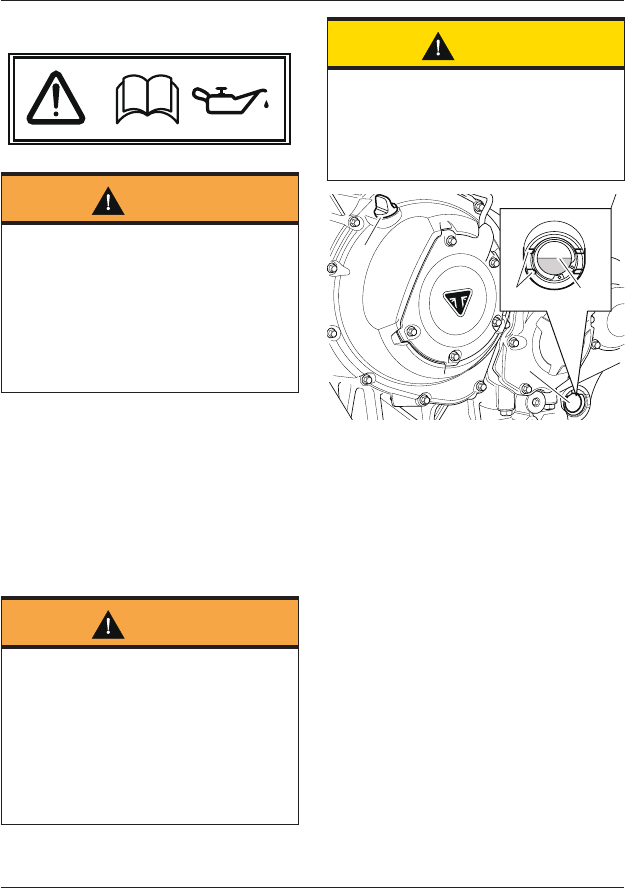
Maintenance
169
Engine Oil
cbnz
Warning
Motorcycle operation with insufficient,
deteriorated, or contaminated engine
oil will cause accelerated engine wear
and may result in engine or
transmission seizure.
Seizure of the engine or transmission
may lead to sudden loss of motorcycle
control and an accident.
In order for the engine, transmission,
and clutch to function correctly,
maintain the engine oil at the correct
level, and change the oil and oil filter in
accordance with scheduled
maintenance requirements.
Engine Oil Level Inspection
Warning
Never start the engine or run the
engine in a confined area.
Exhaust fumes are poisonous and can
cause loss of consciousness and death
within a short period of time.
Always operate your motorcycle in the
open-air or in an area with adequate
ventilation.
Caution
Running the engine with insufficient
engine oil will cause engine damage.
If the low oil pressure warning light
remains on, stop the engine
immediately and investigate the cause.
2
43
1
chgz_1
1. Filler plug
2. Sight glass
3. Engine oil level (correct level shown)
4. Crankcase engine oil level lines
To inspect the engine oil level:
• With the motorcycle upright and
off the side stand, check to see if
engine oil is visible in the sight
glass at a point halfway between
the upper (maximum) and lower
(minimum) horizontal lines marked
on the crankcase.
• If it is necessary to top off the
engine oil level, remove the filler
plug and add engine oil, a little at a
time, until the level registered in
the sight glass is correct. Reinstall
and tighten the filler plug.
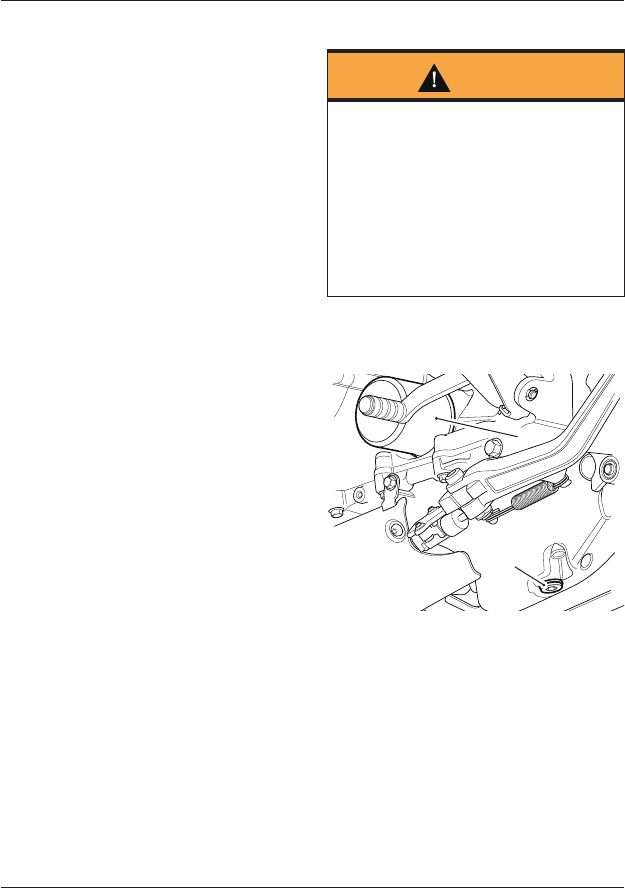
Maintenance
170
Note:
• An accurate indication of the level
of oil in the engine is only shown
when the engine is at normal
operating temperature and the
motorcycle is upright (not on the
side/center stand).
• Start the engine and run at idle for
approximately five minutes.
• Stop the engine, then wait for at
least three minutes for the engine
oil to settle.
• Note the engine oil level visible in
the sight glass.
• When correct, engine oil should be
visible in the sight glass at a point
halfway between the upper
(maximum) and lower (minimum)
horizontal lines marked on the
crankcase.
• If necessary, top off the engine oil
level as described earlier.
• Once the correct level is reached,
install and tighten the filler plug.
Engine Oil and Oil Filter Change
Warning
Prolonged or repeated contact with
engine oil can lead to skin dryness,
irritation and dermatitis.
In addition, used engine oil contains
harmful contamination that can lead to
skin cancer.
Always wear suitable protective
clothing and avoid skin contact with
used engine oil.
The engine oil and filter must be
replaced in accordance with scheduled
maintenance requirements.
c
hgy_1
1
2
1. Engine oil drain plug
2. Oil filter
To change the engine oil and oil filter:
• Warm up the engine thoroughly,
and then stop the engine and
secure the motorcycle in an upright
position on level ground.
• Place an oil drain pan beneath the
engine.
• Remove the engine oil drain plug.
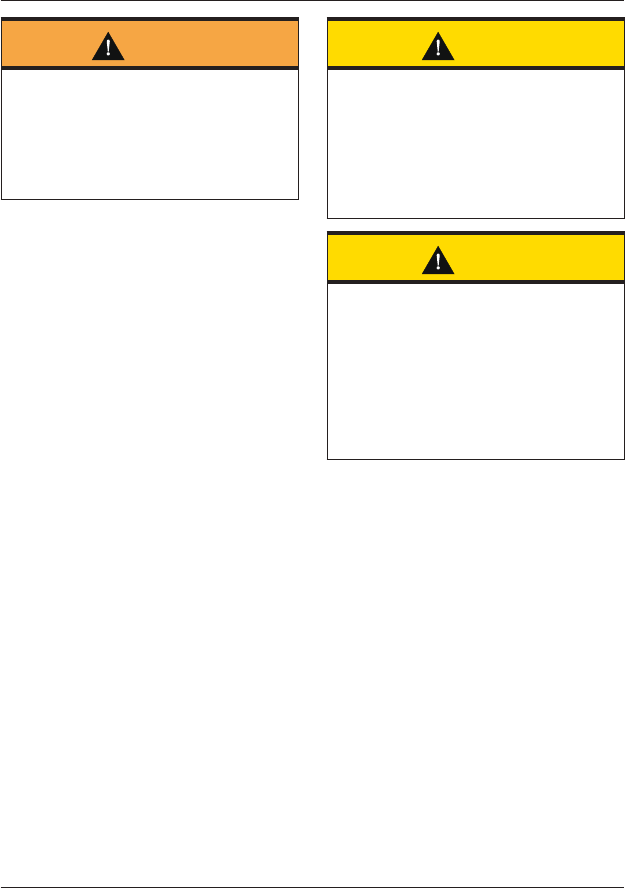
Maintenance
171
Warning
The engine oil may be hot. Contact with
hot oil may cause the skin to be
scalded or burned.
Always wear suitable protective
clothing, gloves and eye protection and
avoid skin contact with the engine oil.
• Unscrew and remove the oil filter
using Triumph service tool
T3880313. Dispose of the old filter
in an environmentally friendly way.
• Apply a thin smear of clean engine
oil to the sealing ring of the new oil
filter.
• Install the oil filter and tighten to
89 lbf in (10 Nm).
• After the engine oil has completely
drained out, mount a new sealing
washer to the engine oil drain plug.
• Install and tighten the engine oil
drain plug to 18 lbf ft (25 Nm).
• Fill the engine with a 10W/40 or
10W/50 semi or fully synthetic
motorcycle engine oil that meets
specification API SH (or higher) and
JASO MA, such as Castrol Power 1
Racing 4T 10W-40 (fully synthetic)
engine oil, sold as Castrol Power RS
Racing 4T 10W-40 (fully synthetic)
in some countries.
• Start the engine and allow it to idle
for a minimum of 30 seconds.
Caution
Raising the engine speed above idle
before the engine oil reaches all parts
of the engine can cause engine
damage or seizure.
Only raise engine speed after running
the engine for 30 seconds to allow the
engine oil to circulate fully.
Caution
If the engine oil pressure is too low, the
low oil pressure warning light will
illuminate.
If this light stays on when the engine is
running, stop the engine immediately
and investigate the cause.
Running the engine with low oil
pressure will cause engine damage.
• Make sure that the low oil pressure
warning light remains off after
starting and the message WARNING
- OIL PRESSURE LOW is not visible
in the instrument's display screen.
• Stop the engine and recheck the
engine oil level. Adjust if necessary.
Disposal of Used Engine Oil and Oil
Filters
To protect the environment, do not pour
oil on the ground, down sewers or
drains, or into groundwater sources. Do
not place used oil filters in with general
waste. If in doubt, contact your local
authority.
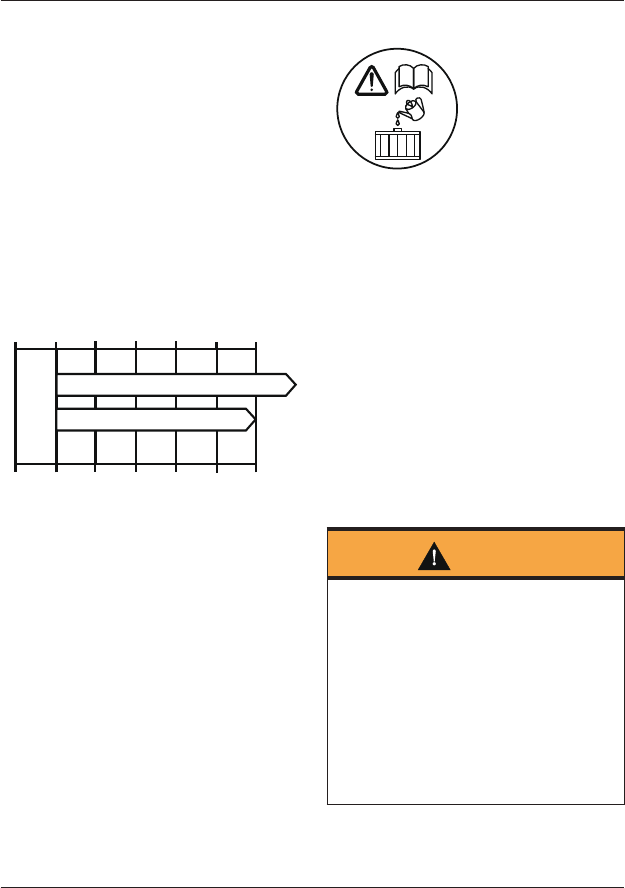
Maintenance
172
Oil Specification and Grade
Triumph's high performance fuel
injected engines are designed to use
10W/40 or 10W /50 semi or fully
synthetic motorcycle engine oil that
meets specification API SH (or higher)
and JASO MA, such as Castrol Power 1
Racing 4T 10W-40 (fully synthetic)
engine oil, sold as Castrol Power RS
Racing 4T 10W-40 (fully synthetic) in
some countries.
Refer to the chart below for the correct
oil viscosity (10W/40 or 10W/50) to be
used in your riding area.
-20
-10
0
10
20
30
40
-4
14
50
32
68
86
104
(°C)
(°F)
Ambient Temperature (°C)
Ambient Temperature (°F)
SAE 10W/50
SAE 10W/40
Oil Viscosity Temperature Range
Do not add any chemical additives to
the engine oil. The engine oil also
lubricates the clutch and any additives
could cause the clutch to slip.
Do not use mineral, vegetable, non-
detergent oil, castor based oils or any oil
not conforming to the required
specification. The use of these oils may
cause instant, severe engine damage.
Make sure that no foreign matter enters
the crankcase during an engine oil
change or top off.
Cooling System
To ensure efficient engine cooling, check
the coolant level each day before riding
the motorcycle, and top off the coolant
if the level is low.
Note:
• A year round, Hybrid Organic Acid
Technology (known as Hybrid OAT
or HOAT) coolant is installed in the
cooling system when the
motorcycle leaves the factory. It is
colored green, contains a 50%
solution of ethylene glycol based
antifreeze, and has a freezing point
of -31°F (-35°C).
Corrosion Inhibitors
Warning
HD4X Hybrid OAT coolant contains
corrosion inhibitors and antifreeze
suitable for aluminum engines and
radiators. Always use the coolant in
accordance with the instructions of
the manufacturer.
Coolant that contains anti-freeze and
corrosion inhibitors contains toxic
chemicals that are harmful to the
human body. Never swallow antifreeze
or any of the motorcycle coolant.
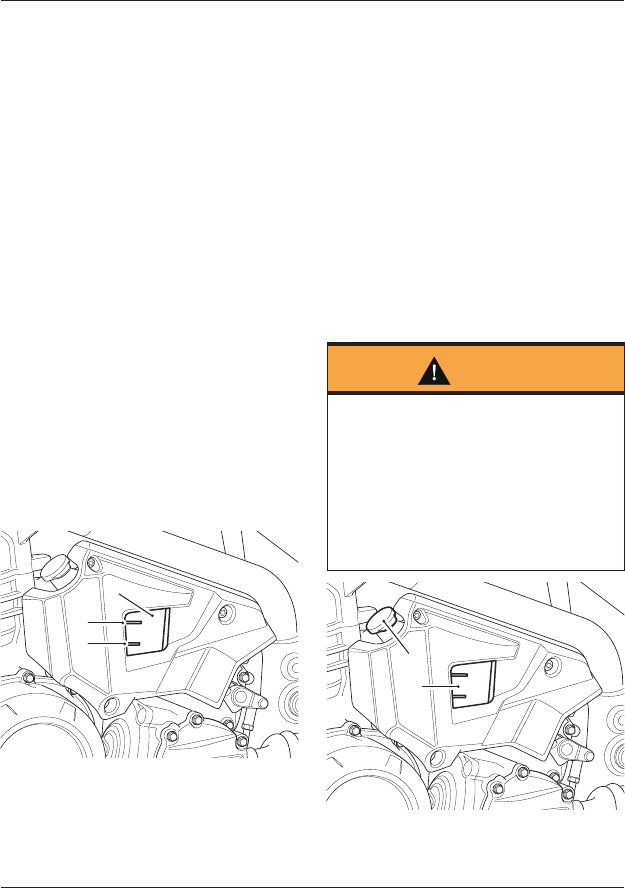
Maintenance
173
Note:
• HD4X Hybrid OAT coolant, as
supplied by Triumph, is premixed
and does not need to be diluted
prior to filling or topping off the
cooling system.
To protect the cooling system from
corrosion, the use of corrosion inhibitor
chemicals in the coolant is essential.
If coolant containing a corrosion
inhibitor is not used, the cooling system
will accumulate rust and scale in the
water jacket and radiator. This will block
the coolant passages, and considerably
reduce the efficiency of the cooling
system.
Coolant Level Inspection
Note:
• The coolant level should be checked
when the engine is cold (at room or
ambient temperature).
2
3
1
1. Expansion tank
2. MAX mark
3. MIN mark
To inspect the coolant level:
• Position the motorcycle on level
ground and in an upright position
(not on the center stand). The
expansion tank can be viewed from
the left hand side of the
motorcycle.
• Check the coolant level in the
expansion tank. The coolant level
must be between the MAX and MIN
marks. If the coolant is below the
minimum level, the coolant level
must be adjusted.
Coolant Level Adjustment
Warning
Do not remove the expansion tank cap
when the engine is hot.
When the engine is hot, the coolant
inside the radiator will be hot and also
under pressure.
Contact with this hot, pressurized
coolant will cause scalds and skin
damage.
2
1
1. Expansion tank cap
2. Expansion tank
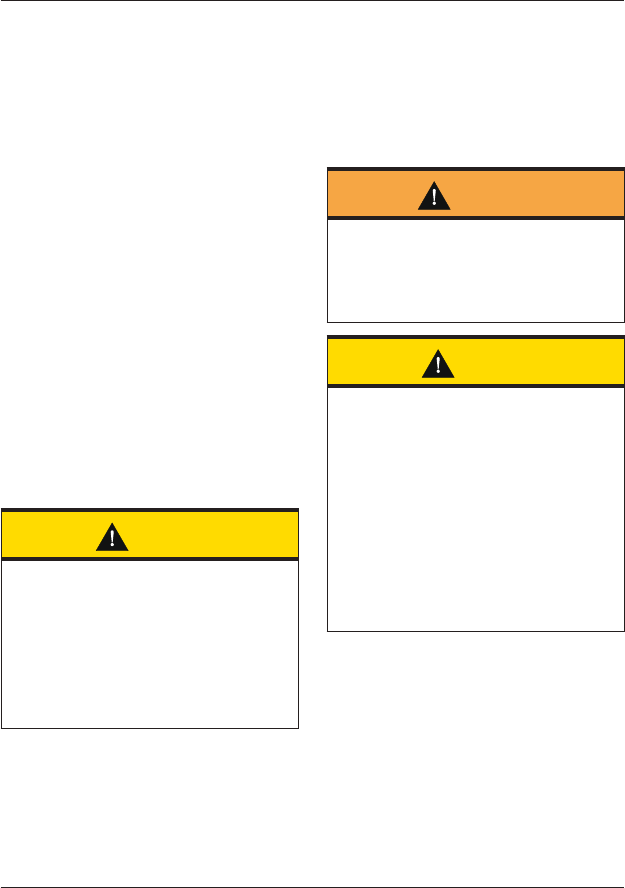
Maintenance
174
To adjust the coolant level:
• Allow the engine to cool.
• The expansion tank cap can be
removed from the left hand side of
the motorcycle.
• Remove the expansion tank cap
from the expansion tank and add
coolant mixture through the filler
opening until the level reaches the
MAX mark.
• Reinstall the expansion tank cap.
Note:
• If the coolant level is being checked
because the coolant has
overheated, also check the level in
the radiator and top off if
necessary.
• In an emergency, distilled water
can be added to the cooling system.
However, the coolant must then be
drained and replenished with HD4X
Hybrid OAT coolant as soon as
possible.
Caution
If hard water is used in the cooling
system, it will cause scale accumulation
in the engine and radiator and
considerably reduce the efficiency of
the cooling system.
Reduced cooling system efficiency may
cause the engine to overheat and
suffer severe damage.
Coolant Change
It is recommended that the coolant is
changed by an authorised Triumph
dealer in accordance with scheduled
maintenance requirements.
Radiator and Hoses
Warning
The fan operates automatically when
the engine is running. Always keep
hands and clothing away from the fan
as contact with the rotating fan can
cause injury.
Caution
Using high pressure water sprays,
such as from a car wash facility or
household pressure washer, can
damage the radiator fins, cause leaks
and impair the radiator's efficiency.
Do not obstruct or deflect airflow
through the radiator by installing
unauthorized accessories, either in
front of the radiator or behind the
cooling fan. Interference with the
radiator airflow can cause overheating,
potentially resulting in engine damage.
Check the radiator hoses for cracks or
deterioration, and hose clips for
tightness in accordance with scheduled
maintenance requirements. Have your
authorized Triumph dealer replace any
defective items.
Check the radiator grille and fins for
obstructions by insects, leaves or mud.
Clean off any obstructions with a
stream of low pressure water.
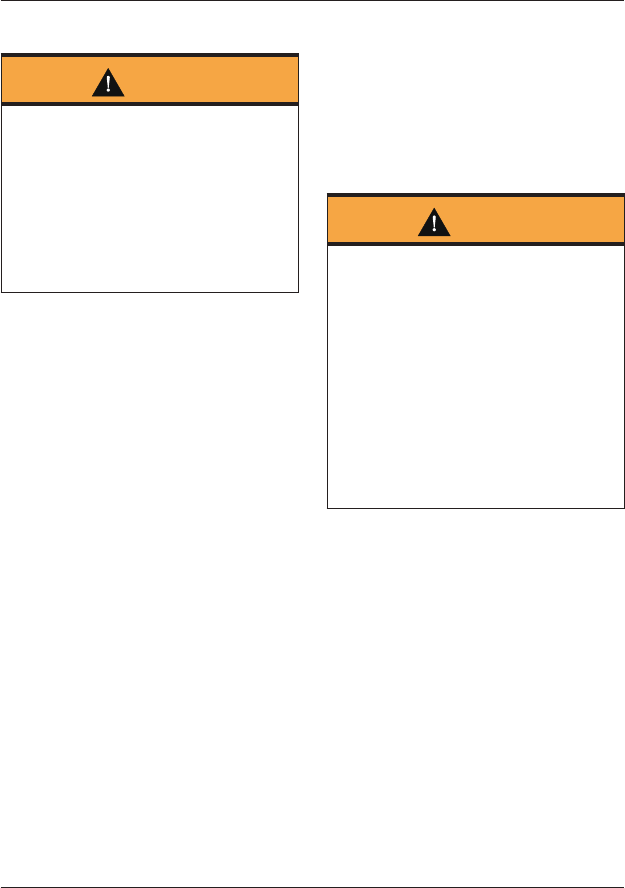
Maintenance
175
Throttle Control
Warning
Use of the motorcycle with a sticking
or damaged throttle control will
interfere with the throttle function
resulting in loss of motorcycle control
and an accident.
To avoid continued use of a sticking or
damaged throttle control, always have
it checked by your authorized Triumph
dealer.
Inspection
Check that the throttle opens smoothly,
without undue force and that it closes
without sticking. Have your authorized
Triumph dealer check the throttle
system if a problem is detected or any
doubt exists.
Check that there is 0.04 - 0.08 in
(1 - 2 mm) of throttle grip free play when
lightly turning the throttle grip back and
forth.
If there is an incorrect amount of free
play, Triumph recommends that you
have your authorized Triumph dealer
investigate.
Clutch
The motorcycle is equipped with a
hydraulically operated clutch that does
not require adjustment.
Clutch Fluid Level Inspection and
Adjustment
Warning
Use only DOT 4 specification brake and
clutch fluid as listed in the specification
section of this handbook. The use of
brake and clutch fluids other than
those DOT 4 fluids listed in the
specification section may reduce the
efficiency of the clutch system leading
to an accident.
Failure to change the brake and clutch
fluid at the interval specified in the
scheduled maintenance chart may
reduce clutch efficiency resulting in an
accident.
Inspect the level of brake and clutch
fluid in the reservoir and change the
fluid in accordance with the scheduled
maintenance requirements. Use only
DOT 4 fluid as recommended in the
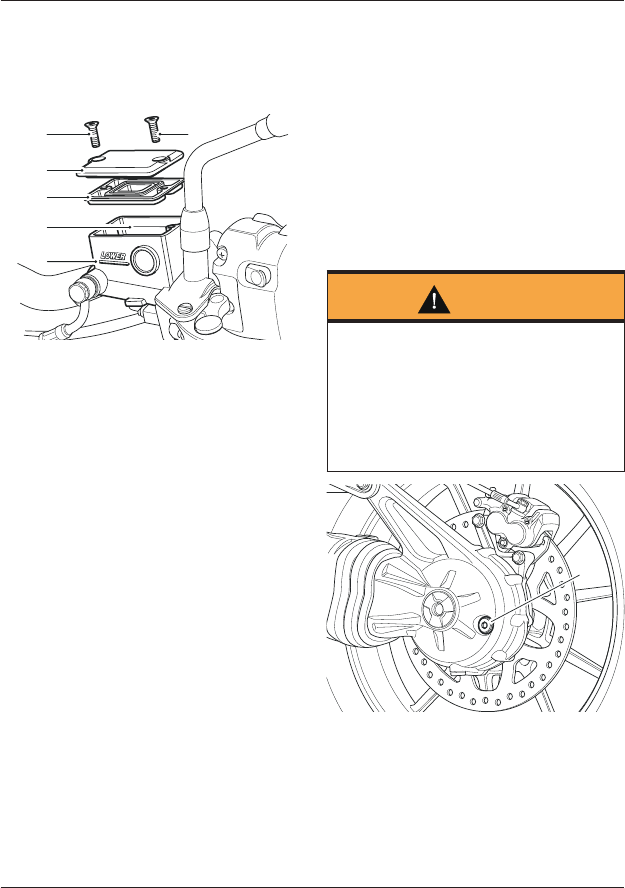
Maintenance
176
specification section. The brake and
clutch fluid must also be changed if it
becomes, or is suspected of having
become contaminated with moisture or
any other contaminants.
2
3
4
5
11
1. Reservoir cover screws
2. Reservoir cover
3. Diaphragm seal
4. Upper level line
5. Lower level line
The brake and clutch fluid in the
reservoir must be kept between the
upper and lower level lines (reservoir
held horizontal).
To adjust the brake and clutch fluid
level:
• Release the reservoir cover screws,
then remove the reservoir cover
noting the position of the
diaphragm seal.
• Fill the reservoir to the upper level
line using new DOT 4 fluid from a
sealed container.
• Reinstall the reservoir cover making
sure that the diaphragm seal is
correctly positioned between the
reservoir cover and reservoir body.
• Tighten the reservoir cover screws
to 13 lbf in (1.5 Nm).
Final Drive Unit
Other than checking the final drive oil
level, the unit contains no user
serviceable parts. If a fault occurs with
the final drive unit, your Triumph dealer
must replace the complete assembly.
Check the final drive unit for oil leaks in
accordance with the scheduled
maintenance chart.
Final Drive Oil Level Adjustment
Warning
Under no circumstances should the
final drive unit be disassembled.
Failure to observe this warning could
lead to a malfunction of the final drive
unit causing lock-up of the rear wheel
leading to loss of motorcycle control
and an accident.
1
1. Filler level plug
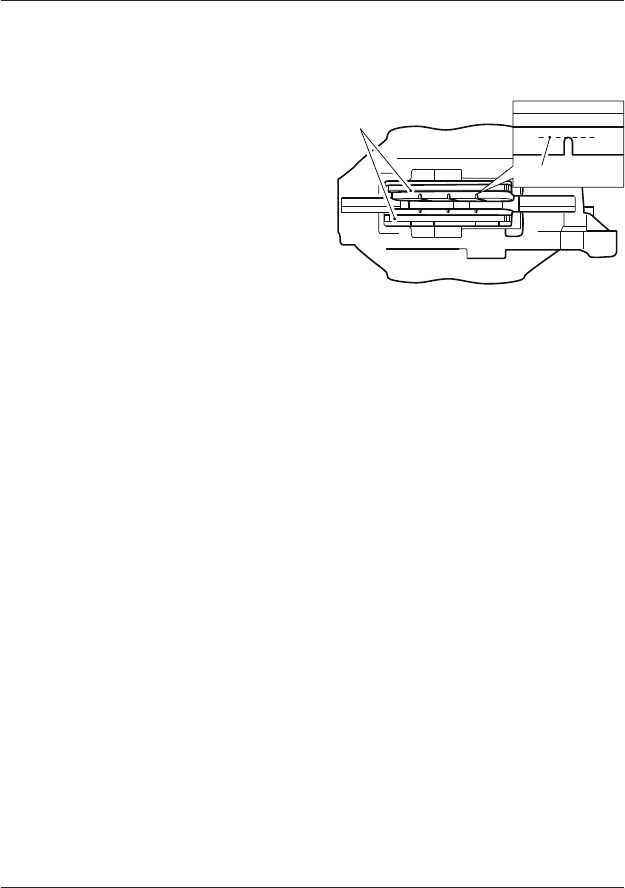
Maintenance
177
To check the oil level in the final drive
unit:
• Remove the filler level plug.
• Fill with 75W/90 fully synthetic
hypoid oil that meets specification
API Service Level GL5, such as
Castrol SAF-XO fully synthetic
hypoid oil, until the level of oil inside
the unit is level with the bottom of
the filler.
• Reinstall the plug and tighten to
18 lbf ft (25 Nm).
Brakes
Brake Wear Inspection
cbmz_2
1
2
1. Brake pads
2. Minimum thickness line
Brake pads must be inspected in
accordance with scheduled
requirements and replaced if worn to, or
beyond the minimum service thickness.
If the lining thickness of any pad (front
or rear brakes) is less than 0.06 in
(1.5 mm), that is, if the pad has worn
down to the bottom of the grooves,
replace all the pads on the wheel.
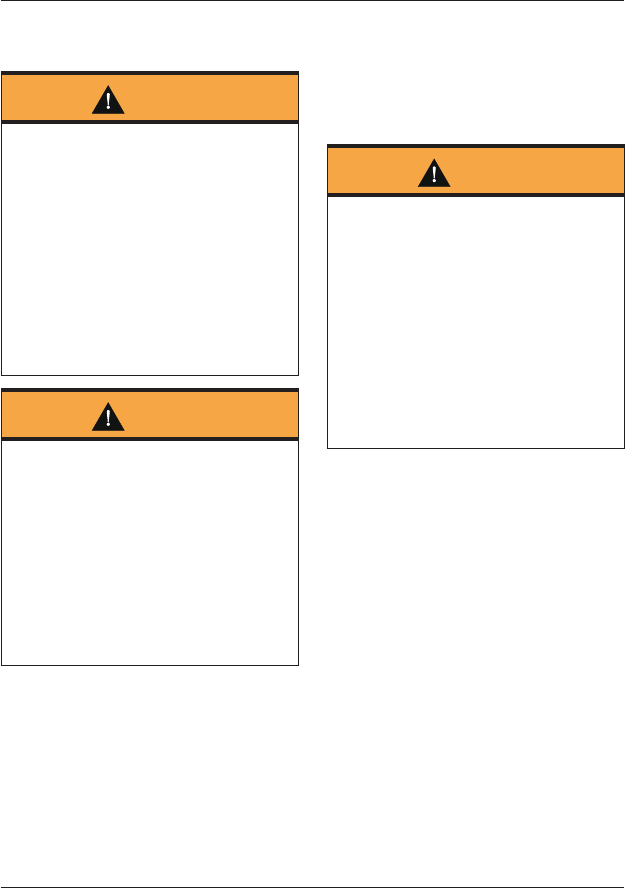
Maintenance
178
Breaking-in New Brake Discs and
Pads
Warning
Brake pads must always be replaced as
a wheel set. At the front, where two
calipers are installed on the same
wheel, replace all the brake pads in
both calipers.
Replacing individual pads will reduce
braking efficiency and may cause an
accident.
After replacement brake pads have
been mounted, ride with extreme
caution until the new pads have
broken in.
Warning
Brake pad wear will be increased if the
motorcycle is used frequently off-road.
Always inspect the brake pads more
frequently if the motorcycle is used
off-road, and replace the brake pads
before they become worn to, or beyond
the minimum service thickness.
Riding with worn brake pads may
reduce braking efficiency, leading to
loss of motorcycle control and an
accident.
Triumph recommend a period of careful
breaking-in for new brake discs and
pads that, if followed correctly, will
optimize their performance and
longevity.
The recommended distance for
breaking-in new brake discs and pads is
200 miles (300 km).
During the breaking-in period, avoid
extreme braking, ride with caution and
allow for greater braking distances.
Brake Pad Wear Compensation
Warning
If the brake lever or pedal feels soft
when it is applied, or if the lever/pedal
travel becomes excessive, there may
be air in the brake lines and hoses or
the brakes may be defective.
It is dangerous to operate the
motorcycle under such conditions and
your authorized Triumph dealer must
rectify the fault before riding.
Riding with defective brakes may lead
to loss of motorcycle control and an
accident.
Disc and brake pad wear is
automatically compensated for and has
no effect on the brake lever or pedal
action. There are no parts that require
adjustment on the front and rear
brakes.
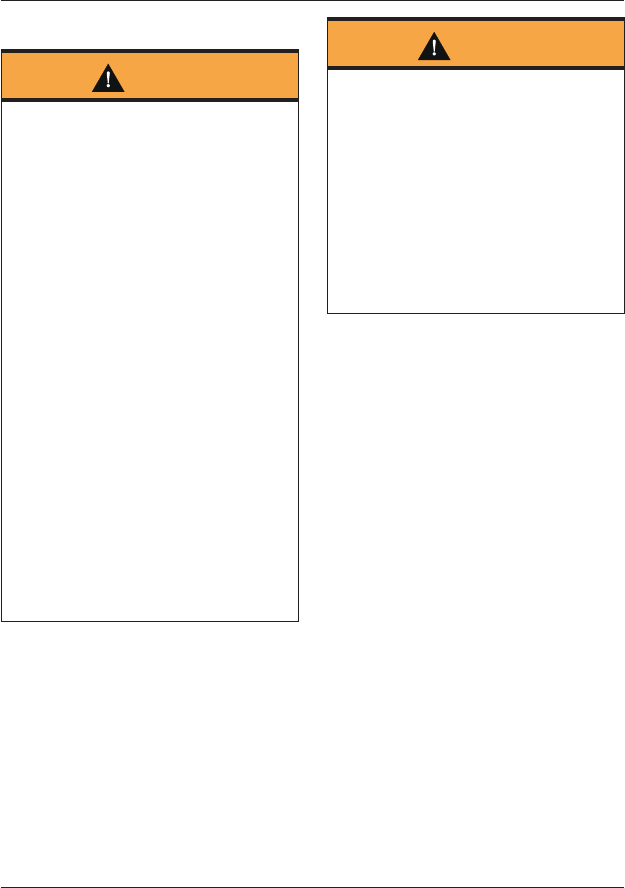
Maintenance
179
Disc Brake Fluid
Warning
Brake fluid is hygroscopic which means
it will absorb moisture from the air.
Any absorbed moisture will greatly
reduce the boiling point of the brake
fluid causing a reduction in braking
efficiency.
Because of this, always replace brake
fluid in accordance with scheduled
maintenance requirements.
Always use new brake fluid from a
sealed container and never use fluid
from an unsealed container or from
one which has been previously opened.
Do not mix different brands or grades
of brake fluid.
Check for fluid leakage around brake
installed, seals and joints and also
check the brake hoses for splits,
deterioration and damage.
Always rectify any faults before riding.
Failure to observe and act upon any of
these items may cause a dangerous
riding condition leading to loss of
control and an accident.
Warning
If the ABS is not functioning, the brake
system will continue to function as a
non-ABS equipped brake system. In
this situation, braking too hard will
cause the wheels to lock resulting in
loss of control and an accident.
Reduce speed and do not continue to
ride for longer than is necessary with
the indicator light illuminated. Contact
an authorized Triumph dealer as soon
as possible to have the fault checked
and rectified.
Inspect the level of brake fluid in both
reservoirs and change the brake fluid in
accordance with scheduled
maintenance requirements. Use only
DOT 4 fluid as recommended in the
Specification section. The brake fluid
must also be changed if it becomes, or is
suspected of having become
contaminated with moisture or any
other contaminants.
Note:
• A special tool is required to bleed
the ABS braking system. Contact
your authorized Triumph dealer
when the brake fluid needs
replacing or the hydraulic system
requires maintenance.
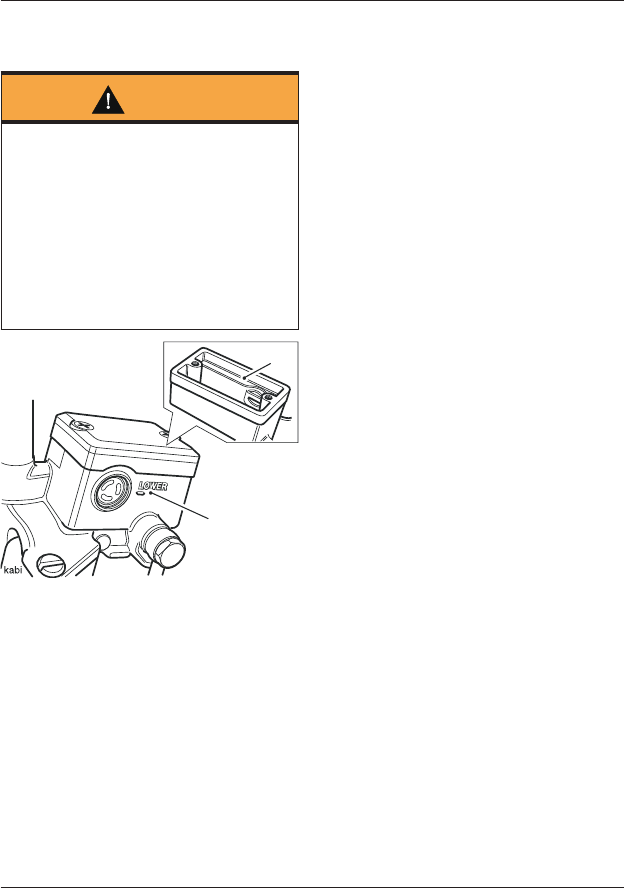
Maintenance
180
Front Brake Fluid Level Inspection
and Adjustment
Warning
If there has been an appreciable drop
in the level of the brake fluid in either
brake fluid reservoir, consult your
authorized Triumph dealer for advice
before riding.
Riding with depleted brake fluid levels,
or with a brake fluid leak is dangerous
and will cause reduced brake
performance potentially leading to loss
of motorcycle control and an accident.
2
1
1. Upper level line
2. Lower level line
The brake fluid level in the reservoirs
must be kept between the upper and
lower level lines (reservoir held
horizontal).
To inspect the front brake fluid level:
• Check the level of brake fluid visible
in the window at the front of the
reservoir body.
To adjust the front brake fluid level:
• Release the reservoir cover screws,
then remove the reservoir cover
noting the position of the
diaphragm seal.
• Fill the reservoir to the upper level
line using new DOT 4 fluid from a
sealed container.
• Reinstall the reservoir cover making
sure that the diaphragm seal is
correctly positioned between the
reservoir cover and reservoir body.
• Tighten the reservoir cover screws
to 13 lbf in (1.5 Nm).
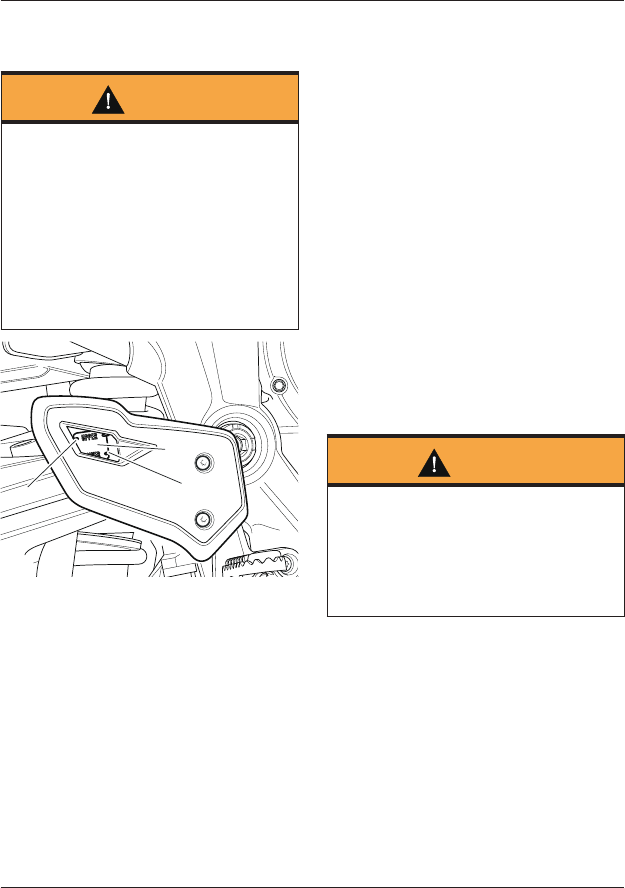
Maintenance
181
Rear Brake Fluid Inspection and
Adjustment
Warning
If there has been an appreciable drop
in the level of the brake fluid in either
brake fluid reservoir, consult your
authorized Triumph dealer for advice
before riding.
Riding with depleted brake fluid levels,
or with a brake fluid leak is dangerous
and will cause reduced brake
performance potentially leading to loss
of motorcycle control and an accident.
chgp_3
2
1
3
1. Rear brake fluid reservoir
2. Upper level line
3. Lower level line
To inspect the rear brake fluid level:
• The reservoir is visible from the
right hand side of the motorcycle,
through a viewing window in the
rider’s heel guard.
To adjust the rear brake fluid level:
• Loosen the screws and remove the
heel guard.
• Release the reservoir cover screws,
then remove the reservoir cover
and the diaphragm seal.
• Fill the reservoir to the upper level
line using new DOT 4 fluid from a
sealed container.
• Reinstall the reservoir cover making
sure that the diaphragm seal is
correctly positioned between the
reservoir cover and reservoir body.
• Tighten the reservoir cover screws
to 13 lbf in (1.5 Nm).
• Reinstall the heel guard and tighten
its screws to 62 lbf in (7 Nm).
Brake Light
Warning
Riding the motorcycle with defective
brake lights is illegal and dangerous.
An accident causing injury to the rider
and other road users may result from
use of a motorcycle with defective
brake lights.
The brake light is activated
independently by either the front or
rear brake. If, with the ignition in the ON
position, the brake light does not work
when the front brake lever is pulled or
the rear brake pedal is pressed, have
your authorized Triumph dealer
investigate and rectify the fault.
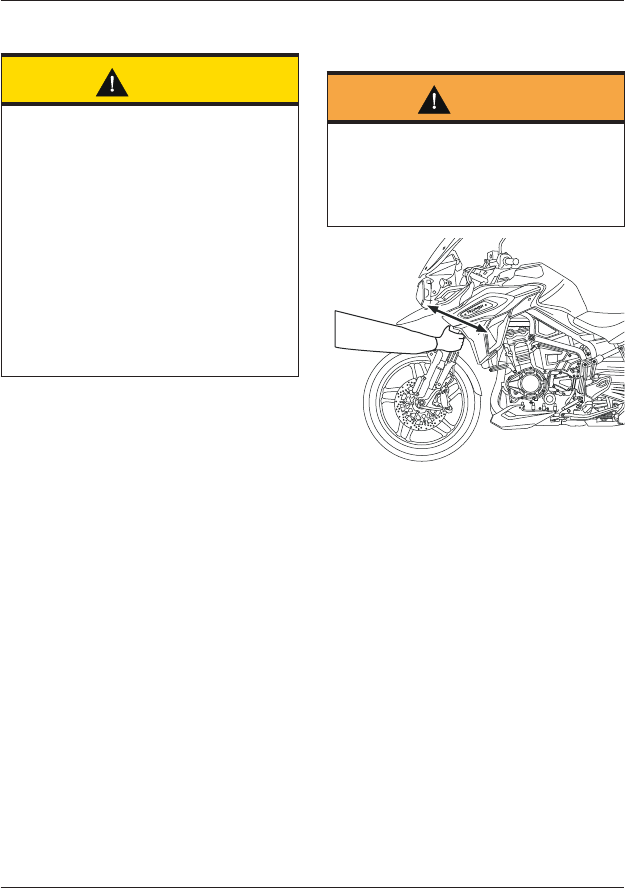
Maintenance
182
Steering/Wheel Bearings
Caution
To prevent risk of injury from the
motorcycle falling during the
inspection, make sure that the
motorcycle is stabilized and secured on
a suitable support.
Do not exert extreme force against
each wheel or rock each wheel
vigorously as this may cause the
motorcycle to become unstable and
cause injury by falling from its support.
Make sure that the position of the
support block will not cause damage to
the sump.
Steering Inspection
Lubricate and inspect the condition of
the steering (steering head) bearings in
accordance with scheduled maintenance
requirements.
Note:
• Always inspect the wheel bearings
at the same time as the steering
bearings.
Steering (Steering Head) Bearings
Inspection
Warning
Riding the motorcycle with incorrectly
adjusted or defective steering (steering
head) bearings is dangerous and may
cause loss of motorcycle control and
an accident.
Inspecting the Steering for Free Play
To inspect the steering bearings:
• Position the motorcycle on level
ground, in an upright position.
• Raise the front wheel above the
ground and support the motorcycle.
• Standing at the front of the
motorcycle, hold the lower end of
the outer tube of the front forks as
illustrated above and 'rock' with a
front-to-rear motion.
• If any free play can be detected in
the steering (headstock) bearings,
ask your authorized Triumph dealer
to inspect and rectify any faults
before riding.
• Remove the support and place the
motorcycle on the side stand.
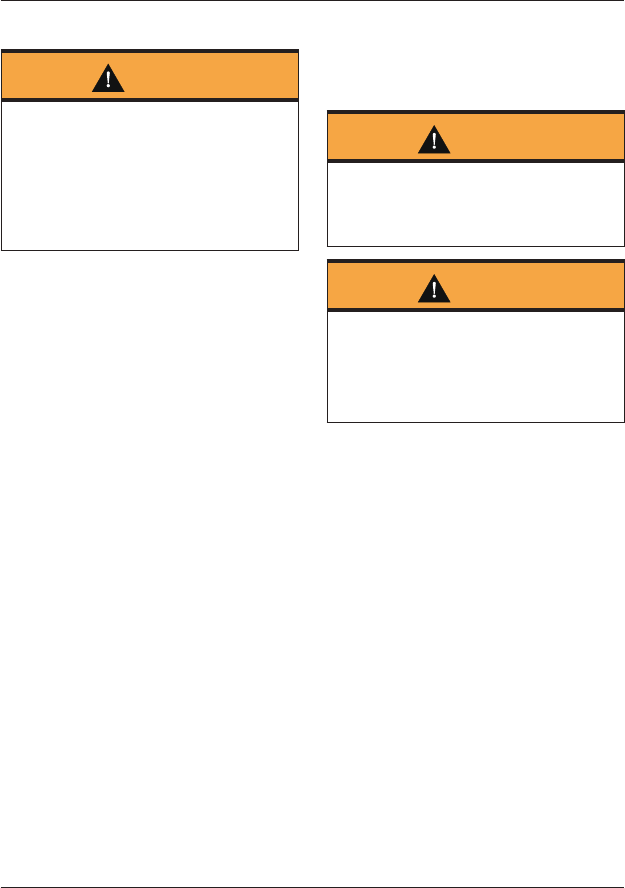
Maintenance
183
Wheel Bearings Inspection
Warning
Operation with worn or damaged front
or rear wheel bearings is dangerous
and may cause impaired handling and
instability leading to an accident.
If in doubt, have the motorcycle
inspected by an authorized Triumph
dealer before riding.
Note:
• If the wheel bearings in the front or
rear wheel allow play in the wheel
hub, are noisy, or if the wheel does
not turn smoothly, have your
authorized Triumph dealer inspect
the wheel bearings.
The wheel bearings must be inspected
at the intervals specified in the
scheduled maintenance chart.
To inspect the wheel bearings:
• Position the motorcycle on level
ground, in an upright position.
• Raise the front wheel above the
ground and support the motorcycle.
• Standing at the side of the
motorcycle, gently rock the top of
the front wheel from side to side.
• If any free play can be detected,
ask your authorized Triumph dealer
to inspect and rectify any faults
before riding.
• Reposition the lifting device and
repeat the procedure for the rear
wheel.
• Remove the support and place the
motorcycle on the side stand.
Front Suspension
Front Fork Inspection
Warning
Riding the motorcycle with defective or
damaged suspension is dangerous and
may lead to loss of motorcycle control
and an accident.
Warning
Never attempt to dismantle any part of
the suspension units, as all units
contain pressurized oil.
Skin and eye damage can result from
contact with the pressurized oil.
Examine each fork for any sign of
damage, scratching of the slider
surface, or for oil leaks.
If any damage or leakage is found,
consult an authorized Triumph dealer.
To check that the forks operate
smoothly:
• Position the motorcycle on level
ground.
• While holding the handlebars and
applying the front brake, pump the
forks up and down several times.
• If roughness or excessive stiffness
is detected, consult your authorized
Triumph dealer.
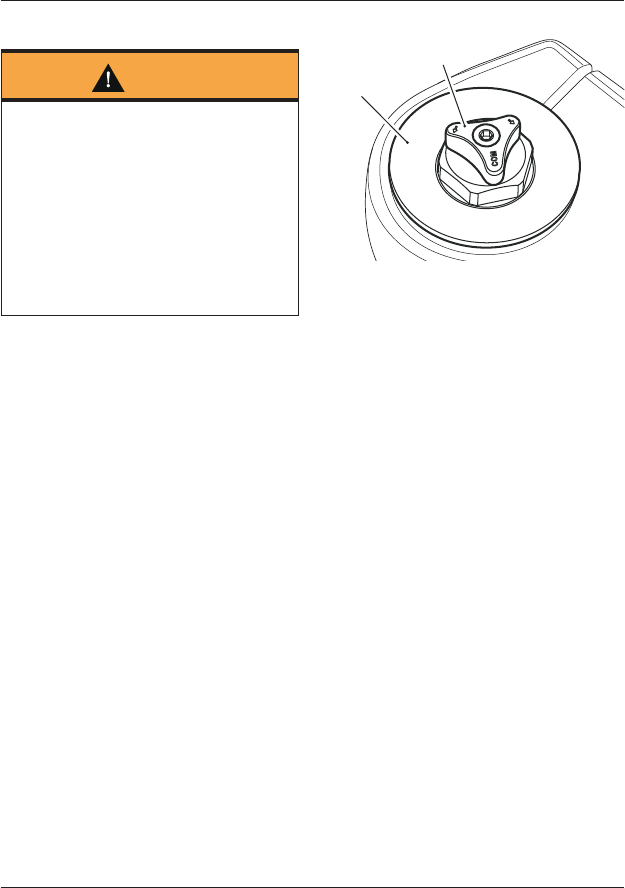
Maintenance
184
Front Suspension Adjustment
Warning
Make sure that the correct balance
between front and rear suspension is
maintained.
Suspension imbalance could signifi-
cantly change handling characteristics
leading to loss of motorcycle control
and an accident.
Refer to the front and rear suspension
setting charts for further information
or consult your dealer.
All models except Tiger 1200 XR are
equipped with Triumph Semi Active
Suspension (TSAS).
For more information on TSAS settings
and adjustment, see page 108.
Tiger 1200 XR Model
The front forks on the Tiger 1200 XR
model are adjustable for compression
damping and rebound damping.
Note:
• The Tiger 1200 XR motorcycle is
delivered from the factory with the
front suspension set at the Solo
(Normal) riding settings, as shown
in the Front Suspension Setting
Chart (see page 185).
Compression Damping Adjustment
civj
2
1
1. Compression damping adjuster (white)
2. Fork top cap
The compression damping adjuster is
located at the top of the left hand fork.
To change the compression damping
force rotate the (white) adjuster clock-
wise to increase, or counterclockwise to
decrease.
Note:
• The setting is measured as the
number of adjuster clicks counter-
clockwise from the fully clockwise
(closed) position.
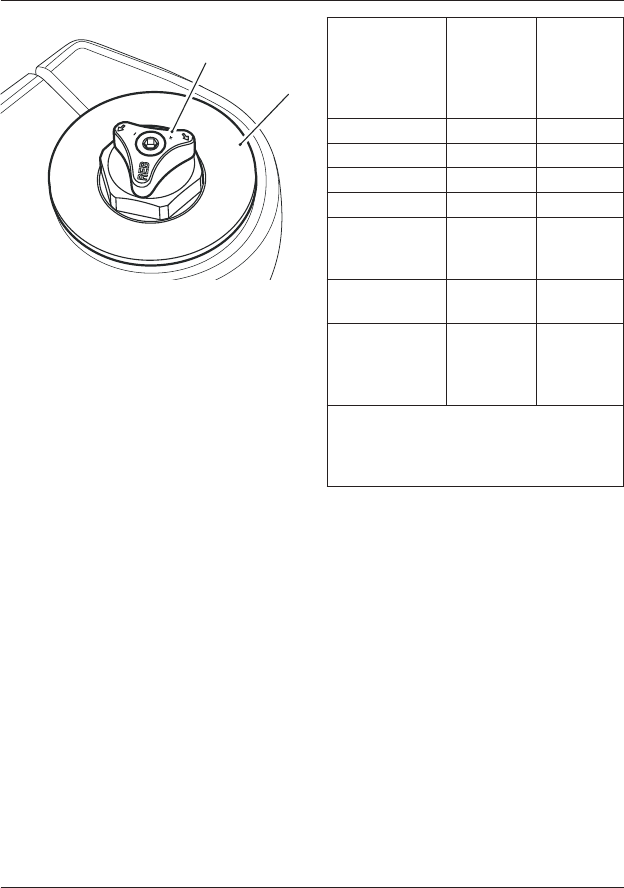
Maintenance
185
Rebound Damping Adjustment
civk
1
2
1. Rebound damping adjuster (red)
2. Fork top cap
The rebound damping adjuster is
located at the top of the right hand fork.
To change the rebound damping force,
rotate the (red) adjuster clockwise to in-
crease, or counterclockwise to decrease.
Note:
• The setting is measured as the
number of adjuster clicks counter-
clockwise from the fully clockwise
(closed) position.
Front Suspension Setting Chart
The Solo (Normal) suspension settings
provide a comfortable ride and good
handling characteristics for general, solo
riding. The following chart shows
suggested settings for the front
suspension.
Loading Compres-
sion
Damping¹
(left hand
fork)
Rebound
Damping¹
(right hand
fork)
Solo (Normal) 17 17
Solo (Comfort) 25 25
Solo (Sport) 4 4
Solo (Off-Road) 25 25
Solo (with
Loaded
Luggage Items)
13 13
Rider and
Passenger
12 12
Rider and
Passenger
(with Loaded
Luggage Items)
11 11
¹ Number of clicks counterclockwise
from the fully clockwise (closed)
position noting that the first stop (click)
is counted as 1.
Note:
• This chart is only a guide. Setting
requirements may vary for rider
weight and personal preferences.
See the following pages for
information regarding suspension
adjustment.
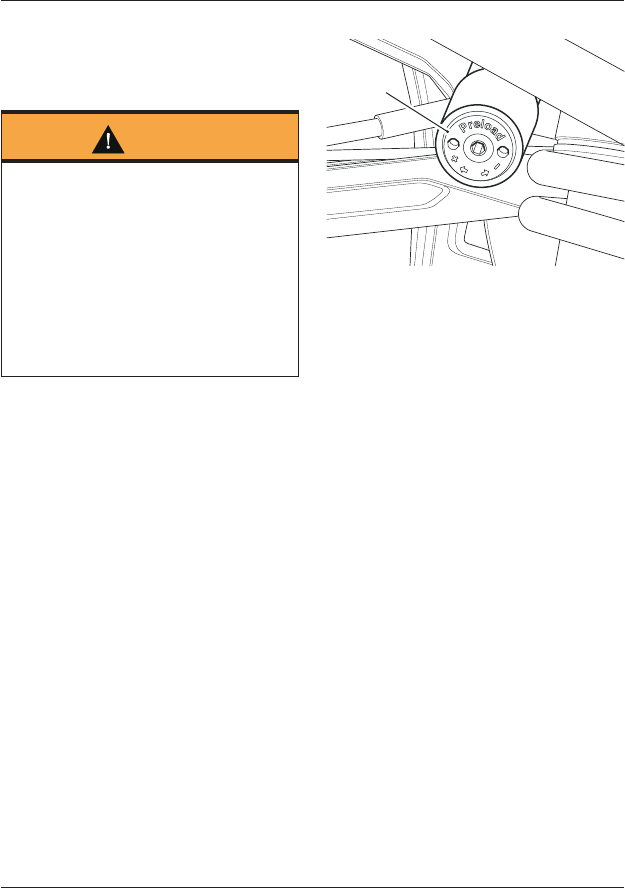
Maintenance
186
Rear Suspension
Rear Suspension Adjustment
Warning
Make sure that the correct balance
between front and rear suspension is
maintained.
Suspension imbalance could signifi-
cantly change handling characteristics
leading to loss of motorcycle control
and an accident.
Refer to the front and rear suspension
setting charts for further information
or consult your dealer.
All models except Tiger 1200 XR are
equipped with Triumph Semi Active
Suspension (TSAS).
For more information on TSAS settings
and adjustment, see page 108.
Tiger 1200 XR Model
The Rear Suspension Unit (RSU) on the
Tiger 1200 XR model is adjustable for
spring preload and rebound damping.
Note:
• The Tiger 1200 XR motorcycle is
delivered from the factory with the
rear suspension set to the Solo
(Normal) riding settings, as shown
in the Rear Suspension Setting
Chart (see page 187).
Spring Preload Adjustment
civl
1
1. Spring preload adjuster
The spring preload adjuster is situated
on the right hand side of the
motorcycle, at the top of the rear
suspension unit.
To adjust the spring preload setting
rotate the 0.2 in (5 mm) hexagon
adjuster clockwise to increase, or
counterclockwise to decrease.
Note:
• The setting is measured as the
number of adjuster turns counter-
clockwise from the fully clockwise
(closed) position.
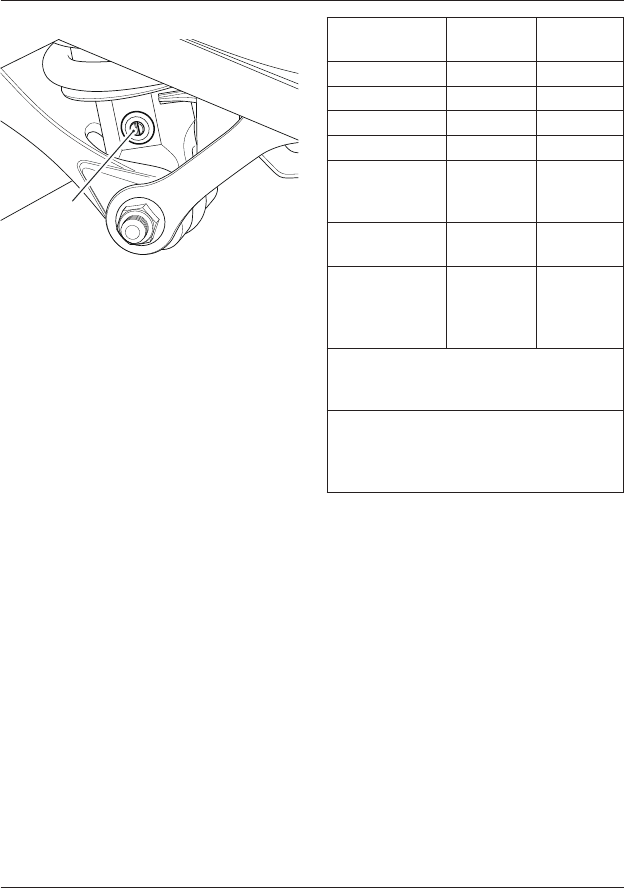
Maintenance
187
Rebound Damping Adjustment
civm
1
1. Rebound damping adjuster
The rebound damping adjuster is
located at the bottom of the rear
suspension unit and is accessible from
left hand side of the motorcycle.
To adjust the rebound damping setting,
rotate the slotted adjuster clockwise to
increase, and counterclockwise to
decrease.
Note:
• The setting is measured as the
number of adjuster clicks counter-
clockwise from the fully clockwise
(closed) position.
Rear Suspension Setting Chart
The standard suspension settings
provide a comfortable ride and good
handling characteristics for general, solo
riding. The following chart shows
suggested settings for the rear
suspension.
An increase in spring preload requires
firmer damping, a reduction in spring
preload requires softer damping.
The damping must be adjusted to the
road conditions and the spring preload.
Loading Spring
Preload¹
Rebound
Damping²
Solo (Normal) 17 8
Solo (Comfort) 17 12
Solo (Sport) 17 4
Solo (Off-Road) 17 4
Solo (With
Loaded
Luggage Items)
6 5
Rider and
Passenger
0 4
Rider and
Passenger
(with Loaded
Luggage Items)
0 3
¹ Number of turns counterclockwise
from the fully clockwise (closed)
position.
² Number of clicks counterclockwise
from the fully clockwise (closed)
position noting that the first stop (click)
is counted as 1.
Note:
• This chart is only a guide. Setting
requirements may vary for rider
weight and personal preferences.
See the following pages for
information regarding suspension
adjustment.
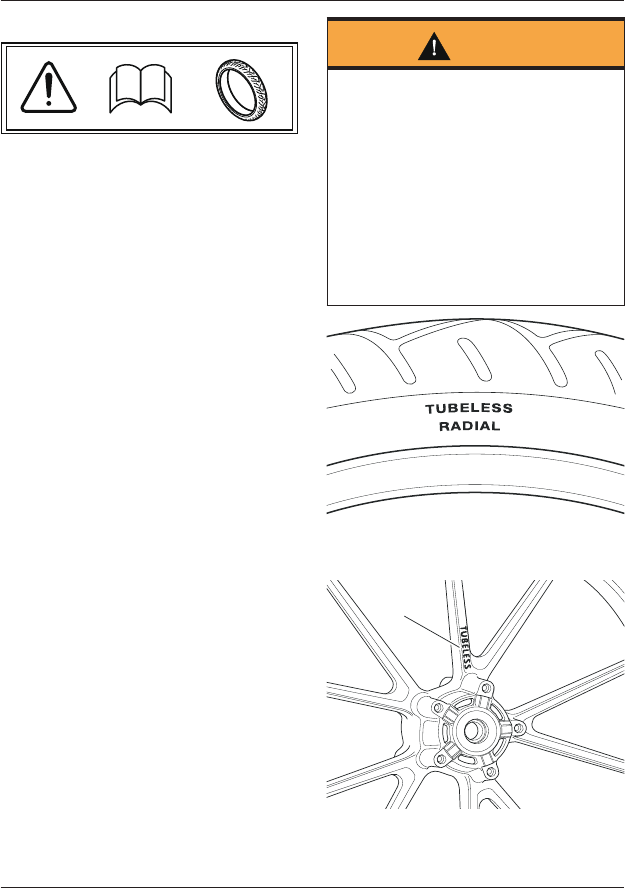
Maintenance
188
Tires
cboa
This model is equipped with tubeless
tires, valves and wheel rims. Use only
tires marked TUBELESS and tubeless
valves on rims marked SUITABLE FOR
TUBELESS TYRES.
Warning
Do not install tube-type tires on
tubeless rims. The bead will not seat
and the tires could slip on the rims,
causing rapid tire deflation that may
result in a loss of motorcycle control
and an accident. Never install an inner
tube inside a tubeless tire. This will
cause friction inside the tire and the
resulting heat build-up may cause the
tube to burst resulting in rapid tire
deflation, loss of motorcycle control
and an accident.
cfhb_1
Typical Tire Marking - Tubeless Tire
1
chez_2
Typical Tire Marking - Cast Wheel
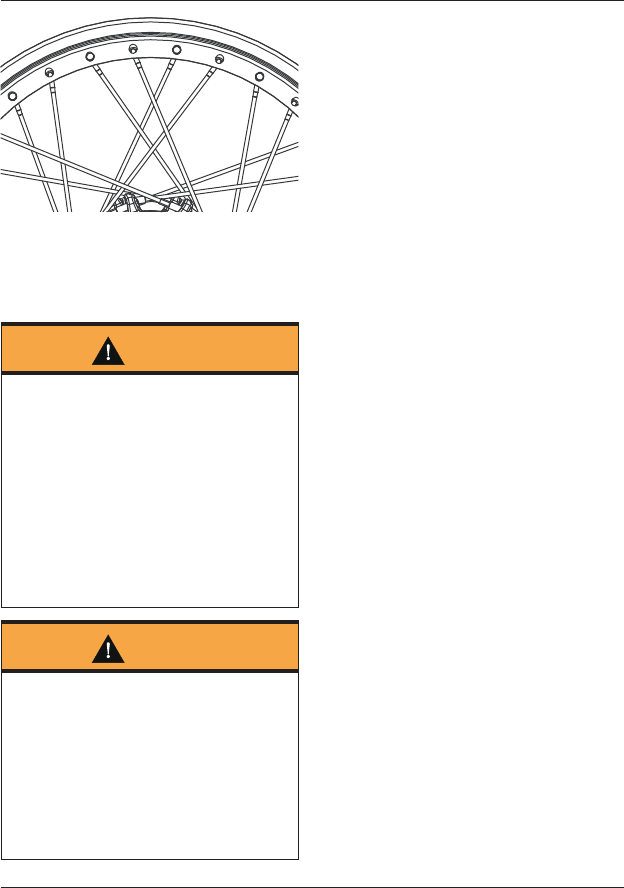
Maintenance
189
T
U
B
E
L
E
S
S
Typical Tire Marking - Spoked Wheel
Tire Inflation Pressures
Warning
Incorrect tire inflation will cause
abnormal tread wear and instability
problems which may lead to loss of
motorcycle control and an accident.
Underinflation may result in the tire
slipping on, or coming off the rim.
Overinflation will cause instability and
accelerated tread wear.
Both conditions are dangerous as they
may cause loss of motorcycle control
and an accident.
Warning
Tire pressures which have been
reduced for off-road riding will impair
on-road stability. Always make sure
that the tire pressures are set as
described in the Specification section
for on-road use.
Operation of the motorcycle with
incorrect tire pressures may cause loss
of motorcycle control and an accident.
Correct tire inflation pressures will
provide maximum stability, rider comfort
and tire life. Always check tire pressures
before riding when the tires are cold.
Check tire pressures daily and adjust if
necessary (see Specification section for
correct inflation pressures). Alternatively,
ask your authorized Triumph dealer to
inspect your wheels and tires.
Tire Pressure Monitoring System
(TPMS) (if equipped)
The tire pressures shown on your
instruments indicate the actual tire
pressure at the time of selecting the
display. This may differ from the
inflation pressure set when the tires are
cold because tires become warmer
during riding, causing the air in the tire
to expand and increase the inflation
pressure. The cold inflation pressures
specified by Triumph take account of
this.
Owners must only adjust tire pressures
when the tires are cold using an
accurate pressure gage, and must not
use the tire pressure display on the
instruments.
Tire Wear
As the tire tread wears down, the tire
becomes more susceptible to punctures
and failure. It is estimated that 90% of
all tire problems occur during the last
10% of tread life (90% worn). It is
recommended that tires are changed
before they are worn to their minimum
tread depth.
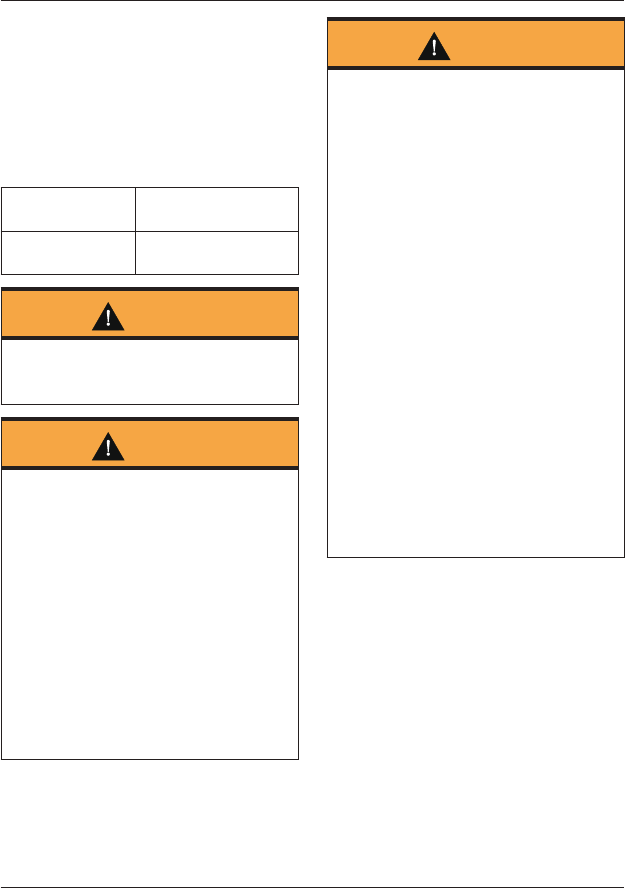
Maintenance
190
Minimum Recommended Tread
Depth
In accordance with the periodic
maintenance chart, measure the depth
of the tread with a depth gage, and
replace any tire that has worn to, or
beyond, the minimum allowable tread
depth specified in the table below:
Under 80 mph
(130 km/h)
0.08 in (2 mm)
Over 80 mph
(130 km/h)
Rear 0.12 in (3 mm)
Front 0.08 in (2 mm)
Warning
This motorcycle must not be operated
above the legal road speed limit except
in authorized closed-course conditions.
Warning
Only operate this Triumph motorcycle
at high speed in closed-course, on-
road competition or on closed-course
racetracks.
High speed operation should only then
be attempted by riders who have been
instructed in the techniques necessary
for high speed riding and are familiar
with the motorcycle's characteristics in
all conditions.
High speed operation in any other
circumstances is dangerous and will
lead to loss of motorcycle control and
an accident.
Warning
Operation with excessively worn tires
is hazardous and will adversely affect
traction, stability and handling which
may lead to loss of motorcycle control
and an accident.
When tires become punctured, leakage
is often very slow. Always inspect tires
very closely for punctures. Check the
tires for cuts, embedded nails or other
sharp objects. Operation with
punctured or damaged tires will
adversely affect stability and handling
which may lead to loss of motorcycle
control and an accident.
Check the rims for dents or
deformation and spokes for looseness
and damage. Operation with damaged
or defective wheels, spokes or tires is
dangerous and loss of motorcycle
control and an accident could result.
Always consult your authorized
Triumph dealer for tire replacement, or
for a safety inspection of the wheels,
spokes and tires.
Tire Replacement
All Triumph motorcycles are carefully
and extensively tested in a range of
riding conditions to ensure that the
most effective tire combinations are
approved for use on this model. It is
essential that approved tires, mounted
in approved combinations, are used
when purchasing replacement tires. The
use of non-approved tires, or approved
tires in non-approved combinations,
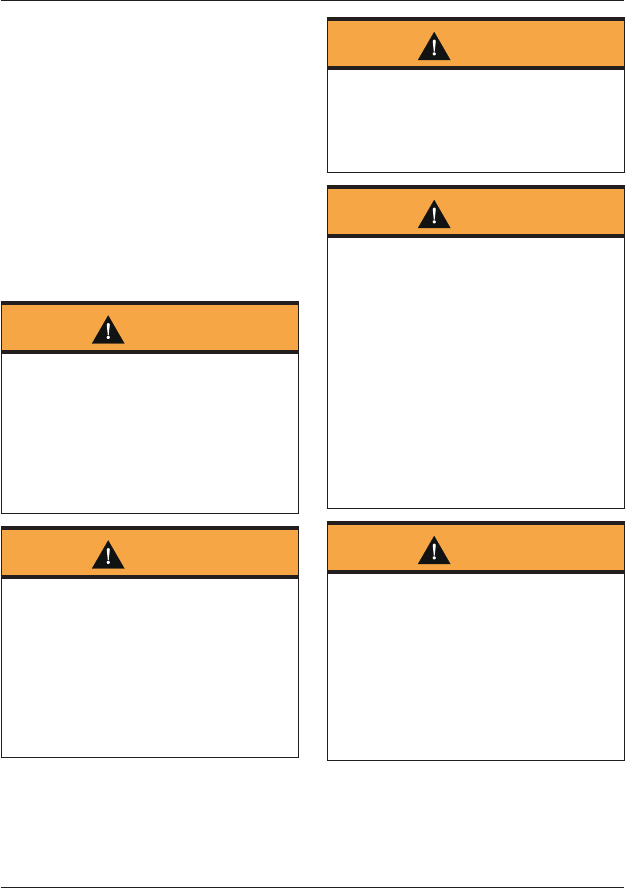
Maintenance
191
may lead to motorcycle instability and
an accident. On models equipped with
ABS, different wheel speeds, caused by
non-approved tires can affect the
function of the ABS computer.
See the Specification section for details
of approved tire combinations. Always
have tires mounted and balanced by
your authorized Triumph dealer who has
the necessary training and skills to
ensure safe, effective mounting.
Tire Pressure Monitoring System
(TPMS) (if equipped)
Warning
Use of non-recommended tires can
affect wheel speed and cause the
Triumph traction control function not
to operate, potentially leading to loss
of motorcycle control and an accident
in conditions where the Triumph
traction control would normally
function.
Warning
The ABS computer operates by
comparing the relative speed of the
front and rear wheels. Use of non-
recommended tires can affect wheel
speed and cause the ABS function not
to operate, potentially leading to loss
of motorcycle control and an accident
in conditions where the ABS would
normally function.
Warning
If a tire sustains a puncture, the tire
must be replaced. Failure to replace a
punctured tire, or operation with a
repaired tire can lead to instability, loss
of motorcycle control and an accident.
Warning
Do not install tube-type tires on
tubeless rims. The bead will not seat
and the tires could slip on the rims,
causing rapid tire deflation that may
result in a loss of vehicle control and
an accident.
Never install an inner tube inside a
tubeless tire.
This will cause friction inside the tire
and the resulting heat build-up may
cause the tube to burst resulting in
rapid tire deflation, loss of motorcycle
control and an accident.
Warning
If tire damage is suspected, such as
after striking the curb, ask your
authorized Triumph dealer to inspect
the tire both internally and externally.
Remember, tire damage may not
always be visible from the outside.
Operation of the motorcycle with
damaged tires could lead to loss of
motorcycle control and an accident.
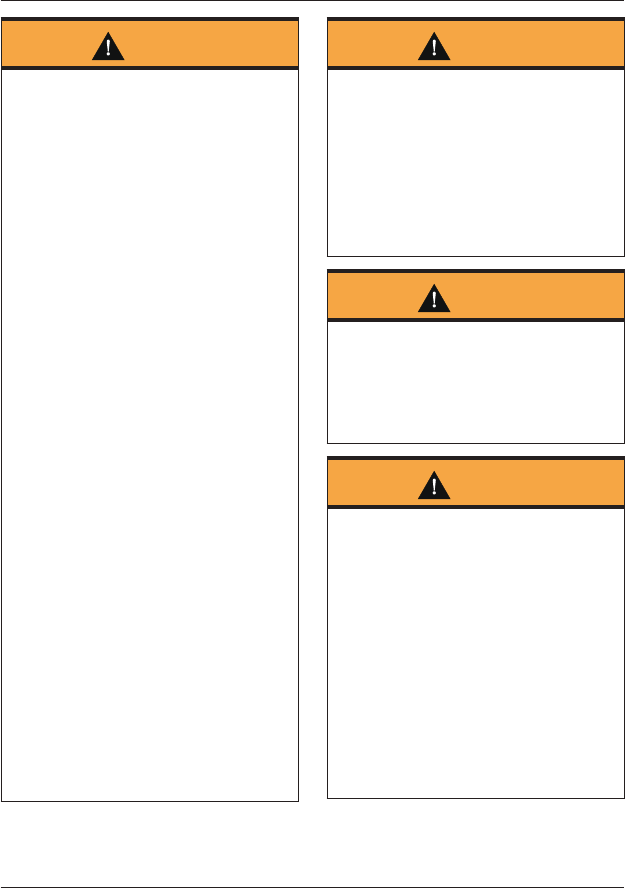
Maintenance
192
Warning
When replacement tires are required,
consult your authorized Triumph dealer
who will arrange for the tires to be
selected, in a correct combination, from
the approved list and mounted
according to the tire manufacturer's
instructions.
When tires are replaced, allow time for
the tires to seat to the rim
(approximately 24 hours). During this
seating period, ride cautiously as an
incorrectly seated tire could cause
instability, loss of motorcycle control
and an accident.
Initially, the new tires will not produce
the same handling characteristics as
the worn tires and the rider must allow
adequate riding distance
(approximately 100 miles) to become
accustomed to the new handling
characteristics.
24 hours after mounting, the tire
pressures must be checked and
adjusted, and the tires examined for
correct seating. Rectification must be
carried out as necessary.
The same checks and adjustments
must also be carried out when 100
miles have been traveled after
installation.
Use of a motorcycle with incorrectly
seated tires, incorrectly adjusted tire
pressures, or when not accustomed to
its handling characteristics may lead to
loss of motorcycle control and an
accident.
Warning
Tires that have been used on a rolling
road dynamometer may become
damaged. In some cases, the damage
may not be visible on the external
surface of the tire.
Tires must be replaced after such use
as continued use of a damaged tire
may lead to instability, loss of
motorcycle control and an accident.
Warning
Use of a motorcycle with incorrectly
seated tires, incorrectly adjusted tire
pressures, or when not accustomed to
its handling characteristics may lead to
loss of motorcycle control and an
accident.
Warning
Accurate wheel balance is necessary
for safe, stable handling of the
motorcycle. Do not remove or change
any wheel balance weights. Incorrect
wheel balance may cause instability
leading to loss of motorcycle control
and an accident.
When wheel balancing is required, such
as after tire replacement, see your
authorized Triumph dealer.
Only use self-adhesive weights. Clip-on
weights may damage the wheel and
tire resulting in tire deflation, loss of
motorcycle control and an accident.
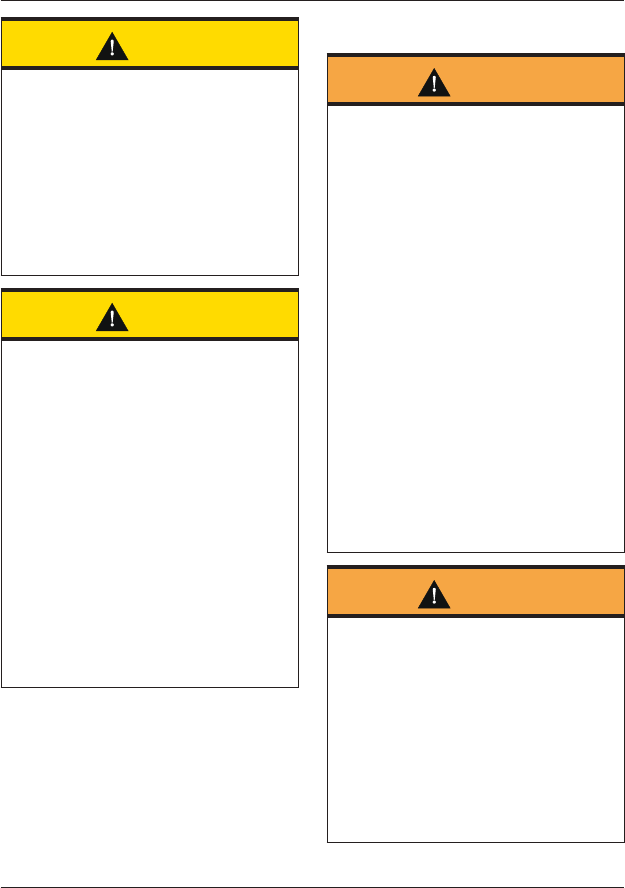
Maintenance
193
Caution
An adhesive label is installed to the
wheel rim to indicate the position of
the tire pressure sensor. Care must be
taken when replacing the tires to
prevent any damage to the tire
pressure sensors.
Always have your tires mounted by
your authorized Triumph dealer and
inform them that tire pressure sensors
are installed on the wheels.
Caution
Do not use anti puncture fluid or any
other item likely to obstruct air flow to
the TPMS sensor's orifices. Any
blockage to the air pressure orifice of
the TPMS sensor during operation will
cause the sensor to become blocked,
causing irreparable damage to the
TPMS sensor assembly.
Damage caused by the use of anti
puncture fluid or incorrect
maintenance is not considered a
manufacturing defect and will not be
covered under warranty.
Always have your tires mounted by
your authorized Triumph dealer and
inform them that tire pressure sensors
are installed on the wheels.
Battery
Warning
Under some circumstances, the
battery can give off explosive gases;
keep sparks, flames and cigarettes
away. Provide adequate ventilation
when charging or using the battery in
an enclosed space.
The battery contains sulfuric acid
(battery acid). Contact with skin or
eyes may cause severe burns. Wear
protective clothing and a face shield.
If battery acid gets on your skin, flush
with water immediately.
If battery acid gets in your eyes, flush
with water for at least 15 minutes and
SEEK MEDICAL ATTENTION
IMMEDIATELY.
If battery acid is swallowed, drink large
quantities of water and SEEK MEDICAL
ATTENTION IMMEDIATELY.
KEEP BATTERY ACID OUT OF THE
REACH OF CHILDREN.
Warning
The battery contains harmful
materials. Always keep children away
from the battery whether or not it is
installed in the motorcycle.
Do not attach jump leads to the
battery, touch the battery cables
together or reverse the polarity of the
cables as any of these actions may
cause a spark which would ignite
battery gases causing a risk of
personal injury.
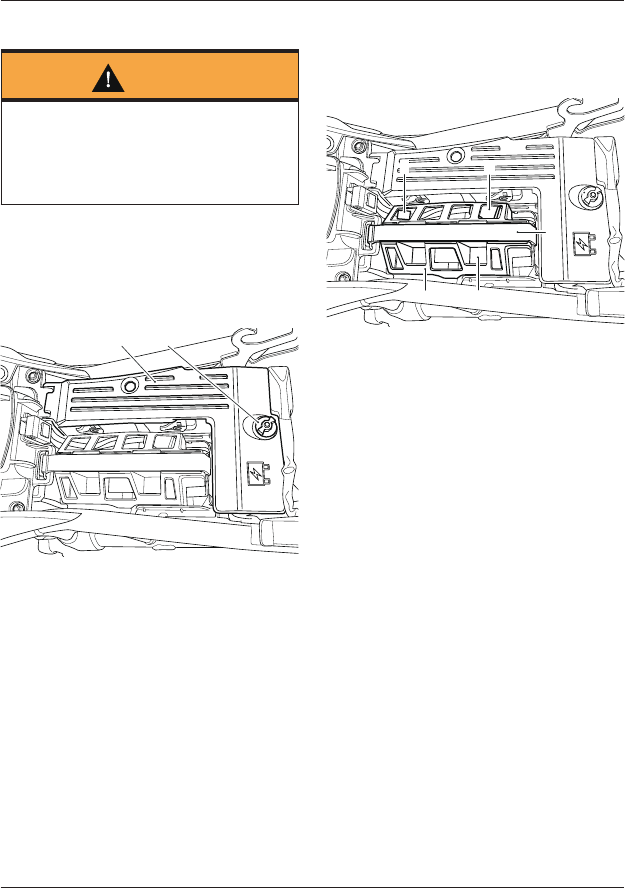
Maintenance
194
Battery Removal
Warning
Make sure that the battery terminals
do not touch the motorcycle frame as
this may cause a short circuit or spark,
which would ignite battery gases
causing a risk of personal injury.
To remove the battery:
• Remove the rider's seat.
• Remove the wing nut and remove
the chassis Electronic Control
Module (ECM) cover.
1 2
1. Chassis ECM cover
2. Wing nut
• Remove the battery strap and the
battery cover.
• Disconnect the battery leads,
negative (black) lead first.
12
3
45
1. Negative (black) terminal
2. Positive (red) terminal
3. Battery strap
4. Battery
5. Battery cover
• Take the battery out of the case.
Battery Disposal
Should the battery ever require
replacement, the original battery must
be handed to a recycling agent who will
make sure that the dangerous
substances from which the battery is
manufactured do not pollute the
environment.
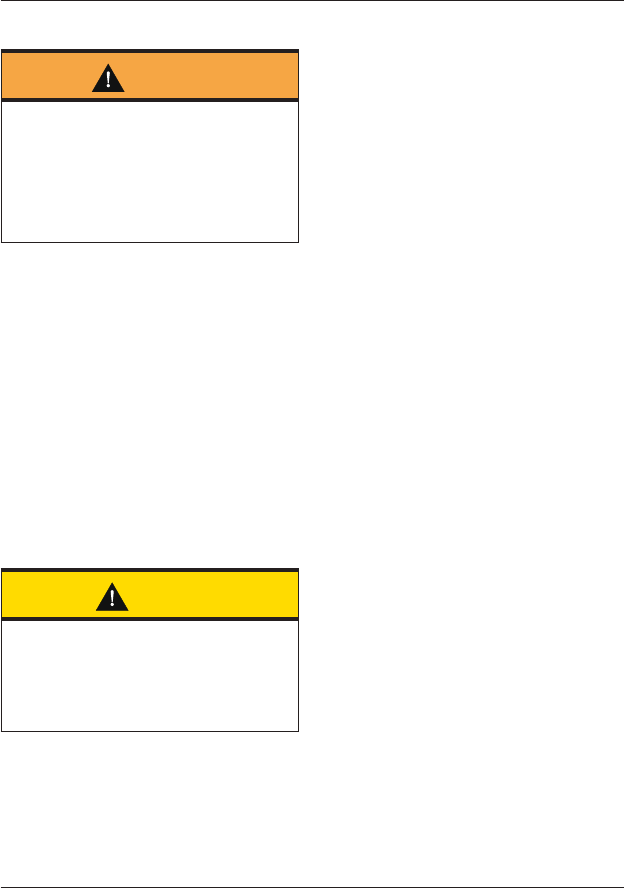
Maintenance
195
Battery Maintenance
Warning
Battery acid is corrosive and poisonous
and will cause damage to unprotected
skin. Never swallow battery acid or
allow it to come into contact with the
skin. To prevent injury, always wear
eye and skin protection when handling
the battery.
Clean the battery using a clean, dry
cloth. Make sure that the cable
connections are clean.
The battery is a sealed type and does
not require any maintenance other than
checking the voltage and routine
recharging when required, such as
during storage (see the following
paragraphs).
It is not possible to adjust the battery
acid level in the battery; the sealing
strip must not be removed.
Battery Discharge
Caution
The charge level in the battery must be
maintained to maximize battery life.
Failure to maintain the battery charge
level could cause serious internal
damage to the battery.
Under normal conditions, the motorcycle
charging system will keep the battery
fully charged. However, if the
motorcycle is unused, the battery will
gradually discharge due to a normal
process called self discharge; the clock,
Engine Control Module (ECM) memory,
high ambient temperatures, or the
addition of electrical security systems or
other electrical accessories will all
increase this rate of battery discharge.
Disconnecting the battery from the
motorcycle during storage will reduce
the rate of discharge.
Battery Discharge During Storage
and Infrequent Use of the
Motorcycle
During storage or infrequent use of the
motorcycle, inspect the battery voltage
weekly using a digital multimeter. Follow
the manufacturer’s instructions
supplied with the meter.
Should the battery voltage fall below
12.7 Volts, the battery should be
charged.
Allowing a battery to discharge or
leaving it discharged for even a short
period of time causes sulphation of the
lead plates. Sulphation is a normal part
of the chemical reaction inside the
battery, however over time the sulphate
can crystallize on the plates making
recovery difficult or impossible. This
permanent damage is not covered by
the motorcycle warranty, as it is not
due to a manufacturing defect.
Keeping the battery fully charged
reduces the likelihood of it freezing in
cold conditions. Allowing a battery to
freeze will cause serious internal
damage to the battery.
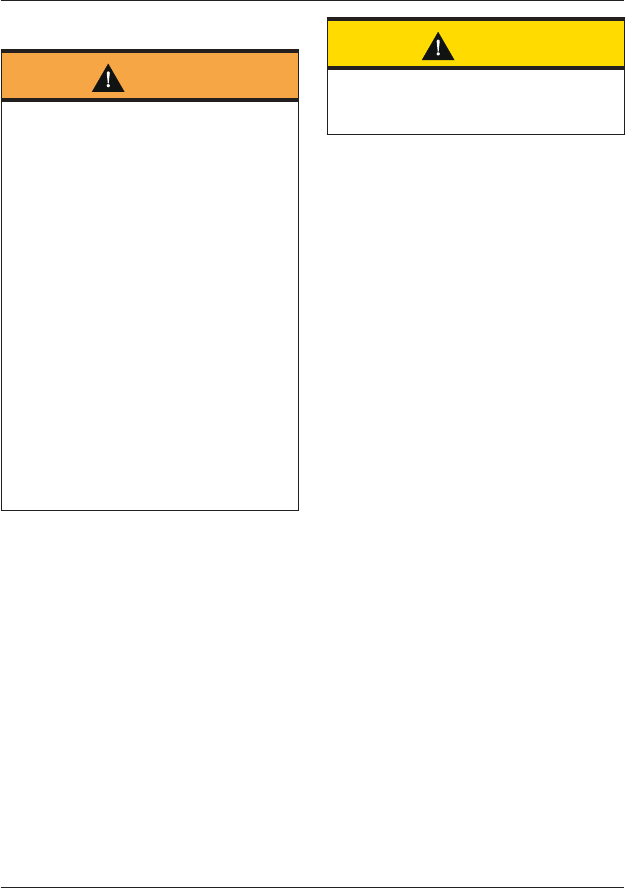
Maintenance
196
Battery Charging
Warning
The battery gives off explosive gases;
keep sparks, flames and cigarettes
away. Provide adequate ventilation
when charging or using the battery in
an enclosed space.
The battery contains sulfuric acid
(battery acid). Contact with skin or
eyes may cause severe burns. Wear
protective clothing and a face shield.
If battery acid gets on your skin, flush
with water immediately.
If battery acid gets in your eyes, flush
with water for at least 15 minutes and
SEEK MEDICAL ATTENTION IMMEDIATELY.
If battery acid is swallowed, drink large
quantities of water and SEEK MEDICAL
ATTENTION IMMEDIATELY.
KEEP BATTERY ACID OUT OF THE
REACH OF CHILDREN.
Caution
Do not use an automotive quick
charger as it may overcharge and
damage the battery.
For help with selecting a battery
charger, checking the battery voltage or
battery charging, contact your local
authorized Triumph dealer.
Should the battery voltage fall below 12.7
Volts, the battery should be charged
using a Triumph approved battery
charger. Always remove the battery
from the motorcycle and follow the
instructions supplied with the battery
charger.
For extended periods of storage (beyond
two weeks) the battery should be
removed from the motorcycle and kept
charged using a Triumph approved
maintenance charger.
Similarly, should the battery charge fall
to a level where it will not start the
motorcycle, remove the battery from
the motorcycle before charging.
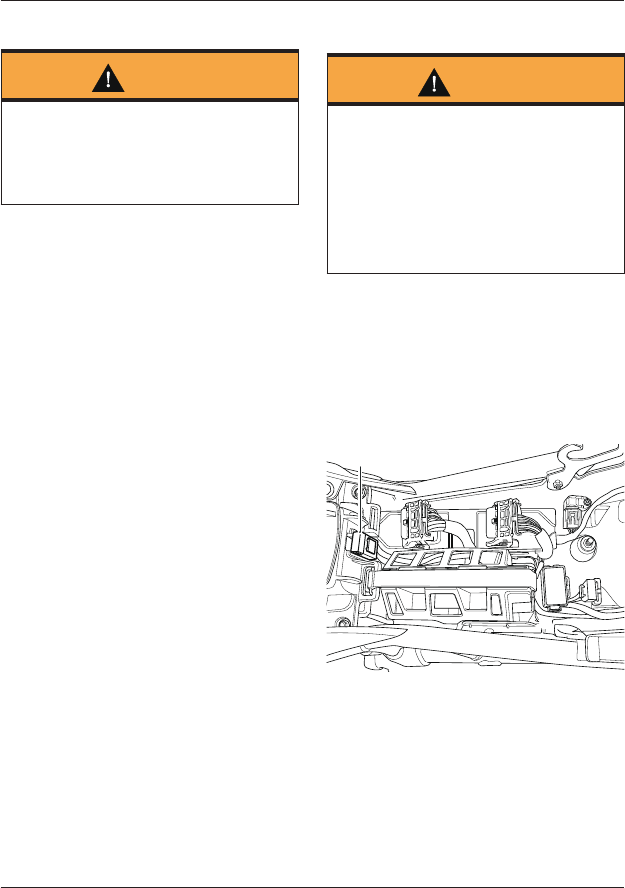
Maintenance
197
Battery Installation
Warning
Make sure that the battery terminals
do not touch the motorcycle frame as
this may cause a short circuit or spark,
which would ignite battery gases
causing a risk of personal injury.
To install the battery:
• Place the battery in the battery
case.
• Reconnect the battery, positive
(red) lead first.
• Apply a light coat of grease to the
terminals to prevent corrosion.
• Cover the positive terminal with the
protective cap.
• Re-install the battery strap.
• Reinstall the chassis ECM cover and
secure with the wing nut. Tighten
the wing nut to 11 lbf in (1.25 Nm).
• Reinstall the rider's seat.
Note:
• After reconnecting the battery, it is
necessary to allow the TSAS
system (if equipped) to recalibrate,
see page 108.
Fuse Boxes
Warning
Always replace blown fuses with new
ones of the correct rating (as specified
on the fuse box cover) and never use a
fuse of higher rating.
Use of an incorrect fuse could lead to
an electrical problem, resulting in
motorcycle damage, loss of motorcycle
control and an accident.
Main Fuse
The 40 Amp main fuse is located
beneath the rider's seat and behind the
seat bridge.
To access the main fuse, the rider’s seat
must be removed.
1
1. Main fuse
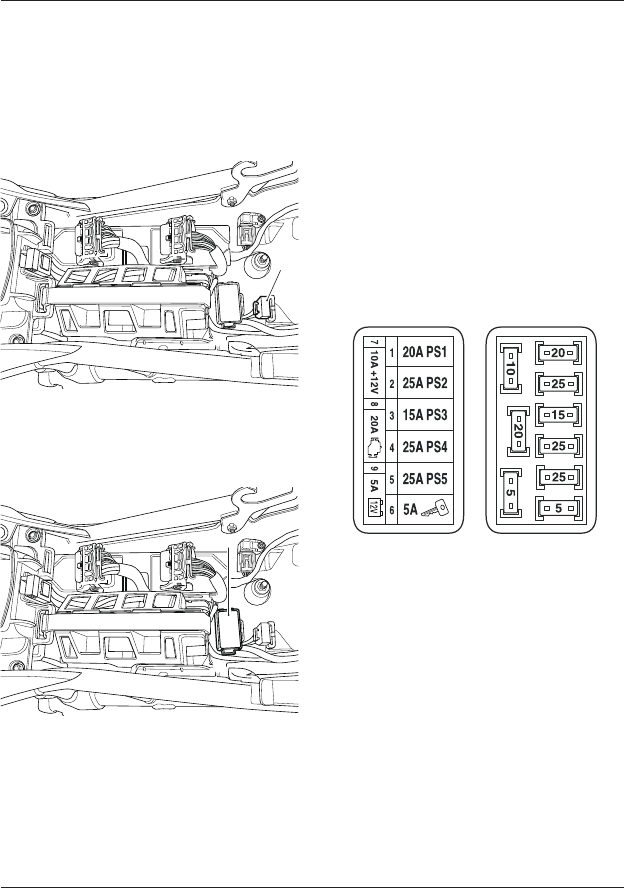
Maintenance
198
ABS Fuse
The 40 Amp ABS fuse is located beneath
the rider's seat and behind the main
fuse box.
To access the ABS fuse box, the rider’s
seat and chassis ECM cover must be
removed.
1
1. ABS fuse box
Fuse Box
1
1. Fuse box
The fuse box that contains all other
fuses is located beneath the rider’s seat.
To access the fuse box, the rider’s seat
and chassis ECM cover must be removed.
Fuse Identification
A blown fuse is indicated when all of the
systems protected by that fuse become
inoperative. When checking for a blown
fuse, use the tables to establish which
fuse has blown.
The fuse identification numbers listed in
the tables correspond with those
printed on the fuse box cover, as shown
below.
Spare fuses are located on the inside of
the fuse box cover and should be
replaced if used.
Tiger 1200 XR Only
Fuse Box and Cover
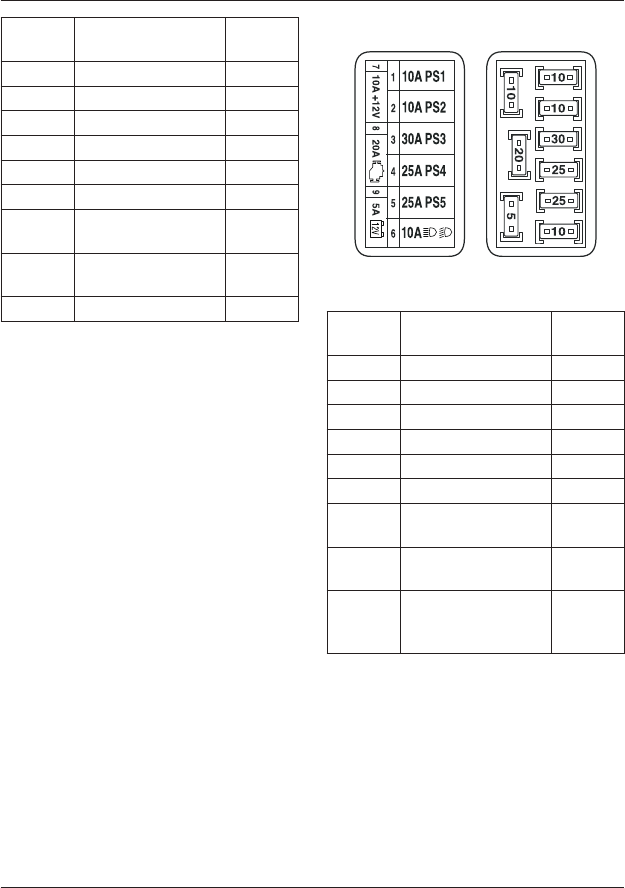
Maintenance
199
Position Circuit Protected Rating
(Amps)
1 PS1 20
2 PS2 25
3 PS3 15
4 PS4 25
5 PS5 25
6 Ignition 5
7 Front Accessory
Socket
10
8 Engine
Management
20
9 Instruments 5
Note:
• Refer to the table on page 200 for
details of the systems protected by
fuses PS1 to PS5.
All Models except Tiger 1200 XR
Fuse Box and Cover
Position Circuit Protected Rating
(Amps)
1 PS1 10
2 PS2 10
3 PS3 30
4 PS4 25
5 PS5 25
6 Headlights 10
7 Front Accessory
Socket
10
8 Engine
Management
20
9 Instruments and
Electronic Steering
Lock (ESL)
5
Note:
• Refer to the table on page
200 for
details of the systems protected by
fuses PS1 to PS5.
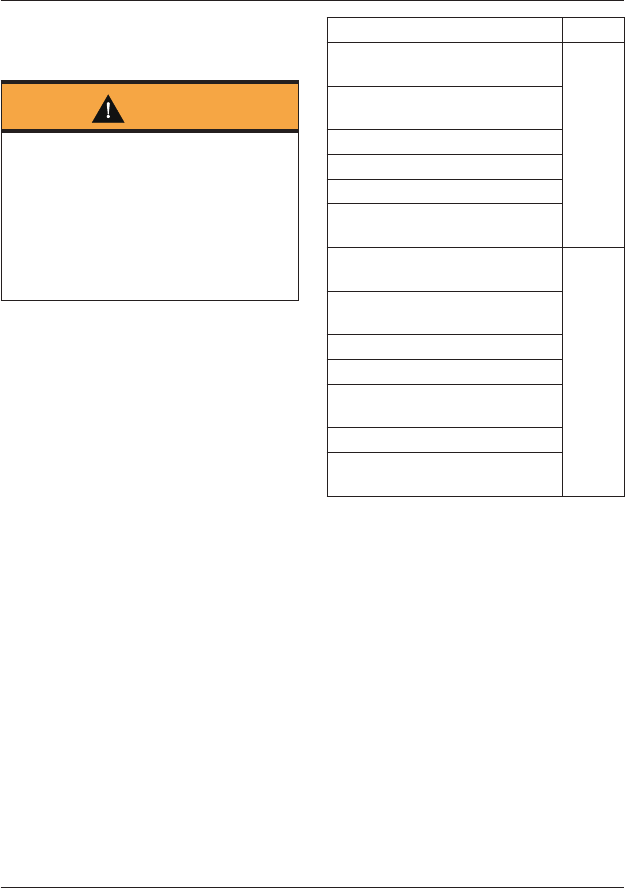
Maintenance
200
Chassis Electronic Control
Module (Chassis ECM)
Warning
Always replace blown fuses with new
ones of the correct rating (as specified
on the fuse box cover) and never use a
fuse of higher rating.
Use of an incorrect fuse could lead to
an electrical problem, resulting in
motorcycle damage, loss of motorcycle
control and an accident.
Many of the motorcycle’s electrical
systems (such as lighting, TSAS
if equipped, horn, cooling fan, fuel pump,
and accessories such as heated grips or
seats) are controlled by a Chassis
Electronic Control Module (Chassis ECM).
The chassis ECM provides a primary
level of protection to the electrical
systems it controls. If a fault is
detected, the chassis ECM will
automatically cut power to the affected
system.
The chassis ECM can be reset by
turning the Ignition off then on again.
Power will be restored to the inoperative
system, providing that the condition
that caused the fault has been rectified.
The systems controlled by the chassis
ECM are also provided with a secondary
level of protection, by fuses PS1 to
PS5 in the main fuse box (see page 199).
A blown fuse is likely when all of the
systems protected by that fuse become
inoperative.
Refer to the following table for full
details of the chassis ECM controlled
systems, and their corresponding fuses.
Electrical System Fuse
Left headlight main beam
(Tiger 1200 XR only)
PS1
Left headlight dipped beam
(Tiger 1200 XR only)
Left front turn signal
Left rear turn signal
Rear position light
RSU position sensor (models
with TSAS only)
Right headlight main beam
(Tiger 1200 XR only)
PS2
Right headlight dipped beam
(Tiger 1200 XR only)
Right front turn signal
Right rear turn signal
Front position light (Tiger 1200
XR only)
Brake light
Ignition (All models except
Tiger 1200 XR)
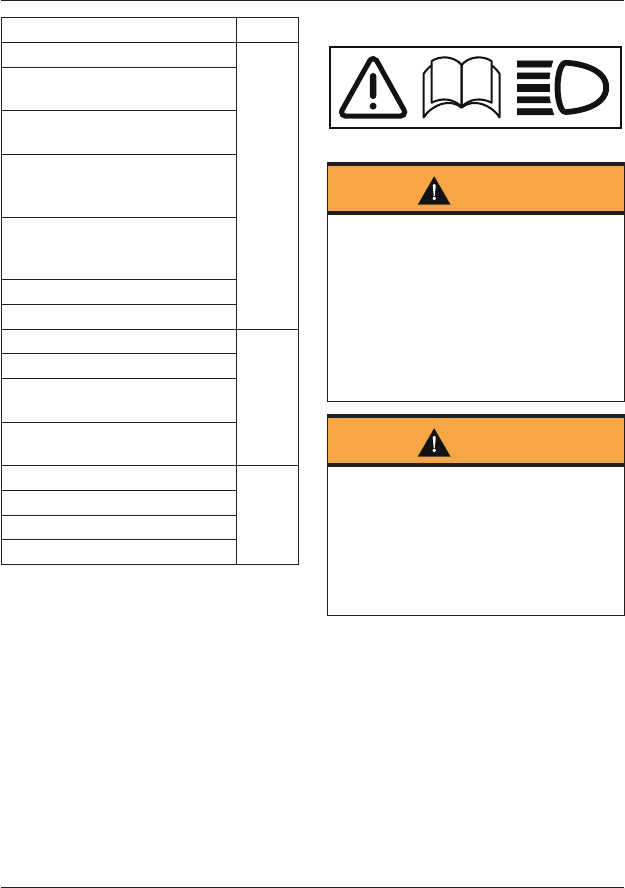
Maintenance
201
Electrical System Fuse
Windshield adjustment motor PS3
RSU preload adjustment motor
(models with TSAS only)
RSU damping solenoid (models
with TSAS only)
Front suspension compression
damping adjustment motor
(models with TSAS only)
Front suspension rebound
damping adjustment motor
(models with TSAS only)
Fog lights (if equipped)
USB connector
Heated seats (if equipped) PS4
Heated grips (if equipped)
Rear electrical accessory
socket (if equipped)
Top box electrical accessory
socket (if equipped)
Cooling fan PS5
Fuel pump
Starter solenoid
Horn
If after resetting the automatic
software protection system or replacing
a blown fuse, a fault still persists,
contact an authorized Triumph dealer to
have the fault checked and rectified.
Headlights
Warning
Adjust road speed to suit the visibility
and weather conditions in which the
motorcycle is being operated.
Make sure that the beams are adjusted
to illuminate the road surface
sufficiently far ahead without blinding
oncoming traffic. An incorrectly
adjusted headlight may impair visibility
causing an accident.
Warning
Never attempt to adjust a headlight
beam when the motorcycle is in
motion.
Any attempt to adjust a headlight
beam when the motorcycle is in motion
may result in loss of motorcycle control
and an accident.
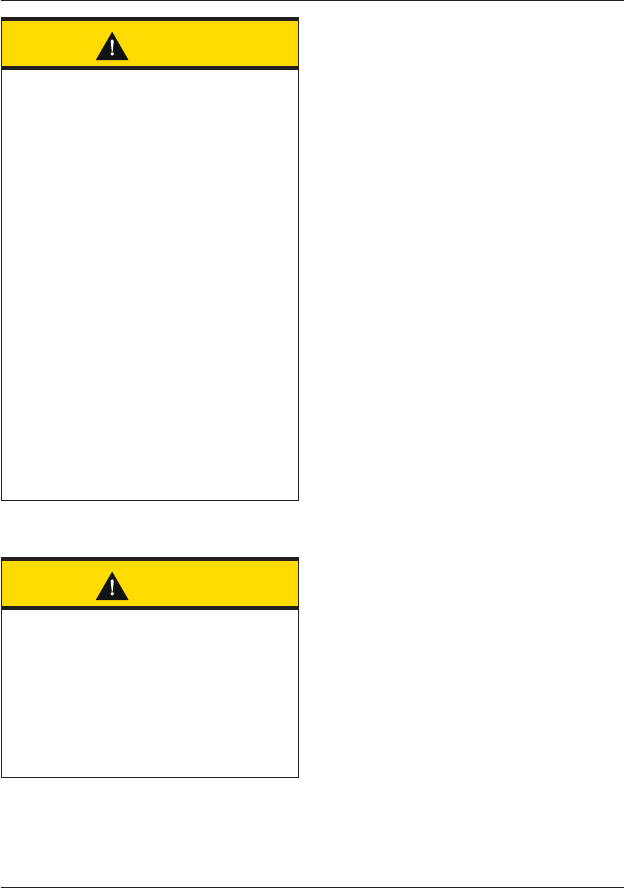
Maintenance
202
Caution
Do not cover the headlight or lens with
any item likely to obstruct air flow to,
or prevent heat escaping from, the
headlight lens.
Covering the headlight lens during
operation with items of clothing,
luggage, adhesive tape, devices
intended to alter or adjust the
headlight beam or non genuine
headlight lens covers will cause the
headlight lens to overheat and distort,
causing irreparable damage to the
headlight assembly.
Damage caused by overheating is not
considered a manufacturing defect and
will not be covered under warranty.
If the headlight must be covered
during use – such as taping of the
headlight lens required during closed-
course conditions – the headlight must
be disconnected.
All Models except Tiger 1200 XR
Caution
If a fault occurs with the headlight
unit, then a message will be shown in
the instrument display and the
headlights will only be available in the
dipped beam mode.
Contact an authorized Triumph dealer
as soon as possible to have the fault
checked and rectified.
Daytime Running Light (DRL)
(if equipped)
The Daytime Running Light (DRL) is
situated within the headlight assembly
and is a sealed, maintenance-free LED
unit. The headlight unit must be
replaced in the event of the failure of
the DRL.
Bend Lighting (if equipped)
Bend lighting provides additional LED
lighting for left and right turns when
riding the motorcycle. It compensates
for the bank angle of the motorcycle
when cornering in dip beam mode.
The bend lights are switched on and off
automatically as the motorcycle leans
through corners. The left hand and
right hand bend light comprises of four
separate lights which switch on and
increase in brightness depending on the
lean angle of the motorcycle. When the
motorcycle is stationary, no bend lights
are on.
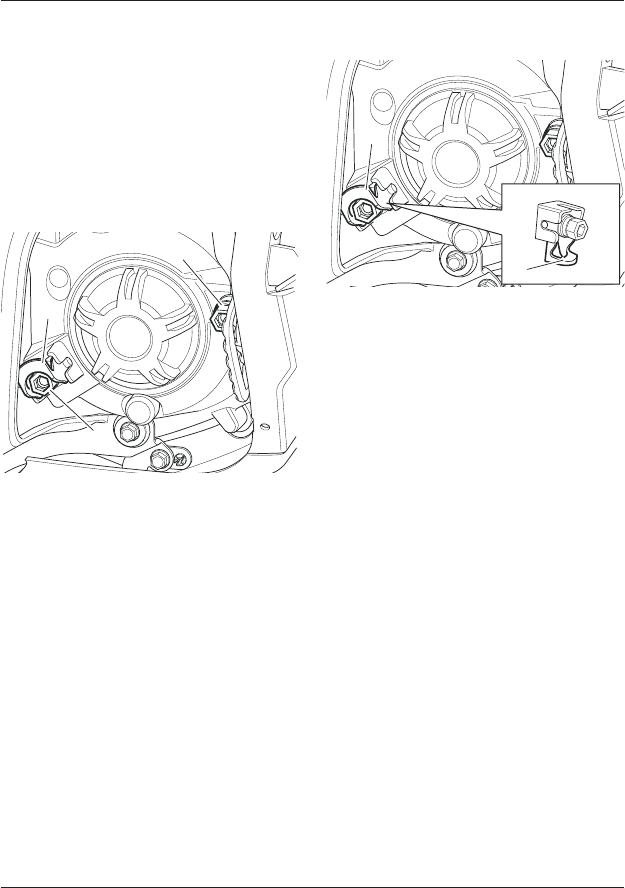
Maintenance
203
Headlight Adjustment
Tiger 1200 XR Only
The headlights can be adjusted by
means of vertical and horizontal
adjustment screws located on the rear
of each headlight. In addition, the
headlight unit is equipped with an easily
accessible adjuster to allow the vertical
adjustment to be corrected when the
motorcycle is fully loaded.
3
2
1
1. Horizontal adjustment screw
2. Vertical adjustment screw
3. Headlight adjuster lever for loaded
conditions
To adjust the headlight:
• Switch the headlight dipped beam
on.
• Turn the vertical adjustment screw
on the headlight clockwise to raise
the beam or counterclockwise to
lower the beam.
• Turn the horizontal adjustment
screw clockwise to move the beam
to the right or counterclockwise to
move the beam to the left.
• Switch the headlights off when the
beam settings are satisfactory.
Headlight Adjustment Lever for
Loaded Conditions
1
2
1. Headlight adjuster lever (unloaded
position)
2. Headlight adjuster lever (loaded
position)
For normal (unloaded) conditions the
headlight adjuster lever should be set in
the horizontal position (1).
For loaded conditions rotate the
headlight adjuster downwards until it
stops (2). This will lower the headlight
beams by approximately 2°.
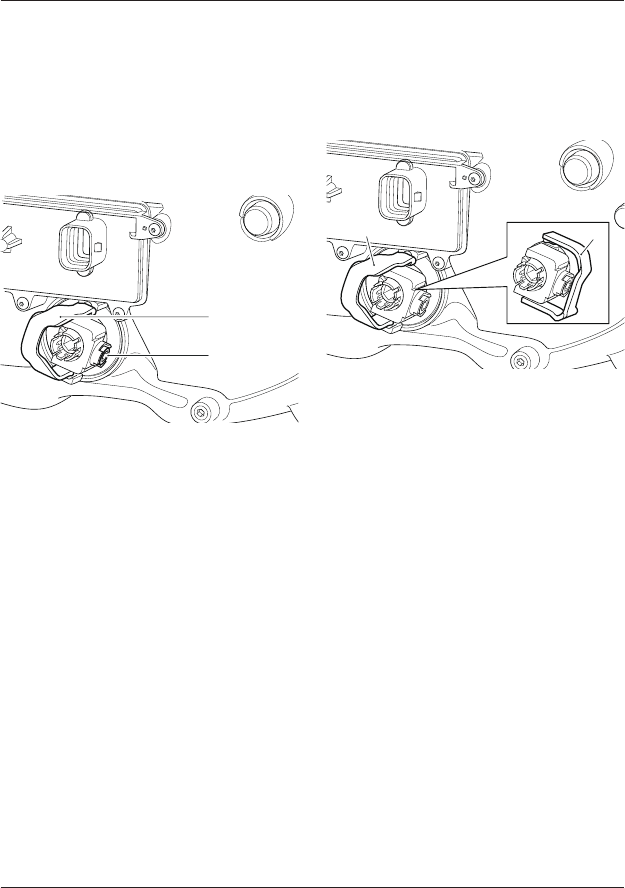
Maintenance
204
All Models except Tiger 1200 XR
The headlight can be adjusted by means
of a vertical adjustment screw located
on the rear of the headlight unit. There
is no horizontal adjustment. In addition,
the headlight is equipped with an easily
accessible adjuster to allow the vertical
adjustment to be corrected when the
motorcycle is fully loaded.
ckdt
1
2
1. Headlight adjuster lever for loaded
conditions
2. Vertical adjustment screw
To adjust the headlight:
• Switch the headlight dipped beam
on.
• Turn the vertical adjustment screw
on the headlight unit clockwise to
raise the beam or counterclockwise
to lower the beam.
Note:
• There is a small triangle marking on
each side of the headlight unit
which indicates the height of the
light within the headlight unit for
adjustment purposes.
• Switch the headlights off when the
beam settings are satisfactory.
Headlight Adjustment for Loaded
Conditions
The headlight unit is equipped with an
adjuster lever to allow the vertical
adjustment to be corrected when the
motorcycle is fully loaded.
ckdt
12
1. Headlight adjuster lever (loaded
position)
2. Headlight adjuster lever (unloaded
position)
For normal (unloaded) conditions, the
headlight adjuster lever should be set in
the horizontal position (2).
For loaded conditions, move the
headlight adjuster lever until it is in
position (1). This will lower the headlight
beams by approximately 2°.
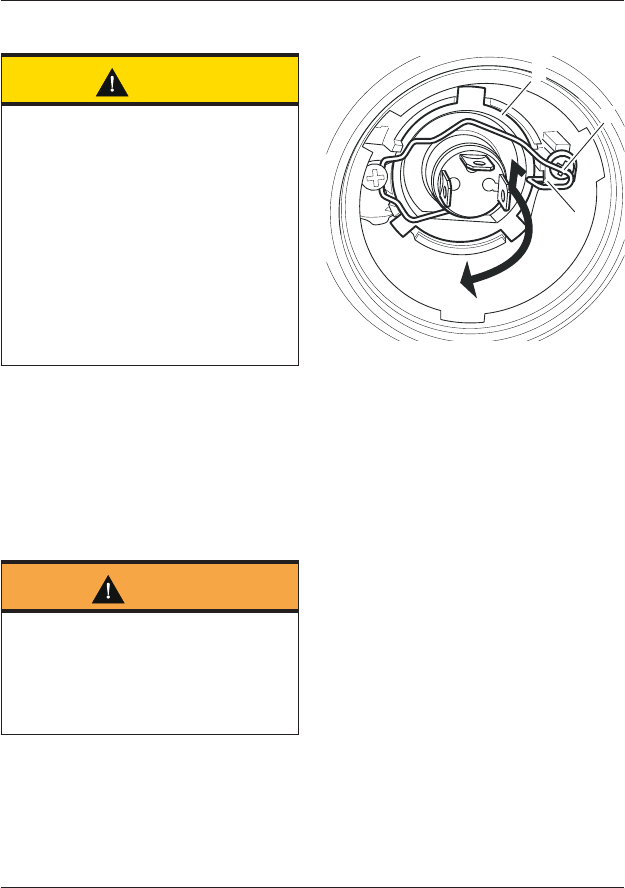
Maintenance
205
Bulb Replacement
Caution
The use of non-approved bulbs may
result in damage to lenses and other
lighting unit components.
In addition, the use of bulbs of
incorrect wattage may cause the
chassis ECM to cut power to affected
lighting circuits.
Use genuine Triumph supplied bulbs as
specified in the Triumph Parts Catalog.
Always have replacement bulbs
installed by an authorized Triumph
dealer.
Headlights
All Models except Tiger 1200 XR
The headlight unit is a sealed,
maintenance-free LED unit.
Tiger 1200 XR Only
Warning
The bulbs become hot during use.
Always allow sufficient time for the
bulb to cool before handling. Avoid
touching the glass part of the bulb. If
the glass is touched or gets dirty, clean
with alcohol before reuse.
The headlight unit does not need to be
removed to replace a bulb.
1
2
cgjn
3
1. Bulb retainer (right hand shown)
2. Bulb retainer hook
3. Bulb
To replace a bulb:
• Remove the rider's seat.
• Disconnect the battery, negative
(black) lead first.
• Remove the bulb cover from the
bulb to be replaced by rotating it
counterclockwise.
• Disconnect the multiplug from the
bulb.
• Detach the bulb retainer from the
hook on the headlight assembly
and rotate it away from the bulb as
shown.
• Remove the bulb from the bulb
retainer.
Installation is the reverse of the removal
procedure.
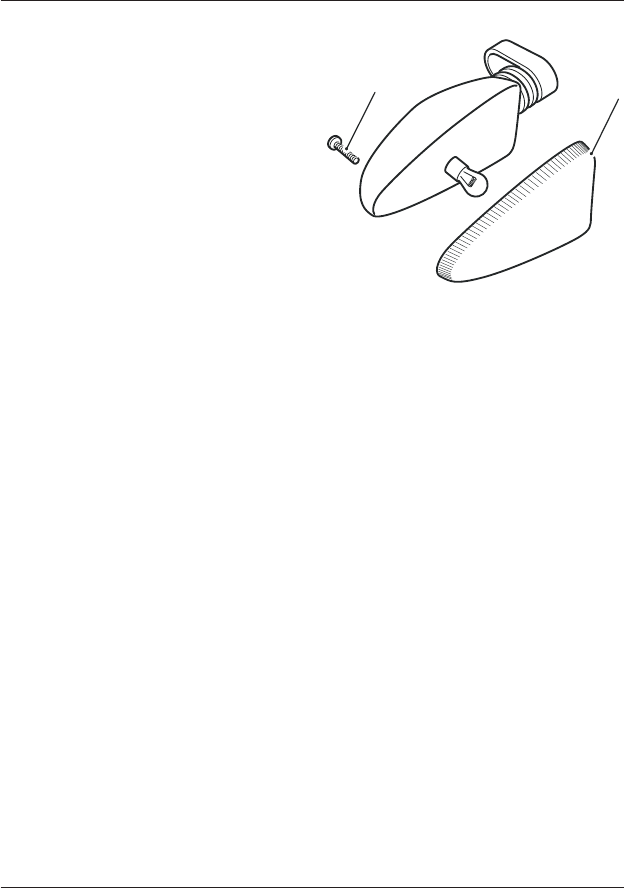
Maintenance
206
Front Fog Lights (if equipped)
The fog light units are sealed,
maintenance-free LED units.
Brake/Tail Light/License Plate Light
The brake/tail light unit is a sealed,
maintenance-free LED unit. The license
plate light is integral to the brake/tail
light unit.
Turn Signal Lights
The motorcycle is equipped with either
LED or bulb turn signal lights.
LED Turn Signal Lights
The turn signal light units are sealed,
maintenance-free LED units.
Bulb Turn Signal Lights
celc_2
1
2
1. Indicator lens
2. Securing screw
The lens on each indicator light is held
in place by a securing screw.
Loosen the screw and remove the lens
to gain access to the bulb for
replacement.

Cleaning and Storage
207
CLEANING AND STORAGE
Table of Contents
Preparation for Washing 208
Where to be Careful 208
Washing 209
After Washing 209
Care of Matt Paintwork 210
Care of Gloss Paintwork 210
Aluminum Items - not Lacquered or Painted 210
Cleaning of Chrome and Stainless Steel Items 211
Black Chrome 211
Cleaning of the Exhaust System 212
Seat Care 212
Windshield Cleaning (if equipped) 213
Care of Leather Products 214
Preparation for Storage 215
Preparation after Storage 216
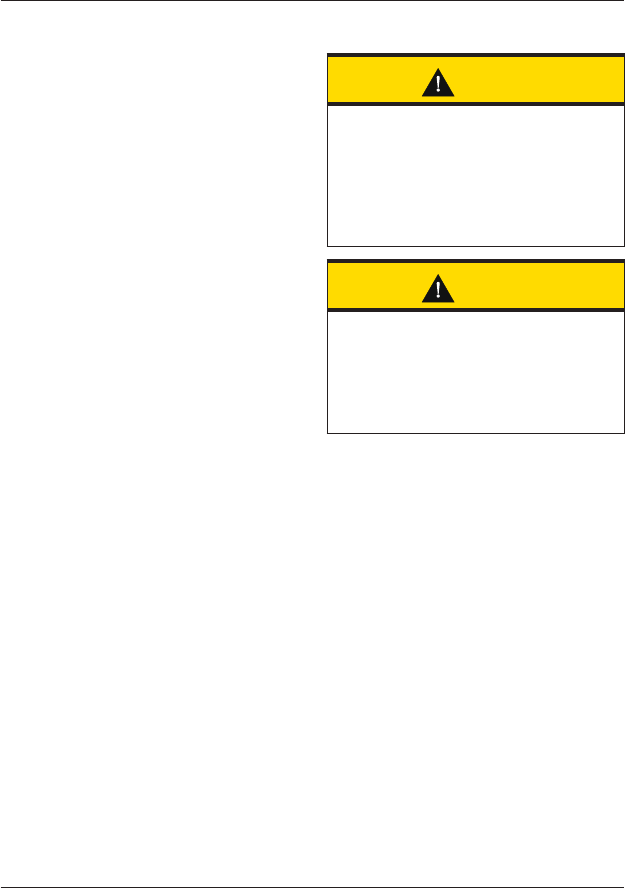
Cleaning and Storage
208
Preparation for Washing
Before washing, precautions must be
taken to keep water off the following
places.
Rear opening of the exhausts: Cover
with a plastic bag secured with rubber
bands.
Clutch and brake levers, switch housings
on the handlebar: Cover with plastic
bags.
Ignition switch and steering lock: Cover
the keyhole with tape.
Remove any items of jewelry such as
rings, watches, zips or belt buckles,
which may scratch or otherwise damage
painted or polished surfaces.
Use separate cleaning sponges or
cleaning cloths for washing painted/
polished surfaces and chassis areas.
Chassis areas (such as wheels and
under fenders) will be exposed to more
abrasive road grime and dust, which
may then scratch painted or polished
surfaces, if the same sponge or cleaning
cloths are used.
Where to be Careful
Caution
Do not spray any water at all near the
air intake duct. The air intake duct is
normally located under the rider’s seat,
under the fuel tank or near the
steering head. Any water sprayed in
this area could enter the airbox and
engine, causing damage to both items.
Caution
Use of high pressure spray washers is
not recommended. When using
pressure washers, water may be
forced into bearings and other
components causing premature wear
from corrosion and loss of lubrication.
Avoid spraying water with any great
force near the following places:
• Instruments;
• Brake cylinders and brake calipers;
• Under the fuel tank;
• Air intake duct;
• Steering head bearings;
• Wheel bearings.
Note:
• Use of soaps that are highly
alkaline will leave a residue on
painted surfaces, and may also
cause water spotting. Always use a
low alkaline soap to aid the cleaning
process.
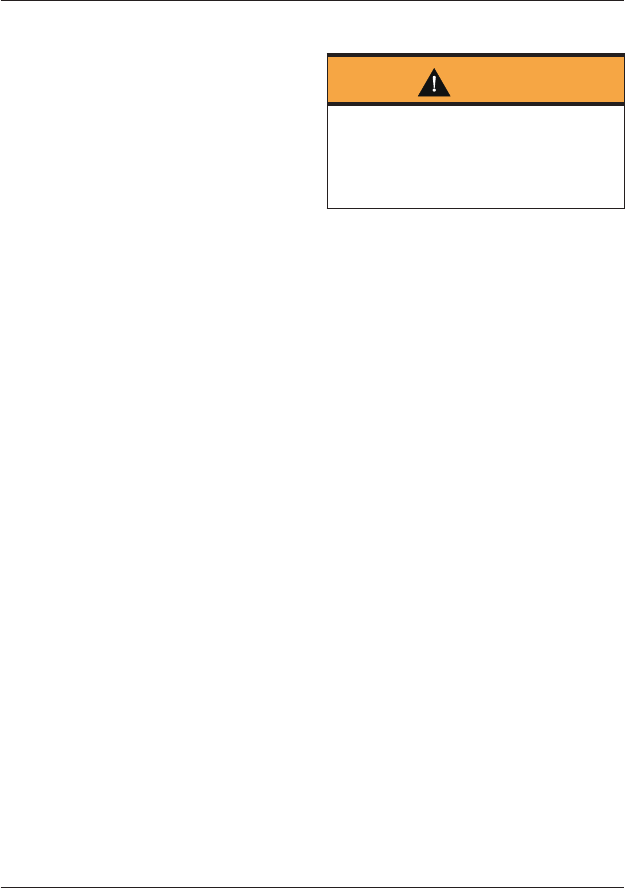
Cleaning and Storage
209
Washing
Prepare a mixture of cold water and
mild automotive cleaner. Do not use a
highly alkaline soap as commonly found
at commercial car washes because it
leaves a residue.
Wash the motorcycle with a sponge or
soft cloth. Do not use abrasive scouring
pads or steel wool. They will damage the
finish.
Rinse the motorcycle thoroughly with
cold water.
After Washing
Warning
Never wax or lubricate the brake discs.
Loss of braking power and an accident
could result. Clean the disc with a
proprietary brand of oil-free brake disc
cleaner.
Remove the plastic bags and tape, and
clear the air intakes.
Lubricate the pivots, bolts and nuts.
Test the brakes before motorcycle
operation.
Use a dry cloth or chamois leather to
absorb water residue. Do not allow
water to stand on the motorcycle as
this will lead to corrosion.
Start the engine and run it for 5
minutes. Make sure that there is
adequate ventilation for the exhaust
fumes.

Cleaning and Storage
210
Care of Matt Paintwork
Matt paintwork requires no greater care
than that already recommended for
high gloss paintwork.
• Do not use any polish or wax on
matt paintwork.
• Do not try and polish out scratches.
Care of Gloss Paintwork
Gloss paintwork should be washed and
dried as described above, then
protected using a high quality
automotive polish. Always follow the
manufacturer’s instructions and repeat
regularly to maintain your motorcycle’s
appearance.
Aluminum Items - not
Lacquered or Painted
Items such as brake and clutch levers,
wheels, engine covers, engine cooling
fins, upper and lower yokes and throttle
bodies on some models must be
correctly cleaned to preserve their
appearance. Please contact your dealer
if you are unsure which components on
your motorcycle are aluminum parts not
protected by paint or lacquer, and for
guidance on how to clean those items.
Use a proprietary brand of aluminum
cleaner which does not contain abrasive
or caustic elements.
Clean aluminum items regularly, in
particular after use in inclement
weather, where the components must
be hand washed and dried each time
the machine is used.
Warranty claims due to inadequate
maintenance will not be allowed.
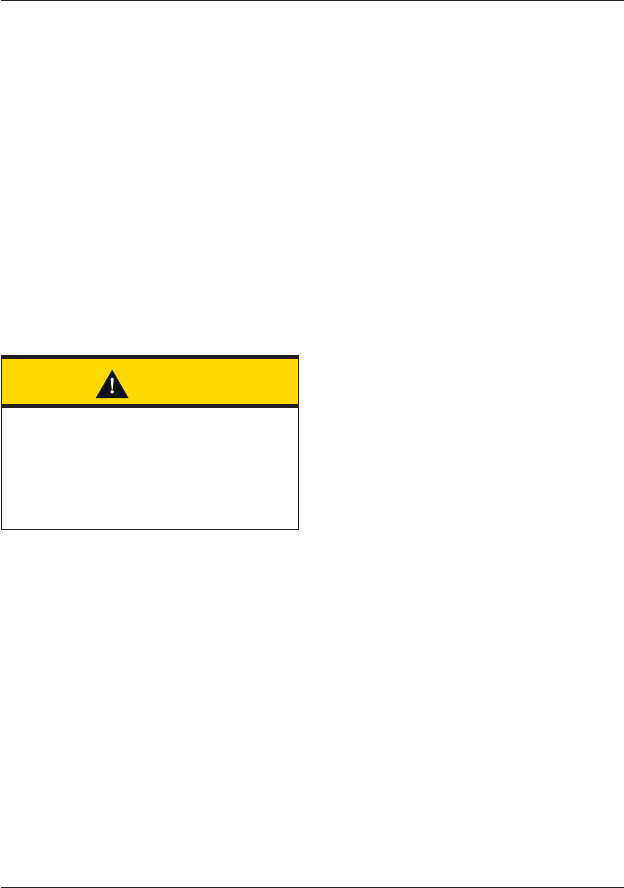
Cleaning and Storage
211
Cleaning of Chrome and
Stainless Steel Items
All chrome and stainless steel parts of
your motorcycle must be cleaned
regularly to avoid a deterioration of its
appearance.
Washing
Wash as previously described.
Drying
Dry the chrome and stainless steel
parts as far as possible with a soft cloth
or chamois leather.
Protecting
Caution
The use of products containing silicone
will cause discoloration of the chrome
and stainless steel parts and must not
be used. Similarly, the use of abrasive
cleaners will damage the finish and
must not be used.
When the chrome and stainless steel is
dry, apply a suitable proprietary chrome
cleaner on to the surface, following the
manufacturer’s instructions.
It is recommended that regular
protection be applied to the motorcycle
as this will both protect and enhance its
appearance.
Black Chrome
Items such as headlight bowls and
mirrors on some models must be
correctly cleaned to preserve their
appearance. Please contact your dealer
if you are unsure which components on
your motorcycle are black chrome parts.
Maintain the appearance of black
chrome items by rubbing a small
amount of light oil into the surface.
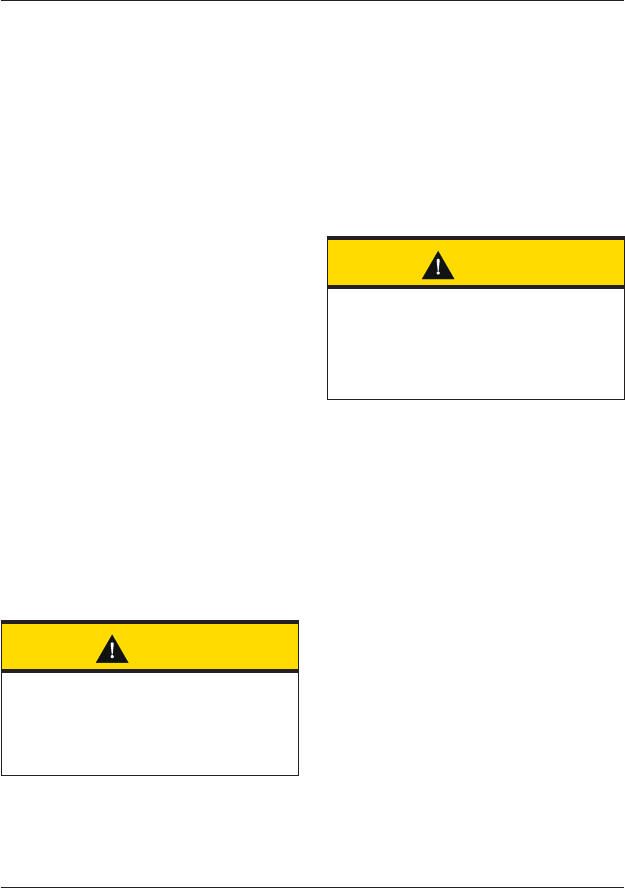
Cleaning and Storage
212
Cleaning of the Exhaust
System
All parts of the exhaust system of your
motorcycle must be cleaned regularly to
avoid a deterioration of its appearance.
These instructions can be applied to
chrome, brushed stainless steel and
carbon fiber components; matt painted
exhaust systems should be cleaned as
above, noting the care instructions in
the Matt Paintwork section previously.
Note:
• The exhaust system must be cool
before washing to prevent water
spotting.
Washing
Wash as previously described.
Make sure that no soap or water enters
the exhausts.
Drying
Dry the exhaust system as far as
possible with a soft cloth or chamois
leather. Do not run the engine to dry
the system or spotting will occur.
Protecting
Caution
The use of products containing silicone
will cause discoloration of the chrome
and must not be used. Similarly, the
use of abrasive cleaners will damage
the system and must not be used.
When the exhaust system is dry, apply
a suitable proprietary motorcycle pro-
tection spray onto the surface, following
the manufacturer’s instructions.
It is recommended that regular
protection be applied to the system as
this will both protect and enhance the
system's appearance.
Seat Care
Caution
Use of chemicals or high pressure
spray washers is not recommended for
cleaning the seat.
Using chemicals or high pressure spray
washers may damage the seat cover.
To help maintain its appearance, clean
the seat using a sponge or cleaning
cloth with soap and water.
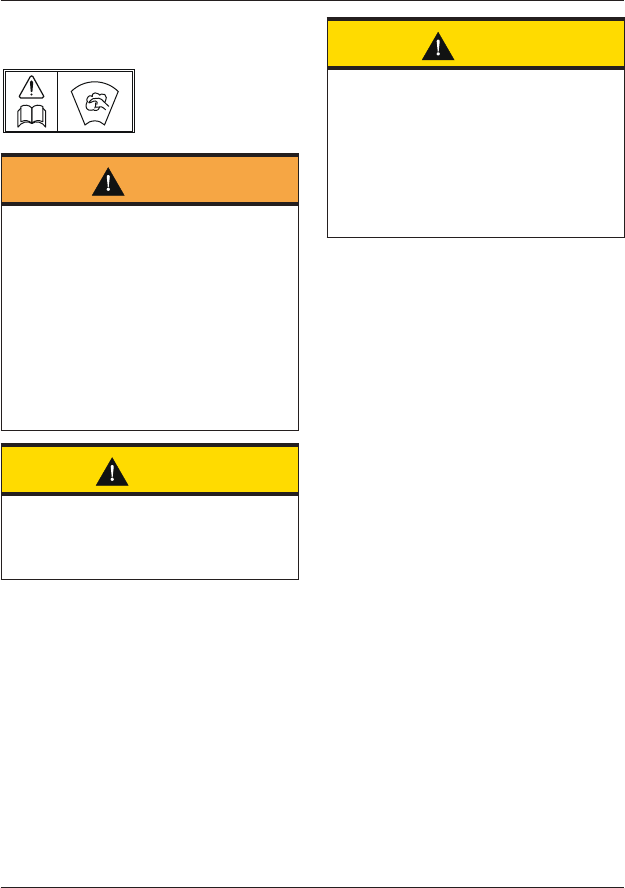
Cleaning and Storage
213
Windshield Cleaning
(if equipped)
Warning
Never attempt to clean the windshield
while the motorcycle is in motion as
releasing the handlebars may cause
loss of motorcycle control and an
accident.
Operation of the motorcycle with a
damaged or scratched windshield will
reduce the rider's forward vision. Any
such reduction in forward vision is
dangerous and may lead to loss of
motorcycle control and an accident.
Caution
Corrosive chemicals such as battery
acid will damage the windshield. Never
allow corrosive chemicals to contact
the windshield.
Caution
Products such as window cleaning
fluids, insect remover, rain repellent,
scouring compounds, gasoline or
strong solvents such as alcohol,
acetone, carbon tetrachloride, etc. will
damage the windshield.
Never allow these products to contact
the windshield.
Clean the windshield with a solution of
mild soap or detergent and cold water.
After cleaning, rinse well and then dry
with a soft, lint-free cloth.
If the transparency of the windshield is
reduced by scratches or oxidation which
cannot be removed, the windshield must
be replaced.

Cleaning and Storage
214
Care of Leather Products
We recommend that you periodically
clean your leather products with a
damp cloth and allow them to dry
naturally at room temperature. This will
maintain the appearance of the leather
and ensure the long life of your product.
Your Triumph leather product is a
natural product and lack of care can
result in damage and permanent wear.
Follow these simple instructions and
give your leather product the respect it
deserves:
• Do not use household cleaning
products, bleach, detergents con-
taining bleach or any kind of sol-
vent to clean your leather product.
• Do not immerse your leather
product in water.
• Avoid direct heat from fires and
radiators which can dry out and
distort the leather.
• Do not leave your leather product
in direct sunlight for prolonged
periods of time.
• Do not dry your leather product by
applying direct heat to it at any
time.
• If your leather product does get
wet, absorb any excess water with
a soft clean cloth then leave the
product to dry naturally at room
temperature.
• Avoid exposure of your leather
product to high levels of salt, for
example sea/salt water or road
surfaces that have been treated
during the winter for ice and snow.
• If exposure to salt is unavoidable,
clean your leather product
immediately after each exposure
using a damp cloth then leave the
product to dry naturally at room
temperature.
• Gently clean any minor marks with
a damp cloth then leave the
product to dry naturally at room
temperature.
• Place your leather product in a
fabric bag or cardboard box to
protect it when in storage. Do not
use a plastic bag.
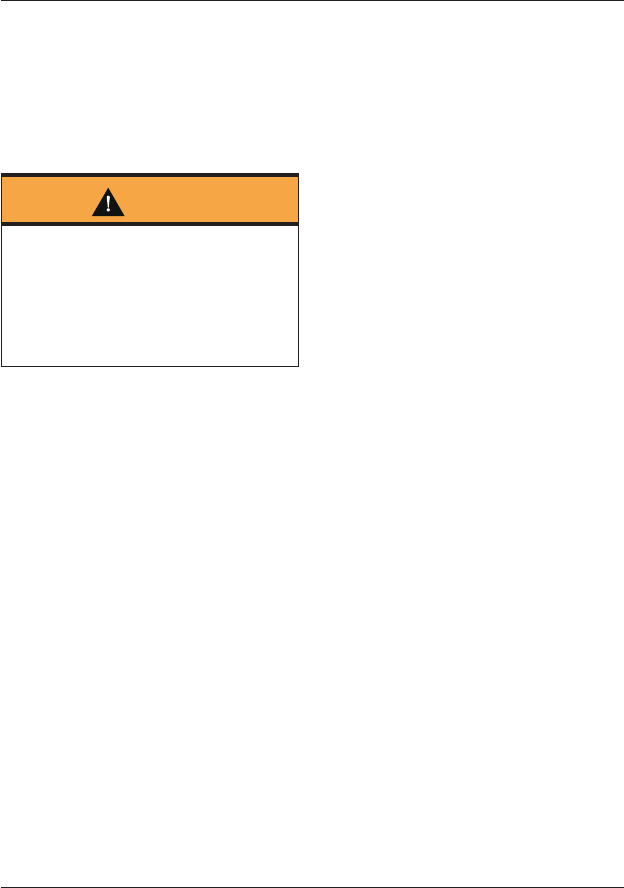
Cleaning and Storage
215
Preparation for Storage
Clean and dry the entire vehicle
thoroughly.
Fill the fuel tank with the correct grade
of unleaded fuel and add a fuel stabilizer
(if available), following the fuel stabilizer
manufacturer's instructions.
Warning
Gasoline is extremely flammable and
can be explosive under certain
conditions. Turn the ignition switch off.
Do not smoke. Make sure the area is
well ventilated and free from any
source of flame or sparks; this includes
any appliance with a pilot light.
Remove the spark plug from each
cylinder and put several drops 0.17 fl oz
(5 ml) of engine oil into each cylinder.
Cover the spark plug holes with a piece
of cloth or rag. With the engine stop
switch in the RUN position, push the
starter button for a few seconds to coat
the cylinder walls with oil. Install the
spark plugs, tightening to 9 lbf ft (12 Nm).
Change the engine oil and filter (see
page 170).
Check and if necessary correct the tire
pressures.
Set the motorcycle on a stand so that
both wheels are raised off the ground.
(If this cannot be done, put boards
under the front and rear wheels to keep
dampness away from the tires.)
Spray rust inhibiting oil (there are a host
of products on the market and your
dealer will be able to offer you local
advice) on all unpainted metal surfaces
to prevent rusting. Prevent oil from
getting on rubber parts, brake discs or
in the brake calipers.
Make sure the cooling system is filled
with a 50% mixture of coolant (noting
that HD4X Hybrid OAT coolant, as
supplied by Triumph, is premixed and
requires no dilution) and distilled water
solution (see page 172).
Remove the battery, and store it where
it will not be exposed to direct sunlight,
moisture, or freezing temperatures.
During storage it should be given a slow
charge (one ampere or less)
approximately once every two weeks
(see page 193).
Store the motorcycle in a cool, dry area,
away from sunlight, and with a minimum
daily temperature variation.
Put a suitable porous cover over the
motorcycle to keep dust and dirt from
collecting on it. Avoid using plastic or
similar non-breathable, coated materials
that restrict air flow and allow heat and
moisture to accumulate.

Cleaning and Storage
216
Preparation after Storage
Install the battery (if removed) (see
page 197).
If the motorcycle has been stored for
more than four months, change the
engine oil (see page 170).
Check all the points listed in the Daily
Safety Checks section.
Before starting the engine, remove the
spark plugs from each cylinder.
Put the side stand down.
Crank the engine on the starter motor
several times until the oil pressure light
goes out.
Reinstall the spark plugs, tightening to
9 lbf ft (12 Nm), and start the engine.
Check and if necessary correct the tire
pressures.
Clean the entire vehicle thoroughly.
Check the brakes for correct operation.
Test ride the motorcycle at low speeds.

Specifications
217
SPECIFICATIONS
Dimensions, Weights and Performance
A list of model specific dimensions, weights and performance figures is available
from your authorized Triumph dealer, or on the Internet at www.triumph.co.uk.
Maximum Payload
Tiger 1200 XR 507 lb (230 kg)
Tiger 1200 XRx 502 lb (228 kg)
Tiger 1200 XRx-LRH 507 lb (230 kg)
Tiger 1200 XRT 502 lb (228 kg)
Tiger 1200 XCx 491 lb (223 kg)
Tiger 1200 XCA 493 lb (224 kg)
Engine
Type In-line 3 cylinder
Displacement 74.1 cu in (1,215 cc)
Bore x Stroke 3.35 x 2.81 in (85 x 71.4 mm)
Compression Ratio 11:1
Cylinder Numbering Left to Right
Cylinder Sequence Number 1 at left
Firing Order 1-2-3
Starting System Electric Starter
Lubrication
Lubrication Pressure Lubrication (wet sump)
Engine Oil Capacities
Dry Fill 1.19 gallon (4.5 liters)
Oil/Filter Change 1.07 gallon (4.0 liters)
Oil Change Only 1.02 gallon (3.85 liters)
Cooling
Coolant Type Triumph HD4X Hybrid OAT coolant
Water/Anti-freeze ratio 50/50 (premixed as supplied by
Triumph)
Coolant Capacity 0.74 gallon (2.8 liters)
Thermostat Opens (nominal) 88°C (nominal)

Specifications
218
Fuel System
Type Electronic Fuel Injection
Injectors Solenoid Operated
Fuel Pump Submerged Electric
Fuel Pressure (nominal) 50.8 lb/in² (3.5 bar)
Fuel
Type AKI octane rating (R+M)/2 of 87
unleaded
Tank Capacity 5.28 gallons (20.0 liters)
Ignition
Ignition System Digital Inductive
Electronic Rev Limiter (r/min) 9,500 r/min
Spark Plug NGK CR8EK
Spark Plug Gap 0.03 in (0.7 mm)
Gap Tolerance +0.0015/-0.003 in (+0.05/-0.1 mm)
Transmission
Transmission Type 6 Speed, Constant Mesh
Clutch Type Wet, Multi-Plate
Final Drive Ratio 2.557:1
Gear Ratios:
Front Bevel Box 1.042:1 (24/25)
Rear Bevel Box 2.455:1 (11/27)
1st 2.846:1 (13/37)
2nd 2.056:1 (18/37)
3rd 1.583:1 (24/38)
4th 1.2916:1 (24/31)
5th 1.138:1 (29/33)
6th 1.037:1 (27/28)
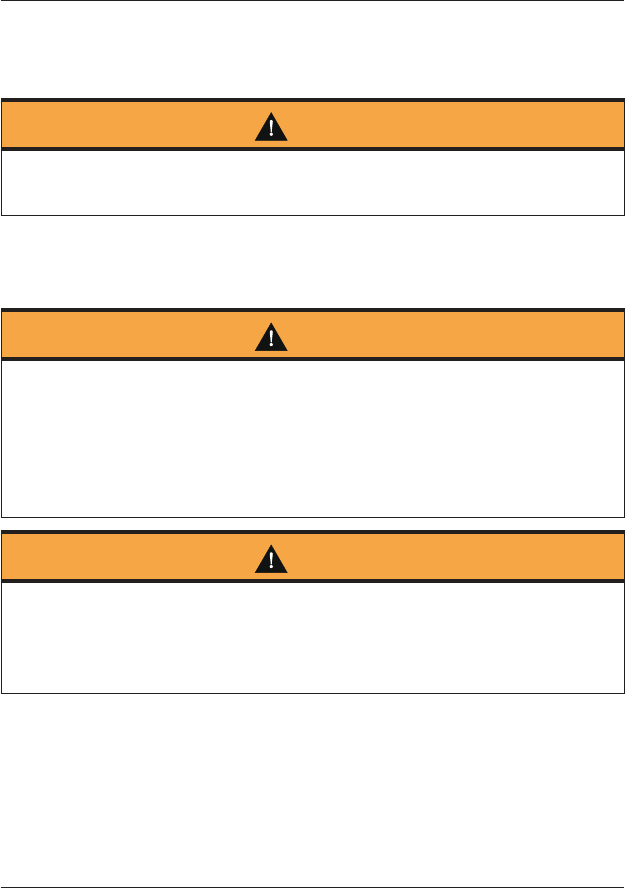
Specifications
219
Approved Tires
A list of approved tires specific to these models is available from your authorized
Triumph dealer, or on the Internet at www.triumph.co.uk.
Warning
Use the recommended tires ONLY in the combinations given. Do not mix tires from
different manufacturers or mix different specification tires from the same
manufacturers as this may result in loss of motorcycle control and an accident.
Approved Mud and Snow/Dual Purpose Tires
A list of approved mud and snow/dual purpose tires specific to these models is avail-
able from your authorized Triumph dealer, or on the Internet at www.triumph.co.uk.
Warning
The use of mud and snow/dual purpose tires will result in reduced motorcycle
stability.
Always operate a motorcycle equipped with mud and snow/dual purpose tires at
reduced speeds. The permissible maximum speed is 60 mph (110 km/h). This is also
shown on a warning sticker on the motorcycle.
Operation of the motorcycle above the permissible maximum speed may result in
loss of motorcycle control and an accident.
Warning
Tire pressures which have been reduced for off-road riding will impair on-road
stability. Always make sure that the tire pressures are set as described in the
Specifications section for on-road use.
Operation of the motorcycle with incorrect tire pressures may cause loss of
motorcycle control leading to an accident.

Specifications
220
Tires
Tire Pressures (Cold):
Front 32 lb/in² (2.2 bar)
Rear 39 lb/in² (2.7 bar)
Tire Sizes:
Front Size 120/70 R19
Rear Size 170/60 R17
Electrical Equipment
Battery Type YTZ14S
Battery Rating 12 Volt, 11.2 Ah
Alternator 12 Volt, 70 Amp at 4,000 rpm
Headlight 2 x 12 Volt, 55/60 Watt, H4 Halogen
(Tiger 1200 XR only)
LED
Tail/Brake Light LED
Parking Light LED
Fog Lights (if equipped) LED
Turn Signal Lights RY10W, 12 Volt, 10 Watt, Amber
LED (model specific)
Frame
Rake 23.1°
Trail 3.9 in (99.2 mm)
Tightening Torques
Oil Filter 89 lbf in (10 Nm)
Oil Drain Plug 18 lbf ft (25 Nm)
Spark Plug 9 lbf ft (12 Nm)
Rear Wheel Nuts 52 lbf ft (70 Nm)

Specifications
221
Fluids and Lubrication
Engine Oil Semi or fully synthetic 10W/40 or
10W/50 motorcycle engine oil which
meets specification API SH (or higher)
and JASO MA, such as Castrol Power 1
Racing 4T 10W-40 (fully synthetic)
Brake and Clutch Fluid DOT 4 Brake and Clutch Fluid
Coolant Triumph HD4X Hybrid OAT coolant
Bearings and Pivots Grease to NLGI 2 specification
Final Drive Unit Castrol SAF-XO (fully synthetic hypoid oil)

Index
222
INDEX
A
Accessories 158
Anti-Lock Braking System (ABS) 149
ABS Warning Light 151
Optimized Cornering ABS 150
B
Battery 193
Charging 196
Discharge 195
Disposal 194
Installation 197
Maintenance 195
Removal 194
Storage 195
Brake/Tail Light/License Plate Light 206
Brakes 177
Anti-Lock Braking System (ABS) 149
Brake and Clutch Lever Adjusters 103
Brake Light 181
Braking 146
Breaking-in New Brake Pads and Discs 178
Disc Brake Fluid 179
Front Brake Fluid Level Adjustment 180
Front Brake Fluid Level Inspection 180
Optimized Cornering ABS 150
Pad Wear Compensation 178
Rear Brake Fluid Level Adjustment 181
Rear Brake Fluid Level Inspection 181
Wear Inspection 177
Breaking-In 136
Bulb Replacement 205
C
Chassis Electronic Control Module
(Chassis ECM) 200
Cleaning
After Washing 209
Aluminum Items - not Lacquered
or Painted 210
Black Chrome Items 211
Care of Leather Products 214
Chrome and Stainless Steel 211
Drying 212
Exhaust System 212
Gloss Paintwork 210
Matt Paintwork 210
Preparation for Washing 208
Protecting 212
Seat Care 212
Washing 209
Washing the Exhaust 212
Where to be Careful 208
Windshield 213
Clutch 175
Clutch Fluid Level Adjustment 175
Clutch Fluid Level Inspection 175
Considerations for High-Speed Operation 156
Cooling System 172
Coolant Change 174
Coolant Level Adjustment 174
Coolant Level Inspection 173
Corrosion Inhibitors 172
High Coolant Temperature Warning Light 60
Specifications 217
Cruise Control 105
Activating 105
Adjusting the Set Speed 106
Buttons 105
Cruise Control Adjust Button 97
Deactivating 106
Resuming the Set Speed 107
E
Electrical Accessory Sockets 127
Electrical Equipment 220
Specifications 220
Engine
Moving Off 145
Serial Number 20
Specifications 217
Starting the Engine 142, 144
Stopping the Engine 140, 141

Index
223
Engine Oil 169
Disposal of Oil and Filters 171
Engine Oil Change 170
Oil Filter Change 170
Oil Level Inspection 169
Specification and Grade 172
Engine Start/Stop Switch
QUICK START Position 95
RUN Position 95
STOP Position 95
F
Final Drive Unit 176
Oil Level Adjustment 177
Fluids and Lubricants 221
Fog Lights 206
Frame 220
Front Suspension 183
Compression Damping Adjustment 184
Fork Inspection 183
Front Suspension Adjustment 184
Rebound Damping Adjustment 185
Settings Chart 185
Fuel 115, 218
Filling the Fuel Tank 117
Fuel Grade 115
Fuel Tank Cap 116
Refueling 116
System Specifications 218
Fuses 197
ABS Fuse 198
Main Fuse 197
G
Gears
Shifting Gears 146
H
Hand Controls 91
Handlebar Adjustment 119
Headlights 201
Adjustment 203, 204
Bend Lighting 202
Daytime Running Lights (DRL) 202
Replacement 205
Heated Seats
Rider’s Heated Seat Switch 100
Helmet Hook 126
Hill Hold Control 152
Activation 153
Deactivation 154
Unavailable Message 154
I
Ignition
Engine Immobilizer 93
Ignition Key 93
Keyless 91
Smart Key 91
Specifications 218
Switch Positions 94
Switch/Steering Lock 93
Immobilizer
Indicator Light 25, 60
Instruments
Description 21
Information Messages 66
Motorcycle Status Display Screen 67
Multifunction Display Screen 71
Speedometer 30
Tachometer 31, 66
Warning Messages 65
K
Keyless Ignition 91
L
Left Handlebar Switches 97, 100
Fog Lights Switch (if equipped) 99
Headlight Dimmer Switch 100
Heated Grips Switch 98
High Beam Button 28, 99
Horn Button 98, 101
Instrument SCROLL Button 101
Instrument SELECT Button 101
Joystick Button 98
MODE Button 98, 101
Rider’s Heated Seat Switch 100

Index
224
Turn Signal Switch 98, 101
Loading 159
Lubrication Specifications 217
Luggage Systems
Expedition Aluminum Panniers
(if equipped) 129
M
Maintenance
Scheduled Maintenance 166
Scheduled Maintenance Table 167
Master Ignition Switch (if equipped) 92
Maximum Payloads 217
Motorcycle Status Display Screen
Ambient Air Temperature 70
Clock 70
Coolant Temperature Gage 68
Cruise Set Speed 69
Fuel Gage 67
Gear Position Display 69
Service Indicator 69
Speedometer 67
Multifunction Display Screen
Home Screen 71
Motorcycle Information 73
Riding Mode Display 72
Trip Meter Reset 73
Trip Meters 73
Windshield Adjustment Mode 72
P
Parking 155
Parts Identification
Left Hand Side 16
Rider View 18, 19
Right Hand Side 17
Passengers 161
R
Rear Suspension 186
Adjustment 186
Rebound Damping Adjustment 187
Setting Chart 187
Spring Preload Adjustment 186
Riding Modes 81
Riding Mode Configuration 85
Riding Mode Selection 82
Right Handlebar Switches 94, 96
Cruise Control Adjust Button 96
Daytime Running Light (DRL) Switch 29
Daytime Running Lights (DRL) Switch 97
Engine Stop Switch 96
Hazard Switch 28
Hazard Warning Lights 95, 96
Starter Button 96
S
Safety
Daily Checks 137
Fuel and Exhaust Fumes 8
Handlebars and Footrests 11
Helmet and Clothing 9
Maintenance and Equipment 13
Motorcycle 7
Parking 12
Parts and Accessories 12
Riding 9
Seats 122
Heated Seats (if equipped) 124
Passenger Seat 122
Rider’s Seat 123
Rider’s Seat Height Adjustment 124
Seat Care 122, 212
Settings Menu 74
Bike Setup 76
Display Setup 79
Riding Modes 75
Show Warnings 75
Trip Setup 75
Smart Key 91
Operation 91
Stands 121
Center Stand 121
Side Stand 121
Steering
Bearings Inspection 182
Inspection 182

Index
225
Wheel Bearings Inspection 183
Steering Lock
Steering Lock Button 95
Storage
Preparation after Storage 216
Preparation for Storage 215
T
TFT Digital Display
Ambient Air Temperature 32
Fuel Gage 32
Gear Position Display 31
Information Tray - Coolant Temperature 41
Information Tray - Fuel Information 38
Information Tray - Odometer 39
Information Tray - Overview 36
Information Tray - Screen Contrast 41
Information Tray - Service Interval
Announcement 39
Information Tray - Style Options 41
Information Tray - Tire Pressure
Monitoring 39
Information Tray - Trip Meter 38
Information Tray - Warning Review 37
Instrument Panel Layout 23
Instrument Panel Position Adjustment 56
Main Menu - Bike Set Up - ABS 48
Main Menu - Bike Set Up - Service 48
Main Menu - Bike Set Up -
Traction Control 48
Main Menu - Bike Set Up - Turn Signals 47
Main Menu - Display Set Up - Brightness 52
Main Menu - Display Set Up - Language 53
Main Menu - Display Set Up - Set Clock 54
Main Menu - Display Set Up - Set Date 54
Main Menu - Display Set Up - Set Units 53
Main Menu - Display Set Up - Styles
and Themes 51
Main Menu - Display Set Up - Visible Tray 52
Main Menu - Reset to Defaults 55
Main Menu - Riding Mode Configuration 44
Main Menu - Riding Modes 43
Main Menu - Trip 2 Enable/Disable 50
Main Menu - Trip Setup 49
Main Menu - Trip Setup - Automatic Reset 50
Main Menu - Trip Setup - Manual Reset 49
Main Menu Overview 42
Riding Mode Selection 34
Riding Modes 33
Service Interval Announcement 32
TFT Display Navigation 24
TFT Themes and Styles 24
Warning Lights 24
Throttle Control 102, 175
Brake Use 102
Tire Pressure Monitoring System 111
Low Tire Pressure 114
Sensor Batteries 113
System Fault 113
Tire Pressure Warning Light 112
Tire Pressures 114
Tires 4, 188
Inflation Pressures 220
Low Tire Pressure 114
Minimum Recommended Tread Depth 190
Sizes 220
Specifications 220
Tire Inflation Pressures 189
Tire Pressures 114
Tire Replacement 190
Tire Wear 189
Tool Kit 126
Torques
Tightening 220
Traction Control (TC) 109
Disabled Warning Light 27
Indicator Light 26
Optimized Cornering Traction Control 110
Settings 111
Transmission
Specifications 218
Triumph Semi Active Suspension (TSAS) 40, 108
Damping Settings 108
Modes 108
System Calibration 108
Turn Signal Lights 206
Replacement 206

Index
226
U
Universal Serial Bus (USB) Socket 128
V
Vehicle Identification Number 20
W
Warning Lights 59
Warnings 3
Immobilizer and TPMS 4
Maintenance 3
Noise Control System 4
Off-Road Use 4
Owner’s Handbook 5
Warning Label Locations 14
Warning Labels 3
Warning Lights 25, 59
Windshield 118
Height Adjustment 42, 118, 119
